Thales Avionics TFS-SDU82155A1 Topflight SATCOM Satellite Data unit User Manual Tpage
Thales Avionics Limited Topflight SATCOM Satellite Data unit Tpage
I and M Manual
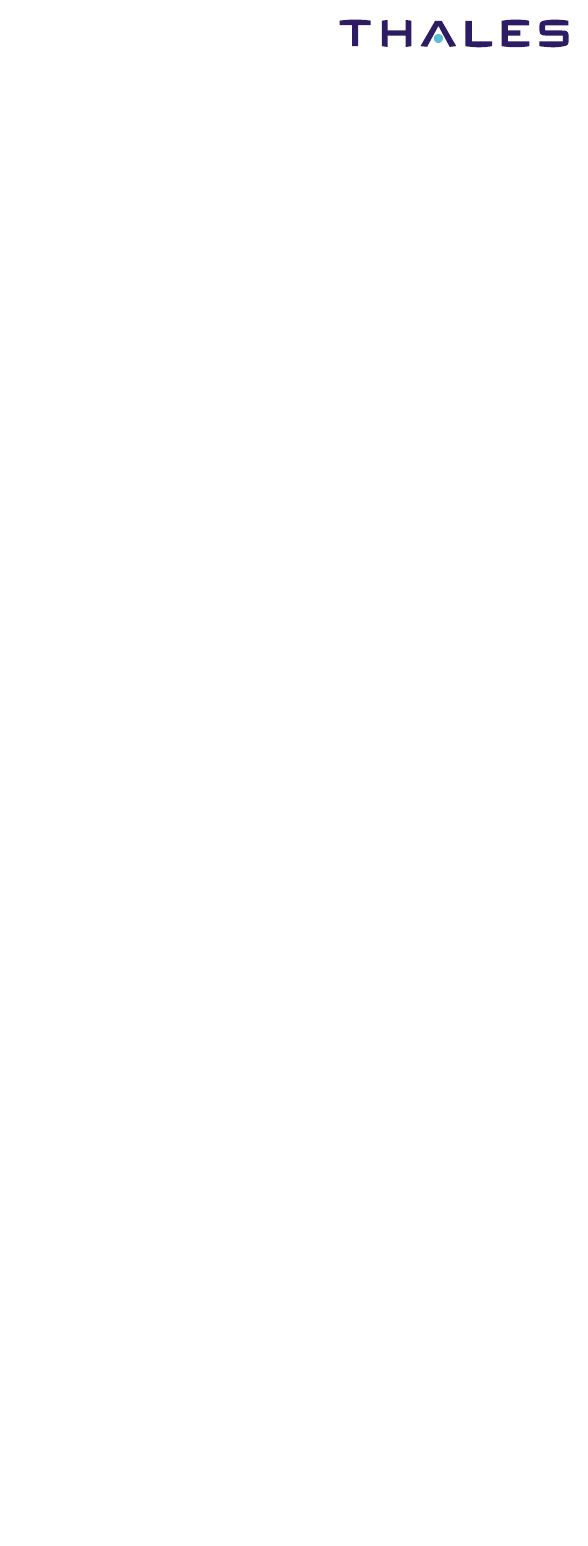
86, Bushey Road
Raynes Park, London
SW20 0JW
Tel: +44 (0)20 8946 8011
Fax: +44 (0)20 8946 7530
1
Jun 30/2008
Revision No. 01
First Issue: Jun 30/2008
© THALES AVIONICS Ltd. This document and any
information included are the property of Thales Avionics.
They cannot be reproduced, disclosed or utilized without the
company’s prior written approval
INSTALLATION AND MAINTENANCE
MANUAL
Satellite Data Unit (SDU)
82155 Series
SDU Configuration Module (SCM)
82158 Series
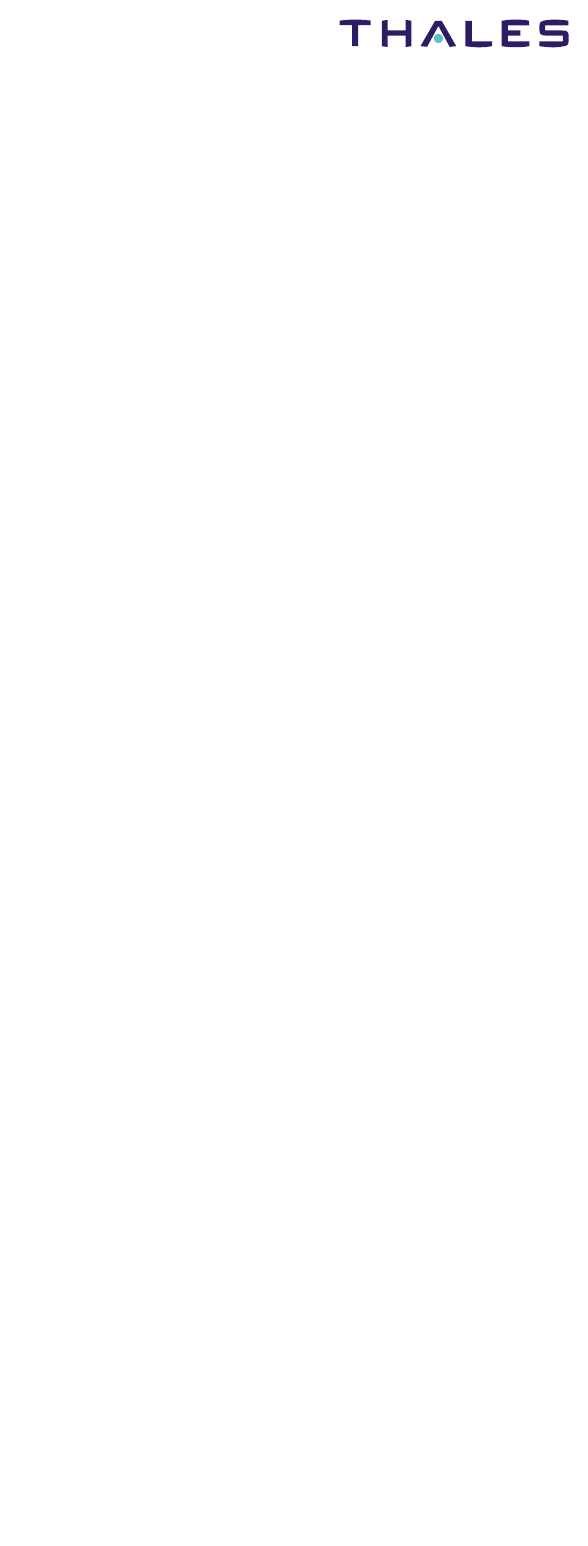
Installation Maintenance Manual
SDU 82155 Series
SCM 82158 Series
2
Jun 30/2008
© THALES AVIONICS Ltd. This document and any
information included are the property of Thales Avionics.
They cannot be reproduced, disclosed or utilized without the
company’s prior written approval
THIS PAGE INTENTIONALLY BLANK
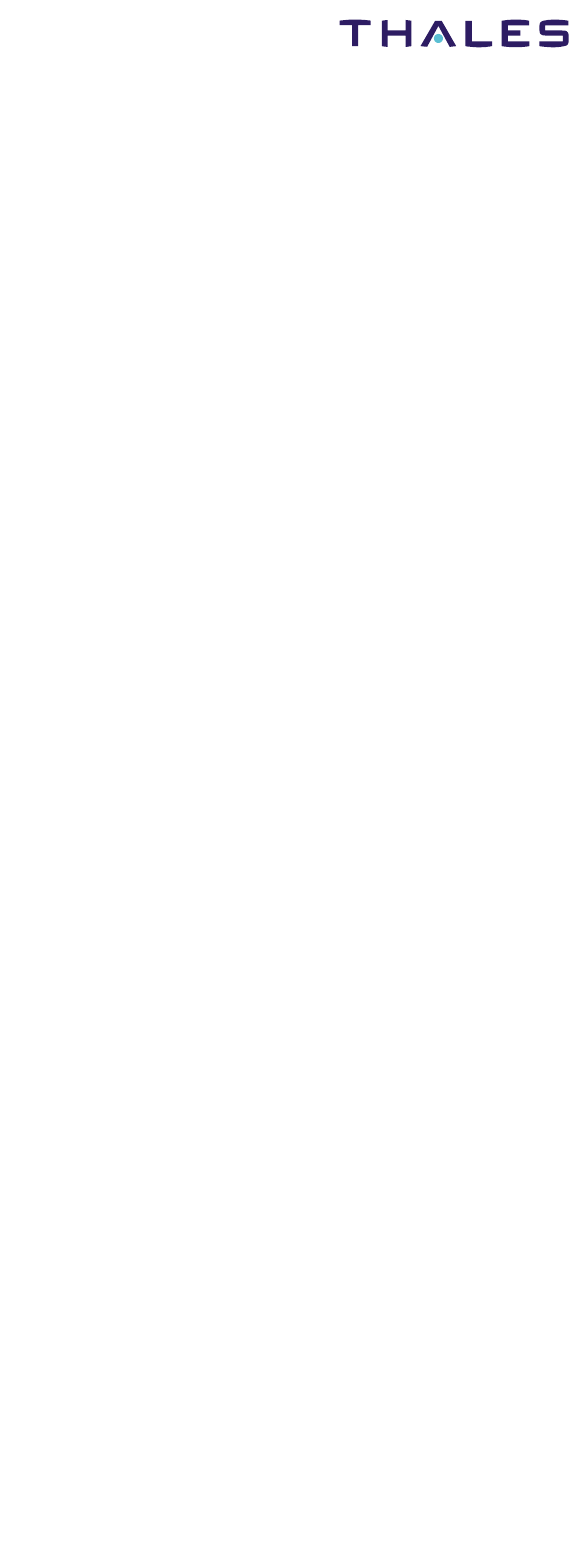
Installation Maintenance Manual
SDU 82155 Series
SCM 82158 Series
i
Jun 30/2008
© THALES AVIONICS Ltd. This document and any
information included are the property of Thales Avionics.
They cannot be reproduced, disclosed or utilized without the
company’s prior written approval
Section 1 INTRODUCTION Page
1.1. Purpose of Manual . . . . . . . . . . . . . . . . . . . . . . . . . . . . . . . . . . . . . . . . . . . . . . 1-1
1.2. Special Precautions . . . . . . . . . . . . . . . . . . . . . . . . . . . . . . . . . . . . . . . . . . . . . . 1-1
1.3. Contact Information . . . . . . . . . . . . . . . . . . . . . . . . . . . . . . . . . . . . . . . . . . . . . . 1-2
1.4. Scope of Manual . . . . . . . . . . . . . . . . . . . . . . . . . . . . . . . . . . . . . . . . . . . . . . . . 1-2
1.5. Reference documents . . . . . . . . . . . . . . . . . . . . . . . . . . . . . . . . . . . . . . . . . . . . 1-2
1.6. Compliance to Regulations . . . . . . . . . . . . . . . . . . . . . . . . . . . . . . . . . . . . . . . . 1-3
A. Federal Communication Commision . . . . . . . . . . . . . . . . . . . . . . . . . . . . . . 1-3
B. European Aviation Safety Agency. . . . . . . . . . . . . . . . . . . . . . . . . . . . . . . . 1-3
Section 2 DESCRIPTION Page
2.1. TFS Satellite Communication System Domain . . . . . . . . . . . . . . . . . . . . . . . . . 2-1
2.2. TFS System Overview . . . . . . . . . . . . . . . . . . . . . . . . . . . . . . . . . . . . . . . . . . . . 2-1
2.3. system Configurations . . . . . . . . . . . . . . . . . . . . . . . . . . . . . . . . . . . . . . . . . . . . 2-2
A. Single Aisle TFS System. . . . . . . . . . . . . . . . . . . . . . . . . . . . . . . . . . . . . . . 2-2
B. SDU Type 82155D TFS system . . . . . . . . . . . . . . . . . . . . . . . . . . . . . . . . . 2-3
2.4. SDU Component Description. . . . . . . . . . . . . . . . . . . . . . . . . . . . . . . . . . . . . . . 2-4
A. Hardware. . . . . . . . . . . . . . . . . . . . . . . . . . . . . . . . . . . . . . . . . . . . . . . . . . . 2-4
(1) SDU Type 82155A . . . . . . . . . . . . . . . . . . . . . . . . . . . . . . . . . . . . . . . . 2-4
(2) SDU Type 82155D . . . . . . . . . . . . . . . . . . . . . . . . . . . . . . . . . . . . . . . . 2-4
B. Functionality . . . . . . . . . . . . . . . . . . . . . . . . . . . . . . . . . . . . . . . . . . . . . . . . 2-5
(1) SDU Type 82155A.. . . . . . . . . . . . . . . . . . . . . . . . . . . . . . . . . . . . . . . . 2-5
(2) SDU Type 82155D.. . . . . . . . . . . . . . . . . . . . . . . . . . . . . . . . . . . . . . . . 2-5
C. Software . . . . . . . . . . . . . . . . . . . . . . . . . . . . . . . . . . . . . . . . . . . . . . . . . . . 2-6
D. ORT Parameters . . . . . . . . . . . . . . . . . . . . . . . . . . . . . . . . . . . . . . . . . . . . . 2-6
E. General Operation. . . . . . . . . . . . . . . . . . . . . . . . . . . . . . . . . . . . . . . . . . . . 2-6
F. Sub-modules Basic Detailed Operation . . . . . . . . . . . . . . . . . . . . . . . . . . . 2-7
G. Operating Environment . . . . . . . . . . . . . . . . . . . . . . . . . . . . . . . . . . . . . . . . 2-8
(1) Normal Operating temperature: . . . . . . . . . . . . . . . . . . . . . . . . . . . . . . 2-8
(2) Cooling:. . . . . . . . . . . . . . . . . . . . . . . . . . . . . . . . . . . . . . . . . . . . . . . . . 2-8
(3) Heat dissipation: . . . . . . . . . . . . . . . . . . . . . . . . . . . . . . . . . . . . . . . . . . 2-8
H. Environment Conditions . . . . . . . . . . . . . . . . . . . . . . . . . . . . . . . . . . . . . . . 2-8
I. Identification Label . . . . . . . . . . . . . . . . . . . . . . . . . . . . . . . . . . . . . . . . . . 2-10
J. Weight and Dimensions . . . . . . . . . . . . . . . . . . . . . . . . . . . . . . . . . . . . . . 2-12
(1) SDU Type 82155A . . . . . . . . . . . . . . . . . . . . . . . . . . . . . . . . . . . . . . . 2-12
(2) SDU Type 82155D . . . . . . . . . . . . . . . . . . . . . . . . . . . . . . . . . . . . . . . 2-12
K. SDU Electrical Characteristics . . . . . . . . . . . . . . . . . . . . . . . . . . . . . . . . . 2-15
2.5. System Interfaces . . . . . . . . . . . . . . . . . . . . . . . . . . . . . . . . . . . . . . . . . . . . . . 2-15
A. Aircraft Power Utility Service. . . . . . . . . . . . . . . . . . . . . . . . . . . . . . . . . . . 2-15
B. Avionics Interfaces . . . . . . . . . . . . . . . . . . . . . . . . . . . . . . . . . . . . . . . . . . 2-16
C. Cockpit Interfaces (SDU Type 82155D only) . . . . . . . . . . . . . . . . . . . . . . 2-17
D. Maintenance System Interfaces . . . . . . . . . . . . . . . . . . . . . . . . . . . . . . . . 2-17
2.6. SDU Configurable Pinout and Pin Description . . . . . . . . . . . . . . . . . . . . . . . . 2-17
A. Mandatory Configuration Pins. . . . . . . . . . . . . . . . . . . . . . . . . . . . . . . . . . 2-18
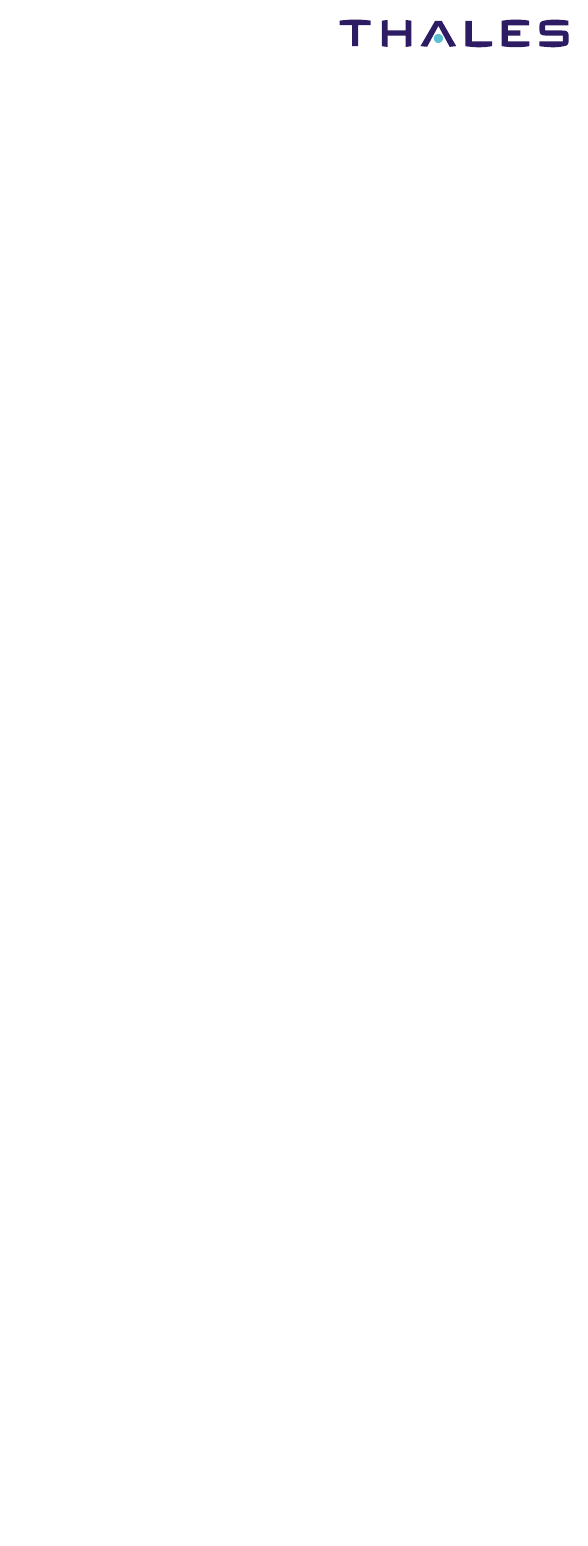
Installation Maintenance Manual
SDU 82155 Series
SCM 82158 Series
ii
Jun 30/2008
© THALES AVIONICS Ltd. This document and any
information included are the property of Thales Avionics.
They cannot be reproduced, disclosed or utilized without the
company’s prior written approval
2.7. SDU Interconnect Data . . . . . . . . . . . . . . . . . . . . . . . . . . . . . . . . . . . . . . . . . . 2-18
A. ARINC 600 Standard Interwiring Connector . . . . . . . . . . . . . . . . . . . . . . . 2-18
(1) ARINC 600 Pin Assignment . . . . . . . . . . . . . . . . . . . . . . . . . . . . . . . . 2-19
B. Electrical Interconnection Diagrams . . . . . . . . . . . . . . . . . . . . . . . . . . . . . 2-24
C. Interconnection Cables . . . . . . . . . . . . . . . . . . . . . . . . . . . . . . . . . . . . . . . 2-35
(1) RF Coaxial Cables . . . . . . . . . . . . . . . . . . . . . . . . . . . . . . . . . . . . . . . 2-35
(2) Power Cables . . . . . . . . . . . . . . . . . . . . . . . . . . . . . . . . . . . . . . . . . . . 2-36
(3) ARINC 429 Connections. . . . . . . . . . . . . . . . . . . . . . . . . . . . . . . . . . . 2-36
(4) Ethernet . . . . . . . . . . . . . . . . . . . . . . . . . . . . . . . . . . . . . . . . . . . . . . . 2-36
2.8. SCM Component Description . . . . . . . . . . . . . . . . . . . . . . . . . . . . . . . . . . . . . 2-36
A. Hardware. . . . . . . . . . . . . . . . . . . . . . . . . . . . . . . . . . . . . . . . . . . . . . . . . . 2-36
(1) External Description . . . . . . . . . . . . . . . . . . . . . . . . . . . . . . . . . . . . . . 2-36
(2) Internal Description. . . . . . . . . . . . . . . . . . . . . . . . . . . . . . . . . . . . . . . 2-37
B. ORT Parameters . . . . . . . . . . . . . . . . . . . . . . . . . . . . . . . . . . . . . . . . . . . . 2-38
C. ORT Synchronisation . . . . . . . . . . . . . . . . . . . . . . . . . . . . . . . . . . . . . . . . 2-39
D. Basic Operation. . . . . . . . . . . . . . . . . . . . . . . . . . . . . . . . . . . . . . . . . . . . . 2-39
E. Environment Condition . . . . . . . . . . . . . . . . . . . . . . . . . . . . . . . . . . . . . . . 2-39
F. Identification Label . . . . . . . . . . . . . . . . . . . . . . . . . . . . . . . . . . . . . . . . . . 2-40
G. SCM Electrical Characteristics . . . . . . . . . . . . . . . . . . . . . . . . . . . . . . . . . 2-41
H. Weight and Dimensions . . . . . . . . . . . . . . . . . . . . . . . . . . . . . . . . . . . . . . 2-41
I. SCM Connector. . . . . . . . . . . . . . . . . . . . . . . . . . . . . . . . . . . . . . . . . . . . . 2-42
J. Equipment Electrical Interconnection Diagram . . . . . . . . . . . . . . . . . . . . . 2-42
Section 3 INSTALLATION GUIDELINES Page
3.1. Introduction . . . . . . . . . . . . . . . . . . . . . . . . . . . . . . . . . . . . . . . . . . . . . . . . . . . . 3-1
3.2. Interchangeability . . . . . . . . . . . . . . . . . . . . . . . . . . . . . . . . . . . . . . . . . . . . . . . 3-1
3.3. SDU/SCM Location and Accessibility Guidelines . . . . . . . . . . . . . . . . . . . . . . . 3-2
3.4. Mounting Tray . . . . . . . . . . . . . . . . . . . . . . . . . . . . . . . . . . . . . . . . . . . . . . . . . . 3-2
3.5. Cooling . . . . . . . . . . . . . . . . . . . . . . . . . . . . . . . . . . . . . . . . . . . . . . . . . . . . . . . 3-3
3.6. Power Requirements . . . . . . . . . . . . . . . . . . . . . . . . . . . . . . . . . . . . . . . . . . . . . 3-3
3.7. SDU RF Connections . . . . . . . . . . . . . . . . . . . . . . . . . . . . . . . . . . . . . . . . . . . . 3-4
D. Insertion Losses . . . . . . . . . . . . . . . . . . . . . . . . . . . . . . . . . . . . . . . . . . . . . 3-4
E. Product InterModulation (PIM) . . . . . . . . . . . . . . . . . . . . . . . . . . . . . . . . . . 3-5
F. VSWR . . . . . . . . . . . . . . . . . . . . . . . . . . . . . . . . . . . . . . . . . . . . . . . . . . . . . 3-5
G. Torque Settings. . . . . . . . . . . . . . . . . . . . . . . . . . . . . . . . . . . . . . . . . . . . . . 3-5
H. Cleaning . . . . . . . . . . . . . . . . . . . . . . . . . . . . . . . . . . . . . . . . . . . . . . . . . . . 3-5
3.8. Bonding Requirements . . . . . . . . . . . . . . . . . . . . . . . . . . . . . . . . . . . . . . . . . . . 3-5
Section 4 INSPECTION AND SYSTEM CHECKOUT Page
4.1. Inspection/Check Procedure . . . . . . . . . . . . . . . . . . . . . . . . . . . . . . . . . . . . . . . 4-1
A. Check Wiring and RF cables. . . . . . . . . . . . . . . . . . . . . . . . . . . . . . . . . . . . 4-1
B. Check SDU . . . . . . . . . . . . . . . . . . . . . . . . . . . . . . . . . . . . . . . . . . . . . . . . . 4-1
C. Check SCM . . . . . . . . . . . . . . . . . . . . . . . . . . . . . . . . . . . . . . . . . . . . . . . . . 4-2
4.2. System checkout . . . . . . . . . . . . . . . . . . . . . . . . . . . . . . . . . . . . . . . . . . . . . . . . 4-2
A. Post-Installation Test. . . . . . . . . . . . . . . . . . . . . . . . . . . . . . . . . . . . . . . . . . 4-2
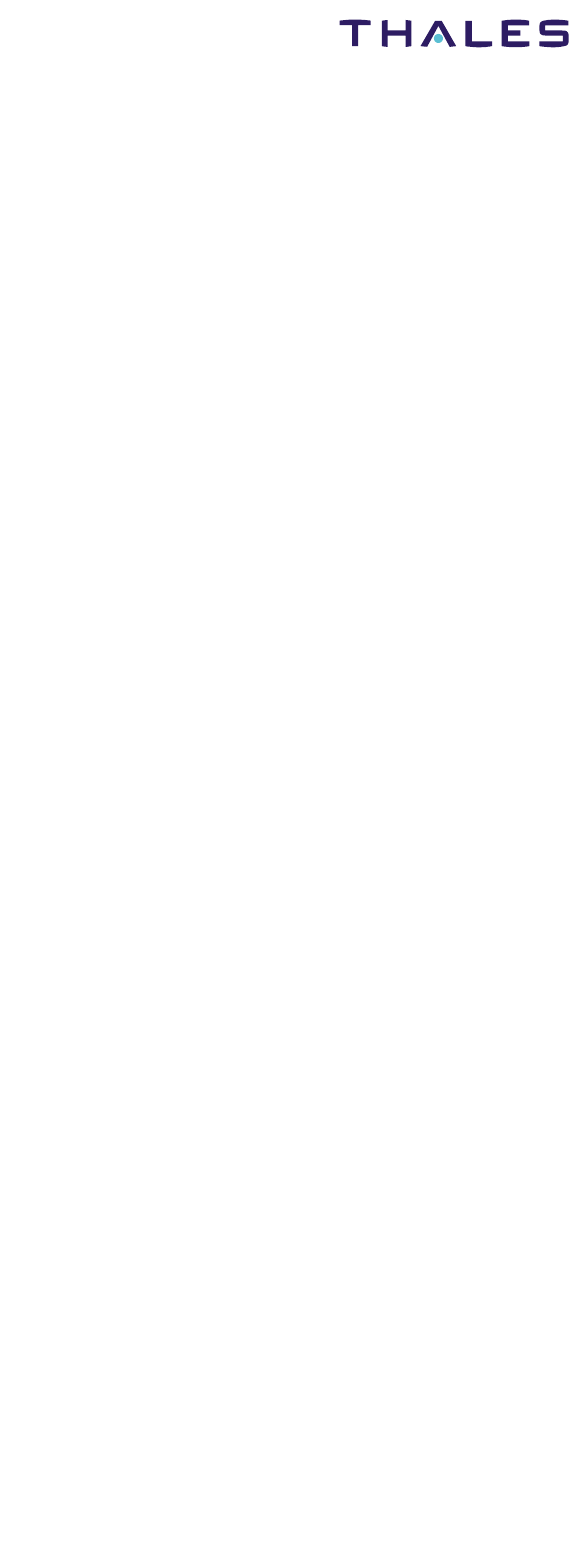
Installation Maintenance Manual
SDU 82155 Series
SCM 82158 Series
iii
Jun 30/2008
© THALES AVIONICS Ltd. This document and any
information included are the property of Thales Avionics.
They cannot be reproduced, disclosed or utilized without the
company’s prior written approval
Section 5 FAULT ISOLATION Page
5.1. Bite Function . . . . . . . . . . . . . . . . . . . . . . . . . . . . . . . . . . . . . . . . . . . . . . . . . . . 5-1
5.2. Test Functions . . . . . . . . . . . . . . . . . . . . . . . . . . . . . . . . . . . . . . . . . . . . . . . . . . 5-2
A. OMS or CFDS . . . . . . . . . . . . . . . . . . . . . . . . . . . . . . . . . . . . . . . . . . . . . . . 5-2
B. BITE . . . . . . . . . . . . . . . . . . . . . . . . . . . . . . . . . . . . . . . . . . . . . . . . . . . . . . 5-2
(1) POST . . . . . . . . . . . . . . . . . . . . . . . . . . . . . . . . . . . . . . . . . . . . . . . . . . 5-3
(2) PAST . . . . . . . . . . . . . . . . . . . . . . . . . . . . . . . . . . . . . . . . . . . . . . . . . . 5-4
5.3. fault isolation . . . . . . . . . . . . . . . . . . . . . . . . . . . . . . . . . . . . . . . . . . . . . . . . . . . 5-5
A. Failures . . . . . . . . . . . . . . . . . . . . . . . . . . . . . . . . . . . . . . . . . . . . . . . . . . . . 5-5
B. Front Panel Indications . . . . . . . . . . . . . . . . . . . . . . . . . . . . . . . . . . . . . . . . 5-5
C. Fault Logging . . . . . . . . . . . . . . . . . . . . . . . . . . . . . . . . . . . . . . . . . . . . . . . 5-8
D. Service Availability Discretes . . . . . . . . . . . . . . . . . . . . . . . . . . . . . . . . . . . 5-8
E. Service Availability Discrete Lamps . . . . . . . . . . . . . . . . . . . . . . . . . . . . . . 5-9
F. CFDS/ARINC 604 BITE . . . . . . . . . . . . . . . . . . . . . . . . . . . . . . . . . . . . . . . 5-9
Section 6 MAINTENANCE Practices Page
6.1. General . . . . . . . . . . . . . . . . . . . . . . . . . . . . . . . . . . . . . . . . . . . . . . . . . . . . . . . 6-1
6.2. Equipment and Materials . . . . . . . . . . . . . . . . . . . . . . . . . . . . . . . . . . . . . . . . . . 6-1
6.3. Procedure For The SDU . . . . . . . . . . . . . . . . . . . . . . . . . . . . . . . . . . . . . . . . . . 6-2
A. Removal and Installation Procedure . . . . . . . . . . . . . . . . . . . . . . . . . . . . . . 6-2
(1) Remove the SDU . . . . . . . . . . . . . . . . . . . . . . . . . . . . . . . . . . . . . . . . . 6-2
(2) Install the SDU . . . . . . . . . . . . . . . . . . . . . . . . . . . . . . . . . . . . . . . . . . . 6-3
B. Adjustment Procedure. . . . . . . . . . . . . . . . . . . . . . . . . . . . . . . . . . . . . . . . . 6-3
C. Repair Procedure . . . . . . . . . . . . . . . . . . . . . . . . . . . . . . . . . . . . . . . . . . . . 6-3
D. Return to Service Procedures . . . . . . . . . . . . . . . . . . . . . . . . . . . . . . . . . . . 6-3
6.4. Procedure For The SCM . . . . . . . . . . . . . . . . . . . . . . . . . . . . . . . . . . . . . . . . . . 6-4
A. Removal and Installation Procedure . . . . . . . . . . . . . . . . . . . . . . . . . . . . . . 6-4
(1) Remove the SCM . . . . . . . . . . . . . . . . . . . . . . . . . . . . . . . . . . . . . . . . . 6-4
(2) Install the SCM . . . . . . . . . . . . . . . . . . . . . . . . . . . . . . . . . . . . . . . . . . . 6-4
B. Adjustment Procedure. . . . . . . . . . . . . . . . . . . . . . . . . . . . . . . . . . . . . . . . . 6-5
C. Repair Procedure . . . . . . . . . . . . . . . . . . . . . . . . . . . . . . . . . . . . . . . . . . . . 6-5
D. Return to Service Procedures . . . . . . . . . . . . . . . . . . . . . . . . . . . . . . . . . . . 6-5
6.5. Cleaning of Mechanical Parts . . . . . . . . . . . . . . . . . . . . . . . . . . . . . . . . . . . . . . 6-5
6.6. Periodic Checks. . . . . . . . . . . . . . . . . . . . . . . . . . . . . . . . . . . . . . . . . . . . . . . . . 6-6
6.7. Cabling and Connections. . . . . . . . . . . . . . . . . . . . . . . . . . . . . . . . . . . . . . . . . . 6-6
6.8. Instructions For Continued Airworthiness . . . . . . . . . . . . . . . . . . . . . . . . . . . . . 6-6
Section 7 COMMISSIONING Page
7.1. General . . . . . . . . . . . . . . . . . . . . . . . . . . . . . . . . . . . . . . . . . . . . . . . . . . . . . . . 7-1
A. Registration . . . . . . . . . . . . . . . . . . . . . . . . . . . . . . . . . . . . . . . . . . . . . . . . . 7-1
B. Classic Packet Data Verification . . . . . . . . . . . . . . . . . . . . . . . . . . . . . . . . . 7-3
C. Classic Cockpit Voice Calls. . . . . . . . . . . . . . . . . . . . . . . . . . . . . . . . . . . . . 7-3
D. SBB Cabin Wifi Data Connectivity (Background Context) . . . . . . . . . . . . . 7-3
E. SBB Cabin Wifi Data Connectivity (Streaming Context) . . . . . . . . . . . . . . . 7-4
F. Cabin VoIP service . . . . . . . . . . . . . . . . . . . . . . . . . . . . . . . . . . . . . . . . . . . 7-5
G. Cabin ISDN Data service . . . . . . . . . . . . . . . . . . . . . . . . . . . . . . . . . . . . . . 7-5
H. Cabin ISDN Voice service . . . . . . . . . . . . . . . . . . . . . . . . . . . . . . . . . . . . . . 7-6
I. Cabin GSM Call and SMS Service . . . . . . . . . . . . . . . . . . . . . . . . . . . . . . . 7-7
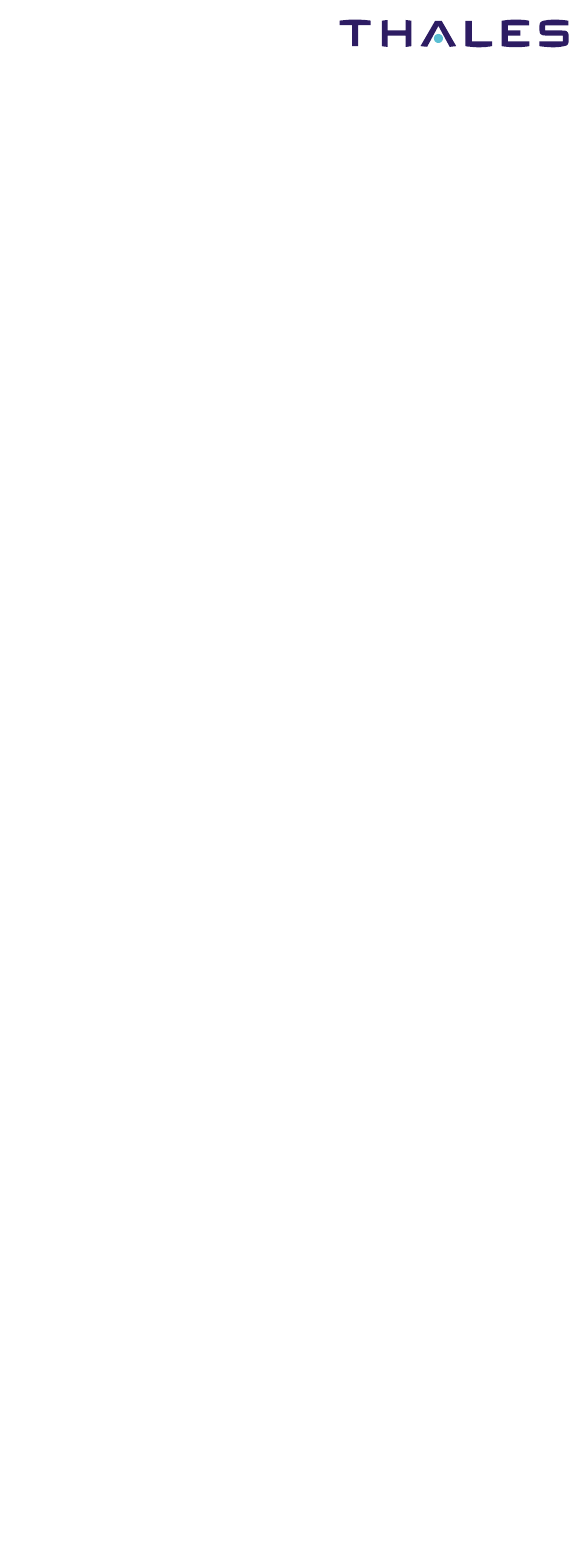
Installation Maintenance Manual
SDU 82155 Series
SCM 82158 Series
iv
Jun 30/2008
© THALES AVIONICS Ltd. This document and any
information included are the property of Thales Avionics.
They cannot be reproduced, disclosed or utilized without the
company’s prior written approval
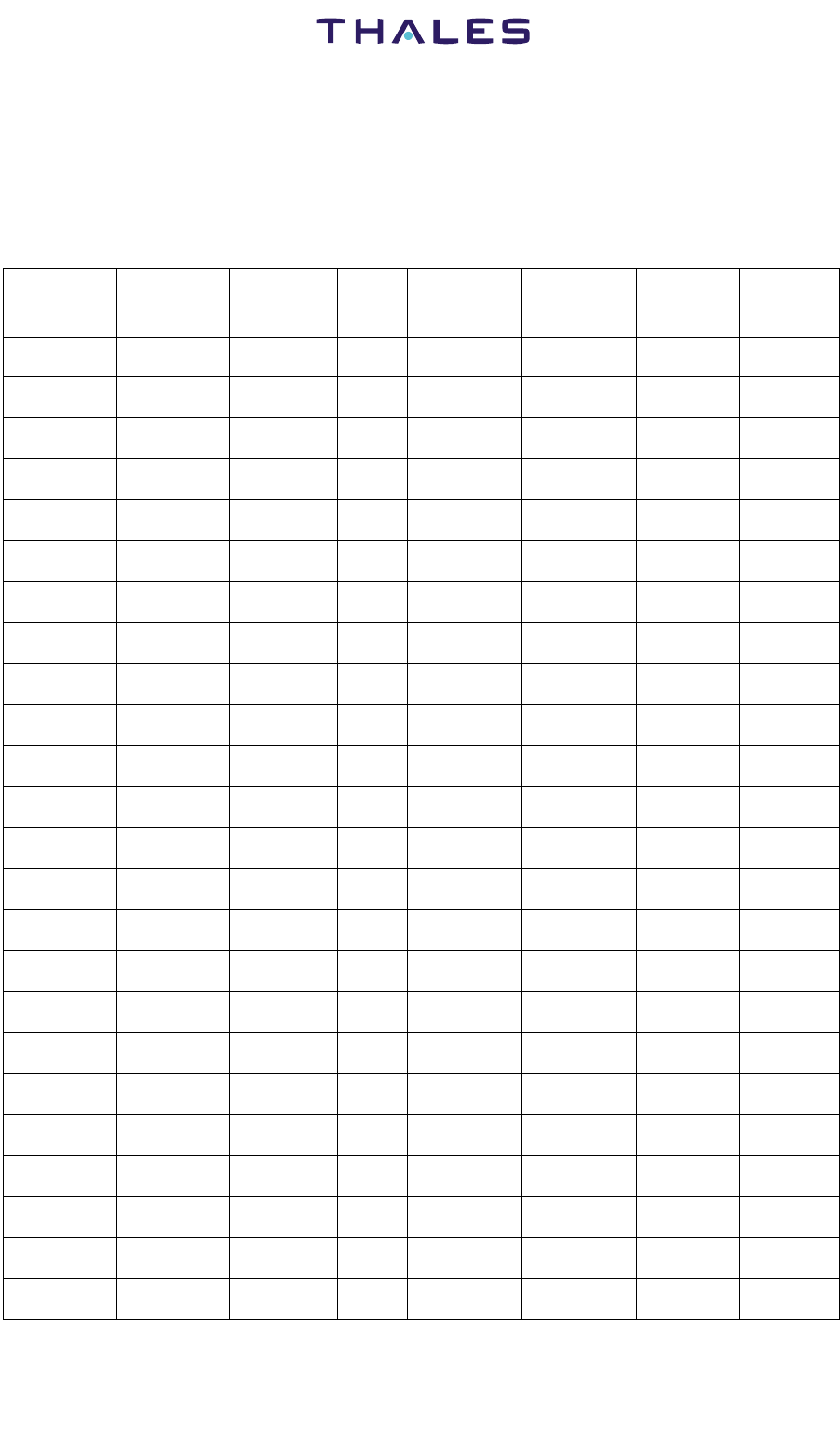
Installation Maintenance Manual
SDU 82155 Series
SCM 82158 Series
v
Jun 30/2008
© THALES AVIONICS Ltd. This document and any
information included are the property of Thales Avionics.
They cannot be reproduced, disclosed or utilized without the
company’s prior written approval
RECORD OF REVISIONS
Revision
No:
Revision
Date
Date
Inserted
By Revision
No:
Revision
Date
Date
Inserted
By
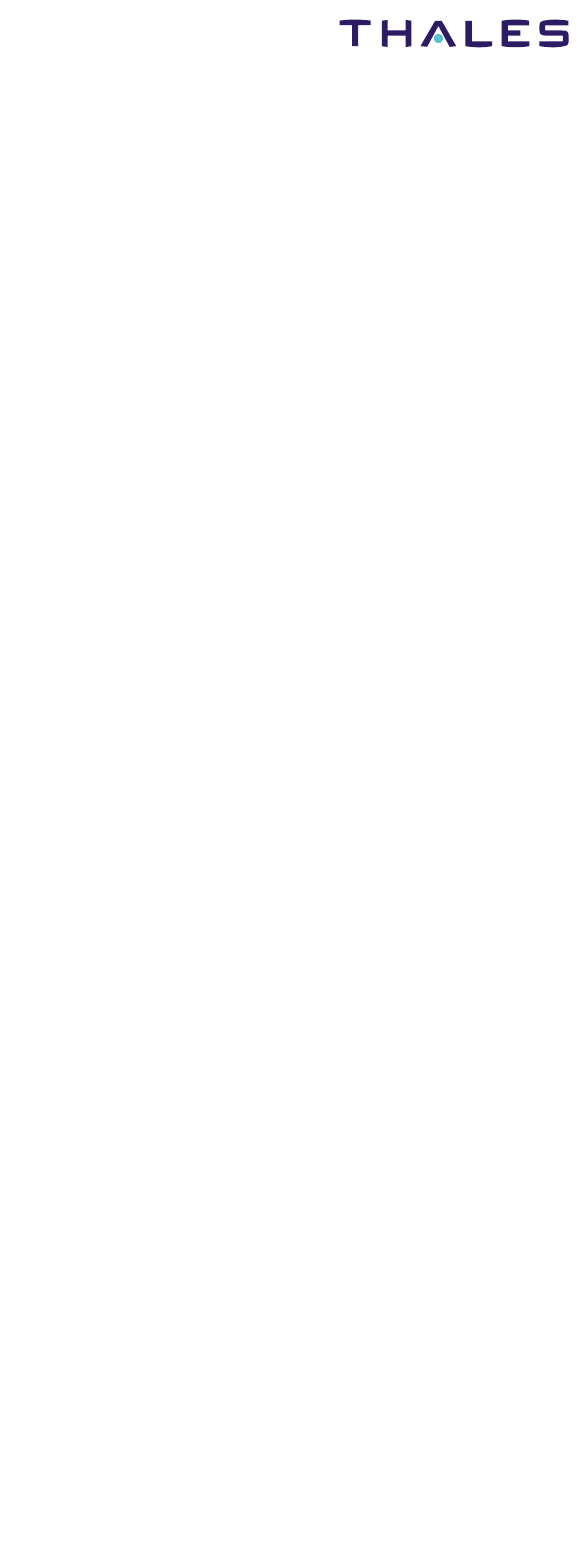
Installation Maintenance Manual
SDU 82155 Series
SCM 82158 Series
vi
Jun 30/2008
© THALES AVIONICS Ltd. This document and any
information included are the property of Thales Avionics.
They cannot be reproduced, disclosed or utilized without the
company’s prior written approval
THIS PAGE INTENTIONALLY BLANK
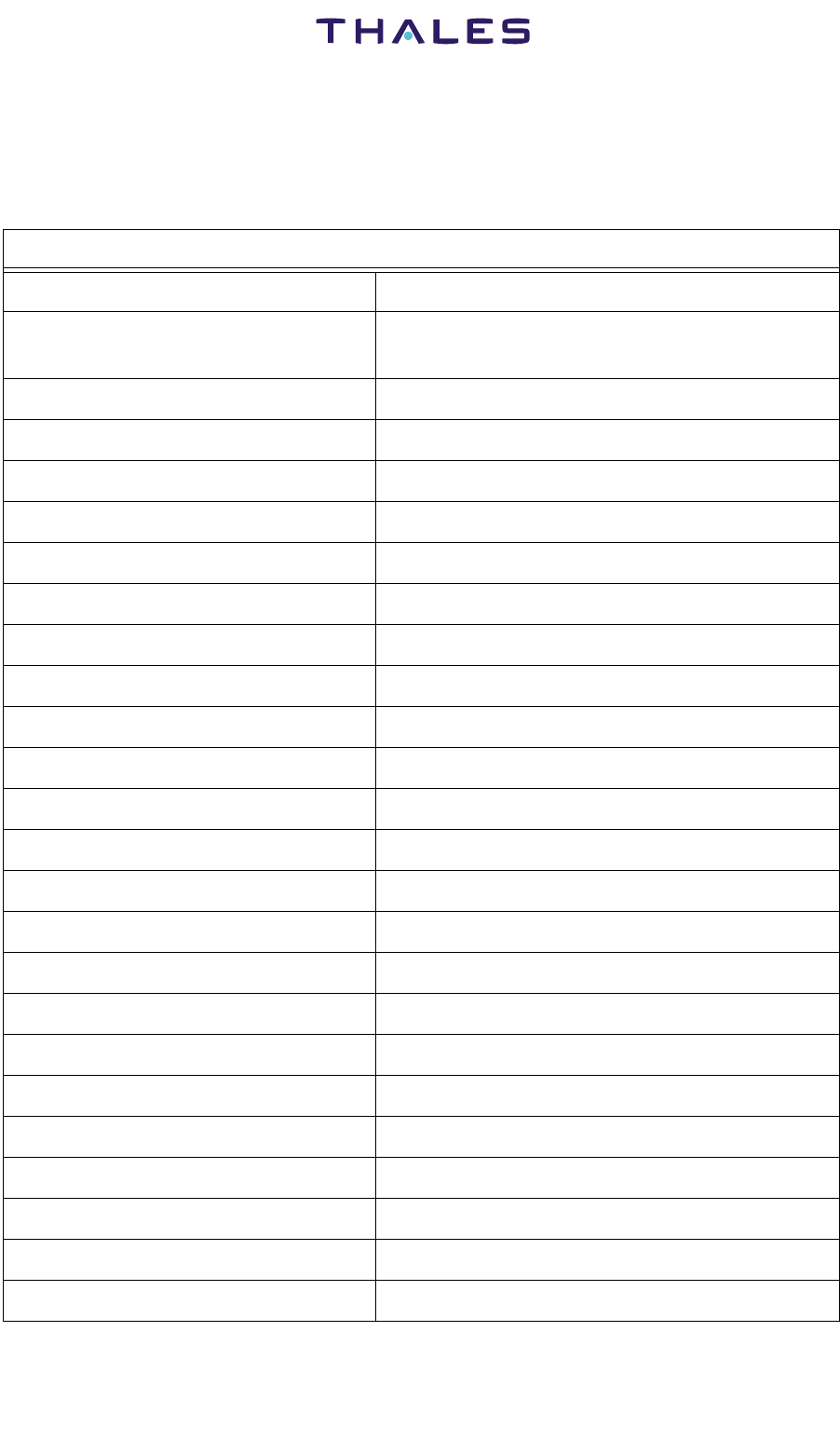
Installation Maintenance Manual
SDU 82155 Series
SCM 82158 Series
vii
Jun 30/2008
© THALES AVIONICS Ltd. This document and any
information included are the property of Thales Avionics.
They cannot be reproduced, disclosed or utilized without the
company’s prior written approval
List of Abbreviations
ac Alternating Current
ACARS Aircraft Communication Addressing and Report-
ing System
ADL Airborne Data Loader
AES Aeronautical Earth Station
AGS Airborne GSM Server
AIM Antenna Interface Mounting
AMO Approved Maintenance Organization
AMU Audio Management Unit
AOR-E Atlantic Ocean Region-East
AOR-W Atlantic Ocean Region-West
APM Avionics Processor Module
ARINC Aeronautical Radio Inc
ATE Automatic Test Equipment
BGAN Broadband Global Area Network
BITE Built In Test Equipment
BSU Beam Steering Unit
CCM Channel Card Module
CDU Control Display Unit
CFDS Cenralised Fault Display System
CMM Component Maintenance Manual
CMU Communication Management Unit
CPM Communication Processor Module
dc Direct Current
DLNA Diplexer and Low Noise Amplifier
EASA European Aviation Safety Agency
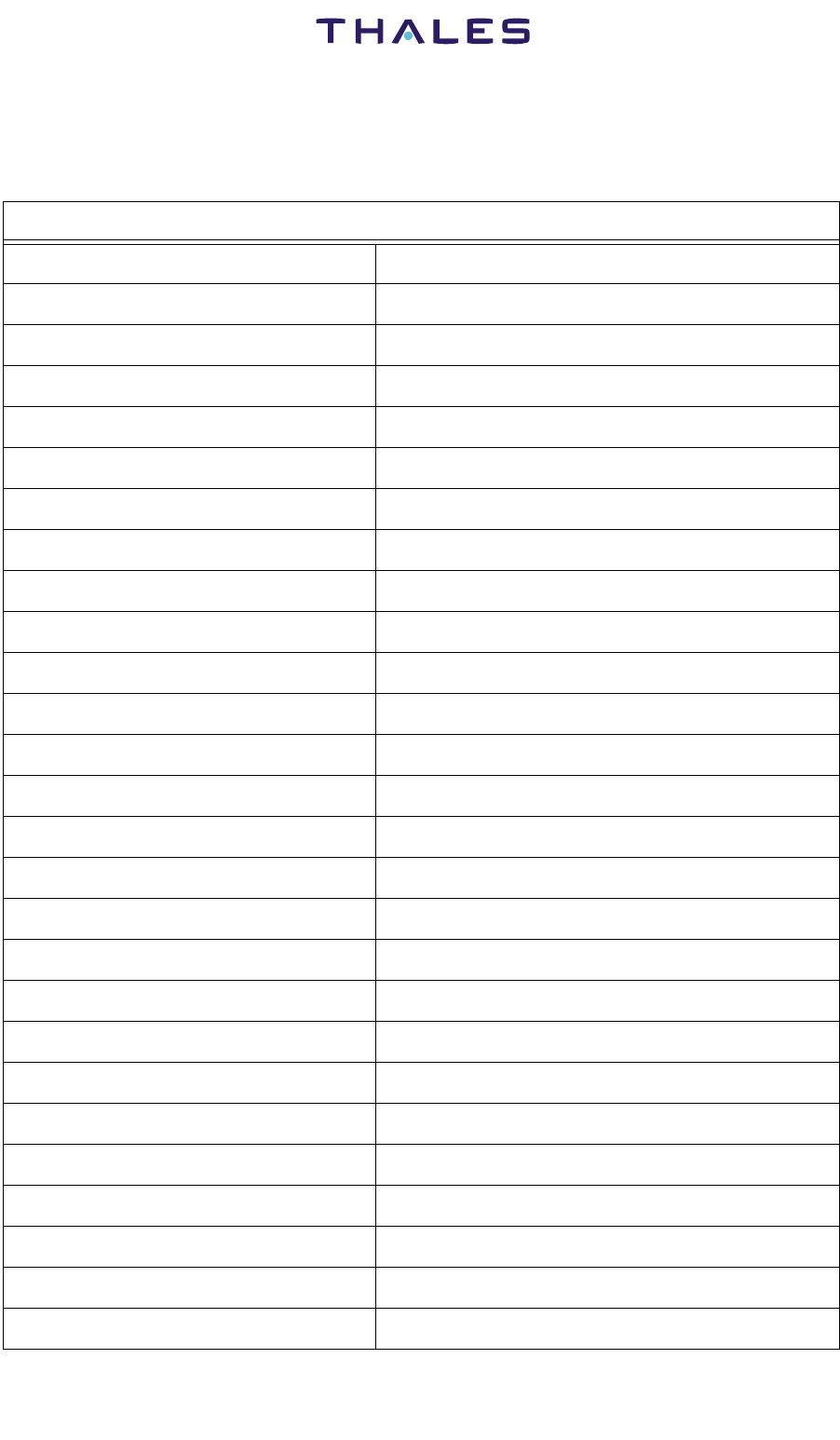
Installation Maintenance Manual
SDU 82155 Series
SCM 82158 Series
viii
Jun 30/2008
© THALES AVIONICS Ltd. This document and any
information included are the property of Thales Avionics.
They cannot be reproduced, disclosed or utilized without the
company’s prior written approval
ECM External Configuration Memory
ECS Environmental Control System
EMC Electromagnetic Compatibility
ESD Electro Static Discharge
ESDS Electro Static Discharge Sensitive
FMHPA Flange Mounted High Power Amplifier
FPL Front Panel LED
GES Ground Earth Station
GNSS Global Navigation Satellite System
GPS Global Positioning System
HPA High Power Amplifier
IGA Intermediate Gain Antenna
IMEI International Mobile Equipment Identity
IMM Installation and Maintenance Manual
IMSI International Mobile Subscriber Identity
INMARSAT International Maritime Satellite Organization
IOR Indian Ocean Region
IP Internet Protocol
IPC Illustrated Parts List
IRS Inertial Reference System
I/O Input/Output
ISDN Integrated Service Digital Network
LED Light Emitting Diode
LES Land Earth Station
LRU Line Replaceable Unit
mA MilliAmpere
MCDU Multi-function Control and Display Unit
List of Abbreviations
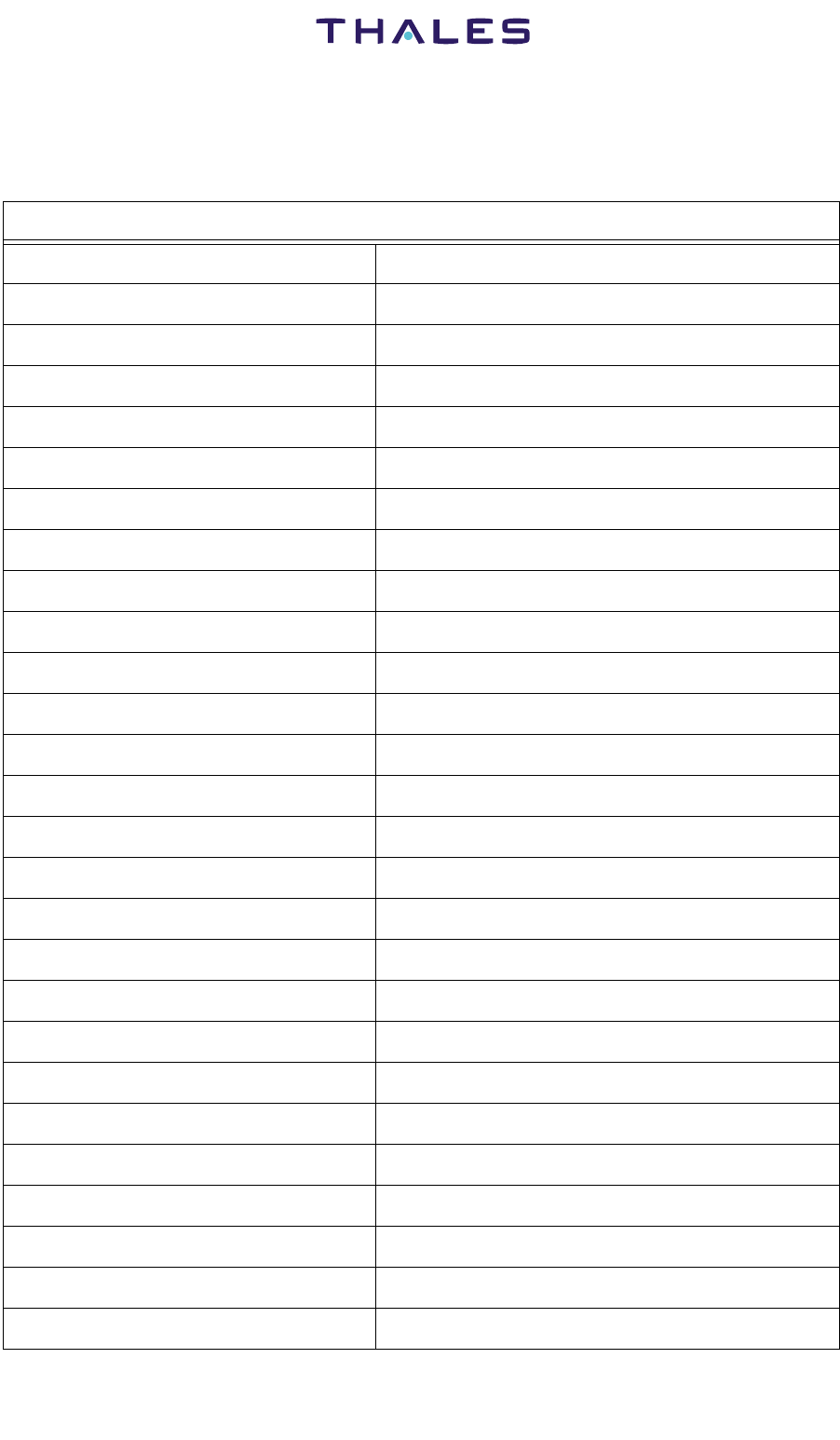
Installation Maintenance Manual
SDU 82155 Series
SCM 82158 Series
ix
Jun 30/2008
© THALES AVIONICS Ltd. This document and any
information included are the property of Thales Avionics.
They cannot be reproduced, disclosed or utilized without the
company’s prior written approval
MCU Modular Concept Unit
MEL Minimum Equipment Level
MES Mobile Earth Station
MIB Management Information Base
NVM Non Volatile Memory
OMS Onboard Monitoring System
ORT Owner Requirements Table
OCXO Oven Controlled Crystal Oscillator
PAST Person Activated Self Test
PC Personal Computer
PLMN Public Land Mobile Network
PNR Part Number
POR Pacific Ocean Region
POST Power On Self-Test
PPPoE Point To Point Protocol over Ethernet
PSM Power Supply Module
PSTN Public Switched Telephone Network
RF Radio Frequency
SA Single Aisle
SATCOM Satellite Communication
SBB SwiftBroadband
SCDU Satellite Control Display Unit
SCM SDU Configuration Module
SDU Satellite Data Unit
SIM Subscriber Identity Module
SIS Standalone Interface System
SNMP Simple Network Management Protocol
List of Abbreviations
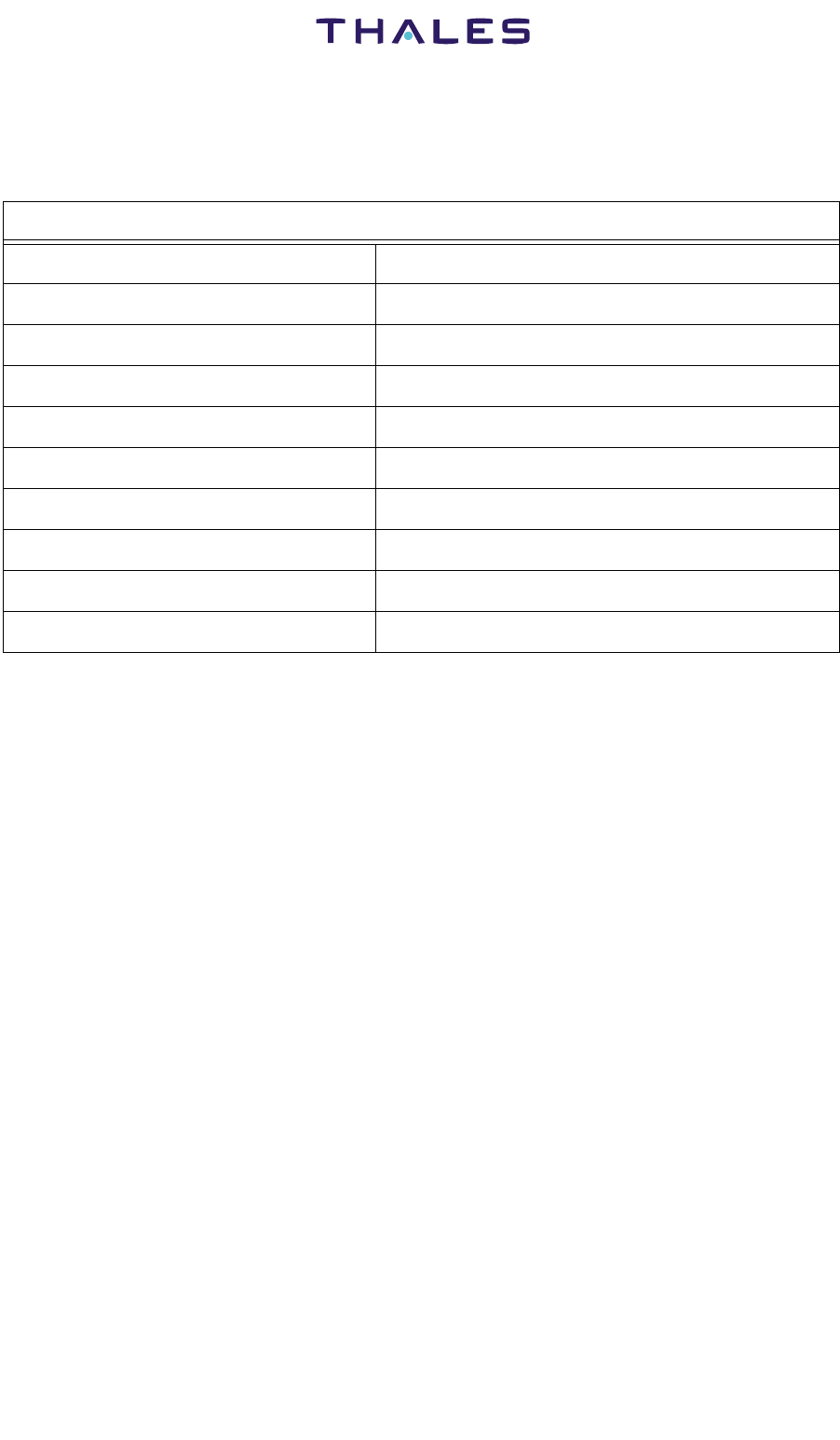
Installation Maintenance Manual
SDU 82155 Series
SCM 82158 Series
x
Jun 30/2008
© THALES AVIONICS Ltd. This document and any
information included are the property of Thales Avionics.
They cannot be reproduced, disclosed or utilized without the
company’s prior written approval
SRU Shop Replaceable Unit
STC Supplemental Type Certificate
SW Software
TCP/IP Transmission Control Protocol/Internet Protocol
TFS TopFlight Satcom
UMTS Universal Mobile Telecommunication System
USIM Universal Subscriber Identity Module
Wi Fi Wireless Fidelity
WLAN Wireless Local Area Network
WOW Weight On Wheels
List of Abbreviations
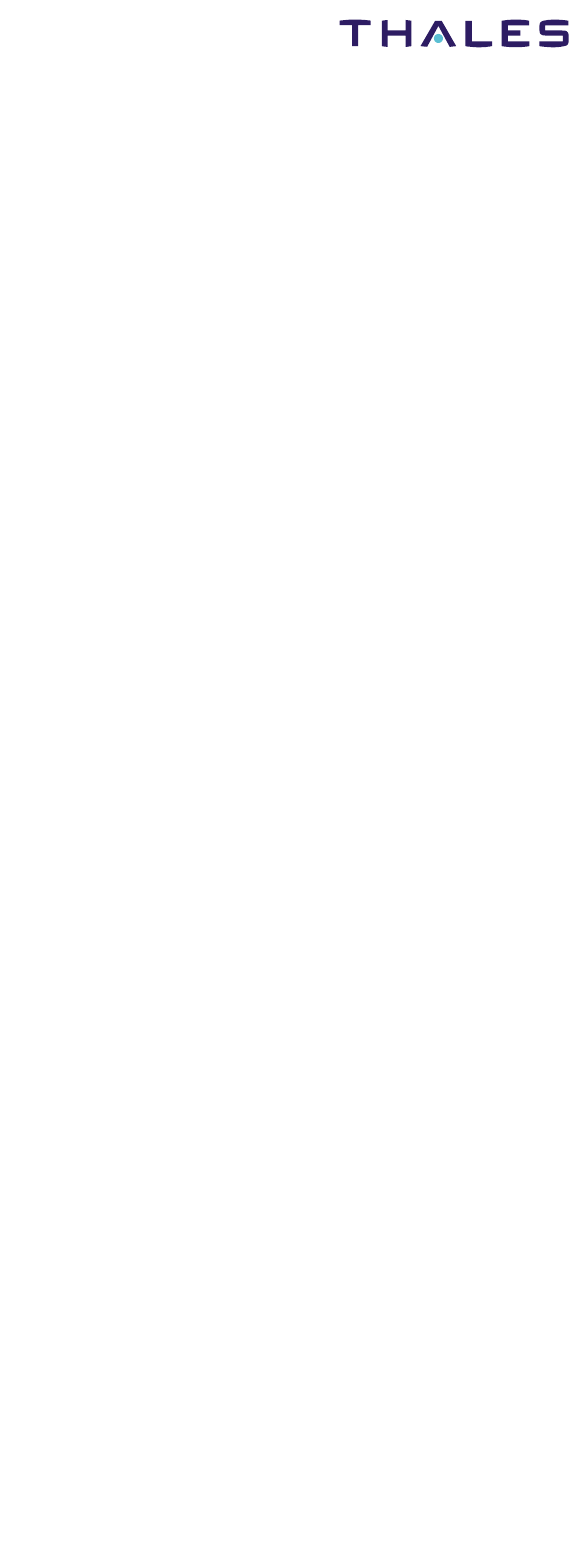
Installation Maintenance Manual
SDU 82155 Series
SCM 82158 Series
1-1
Jun 30/2008
© THALES AVIONICS Ltd. This document and any
information included are the property of Thales Avionics.
They cannot be reproduced, disclosed or utilized without the
company’s prior written approval
SECTION 1
10000INTRODUCTION
1.1. PURPOSE OF MANUAL
This manual sets forth installation and maintenance guidelines, and theory of operation
for the THALES TopFlight Satcom (TFS) Satellite Data Unit (SDU), and SDU
Configuration Module (SCM). The SDU and SCM installation specific and general
guidelines contained within this manual are supported by mechanical and electrical
interconnection drawings and interface information. Drawings should be reviewed by
the installation organisation, and any requirements specific to a particular airframe
should be assessed before installation is commenced.
The Manual covers the following topics:
a. Title Page
b. Record of Revisions
c. Table of Content
d. Introduction
e. Description
f. Installation Guidelines
g. Inspection and System Checkout
h. Fault Isolation
i. Maintenance Practices
j. Commissioning.
1.2. SPECIAL PRECAUTIONS
Advisory notes presented within this manual such as: ‘Warnings, Cautions and Notes’
are applicable to the TFS system as follows:
a. A WARNING is used to alert the reader to possible hazard which may
cause loss of life or physical injury
b. A CAUTION is used to denote the possibility of damage to materiel but
not danger to personnel
c. A NOTE is used to convey, or draw attention to, information that is
extraneous to the immediate subject of the text.
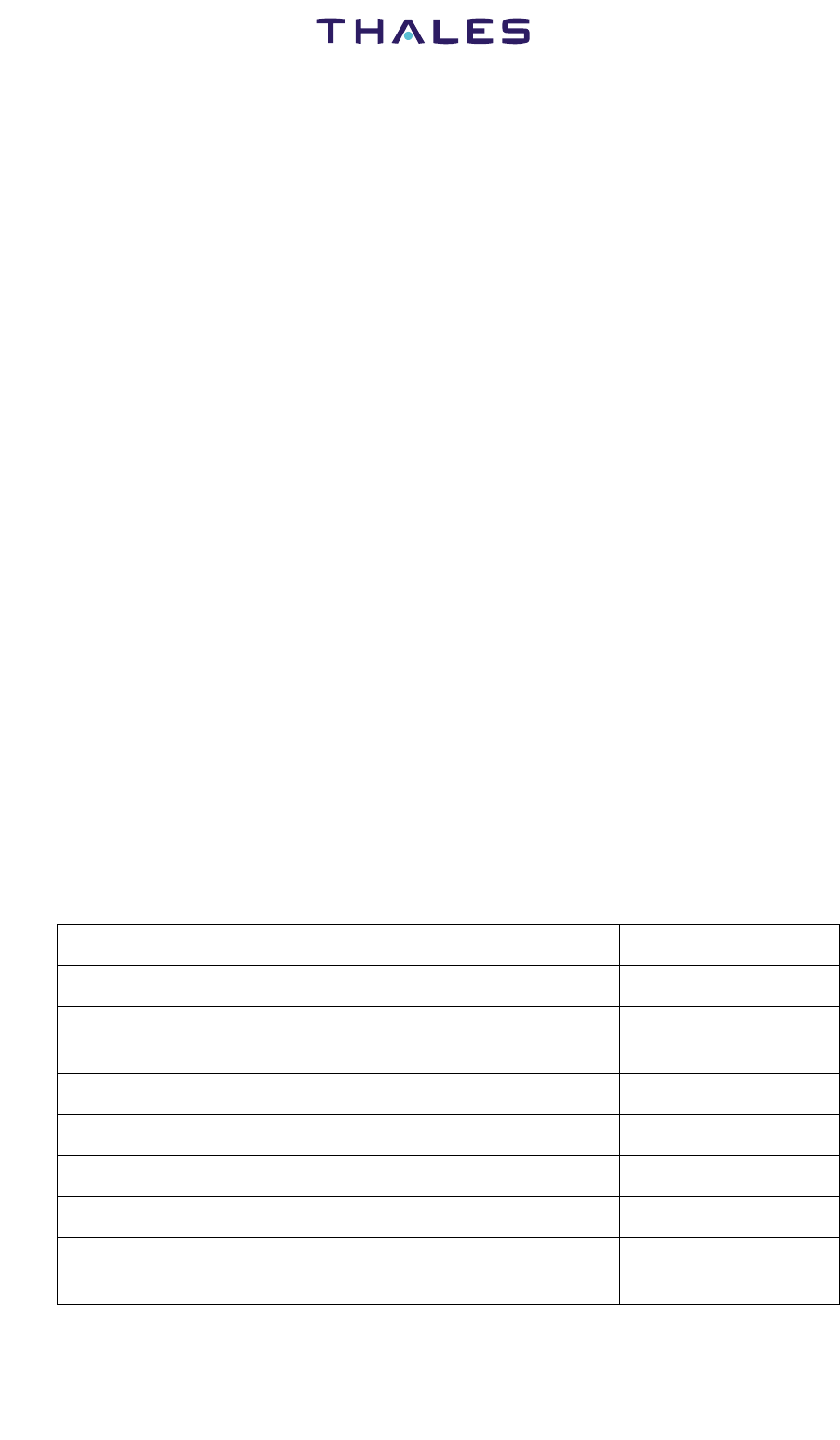
Installation Maintenance Manual
SDU 82155 Series
SCM 82158 Series
1-2
Jun 30/2008
© THALES AVIONICS Ltd. This document and any
information included are the property of Thales Avionics.
They cannot be reproduced, disclosed or utilized without the
company’s prior written approval
1.3. CONTACT INFORMATION
For any queries related to information contained within this Manual contact the
following:
THALES TFS Project Manager
86 Bushey Road
Raynes Park, London
SW20 0JW, UK
Tel. +44 (0)20 8946 8011
Fax. +44 (0)20 8946 7530
1.4. SCOPE OF MANUAL
The Thales SDU and SCM comply with the design requirements set forward in the
ARINC 781 Characteristic. An ARINC 781 compliant system is intended to support one
or more of the Inmarsat aeronautical services known as ‘Classic-Aero’, ‘Swift 64’, and
‘SwiftBroadband.
This manual provides information specific for the SDU and SCM capable of providing
those services highlighted above. The SDU and SCM covered in this manual support
Inmarsat Class 3A, 6 and 7 services only.
1.5. REFERENCE DOCUMENTS
The following publications provide additional useful information:
Table 1.1 Reference Documents
THALES SCM Component Maintenance Manual 44-35-33
THALES SDU Component Maintenance Manual 44-35-32
EMS AMT-3500 Intermediate Gain Antenna Subsystem
Installation Manual
MN-1242-20047
Mark 33 Digital Information Transfer System ARINC 429
Air Transport Avionics Equipment Interfaces ARINC 600
Airborne Computer High speed Data Loader ARINC 615
Ethernet Based Data loading ARINC 615A
Mark III Aviation Satellite Communication (Satcom) Sys-
tem Avionics
ARINC 781
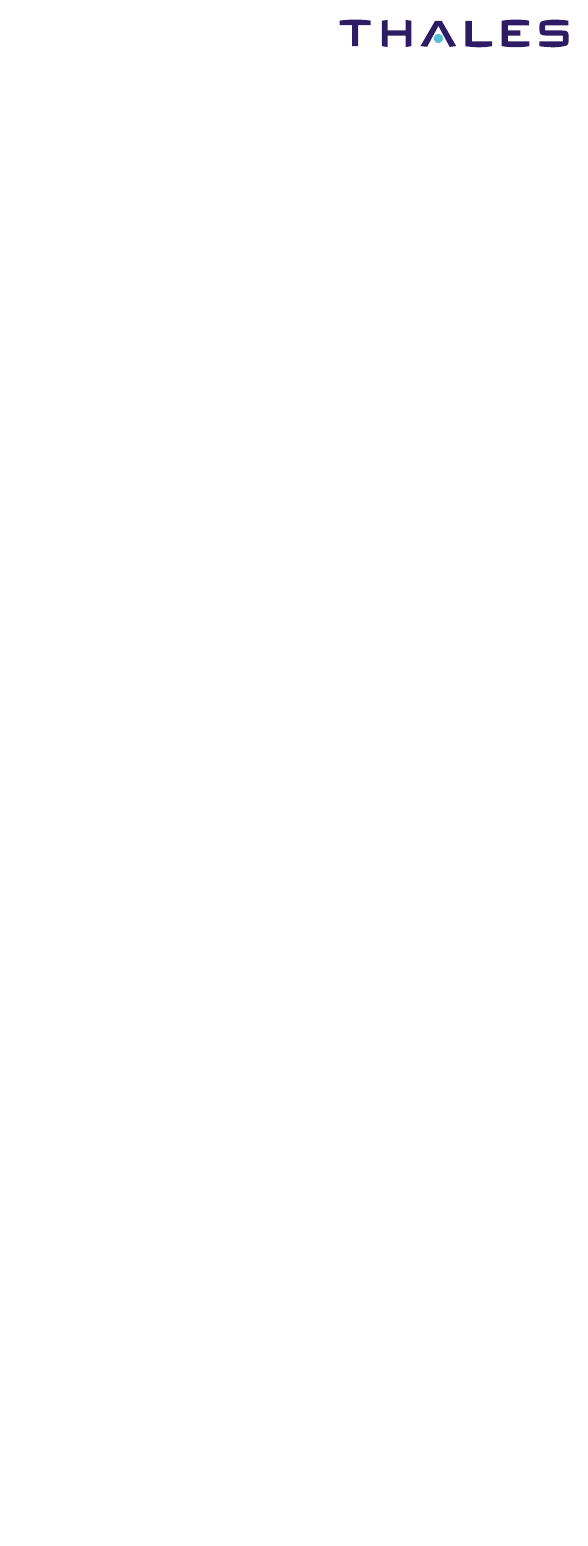
Installation Maintenance Manual
SDU 82155 Series
SCM 82158 Series
1-3
Jun 30/2008
© THALES AVIONICS Ltd. This document and any
information included are the property of Thales Avionics.
They cannot be reproduced, disclosed or utilized without the
company’s prior written approval
1.6. COMPLIANCE TO REGULATIONS
A. Federal Communication Commision
The SDU is designed to be compliant with part 15 and part 87 of the Federal
Communication Commission (FCC) regulations
B. European Aviation Safety Agency
The installation must be compliant to the following European Aviation Safety Agency
(EASA) regulations:
• EASA/FAR 25.869 Fire protection: systems
• EASA 25X0899 Electrical bonding and protection against lightning and
static electricity
• EASA/FAR 25.1301 Equipment, general, function and installation
• EASA/FAR 25.1309 Equipment, systems and installations
• EASA 25X1316 System lightning protection
• EASA/FAR 25.1353 Electrical equipment and installations
• EASA/FAR 25.1357 Circuit protective devices
• EASA 25X1360 Precautions against injury
• EASA/FAR 25.1431 Electronic equipment
• EASA 25.561 Emergency Landing.
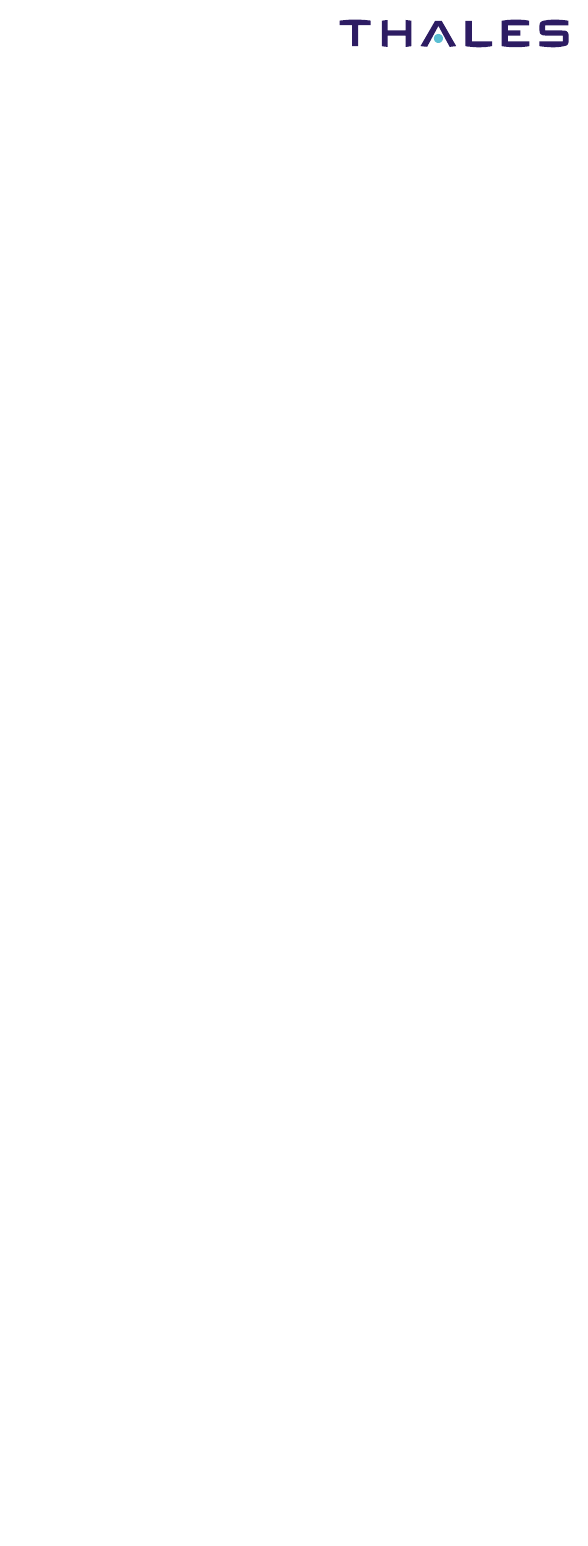
Installation Maintenance Manual
SDU 82155 Series
SCM 82158 Series
1-4
Jun 30/2008
© THALES AVIONICS Ltd. This document and any
information included are the property of Thales Avionics.
They cannot be reproduced, disclosed or utilized without the
company’s prior written approval
THIS PAGE INTENTIONALLY BLANK
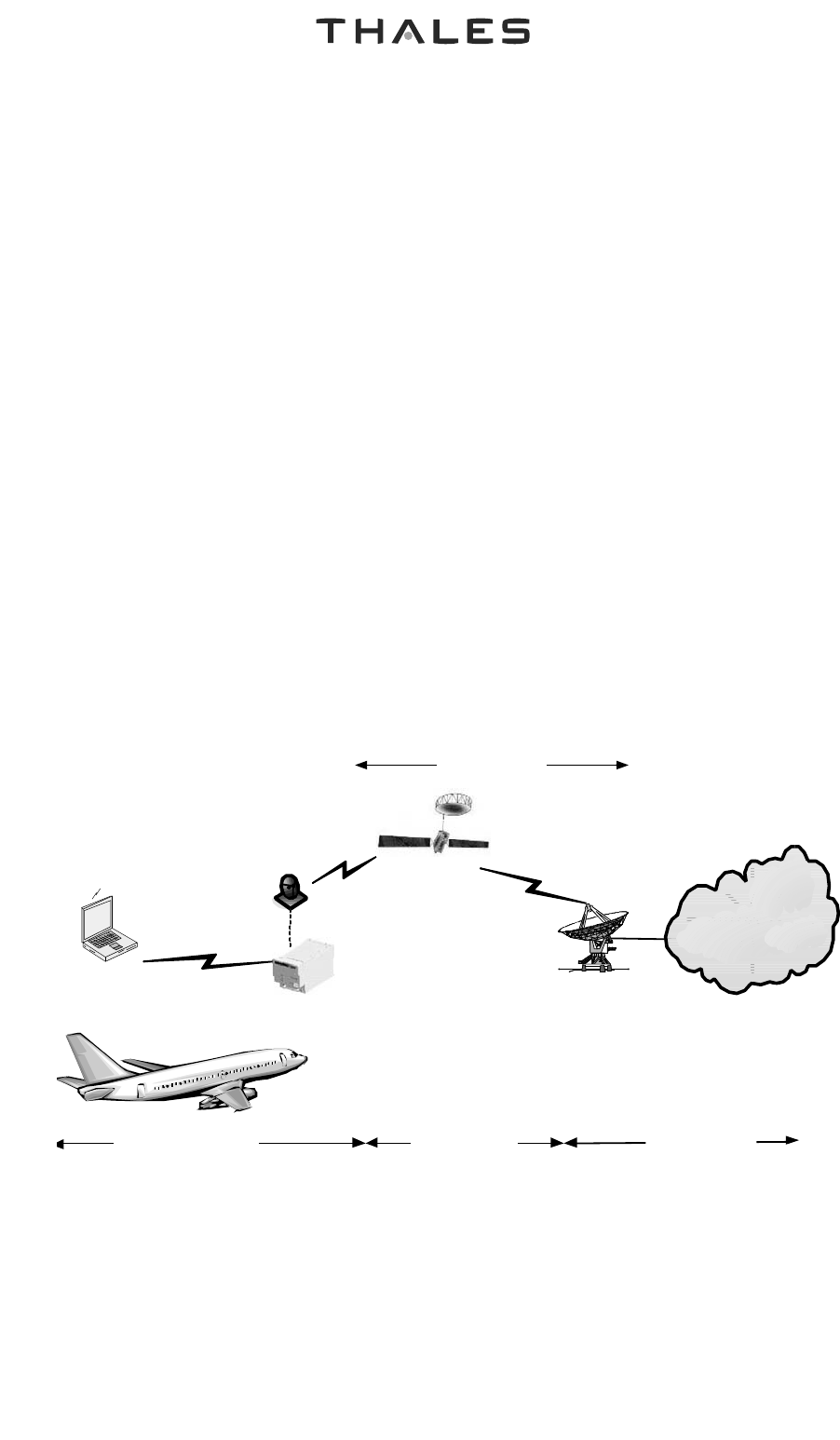
Installation Maintenance Manual
SDU 82155 Series
SCM 82158 Series
2-1
Jun 30/2008
©
THALES AVIONICS Ltd. This document and any
i
nformation included are the property of Thales Avionics.
T
hey cannot be reproduced, disclosed or utilized without the
c
ompany’s prior written approval
SECTION 2
20000DESCRIPTION
2.1. TFS SATELLITE COMMUNICATION SYSTEM DOMAIN
Satellite Communications (SATCOM) systems provide users with long-range voice and
data communication by accessing global satellite and ground communications networks.
The introduction of Pico-Cells on aircrafts, and the I3 and I4 INMARSAT constellation
of geostationary satellites have been the enabling technologies for the development of
significantly smaller, more capable terminals such as the Thales TopFlight Satcom
system.
SwiftBroadband (SBB) is the aeronautical service, which operates on the INMARSAT
Broadband Global Area Network (BGAN) infrastructure. SBB supports Circuit
Switched and always-on TCP/IP data (packet switched) services. Thales SBB TopFlight
Satcom system supports the Inmarsat Classes of service 3A, 6, 7 and Classic Aero H+.
2.2. TFS SYSTEM OVERVIEW
The TFS system conforms to the Aeronautical Radio Incorporated (ARINC) 781
Characteristic, and interfaces with onboard avionics and communication equipment to
provide the aircraft with a range of communication services by transmitting and
Figure 2.1 Example of TFS communications system overview
Inmarsat domain
TFS System
I4 Satellite
Backbone Networks
IP, PLMN, PSTN
User Terminals
Aeronautical Segment
Satellite
Access
Station
Space Segment Inmarsat domain
Tav_e_0000700_00
Antenna
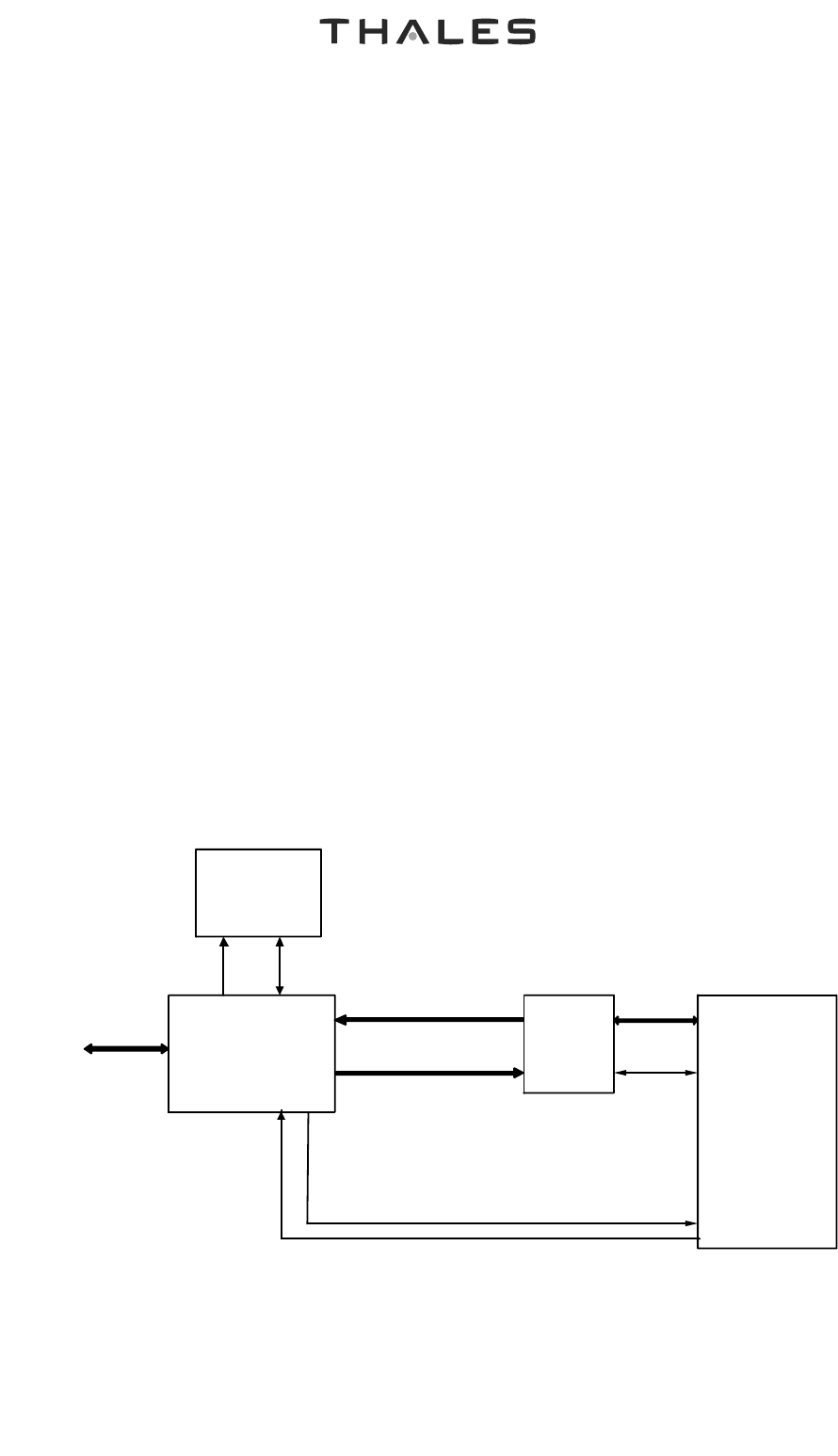
Installation Maintenance Manual
SDU 82155 Series
SCM 82158 Series
2-2
Jun 30/2008
©
THALES AVIONICS Ltd. This document and any
i
nformation included are the property of Thales Avionics.
T
hey cannot be reproduced, disclosed or utilized without the
c
ompany’s prior written approval
receiving L Band signals to and from the fourth generation of INMARSAT satellites. For
this purpose the INMARSAT satellite constellation is connected to the ground backbone
telecommunication network through Satellite Access Stations (SAS) operated by service
providers.
2.3. SYSTEM CONFIGURATIONS
TFS Satcom may be installed in different aircraft configurations, some examples are as
follows:
A. Single Aisle TFS System
The Single Aisle TFS System consists of the following Line Replacement Units (LRU):
• One Satellite Data Unit (SDU)
• One SDU Configuration Module (SCM)
• One Diplexer Low Noise Ampliier (DLNA)
• One Intermediate Gain Antenna (IGA) or High Gain Antenna (HGA)
• RF cables.
Figure 2.2 illustrates a typical aircraft installation of the TFS for a Single Aisle Aircraft.
Figure 2.2 Example of Single Aisle TFS system interfacing
SCM
SDU DNLA ARINC 781
ANTENNA
(Contains
BSU
Functions)
Power
ARINC 429
(Multicontrol)
ARINC 429
(Bite from Antenna)
RF
RF Rx
RF Tx
Bite/
Control
E
xternal
I
nterfaces
Tav_e_0000706_00
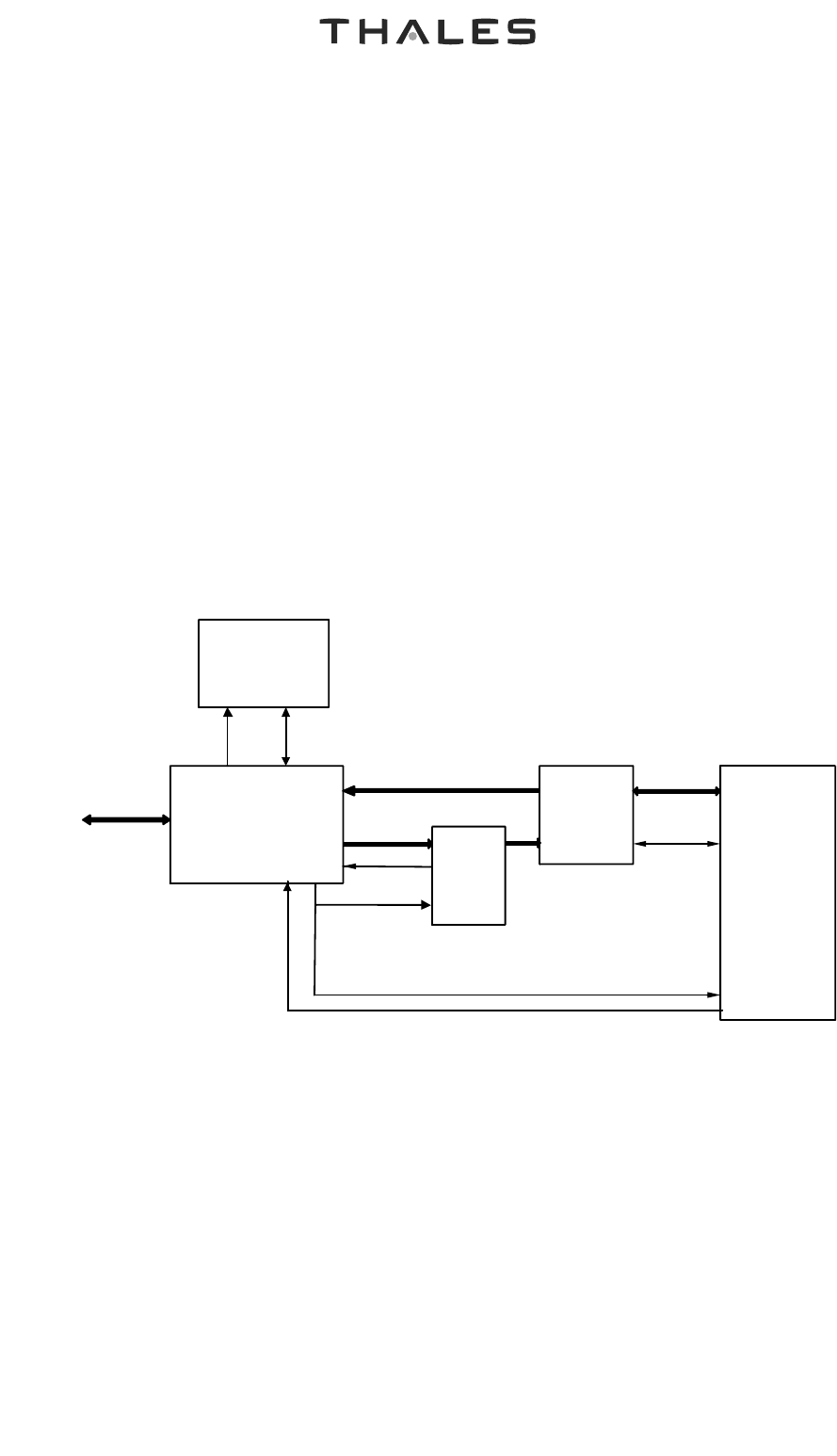
Installation Maintenance Manual
SDU 82155 Series
SCM 82158 Series
2-3
Jun 30/2008
©
THALES AVIONICS Ltd. This document and any
i
nformation included are the property of Thales Avionics.
T
hey cannot be reproduced, disclosed or utilized without the
c
ompany’s prior written approval
B. SDU Type 82155D TFS system
The TFS System consists of the following Line Replacement Units (LRU):
• One Satellite Data Unit (SDU)
• One SDU Configuration Module (SCM)
• One Diplexer Low Noise Ampliier (DLNA)
• One Intermediate Gain Antenna (IGA) or High Gain Antenna (HGA)
• One Flange-Mounted High Power Amplifier (FMHPA) (If required)
• RF cables.
Figure 2.3 illustrates a typical aircraft installation of the SDU Type 82155D System.
Figure 2.3 Example of SDU Type 82155D TFS system interfacing
SCM
SDU DNLA ARINC 781
ANTENNA
(Contains
BSU
Functions)
Power
ARINC 429
(Multicontrol)
ARINC 429
(Bite from Antenna)
RF
RF Rx
RF Tx
Bite/
Control
E
xternal
I
nterfaces
RF Tx
FMHPA
Bite
Tav_e_0000707_00
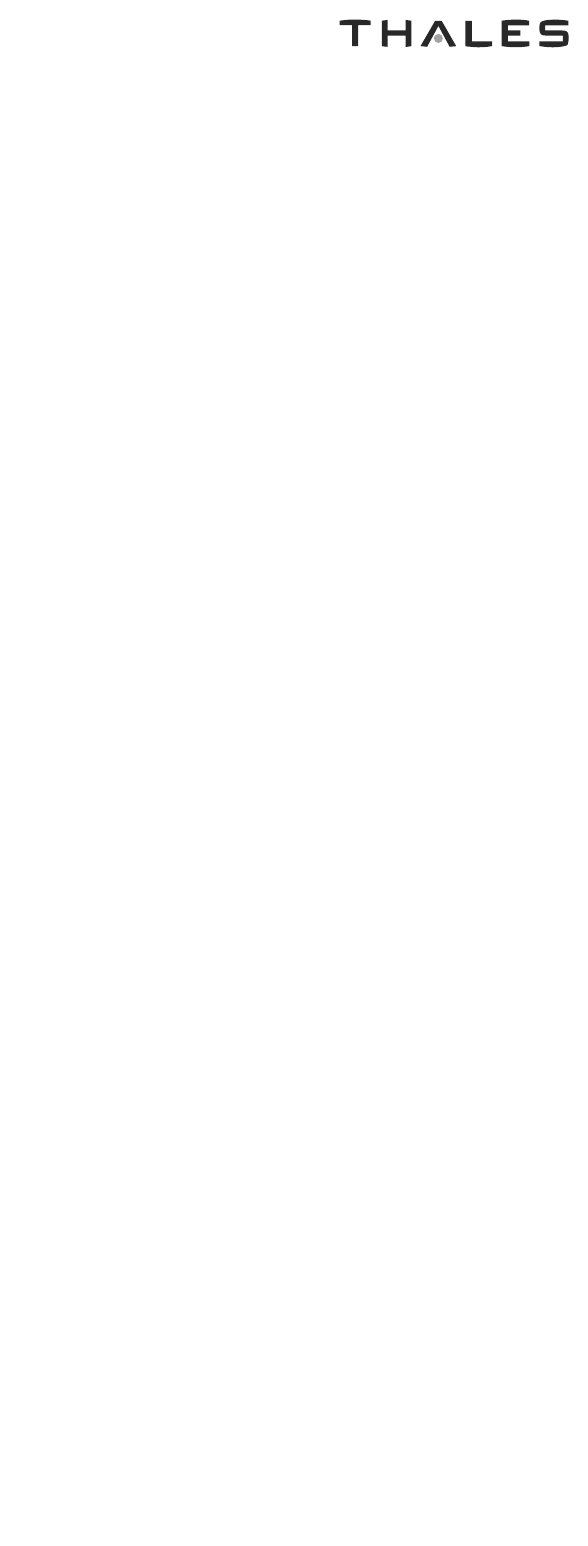
Installation Maintenance Manual
SDU 82155 Series
SCM 82158 Series
2-4
Jun 30/2008
©
THALES AVIONICS Ltd. This document and any
i
nformation included are the property of Thales Avionics.
T
hey cannot be reproduced, disclosed or utilized without the
c
ompany’s prior written approval
2.4. SDU COMPONENT DESCRIPTION
A. Hardware
NOTE: SDU hardware is targeted at RTCA/DO-254 level C.
The SDU hardware meets RTCA/DO-254 level D requirements, and it is composed of
the following internal sub-assemblies (Refer to Figure 2.4):
(1) SDU Type 82155A
• High Power Amplifier (HPA)
• Channel Card Module (CCM) x 1
• Communication Processor Module (CPM)
• Power Supply Module (PSM)
• Oven Controlled Crystal Oscillator (OCXO)
• Avionics Processor Module (APM)
• Backplane
• Front Panel.
(2) SDU Type 82155D
•HPA
• CCM x 2
•CPM
• PSM
•OCXO
•APM
• Backplane
• Front Panel.
The SDU enclosure is constructed of machined lightweight aluminium alloy and it is
packaged in an ARINC 600 6 Modular Concept Unit (MCU) housing suitable for
mounting in the equipment bay of an aircraft.
Two hold-down clamps are used to secure the SDU, permitting it to be firmly held in
position in the mounting rack. A handle fitted on the front panel of the SDU permits
removal, installation and carrying of the SDU.
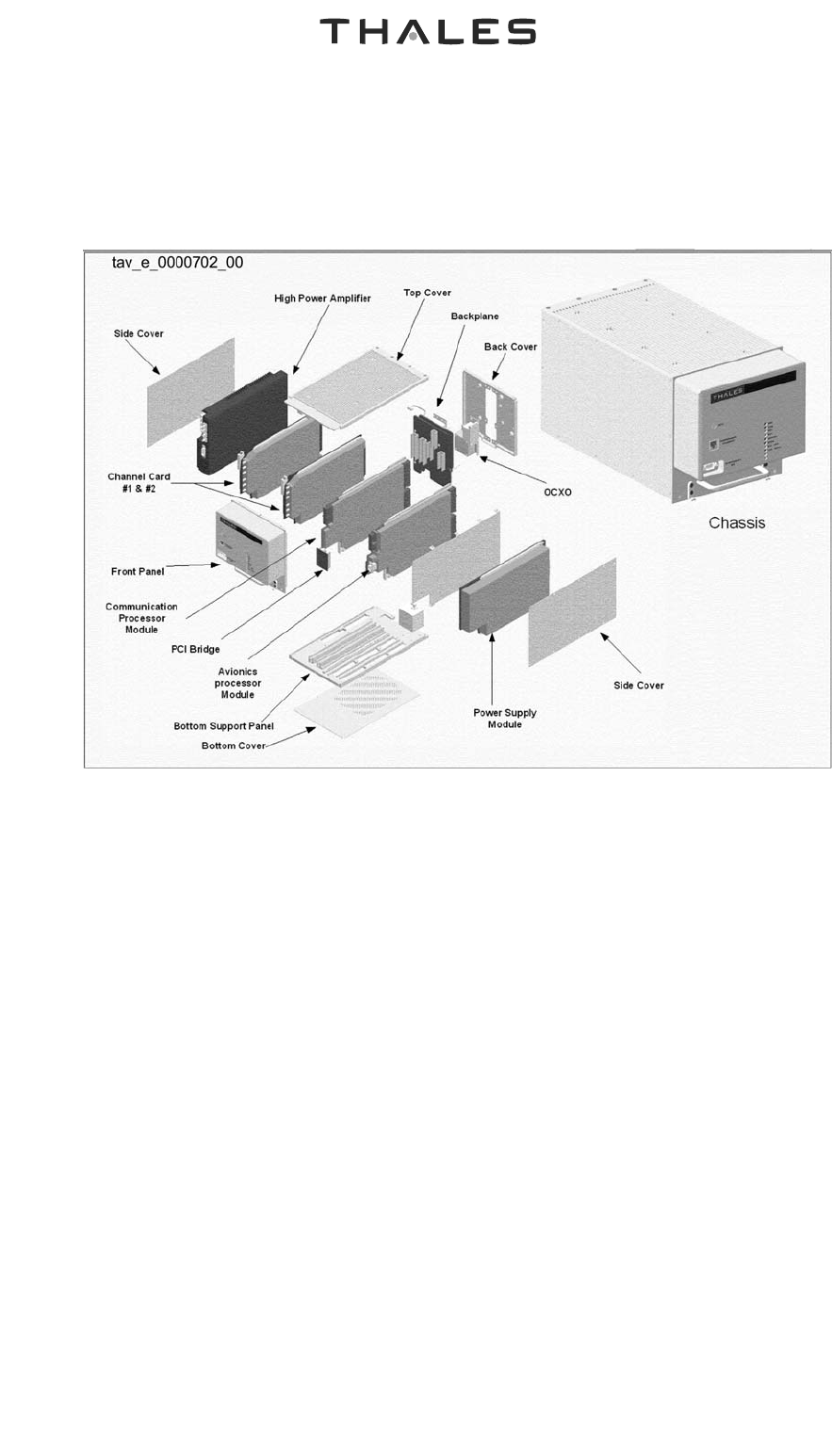
Installation Maintenance Manual
SDU 82155 Series
SCM 82158 Series
2-5
Jun 30/2008
©
THALES AVIONICS Ltd. This document and any
i
nformation included are the property of Thales Avionics.
T
hey cannot be reproduced, disclosed or utilized without the
c
ompany’s prior written approval
B. Functionality
The Functionality of the SDU is as follows:
(1) SDU Type 82155A.
Single Channel Class 3A SBB Services.
(2) SDU Type 82155D.
Dual Channel Class 6 and 7 SBB Services with reversion to Dual S64 Services.
Classic Aero Voice and Data Services (Aero I , Aero H+ (up to 2 x Voice and 1 x Data)).
Figure 2.4 Example of SDU sub-system modules exploded
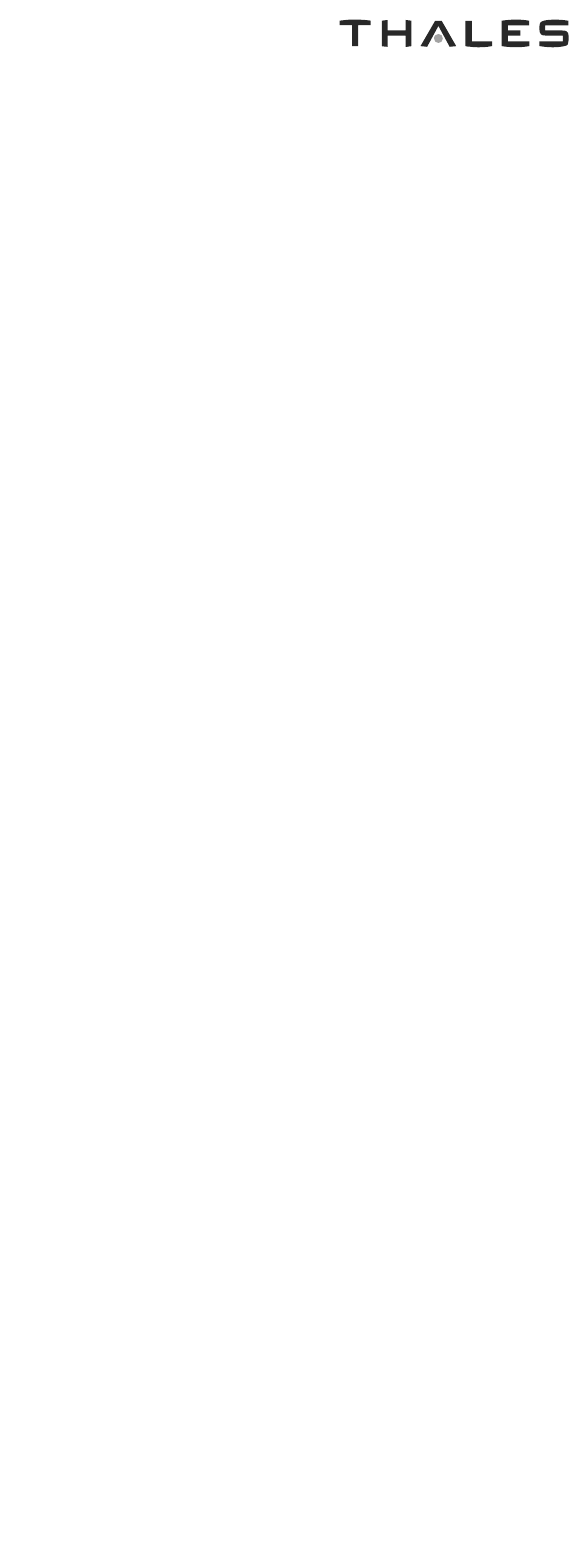
Installation Maintenance Manual
SDU 82155 Series
SCM 82158 Series
2-6
Jun 30/2008
©
THALES AVIONICS Ltd. This document and any
i
nformation included are the property of Thales Avionics.
T
hey cannot be reproduced, disclosed or utilized without the
c
ompany’s prior written approval
C. Software
The software in the SDU can be considered as being supplied in two elements, one
contained within the CCM the other operating on the SDU processors (CPM & APM).
The SDU’s application software primarily functions as the system controller providing
system level tasks such as CCM control, BITE reporting, Avionics interfacing via
ARINC-429 (including Inertial Reference System (IRS)) and providing external
interfaces (such as Ethernet) as well as routing functions between the external interfaces
and the CCM as necessary.
The SDU’s APM and CPM application software meets RTCA/DO-178B level D
requirements, and the CCM application software meets RTCA/DO-178 level E (Level D
for Classic only) requirements.
D. ORT Parameters
The primary source of Owner Requirement Table (ORT) is the SCM ORT and is also
stored inside the SDU. The ORT database contains configuration data that is used to
customize the operation of the TFS system. It allows various preferences to be set to
enable the efficient use of the equipment in normal operation. The SDU is delivered to
customers with a default ORT.
E. General Operation
The SDU controls and processes all essential data in order to manage the reception and
transmission of data through the satellite link. The SDU controls the set-up of the
required channel types, providing modulation/demodulation, error correction, coding,
and data rates associated with the satellite communication channel(s).
The SDU is of modular design and can be configured for use on a wide variety of
aircraft. That is cabin only, cockpit only or cabin and cockpit services.
The SDU converts digital/audio inputs to Radio Frequency (RF), and contains a HPA
function providing the necessary output power to support communication between the
aircraft and the satellite. It also controls the associated antenna sub-system and uses the
SCM for its own configuration data purposes.
When the distance between the SDU and the DLNA would require an RF cable with a
loss of >1.4dB or if more than 30W of RF power is required when cable loss is < 1.4dB,
an FMHPA may be placed between the SDU and the DLNA to amplify the signal. The
SDU internal HPA will then run at a reduced power output.
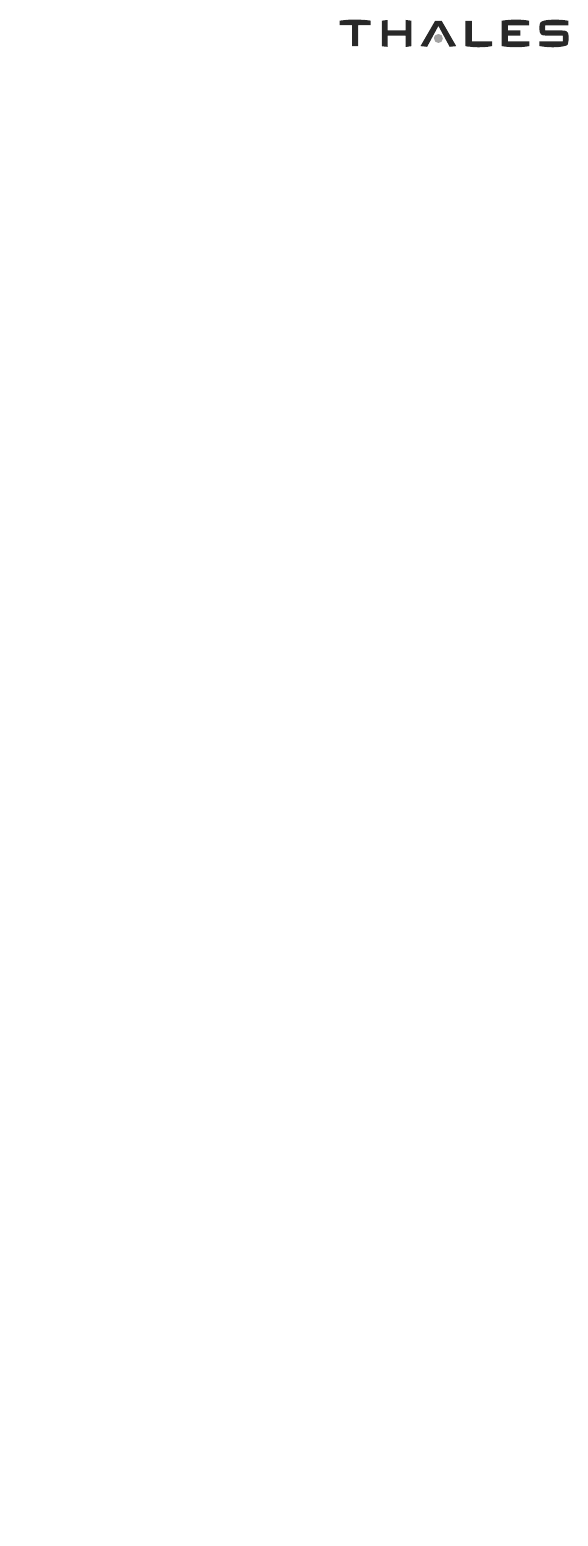
Installation Maintenance Manual
SDU 82155 Series
SCM 82158 Series
2-7
Jun 30/2008
©
THALES AVIONICS Ltd. This document and any
i
nformation included are the property of Thales Avionics.
T
hey cannot be reproduced, disclosed or utilized without the
c
ompany’s prior written approval
The SDU operates within set frequency bandwidths:
• RX range is between 1525 to 1559 MHz
• TX is tuned over the range 1626.5 to 1660.5 MHz
F. Sub-modules Basic Detailed Operation
The Front Panel assembly gives visual indications for system status, external
maintenance interface connections, the SDU Person Activated Self-Test (PAST) push
button and a connector for the Standalone Interface System (SIS).
The Backplane assembly makes interconnections between external interfaces and the
SDU internal sub-assemblies.
The APM provides interfacing to external avionics. It receives aircraft position, speed
and heading information from external avionics via ARINC 429, and updates the CCM
with position information every second. The APM manages satellite selection based on
aircraft position, and maintains antenna pointing to the wanted satellite beam steering
via ARINC 429. The APM manages RF resources and set CCM transmit power levels,
taking into consideration antenna gain and cable losses stored within the ORT.
The CPM handles and controls all communications interfaces (Ethernet, RS232 and
RS422) and analog audio (cockpit 4-wire).
The CCM converts user’s input/output data to signals suitable for transmitting and
receiving L-Band signals using the satellite link.
The HPA module amplifies the low level RF signals from the CCM to produce high
power output prior to connection to the antenna.
The PSM operates from 115 Vac and supplies low level dc power supplies to SRUs
within the SDU and 12 Vdc to the SCM.
The OCXO provides 10 MHz clock reference signal for the CCM circuit.
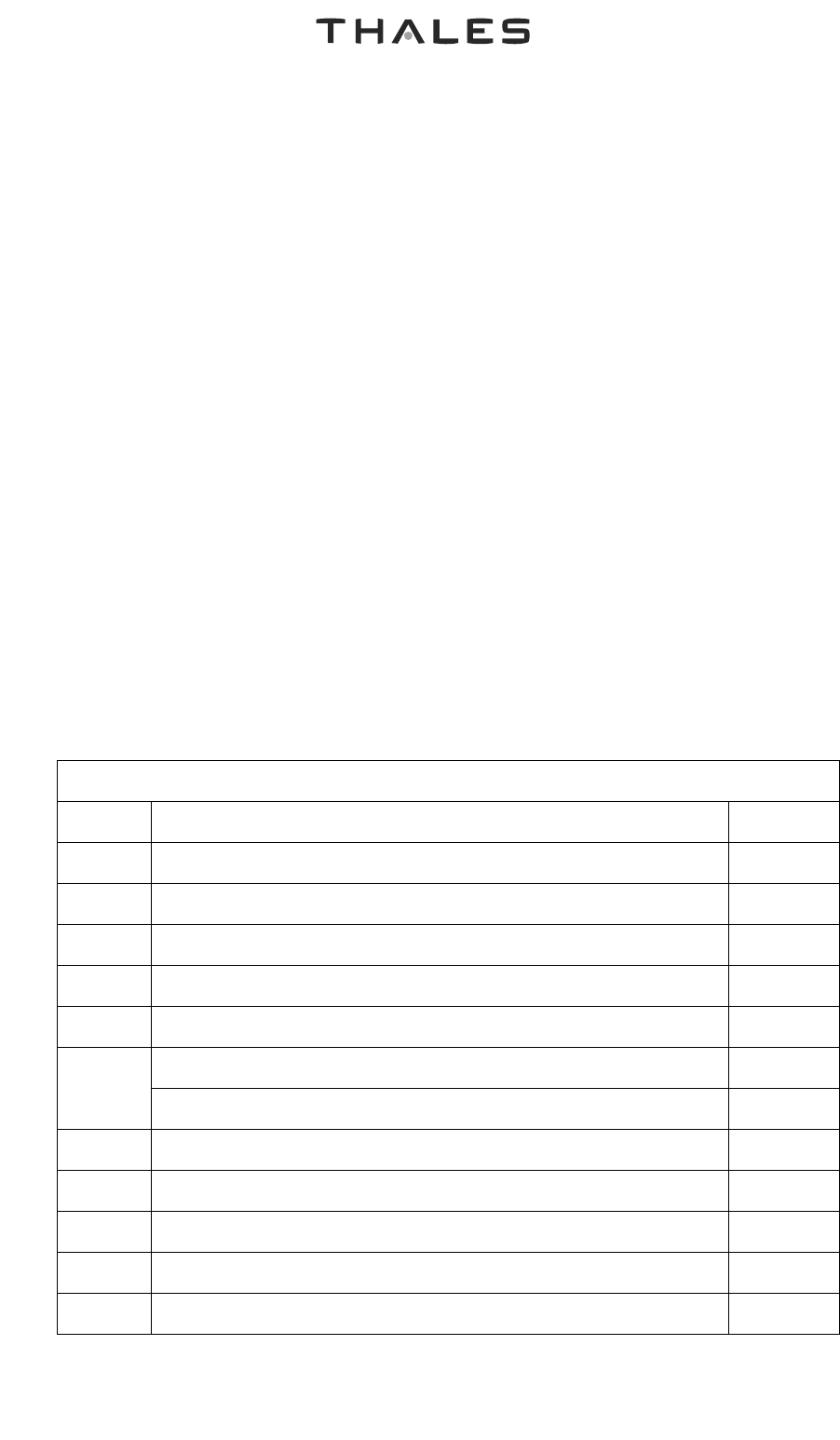
Installation Maintenance Manual
SDU 82155 Series
SCM 82158 Series
2-8
Jun 30/2008
©
THALES AVIONICS Ltd. This document and any
i
nformation included are the property of Thales Avionics.
T
hey cannot be reproduced, disclosed or utilized without the
c
ompany’s prior written approval
G. Operating Environment
(1) Normal Operating temperature:
Between -15o C (5o F) and +70o C (158o F)
NOTE: Short term operating Temperature - 40oC
(2) Cooling:
Forced air type in accordance with ARINC 600, requiring minimum airflow rate of 50
kg/hr, blowing from bottom to top. Maximum inlet air temperature +70o C (158o F)
(3) Heat dissipation:
250W (assuming 100% duty cycle with HPA operating at 30W output).
NOTE: Typically 170W with dual SBB channels.
H. Environment Conditions
The SDU complies with the RTCA/DO-160-E (ED-14E). The environmental
qualifications categories complied with, are as per listed refer (Table 2.1).
Table 2.1 Environmental Test categories for SDU and SCM
RTCA DO-160E (ED-14E) Environmental Categories
Section Condition Category
4.0 Temperature/Altitude A2
4.5.4 Loss of Cooling V
5.0 Temp Var B
6.0 Humidity B
7.0 Shock/Crash B,E
8.0 Vibration R
Vibration Curve C
9.0 Explosion E
10.0 Waterproof X
11.0 Fluids X
12.0 Sand/Dust X
13.0 Fungus F
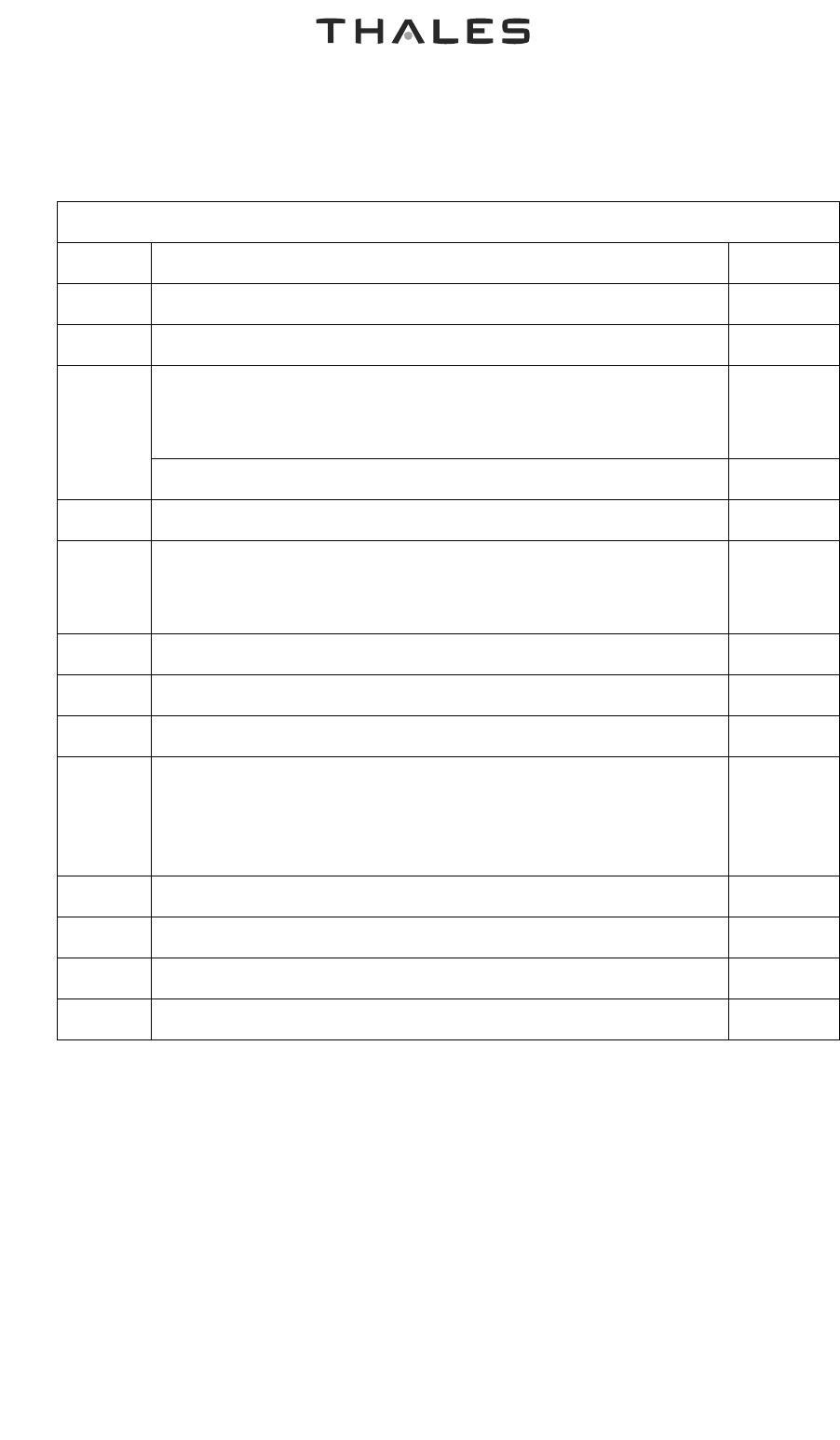
Installation Maintenance Manual
SDU 82155 Series
SCM 82158 Series
2-9
Jun 30/2008
©
THALES AVIONICS Ltd. This document and any
i
nformation included are the property of Thales Avionics.
T
hey cannot be reproduced, disclosed or utilized without the
c
ompany’s prior written approval
14.0 Salt Fog X
15.0 Magnetic Effect A
16.0 Power Input A(CF),
A(NF),
A(WF)
Harmonics H
17.0 Voltage Spike A
18.0 Conducted Audio Susceptibility K(CF),
K(NF)
K(WF)
19.0 Induced Signal Susceptibility CW
20.0 RF Susceptibility TT
21.0 RF Emissions M
22.0 Lightning Induced A3G33
(SDU
82155A
only)
23.0 Lightning Direct Effects X
24.0 Icing X
25.0 ESD TBC
26.0 Fire, Flammability TBD
RTCA DO-160E (ED-14E) Environmental Categories
Section Condition Category
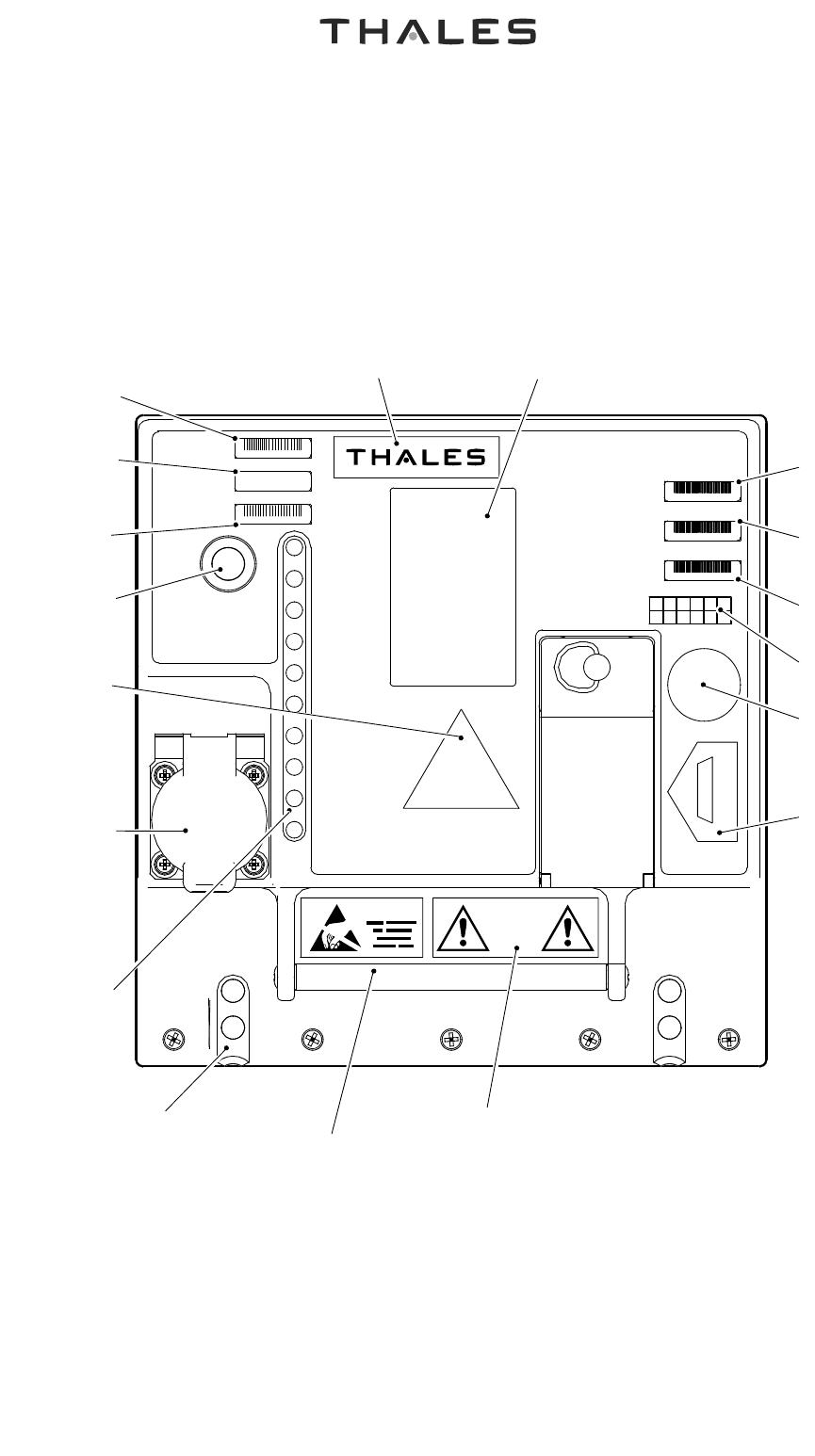
Installation Maintenance Manual
SDU 82155 Series
SCM 82158 Series
2-10
Jun 30/2008
©
THALES AVIONICS Ltd. This document and any
i
nformation included are the property of Thales Avionics.
T
hey cannot be reproduced, disclosed or utilized without the
c
ompany’s prior written approval
I. Identification Label
Figure 2.5 represent the SDU Front Panel Identification Panel, for detalied description
of the numbered field Refer to Table 2.2.
Figure 2.5 Example of SDU Front Panel Legend
HW PNR
Minor Rev.
SW PNR
TEST
SDU
SCM
Antenna
HW PNR 82155X30
SW PNR
A
TEST PORT
DLNA
Ext. HPA
Ext. BSU
Ext. Data Bus
ORT/Config.
Sat. Link #1
Sat. Link #2
LED INDICATIONS MAY RELATE TO
OTHER EQUIPMENT OR AIRCRAFT WIRING
CAUTION
THIS EQUIPMENT
REQUIRES FIELD
LOADABLE SOFTWARE
ENSURE CORRECT
SOFTWARE IS LOADED
REFER TO AMM
Supply 115VAC
CSD cm
Wt. 9.5kg (max)
FAA TC
FCC id
HW DO-254 Level C
SW DO-178B Level D
DO-160E Env. Cat
[(A2)Z]BAE[SC]EXXXFXA[
A(WF)]A[R(WF)][ZW][RR
]M[A3G33]XXAC
SATELLITE DATA UNIT (SDU)
MFR
SER
DMF
MFR K0385
SER NO
DMF
INSPECT
AMDT ABCDEF
GH I J KL
S
S
I
18
2
1
6
3
4
5
10 9
7
8
1
4
1
6
CAUTION CAUTION
SURFACE
HOT
Tav_e_0000727_00
11
12
13
15
17
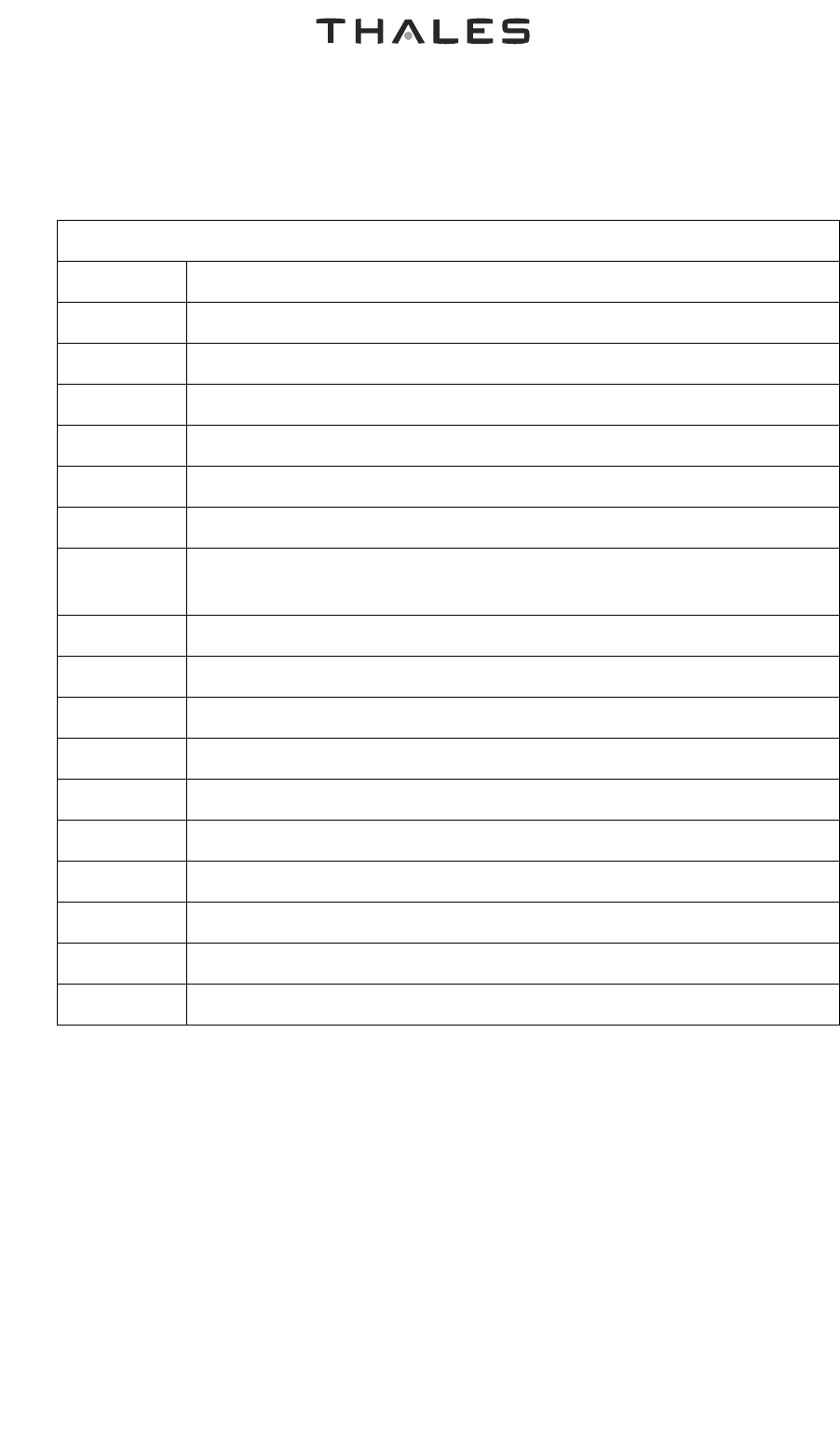
Installation Maintenance Manual
SDU 82155 Series
SCM 82158 Series
2-11
Jun 30/2008
©
THALES AVIONICS Ltd. This document and any
i
nformation included are the property of Thales Avionics.
T
hey cannot be reproduced, disclosed or utilized without the
c
ompany’s prior written approval
Table 2.2 SDU Front Panel Legend
SDU Front Panel Legend
1 Manufacturer’s Name
2 Voltage Supply,Compass Safe Distance
3 Manufacturer’s Code
4 Equipment Serial Number
5 Date of Final Factory Inspection (month and year)
6 Amendment Label
7 Inspection Stamp
8 Standalone Identification System, Weight of Equipment, FCC ID,
Hardware and Software Compliance Reference
9 Caution labels
10 Carrying Handle
11 Hold Down Lugs
12 Status Light Emitting Diodes (LEDs)
13 Ethernet RJ45 Maintenance Connector
14 Field Loadable Software Warning
15 Push To Test Switch
16 Software Part Number
17 Hardware Minor Revision
18 Hardware Part Number
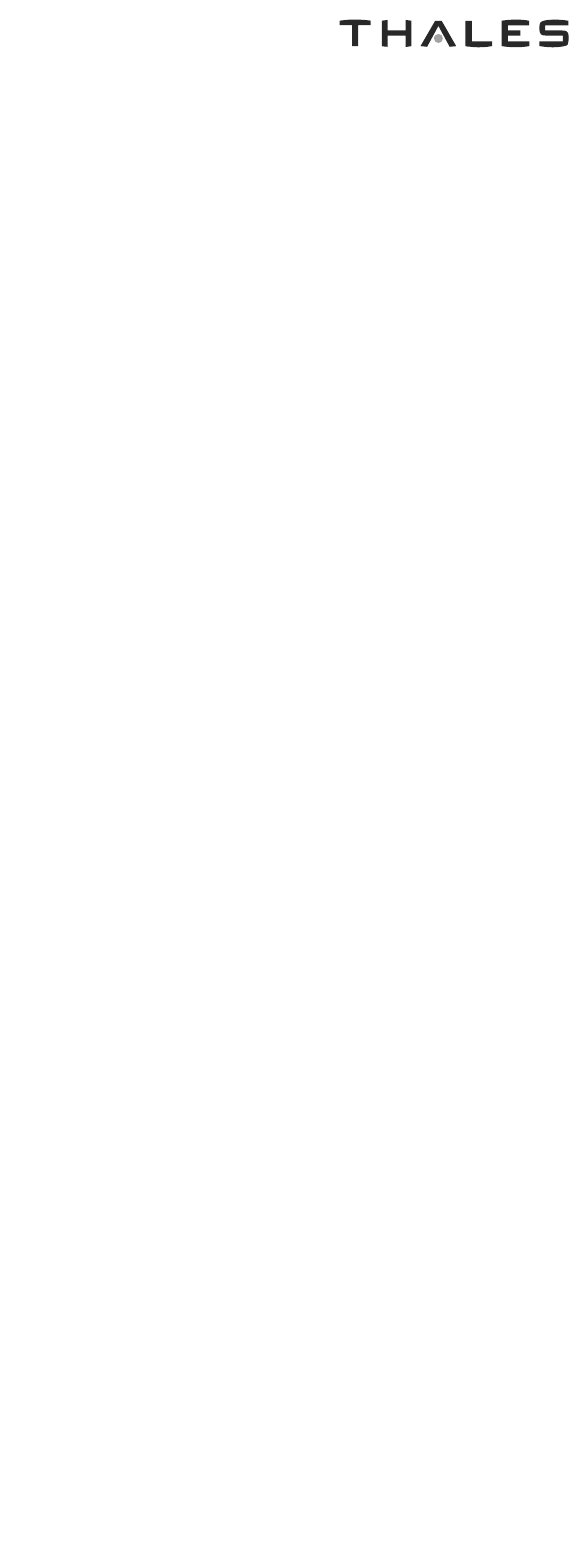
Installation Maintenance Manual
SDU 82155 Series
SCM 82158 Series
2-12
Jun 30/2008
©
THALES AVIONICS Ltd. This document and any
i
nformation included are the property of Thales Avionics.
T
hey cannot be reproduced, disclosed or utilized without the
c
ompany’s prior written approval
J. Weight and Dimensions
NOTE: Weights and measurements in this manual use both U.S (inches) and S.I.
(metric, m.m.) values.
(1) SDU Type 82155A
• For overall dimensions (refer to Figure 2.6)
• Form Factor: ARINC 600, 6 MCU
• Mass: 9.5 kg (21 lb) maximum.
(2) SDU Type 82155D
• For overall dimensions (refer to Figure 2.6)
• Form Factor: ARINC 600, 6 MCU
• Mass: 11 kg (24 lb) maximum.
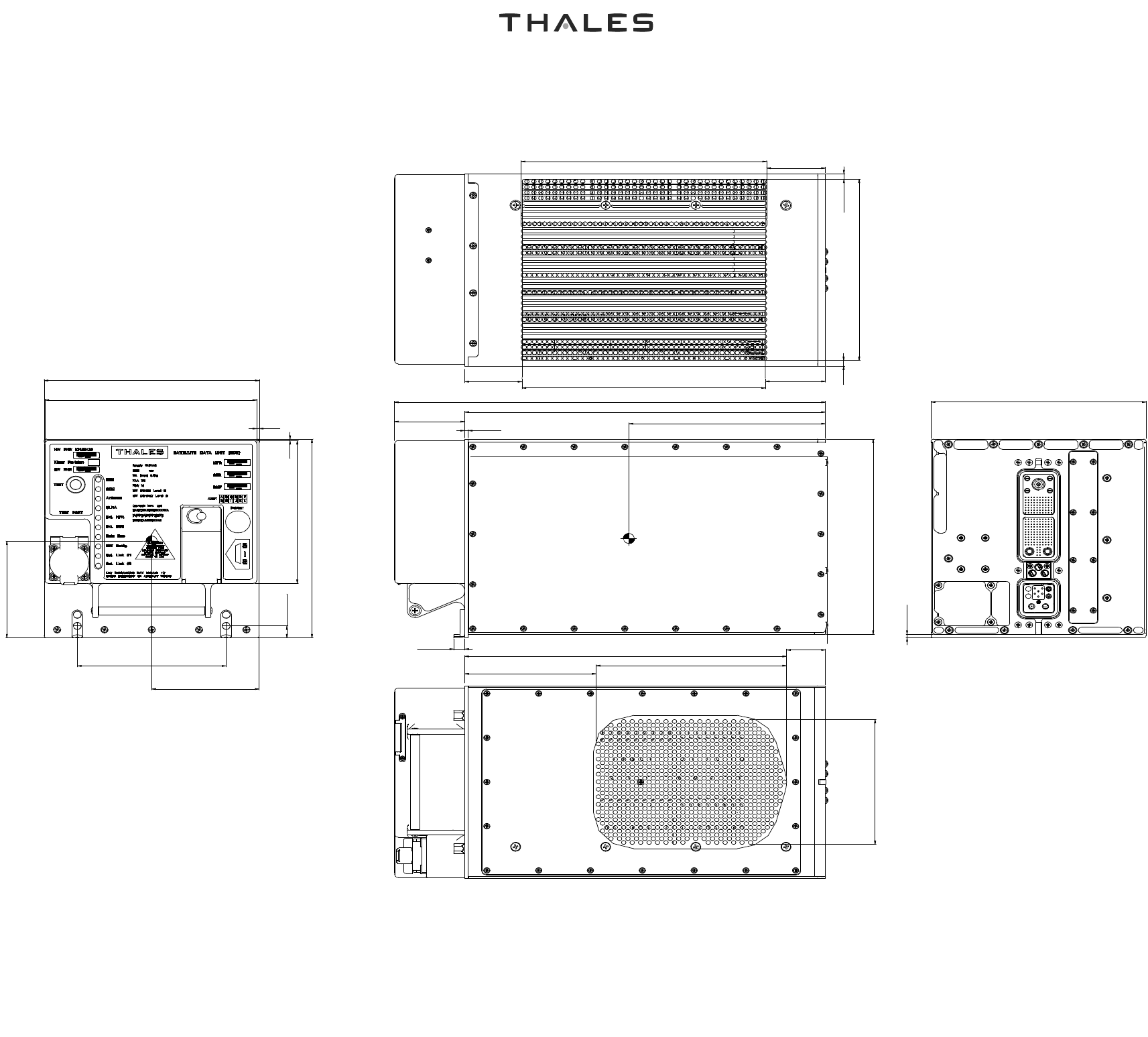
Installation Maintenance Manual
SDU 82155 Series
SCM 82158 Series
2-13
Jun 30/2008
©
THALES AVIONICS Ltd. This document and any
i
nformation included are the property of Thales Avionics.
T
hey cannot be reproduced, disclosed or utilized without the
c
ompany’s prior written approval
Figure 2.6 SDU Overall Dimensions.
9.65 (0.38")
CofG Dim. 'C' (See Table)
193.5 (7.62")
320.2 (12.6")
3.2 (0.12")
382.6 (15") REF.
62.4 (2.46")
190.5 (7.5")
3.6 (0.14")
285.7 (11.25")
34.6 (1.36") REF.
123.9 (4.88")
116.8 (4.56")
168.9 (6.652) REF.
COOLING OUTLET AREA (ARINC)
50.9 (2") 53.4 (2.1")
52.3 (2")
217.7 (8.6")
5.4 REF (0.21").
179.9 (7.1")
5.6 (0.22")
1.4 (0.05")
141.6 7.78")
CofG Dim. 'B'
CofG Dim. 'A'
2.2 (0.1")
132.1 (5.2")
190.9 (7.5") REF.
197.1 REF.
11.73 (0.46")
188.0 (7.4")
Tav_e_0000733_00
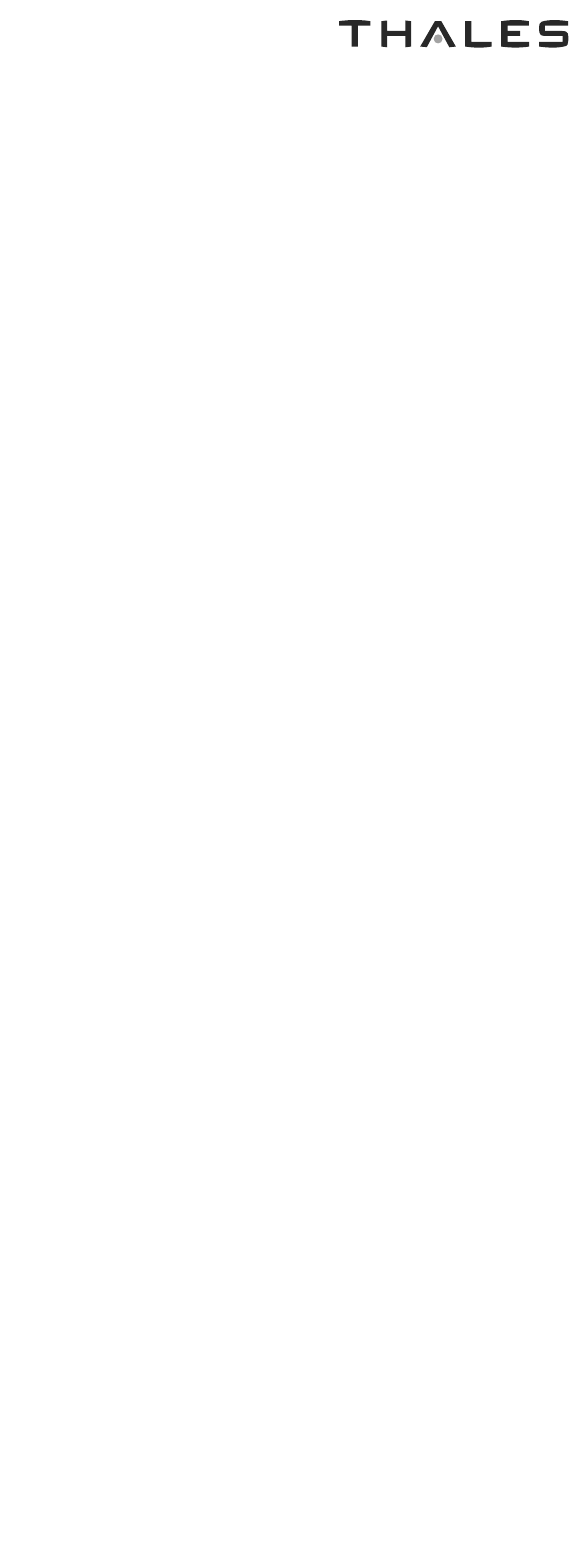
Installation Maintenance Manual
SDU 82155 Series
SCM 82158 Series
2-14
Jun 30/2008
©
THALES AVIONICS Ltd. This document and any
i
nformation included are the property of Thales Avionics.
T
hey cannot be reproduced, disclosed or utilized without the
c
ompany’s prior written approval
THIS PAGE INTENTIONALLY BLANK
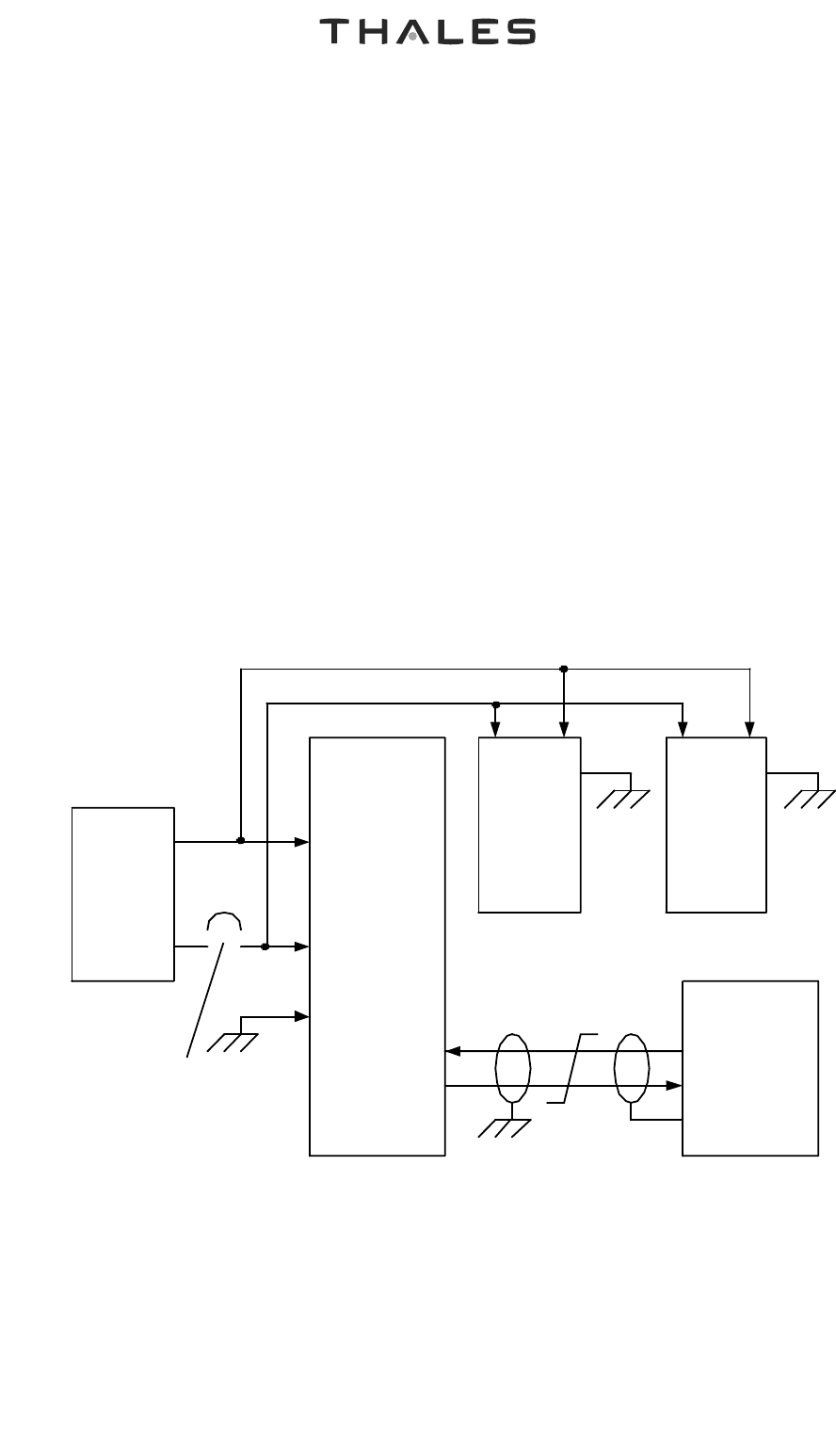
Installation Maintenance Manual
SDU 82155 Series
SCM 82158 Series
2-15
Jun 30/2008
©
THALES AVIONICS Ltd. This document and any
i
nformation included are the property of Thales Avionics.
T
hey cannot be reproduced, disclosed or utilized without the
c
ompany’s prior written approval
K. SDU Electrical Characteristics
• Normal Operation, Supply voltage: 100 to 122 Vrms, ac, Frequency
Range 360 Hz to 800 Hz
• Power consumption: 280W maximum
• RF Power Rating: Internal HPA variable up to 30W depending upon
services required.
2.5. SYSTEM INTERFACES
The SDU interfaces with various aircraft systems.
A. Aircraft Power Utility Service
The TFS interfaces with the aircraft primary power generator (Refer to Figure 2.7):
Figure 2.7 TFS example of aircraft Power Distribution diagram
SDU
DLNA IGA/
HGA
SCM
Aircraft
Power
supply
115 Vac Cold
115 Vac Hot
Chassis Ground
115 Vac-7.5 AMP
Circuit Breaker
BP01
BP05
BP03
Power Source
12 VDC SCM
Power
Return
MP01D
MP02D
FE 18 19
A2
2
Tav_e_0000712_00
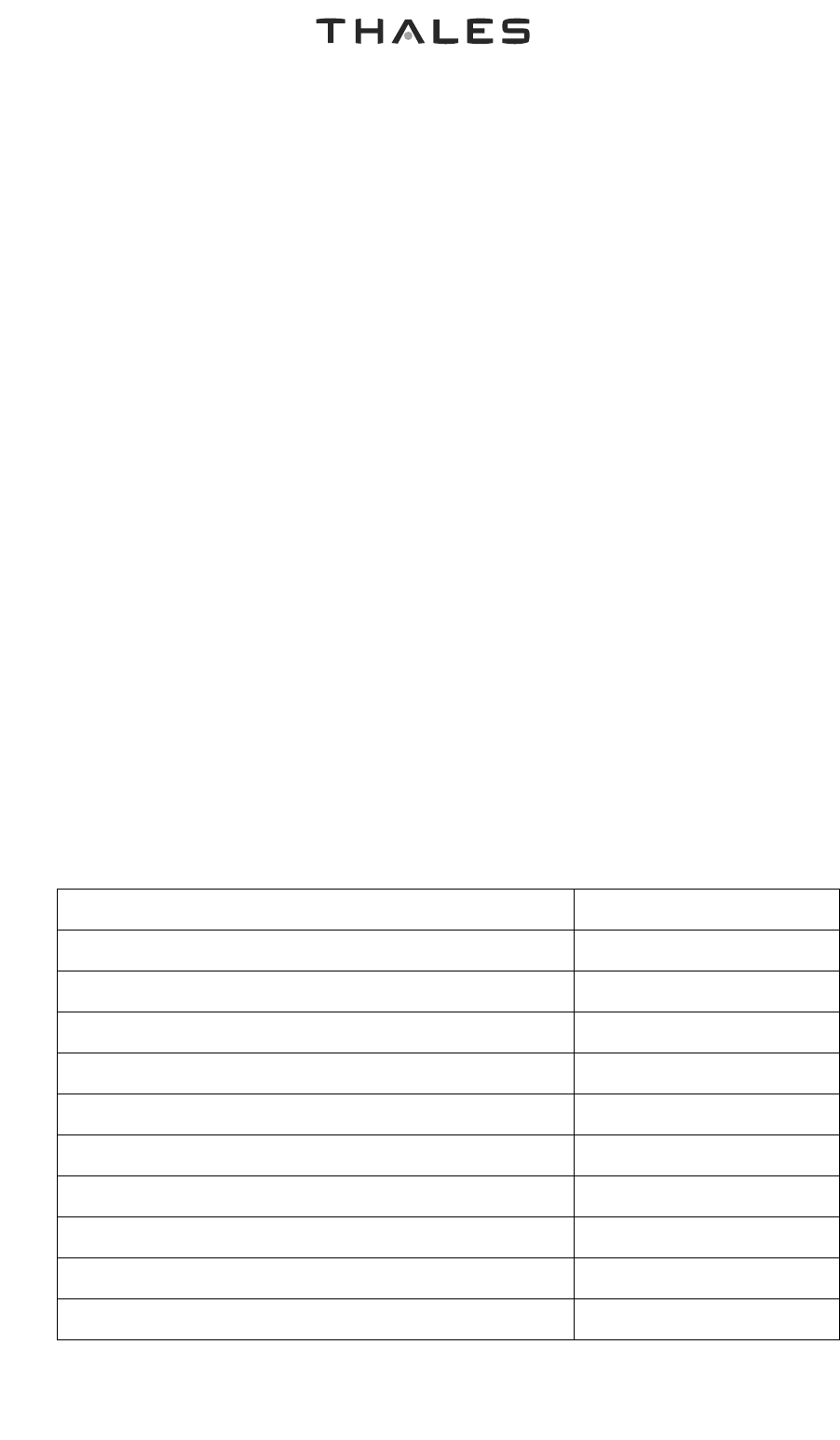
Installation Maintenance Manual
SDU 82155 Series
SCM 82158 Series
2-16
Jun 30/2008
©
THALES AVIONICS Ltd. This document and any
i
nformation included are the property of Thales Avionics.
T
hey cannot be reproduced, disclosed or utilized without the
c
ompany’s prior written approval
B. Avionics Interfaces
The following avionics interfaces are supported:
• External 35W FMHPA
• Specific to type Cabin Network domain
• ARINC 781 High Gain Antennas (HGA) and Intermediate Gain
antennas (IGA)
• ARINC 429 interfaced equipment (IRS, Global Positioning System
(GPS), MCDU, CMU, CMS)
• EASA/FAR 25.1309 Equipment, systems and installations
•DLNA
•SCM
• Nav Data from Navigation Systems.
In order to comply with transmit burst time, INMARSAT requires the SDU to be
provided with the aircraft present position within 1500m in three dimensions, referenced
to WGS-84 (GPS) . In order to comply with this requirement the TFS SDU requires
ARINC 429 Nav Data labels (Refer to Table 2.3). The values apply to aircraft where
only one Nav Data bus is connected.
For Classic and S64 only IRS present position is required.
Table 2.3 ARINC 429 Nav Data Labels - Hybrid
PARAMETERS ARINC 429 LABELS
Latitude GNSS - Hybrid/Inertial 254/Inertial
Longitude GNSS - Hybrid/Inertial 255/Inertial
Ground Speed GNSS - Hybrid 175
Track Angle True GNSS – Hybrid 137
True Heading – Hybrid 132
Pitch Angle 324
Roll Angle 325
GNSS Height (HAE) or Hybrid Altitude MSL 370 or 261
GNSS UTC (Binary) 150
GNSS Date 260
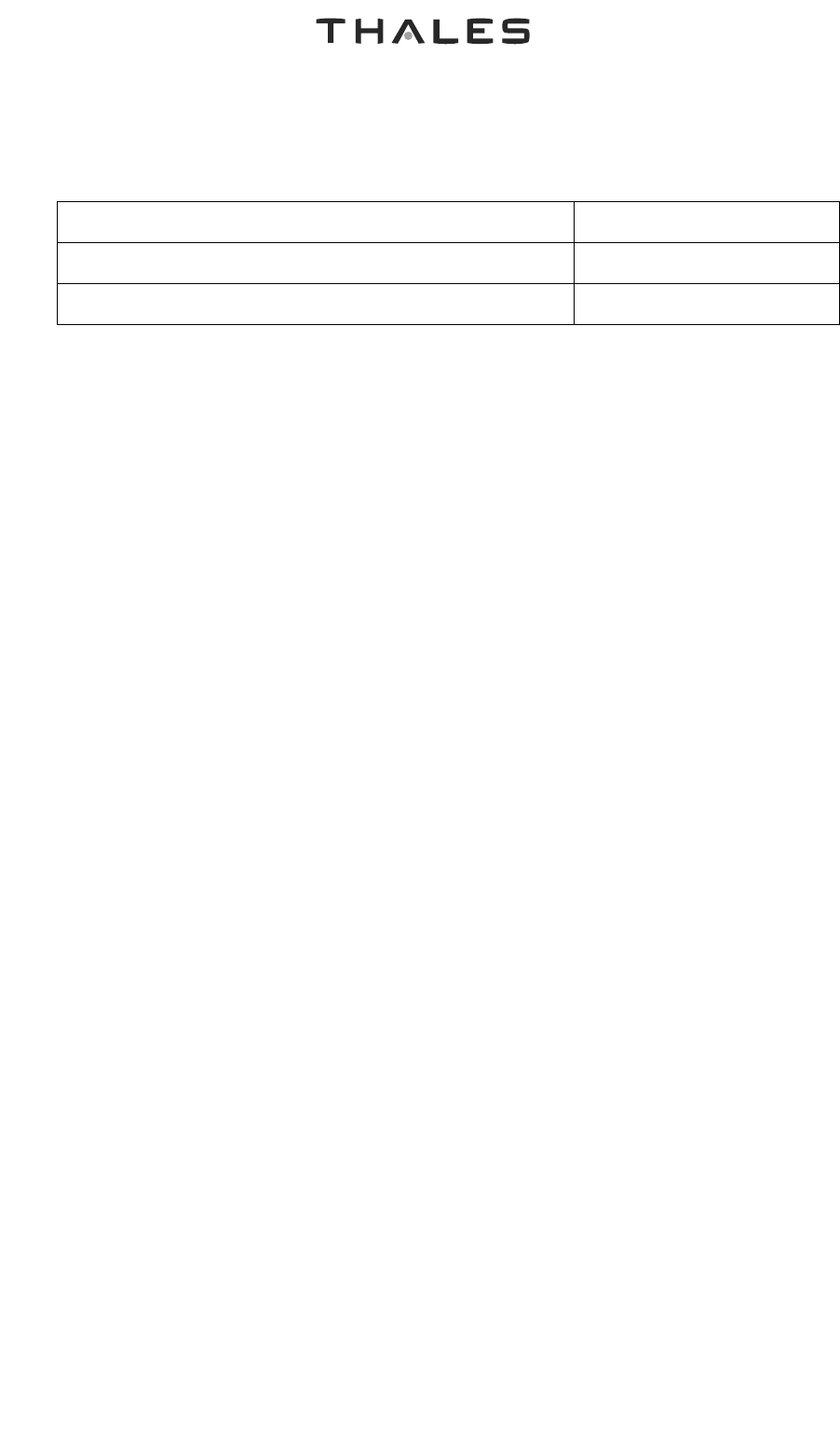
Installation Maintenance Manual
SDU 82155 Series
SCM 82158 Series
2-17
Jun 30/2008
©
THALES AVIONICS Ltd. This document and any
i
nformation included are the property of Thales Avionics.
T
hey cannot be reproduced, disclosed or utilized without the
c
ompany’s prior written approval
C. Cockpit Interfaces (SDU Type 82155D only)
• Cockpit Audio Management Unit (AMU)
• Centralised Fault Display System (CFDS)
• Communications Management Unit (CMU)
• Multi-Purpose Control and Display Unit (MCDU).
D. Maintenance System Interfaces
The SDU supports the following maintenance system interfaces:
• Aircraft Data Loader (ADL), ARINC 615/615A
• Portable Data Loader (PDL), ARINC 615A
• Thales Maintenance Terminal.
NOTE: For more information concerning data loading tools contact the Thales
TFS product support representative at the following address:
86 Bushey Road
Raynes Park, London
SW20 0JW, UK
Tel. +44 (0)20 8946 8011 (Switchboard)
Tel. +44 (0)20 8946 5169 (Hot desk).
2.6. SDU CONFIGURABLE PINOUT AND PIN DESCRIPTION
In the case of using the mandatory configuration straps the SDU is configurable via the
SDU ARINC 600 configuration straps as defined in ARINC 781.
The straps input values will be read only at unit power-up to determine the system
configuration. The SDU configuration will be selectable by multiplexing the
Configuration Straps inputs with the service availability discrete outputs as per ARINC
781 Attachment 1-4.
GNSS Sensor Status 273
GNSS HDOP 101
PARAMETERS ARINC 429 LABELS
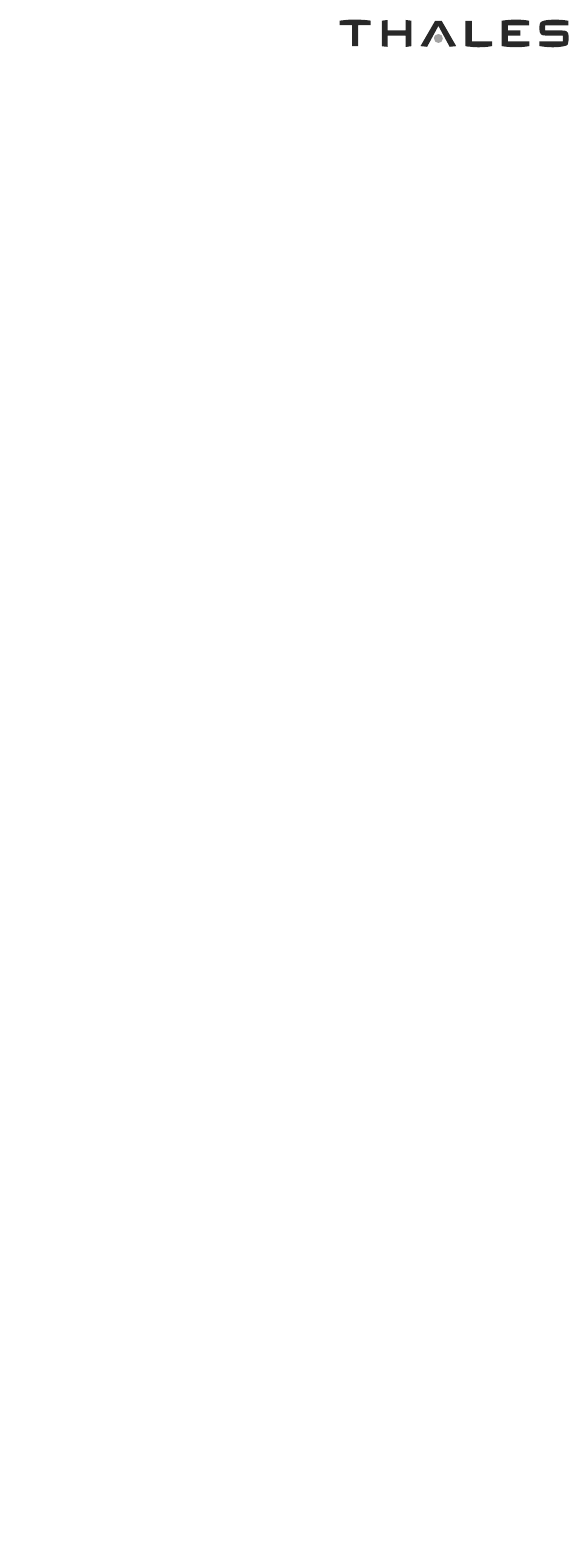
Installation Maintenance Manual
SDU 82155 Series
SCM 82158 Series
2-18
Jun 30/2008
©
THALES AVIONICS Ltd. This document and any
i
nformation included are the property of Thales Avionics.
T
hey cannot be reproduced, disclosed or utilized without the
c
ompany’s prior written approval
A. Mandatory Configuration Pins
The link between pins Top plug (TP)3D and TP3E must be removed when an external
FMHPA is connected. They are used as hardware implemented safety override to force
the internal HPA function into low power mode.
Pin TP3G must be used on all aircraft installations since one of its functions is to indicate
whether all other configuration pins (excluding TP3D, TP3E, TP3F, TP3G, and TP4D)
should be used by the SDU. Pin TP4D should be used on all aircraft installations since it
indicates the SDU number (1 or 2).
Pin TP3F must be used on all aircraft installations since it indicates that the number of
all configuration pins (excluding TP3D) including the parity pin itself connected to
service availability discrete (or TP3D) is odd.
2.7. SDU INTERCONNECT DATA
A. ARINC 600 Standard Interwiring Connector
The SDU ARINC 600 connector provides:
• Input/Output connections
• EMC filtering to input and output interfaces
• ESD (Electrostatic Discharge) (Refer DO-160 E section 25 Cat A).
The SDU is provided with a low insertion force, size 2-shell receptacle in accordance
with ARINC 600 Attachment 19. This connector accommodates coaxial and signal
interconnections in the TP insert, Quadrax and signal interconnections in the middle
plug (MP) insert, and coaxial, fibre and power interconnections in the Bottom Plug (BP)
insert. The contact arrangements are as follows:
• Insert arrangement 08 receptacle in accordance with ARINC
Specification 600, Attachment 11 for the top insert (Size 1 Coax cavity
and Size 22 Signal sockets)
• Insert arrangement 120Q2 receptacle in accordance with ARINC
Specification 600, Attachment 20, Figure 20-6.5.5 for the middle insert
(Size 8 Quadrax cavities for pin components and Size 22 Signal sockets)
• Insert arrangement 12F5C2 receptacle in accordance with ARINC
Specification 600, Attachment 19, and Figure 19-49.19 for the bottom
insert (Size 12 Electrical pins, Size 16 Electrical pin, Size 5 Coax
cavities, and Size 16 Optical cavities).
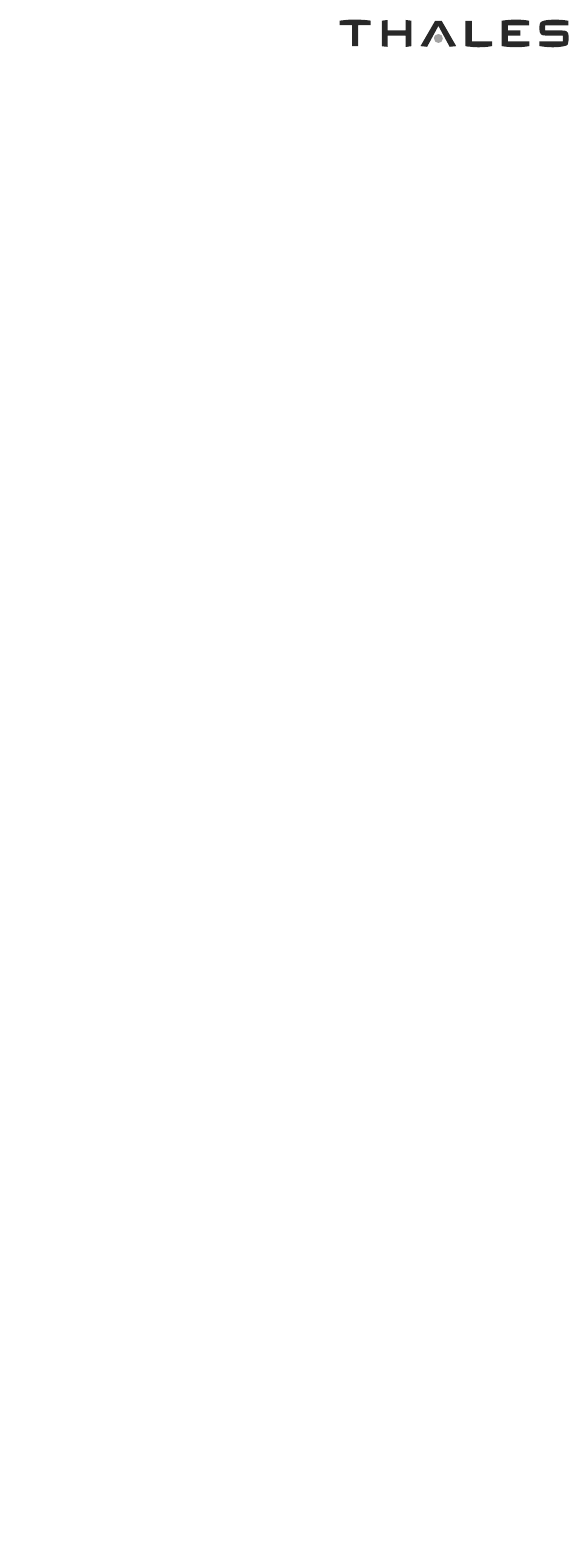
Installation Maintenance Manual
SDU 82155 Series
SCM 82158 Series
2-19
Jun 30/2008
©
THALES AVIONICS Ltd. This document and any
i
nformation included are the property of Thales Avionics.
T
hey cannot be reproduced, disclosed or utilized without the
c
ompany’s prior written approval
• Index pin code 081 in accordance with ARINC Specification 600,
Attachment 18 should be used on both the SDU and the aircraft rack
connectors
(1) ARINC 600 Pin Assignment
The layout of the rear panel ARINC 600 connector and the Pin assignment are shown in
the figures 2.8, 2.9, 2.10 and 2.11. For further Information regarding the ARINC 600
connector refer ARINC 781 (Refer to Figure 2.8).
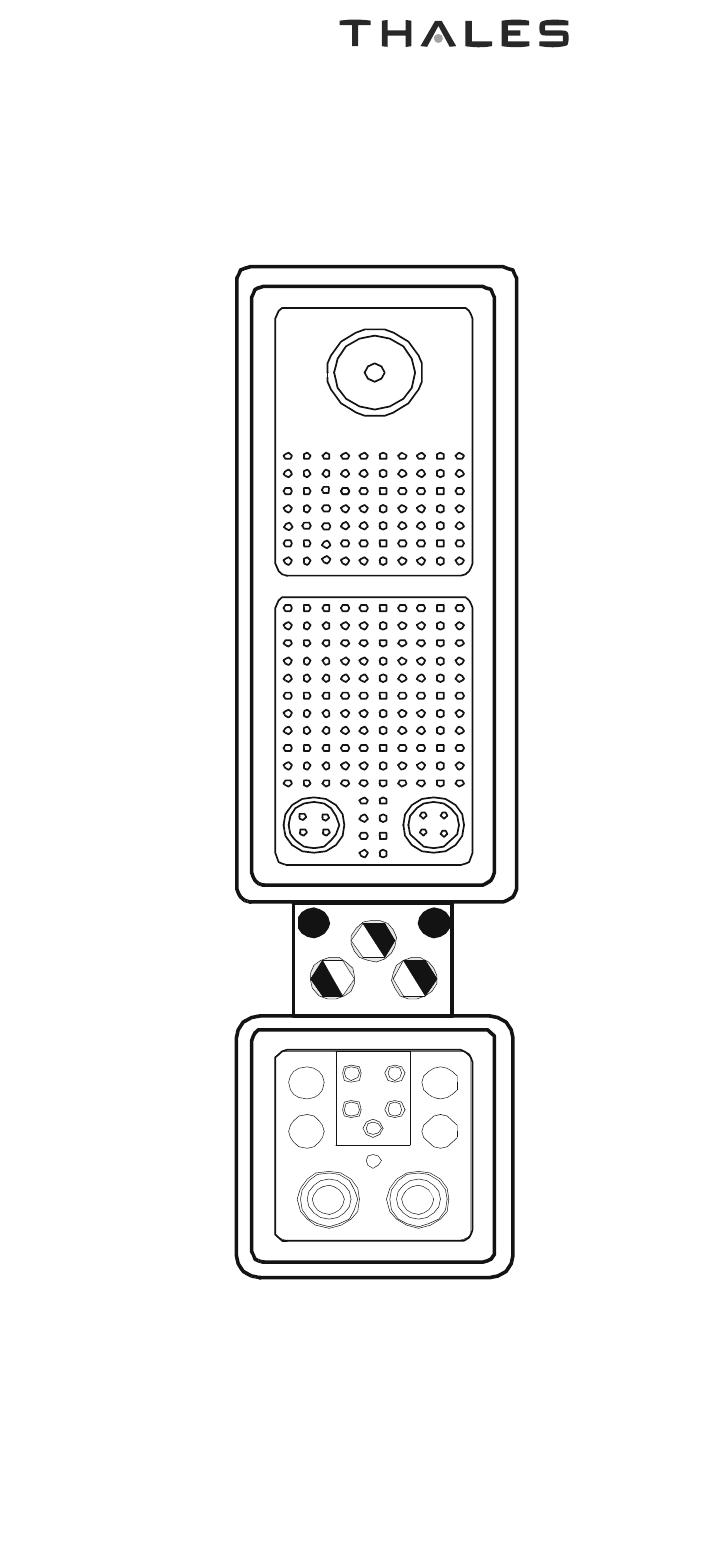
Installation Maintenance Manual
SDU 82155 Series
SCM 82158 Series
2-20
Jun 30/2008
©
THALES AVIONICS Ltd. This document and any
i
nformation included are the property of Thales Avionics.
T
hey cannot be reproduced, disclosed or utilized without the
c
ompany’s prior written approval
Figure 2.8 ARINC 600 Connector Layout
ABCDEFGHJ
1
5
7
1
5
7
ABCDEFGHJ
ABCDEFGHJ
1
4
9
1
3
2
3
5
6
7
8
1
0
1
1
1
2
1
4
1
5
1
3
67
5
4
298
11 10
12
Index code 81
(5,2,2)
Top Plug
Middle Plu
g
Bottom Plu
g
NOTE: The index code pins dark
colour represents the post
Tav_e_0000734_00
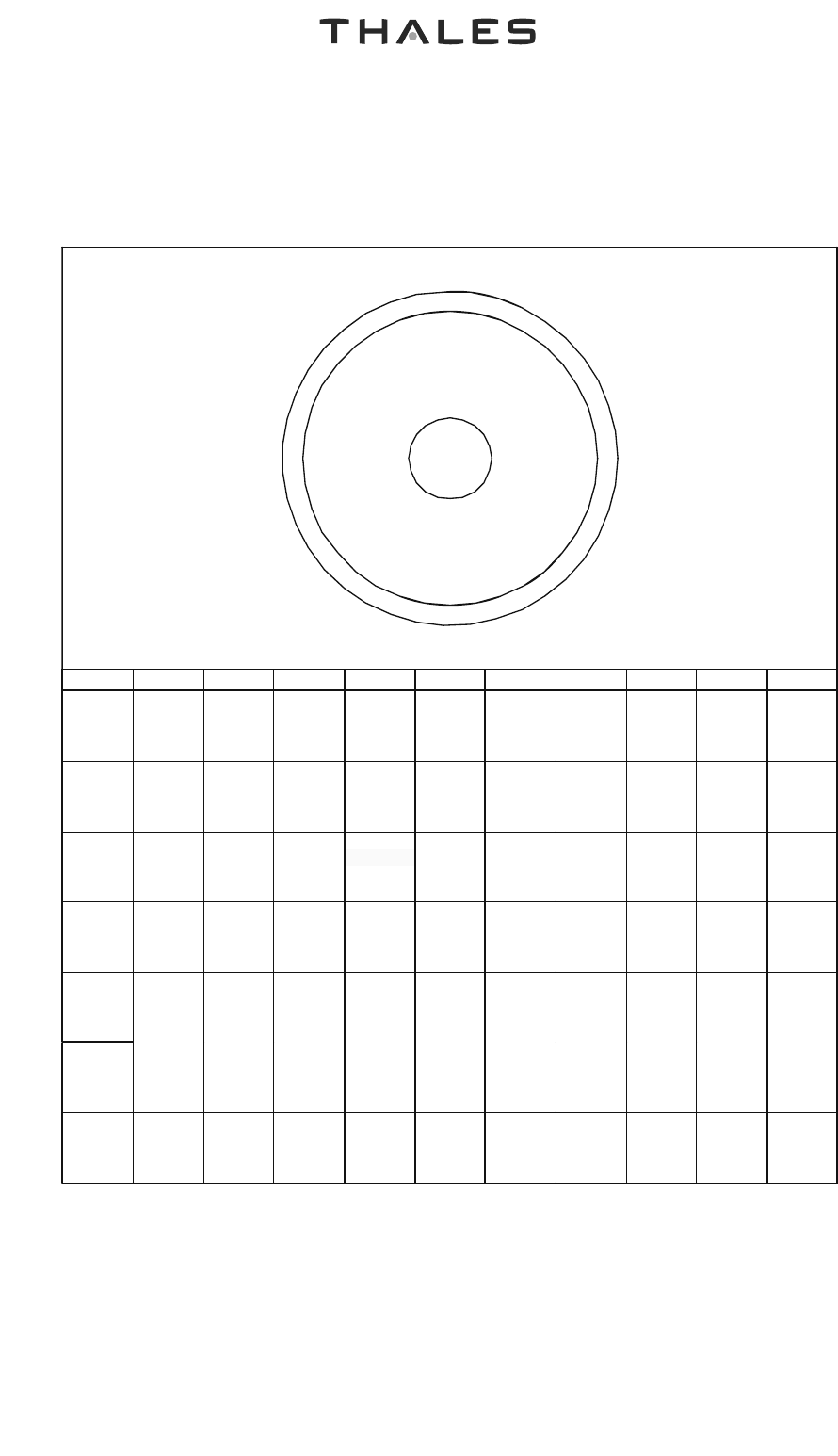
Installation Maintenance Manual
SDU 82155 Series
SCM 82158 Series
2-21
Jun 30/2008
©
THALES AVIONICS Ltd. This document and any
i
nformation included are the property of Thales Avionics.
T
hey cannot be reproduced, disclosed or utilized without the
c
ompany’s prior written approval
Figure 2.9 ARINC 600 Top Plug
ATE ATE
ATE ATE
Empty Config Config Config
SPARE
ATE
Pin 1
A
ATE
Pin 2
B
Pin 3 Pin 4
ATE
Pin 5
ATE
Pin 6
ATE
Pin 7
ATE
Pin 8
ATE
Pin 9
ATE
Pin 10
ATE
Pin 11
ATE
Pin 12
ATE
Pin 13
ATE
Pin 14 Pin 15 Pin 16
ATE
Pin 17
ATE
Pin 18
ATE
Pin 19
ATE
Pin 20
Ethernet 1
TX
A
Ethernet 1
RX
A
Empty
Cavity
Config
Pin 1
Config
Pin 2
Config
Pin 3
Config
Pin 4
SPARE
ISDN 1
TX
A
ISDN 1
RX
B
Ethernet 1
RX
B
Ethernet 1
TX
B
Cavity Pin 5
Config
Pin 6 Pin 7 Pin 8
ISDN 1
RX
A
ISDN 1
TX
B
Empty
Cavity
Empty
Cavity
Empty
Cavity
Config
Pin 9
Config
Pin 10
Config
Pin 11
Config
Pin 12
SPARE SPARE SPARE
1
2
3
4
5
A B C D G H J K
6
7
Empty Config Config Config
SPARE
Ethernet 2
TX
MCDU 3
A
Ethernet 2
RX
MCDU 3
A
Cavity Pin 13
Config
Pin 14 Pin 15
(Spare)
Pin 16
(Spare)
ISDN 2
TX
A
ISDN 2
RX
B
Ethernet 2
RX
B
Ethernet 2
TX
B
Empty
Cavity
Config
Pin 17
(Spare)
Config
Pin 18
(Spare)
Config
Pin 19
(Spare)
Config
Pin 20
(Spare)
SPARE
ISDN 2
RX
A
ISDN 2
TX
B
RF TX
To HPA or DLNA
E F
Tav_e_0000735_00
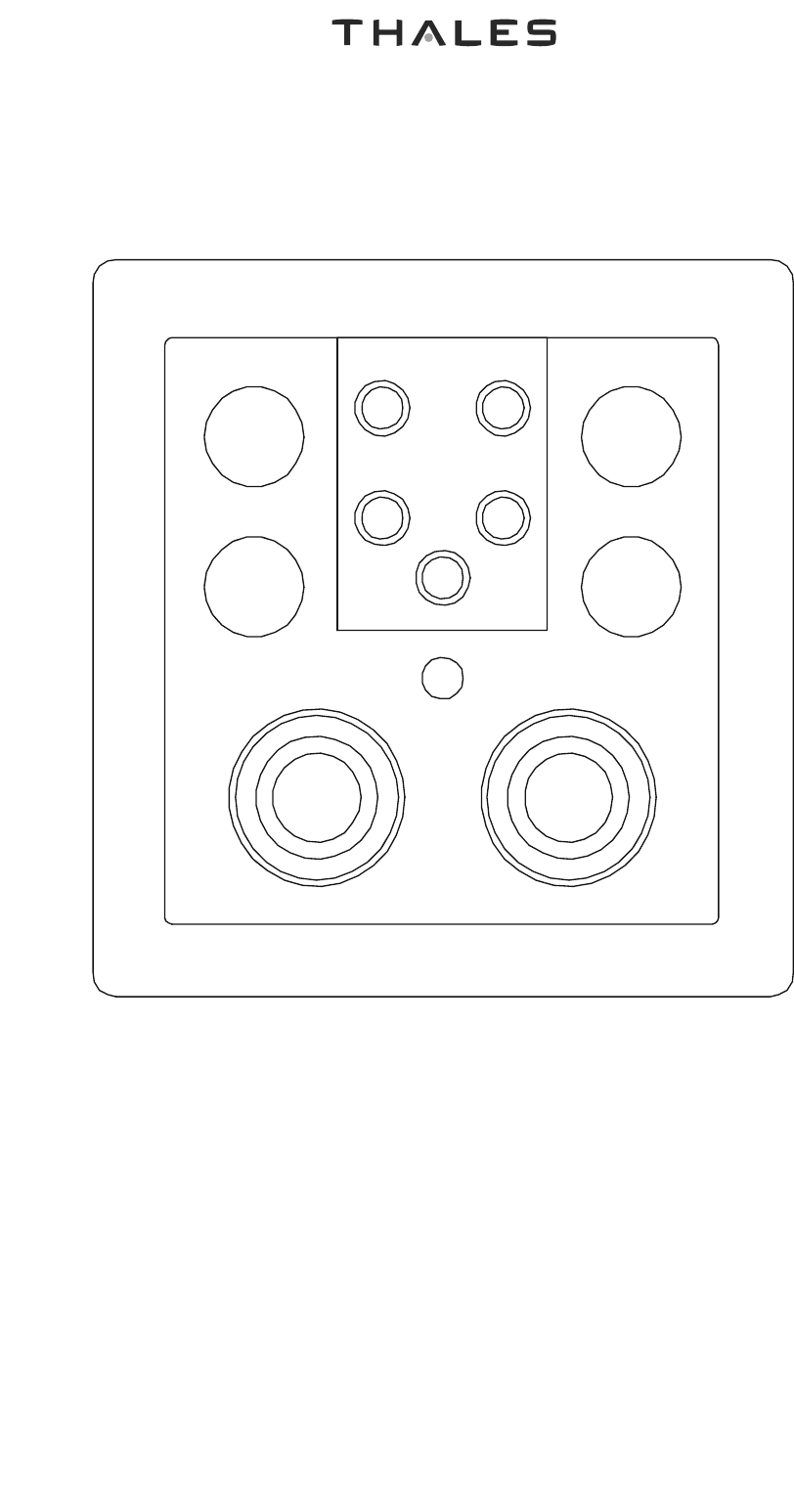
Installation Maintenance Manual
SDU 82155 Series
SCM 82158 Series
2-22
Jun 30/2008
©
THALES AVIONICS Ltd. This document and any
i
nformation included are the property of Thales Avionics.
T
hey cannot be reproduced, disclosed or utilized without the
c
ompany’s prior written approval
Figure 2.10 ARINC 600 Bottom Plug
28V
HOT
115V
COLD
CHASSIS
GROUND
28V
GND
SPARE
DLNA
115v
HOT
1
3
67
5
4
298
11 10
12
ETHERNET 7 ETHERNET 6
ETHERNET 8
ETHERNET 9
ETHERNET 10
Tav_e_0000736_00
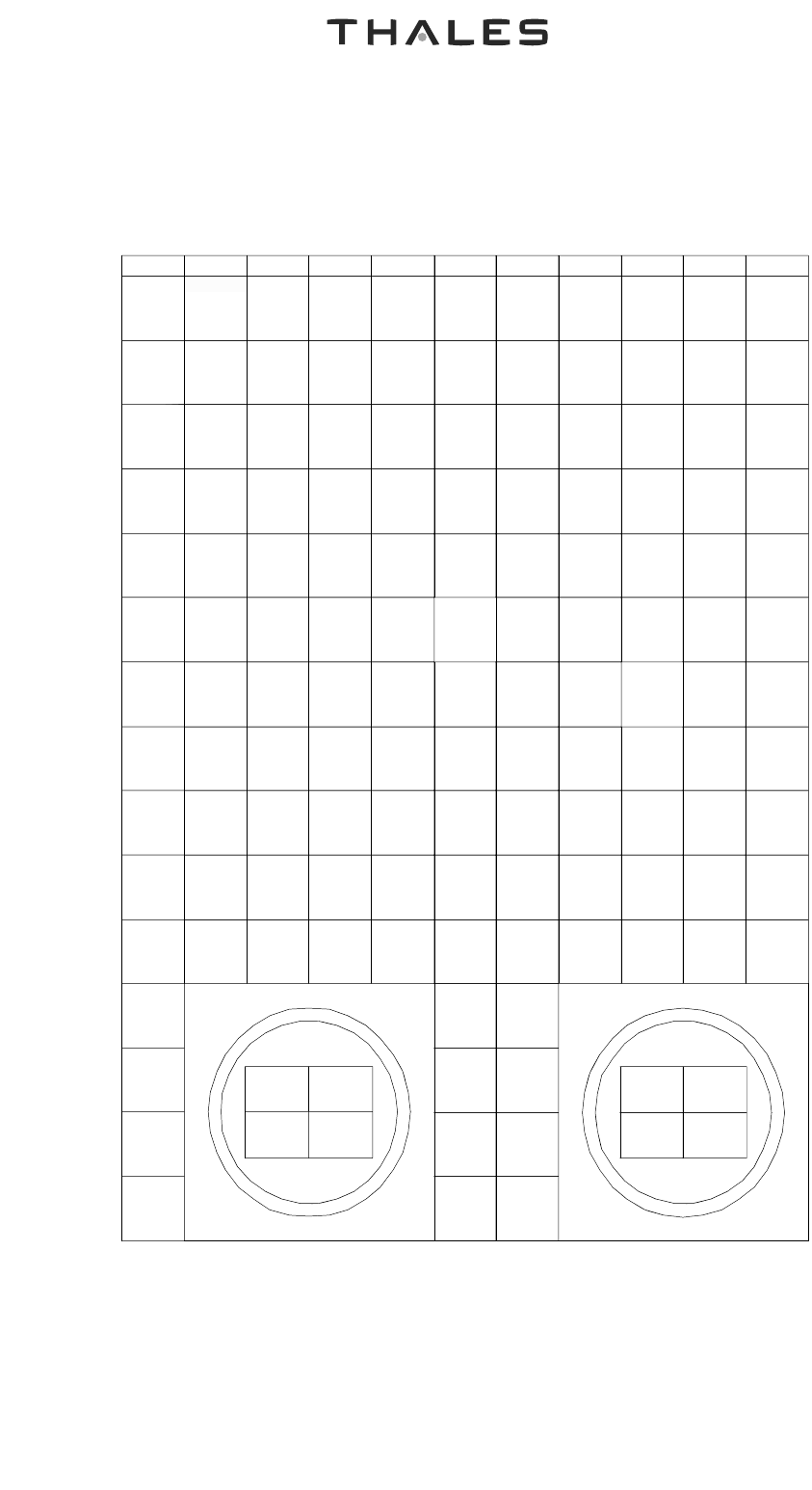
Installation Maintenance Manual
SDU 82155 Series
SCM 82158 Series
2-23
Jun 30/2008
©
THALES AVIONICS Ltd. This document and any
i
nformation included are the property of Thales Avionics.
T
hey cannot be reproduced, disclosed or utilized without the
c
ompany’s prior written approval
Figure 2.11 ARINC 600 Connect Arrangement For Middle Plug Insert
Data Input
Service
Service
Availability
Discretes
4
Service
Availability
Discretes
6
Availability
Discretes
8
Service
Availability
Discretes
10
Call
Spare
Cockpit Spare Cockpit
CP Voice Spare
Spare Spare Spare
WOW WOW
Data TX Mute
Port BSU Port BSU BITE Input STBD STBD
Data from
MCDU 1
A
Data from
MCDU 1
B
Place/End
Discrete
Input 1
SCM Pwr
+12V
Multi-
Control
Output
A
Multi-
Control
Output
B
Call
Place/End
Discrete
Input 2
Data from
MCDU 2
A
Data from
MCDU 2
B
Data from
primary
IRS
A
Data from
primary
IRS
B
CP Voice
Chime
Signal
Contact
SCM Pwr
Return 0V
BITE
Input
from HPA
A
BITE
Input
from HPA
B
CP Voice
Chime
Signal
Contact
Data
from
secondary
IRS A
Data
from
secondary
IRS B
Data
from
CMU 1
A
Data
from
CMU 1
B
Cockpit
Voice
Call Light
Output 1
SDU
Data
to SCM
A
Spare
Discrete
Output
Discrete
Input
SPARE Cockpit
Voice
Call Light
Output 2
Data
from
CMU 2
A
Data
from
CMU 2
B
Cockpit
Audio
Input 1
High
Cockpit
Audio
Input 1
Low
Voice
Mic On
Input 1
SDU
Data
to SCM
B
Spare
Discrete
Output
Discrete
Input
SPARE
Voice
Mic On
Input 2
Cockpit
Audio
Input 2
High
Cockpit
Audio
Input 2
Low
Cockpit
Audio
Output 1
High
Cockpit
Audio
Output 1
Low
Go Ahead
Chime
Reset 1
SCM
Data
to SDU
A
Spare
Discrete
Output
Discrete
Input
Spare
ARINC
429 Output
A
Spare
ARINC
429 Output
B
Cockpit
Audio
Output 2
High
Cockpit
Audio
Output 2
Low
Discrete
Input
Discrete
Input
Discrete
Input
SCM
Data
to SDU
B
Spare
ARINC
429 Input
A
Spare
ARINC
429 Input
B
Spare
ARINC
429 Input
A
Spare
ARINC
429 Input
B
AES ID
Input
A
AES ID
Input
B
Discrete
Input
Input 1
Spare
ARINC
429 Output
A
Spare
ARINC
429 Output
B
Data
to CMU
1 & 2
A
Data
to CMU
1 & 2
B
Data
from
CFDS
A
Data
from
CFDS
B
BITE Input
Top/Port
BSU/Ant
A
BITE Input
Top/Port
BSU/Ant
B
Loader
Link
A
Input
BITE
Input
STBD BSU
A
BITE
Input
STBD BSU
B
Data
to
CFDS
A
Data
to
CFDS
B
From
Airborne
Data Loader
A
From
Airborne
Data Loader
B
Crosstalk
from
other SDU
A
Crosstalk
from
other SDU
B
Dual
System
Select
Discrete I/O
Dual
System
Disable
Discrete Inp.
Crosstalk
to other
SDU
A
Crosstalk
to other
SDU
B
To
Airborne
Data Loader
A
To
Airborne
Data Loade
r
B
Data
from
MCDU 3
A
Data
from
MCDU 3
B
HPA
Mute Input
A
HPA
Mute Input
B
LNA On /
Off Control from LNA BSU HPA
Mute Input
A
BSU HPA
Mute Input
B
Data to
MCDU
1, 2, 3
A
Data to
MCDU
1, 2, 3
B
POTS 1
A
POTS 1
B
Cabin
CEPT-E1
Data Output
A
Cabin
CEPT-E1
Data Output
B
Service
Availability
Discretes
1
Service
Availability
Discretes
2
Cabin
CEPT-E1
Data Input
A
Cabin
CEPT-E1
B
POTS 2
A
POTS 2
B
Service
Availability
Discretes
3
Service
Availability
Discretes
5
Service
Availability
Discretes
7
Service
Availability
Discretes
9
1
2
3
4
5
6
7
8
9
10
11
A B C D E F G H J K
12
15
13
14
Ethernet 3
TX A Ethernet 3
RX A
Ethernet 3
TX B
Ethernet 3
RX B
Ethernet 4
RX A Ethernet 4
TX B
Ethernet 4
RX B
Ethernet 4
TX A
Ethernet 5
10 Base T
(spare)
from SDU
to User+
Ethernet 5
10 Base T
(spare)
from SDU
to User-
Ethernet 5
10 Base T
(spare)
from User
to SDU +
Ethernet 5
10 Base T
(spare)
from User
to SDU -
Resv Ext
Reset
Discrete
Input
RSVD
Mfr-Specific
0-28V
Discrete
Output
Tav_e_0000725_00
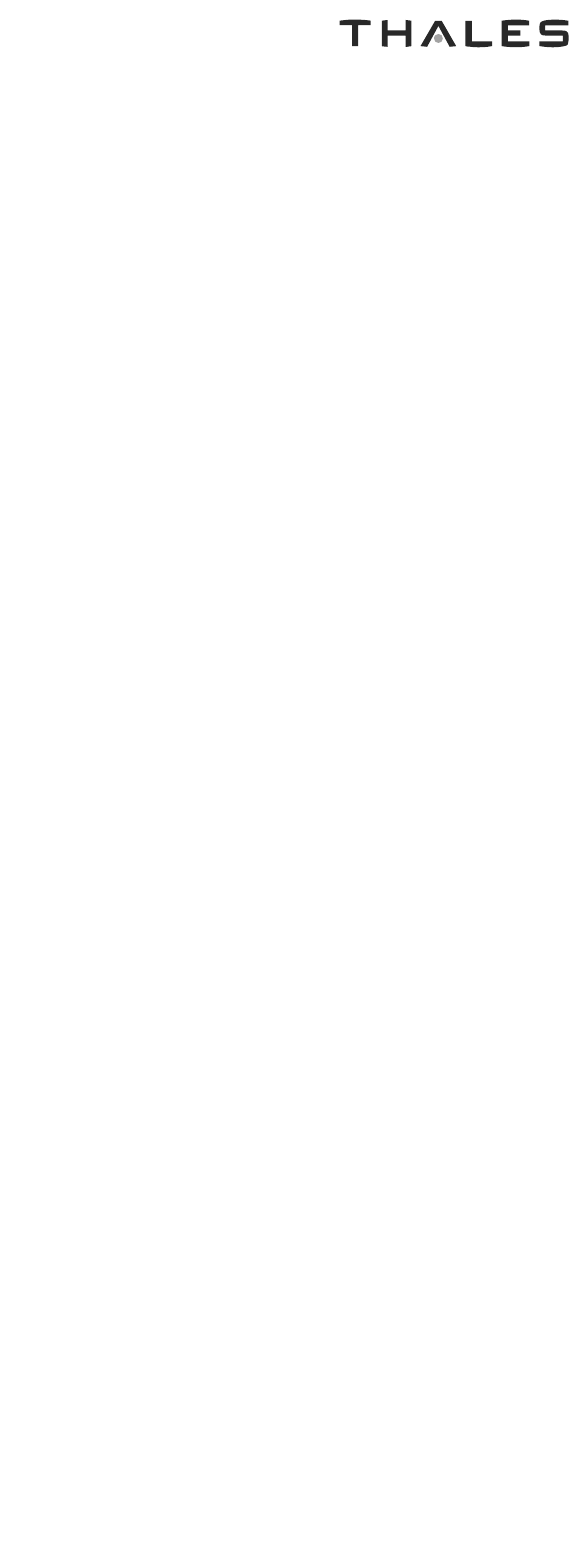
Installation Maintenance Manual
SDU 82155 Series
SCM 82158 Series
2-24
Jun 30/2008
©
THALES AVIONICS Ltd. This document and any
i
nformation included are the property of Thales Avionics.
T
hey cannot be reproduced, disclosed or utilized without the
c
ompany’s prior written approval
B. Electrical Interconnection Diagrams
The SDU interconnection diagrams (refer to 2.12 to 2.16) illustrate all the necessary
connection between the SDU and all the other interfaced equipment.
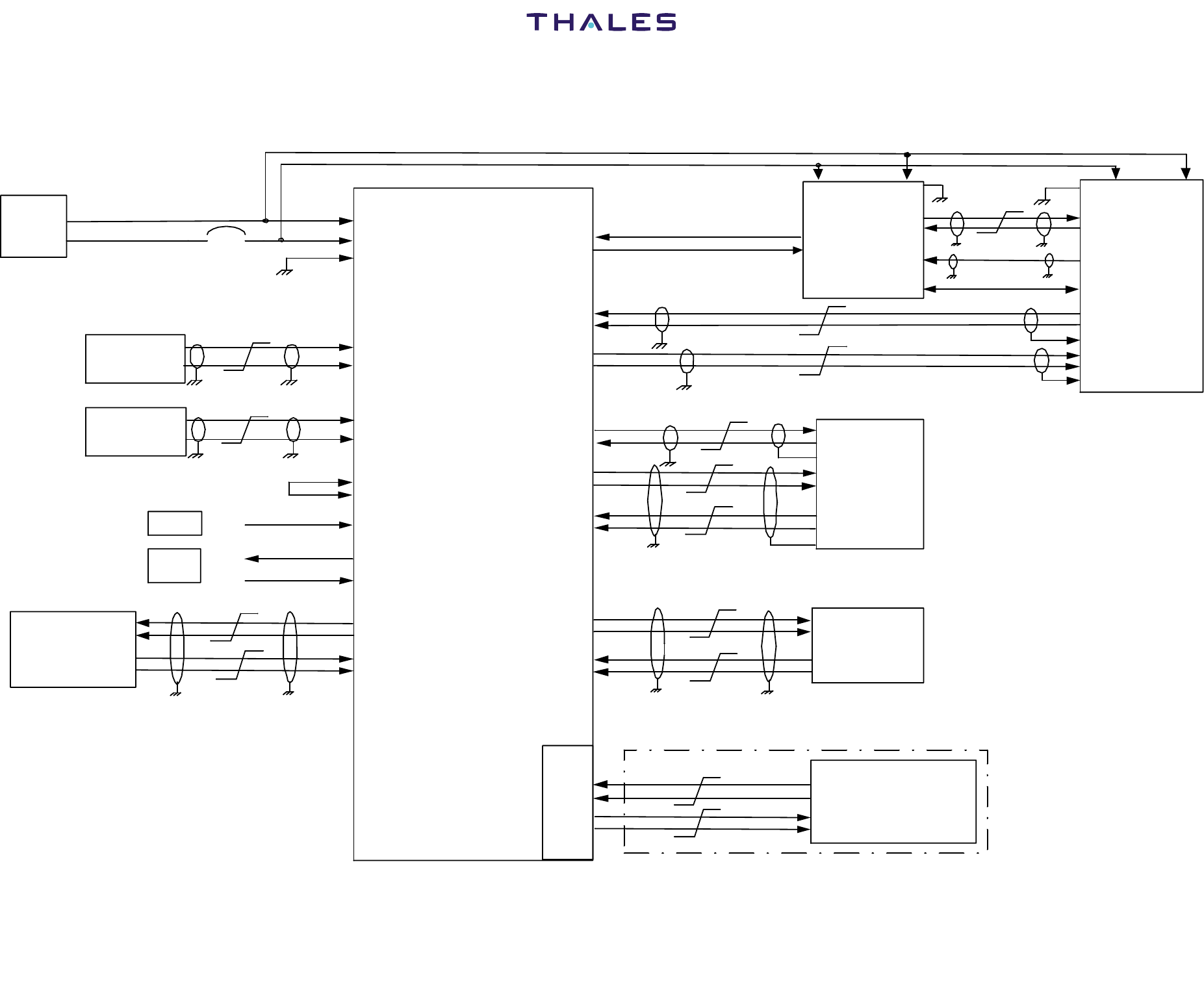
Installation Maintenance Manual
SDU 82155 Series
SCM 82158 Series
2-25
Jun 30/2008
© THALES AVIONICS Ltd. This document and any
information included are the property of Thales Avionics.
They cannot be reproduced, disclosed or utilized without the
company’s prior written approval
Figure 2.12 TFS System Interconnection Block Diagram - SDU Type 82155A (Single Aisle Configuration)
SDU
(Notes 1,7,10)
Antenna
DLNA
TP3D
TP3E
Service Availability Discrete 2
MP11F
Config Pin 1
Config Pin 2
Primary Nav Data (A)
Primary Nav Data (B)
Navigation Data
MP02A
MP02B
Aircraft
Power
Supply
BP01
BP05
BP03
115 Vac Cold
115 Vac Hot
Chassis Ground
115V AC - 7.5 AMP
Type A Circuit
Breaker
1918E
F
115 Vac Cold
115 Vac Hot
J10
D/LNA BITE Return
Client
Ethernet Port
Connector
Ethernet 3 RX (A) Q1
Ethernet 3 TX (B) Q1
Ethernet 3 TX (A) Q1
Ethernet 3 RX (B) Q1
1T-1
1T-3
1T-2
1T-4
SCM
Data to SCM (B)
Data to SCM (A)
Data from SCM (B)
Data from SCM (A)
SCM Power Return
SCM Power Source MP01D
MP02D
MP03D
MP04D
MP05D
MP06D 2
1
3
4
8
15
3
5
6
8
MP08C
MP08D
BITE Input Top/Port BSU/Ant (B)
BITE Input Top/Port BSU/Ant (A)
Multi-Control Output (B)
Multi-Control Output (A) MP01E
MP01F
7
4
(Note 5)
(Note 4)
(Note 3)
22
A
(Note 6)
7
See Figure 2 -13 for list of Explanatory
Notes
7
Front Panel RJ-45
Maintenance
Terminal
Connector
TX+
TX-
RX-
RX+
RX+
TX-
RX-
TX+ 2
1
6
3
(Note 8)
External HPA
not fitted
MP8F TX Mute Input
System Failed
Indication
TX Mute
ARINC 615A
Data Loader
Connector
TP01A
TP01C
TP01B
TP01D
Rear Ethernet RX (A)
Rear Ethernet TX (B)
Rear Ethernet TX (A)
Rear Ethernet RX (B)
(Note 11)
TX +
TX -
RX +
RX -
RX +
TX +
TX -
RX -
(Note 12)
See Note 1
for Signal
Details
MP1G SPARE
External
Reset
See Note 13
for Signal
Details
Secondary Nav Data (A)
Secondary Nav Data (B)
Navigation Data
MP01J
MP01K
RX Port
TX Port
Antenna Port (Note 2)
D/LNA BITE H9
B
D/LNA Control 11
TP71
SDU RF Output to D/LNA
SDU RF Input from D/LNA BP07
(Note 2)
Tav_e_0000704_00
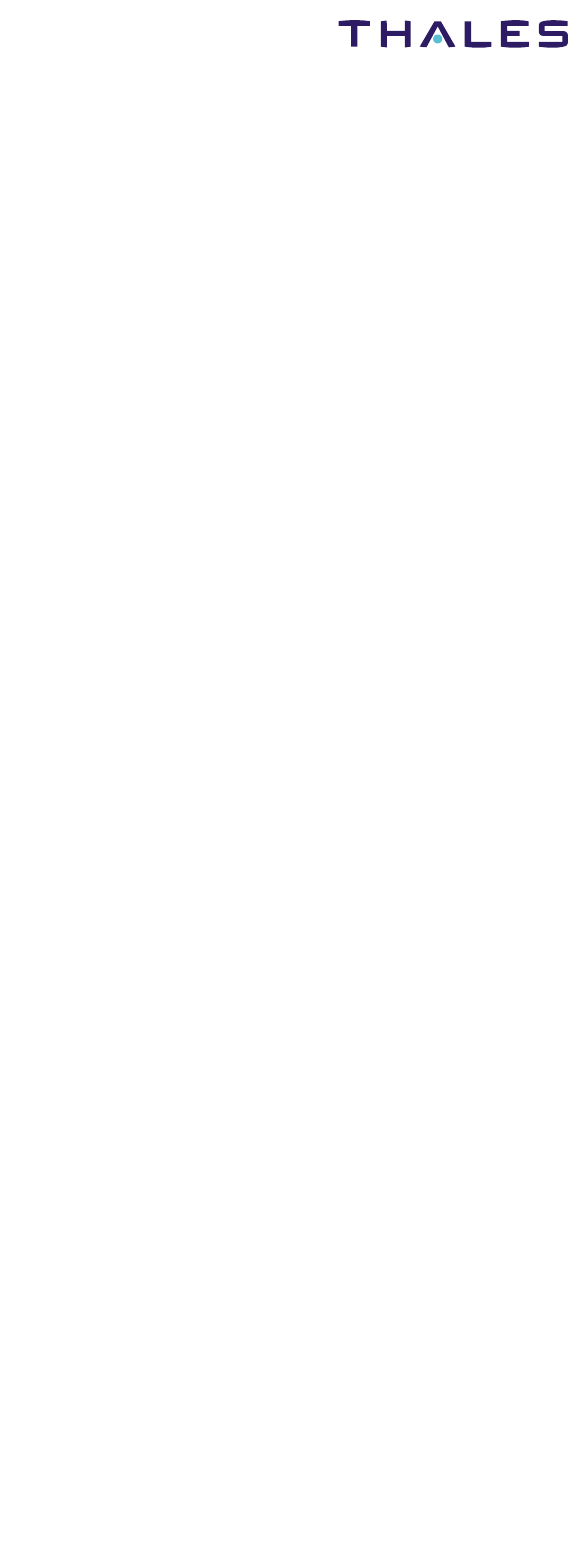
Installation Maintenance Manual
SDU 82155 Series
SCM 82158 Series
2-26
Jun 30/2008
© THALES AVIONICS Ltd. This document and any
information included are the property of Thales Avionics.
They cannot be reproduced, disclosed or utilized without the
company’s prior written approval
THIS PAGE INTENTIONALLY BLANK
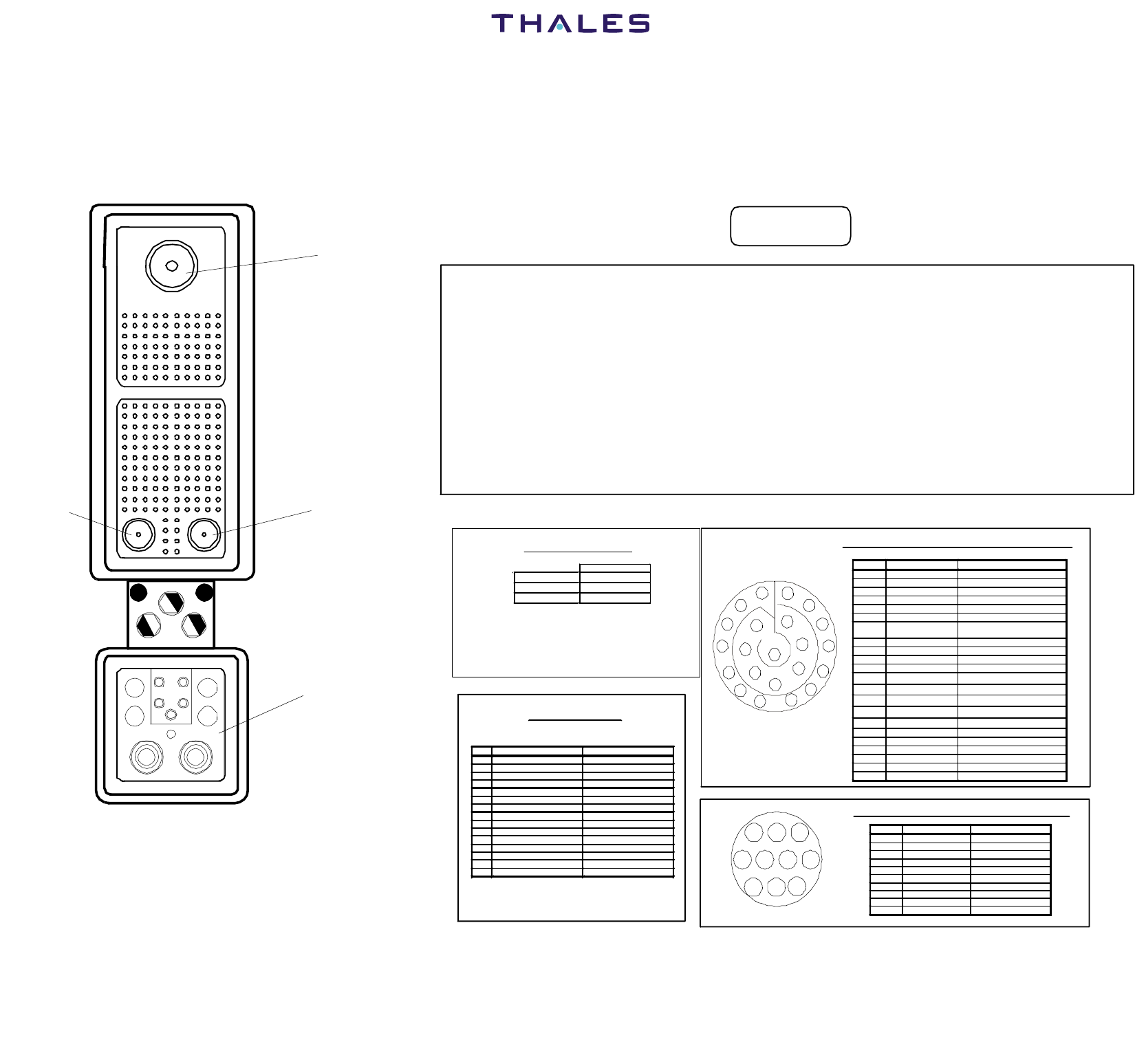
Installation Maintenance Manual
SDU 82155 Series
SCM 82158 Series
2-27
Jun 30/2008
© THALES AVIONICS Ltd. This document and any
information included are the property of Thales Avionics.
They cannot be reproduced, disclosed or utilized without the
company’s prior written approval
Figure 2.13 SDU Type 82155A Interconnection Diagram Notes
ARINC 600 - Shell Size #2 Connector
View above is looking at the SDU mount connector, Radiall Part Number: 620-600-703.
Tray-mount mating half is supplied with all necessary inserts, except 1 x Size 5 Socket Coax insert (male
centre contact) (Radiall P/No: 620-021), which should be ordered separately. See Radiall specification
for 620-600-700 for further details on supplied inserts.
Fibre inserts are not required and will not be populated on the SDU mount connector, filler plugs will be
used to fill cavities. Size 5 Coax insert BP-6 is not required on the SDU mount connector and will not be
populated, a filler plug will be used to fill cavity.
Index Code: 81 (5,2,2)
(Top Insert: 08 / Middle Insert: 120Q2 / Bottom Insert: 12F5C2)
For the index code pins above, the dark colour represents the post.
ARINC 600
SDU Connector
defined in ARINC 781 - see Note 1
ABCDEF GHJ
1
5
7
1
5
7
ABCDEF GHJ
ABCDEFGHJ
1
4
9
1
3
2
3
5
6
7
8
1
0
1
1
1
2
1
4
1
5
1
3
67
5
4
2
98
11 10
12
Index code
81 (5,2,2)
Size 5 Co-ax Plug. Radial P/N:
620 121 (female center connector)
See Note 8
Quadrax Insert 2T
Q
uadrax Insert 1T
Size 1 Co-ax Plug. Radial:
P/N:620 001 (male center
connector)
PIN No
SIGNAL
DESCRIPTION
1
+28 Vdc
Connection Not Required
2
28 Vdc RTN Connection Not Required
3
Antenna BITE A ARINC 429 from antenna
4
Antenna BITE SCRN Screen for ARINC 429
5
Antenna BITE B ARINC 429 from antenna
6
Antenna Control A ARINC 429 to antenna
7
Antenna Control
SCRN
Screen for ARINC429
8
Antenna Control B ARINC 429 to antenna
9
D/LNA BITE BITE from D/LNA
10
D/LNA SCRN Screen/RTN for D/LNA
11
D/LNA CTL D/LNA on/off control from antenna
12
Serial SCRN 1Connection Not Required
13
RS422 RXD A 1Connection Not Required
14
RS422 RXD B 1Connection Not Required
15
RS422 TXD A 1Connection Not Required
16
RS422 TXD B 1Connection Not Required
17
ATE Pin
Connection Not Required
18
115 Vac Hot Aircraft ac power
19
115 Vac Return Aircr aft ac power
20
--
Connection Not Required
21
--
Connection Not Required
22
Chassis Ground Chassis Ground
The IGA/HGA Connector is a receptacle -
13-35 insert of the MIL-C-38999 Series III
family: D38999/24FC35PN which mates with
D38999/26FC35S on the cable
1
2
3
21
20
19
18
17
16
15
7
6
5
4
8
9
10
11
12
13
14
22
IGA/HGA Power and Control Connector
Note 4
Pin Signal Description
1 Data to SDU A (RS422) Data to SDU A
2 Data to SDU B (RS422) Data to SDU B
3 Data from SDU A (RS422 Data from SDU A
4 Data from SDU B (RS422) Data from SDU B
5 Reservedÿ RS232 GND
1Connection Not required
6 Spare ConnectionNot required
7 Chassis Ground Chassis Ground
8 Power Input +8 to +15V SCM Power Input
9 Reserved- Enable RS232
1Connection Not required
10 Reservedÿ 0V strap output
1Connection Not required
11 Spare Connection Not required
12 Reservedÿ RS232 Tx
1Connection Not required
13 Reservedÿ RS232 Rx
1Connection Not required
14 Spare Connection Not required
15 Power Return 0V SCM Power Return
SCM Connector
Note
3
The SCM connector is a DB15 male connector, mating with a DB-15 female
connectoron the cable, in accordance with
MIL-DTL-24308 (15 pins - gauge 20)
.
Note 5
Pin Signal Description
Pin A Chassis Ground Chassis Ground
Pin B LNA Control LNA Control
Pin C Future Spare Connection Not required
Pin D Future Spare Connection Not required
Pin E 115 Vac Cold Aircraft AC Power
Pin F 115 Vac Hot Aircraft AC Power
P in G +28V DC Hot Connection Not required
Pin H LNA BITE LNA Bite
Pin J LNA BITE Return LNA BITE Return
Pin K +28V DC Return Connection Not required
The D/LNA Connector is MS3470L1210P which
mates with MS3476L1210S on the cable
F E D
H A B
K J CG
D/LNA Power and Control Connector
The IGA mount RF connector (J2), the DLNA mount Antenna connector (J1)
and the DLNA mount RX (SDU input) connector (J2) are all TNC Jack (female)
type connectors.
The DLNA mount TX (SDU output) connector (J3) is a N-Type Jack (female) type
connector.
RF Cable Losses
RF Loss
SDU to D/LNA Loss
1.4 dB
D/LNA to Antenna Loss
0.3 dB
D/LNA to SDU 6 dB
Loss
25 dB
Note 2
Tav
_
e
_
0000737
_
00
Note 1 : System interconnections are as per ARINC781 - refer to ARINC 781 for clarification / further detail.
Note 6 : Uses “Star-Quad” cable as defined in ARINC 664 Part 2. Cross-over to be provided in cable.
Note 7 : Pins not required are not listed and should be left ‘Not-Connected’.
Note 8 : Cross-over to be provided in cable, when using standard RJ-45 Ethernet connections.
Note 9 : Radiall P/No: 620-600-700 does not include all necessary contacts; 1 x Size 5 Crimp Socket Coaxial Contact must also be ordered: Radiall P/No: 620-021.
Note 10 : Pigtails for wiring shields/screens are to be made as short as possible to reduce susceptibility to interference.
Note 11 : Uses “Shielded, Twisted Pair” cable as defined in ARINC 664 Part 2.
Note 12 : The Maintenance Terminal interface will only be connected during maintenance activities.
Note 13 : For the External Reset discrete input signal, ground state defined as input voltage less than 3.5V and resistance to airframe dc ground less than 20 mohms.
Open state defined as input voltage higher than 14V and resistance to airframe dc ground higher than 100000 ohms.
Notes
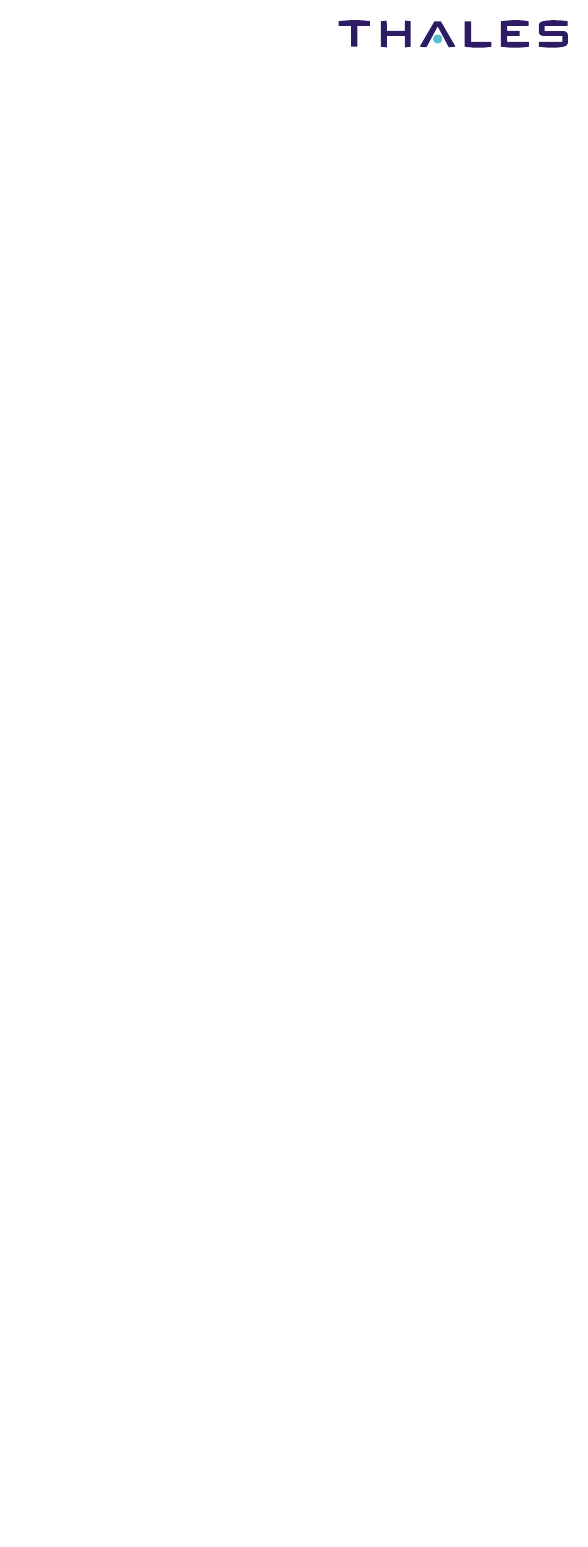
Installation Maintenance Manual
SDU 82155 Series
SCM 82158 Series
2-28
Jun 30/2008
© THALES AVIONICS Ltd. This document and any
information included are the property of Thales Avionics.
They cannot be reproduced, disclosed or utilized without the
company’s prior written approval
THIS PAGE INTENTIONALLY BLANK
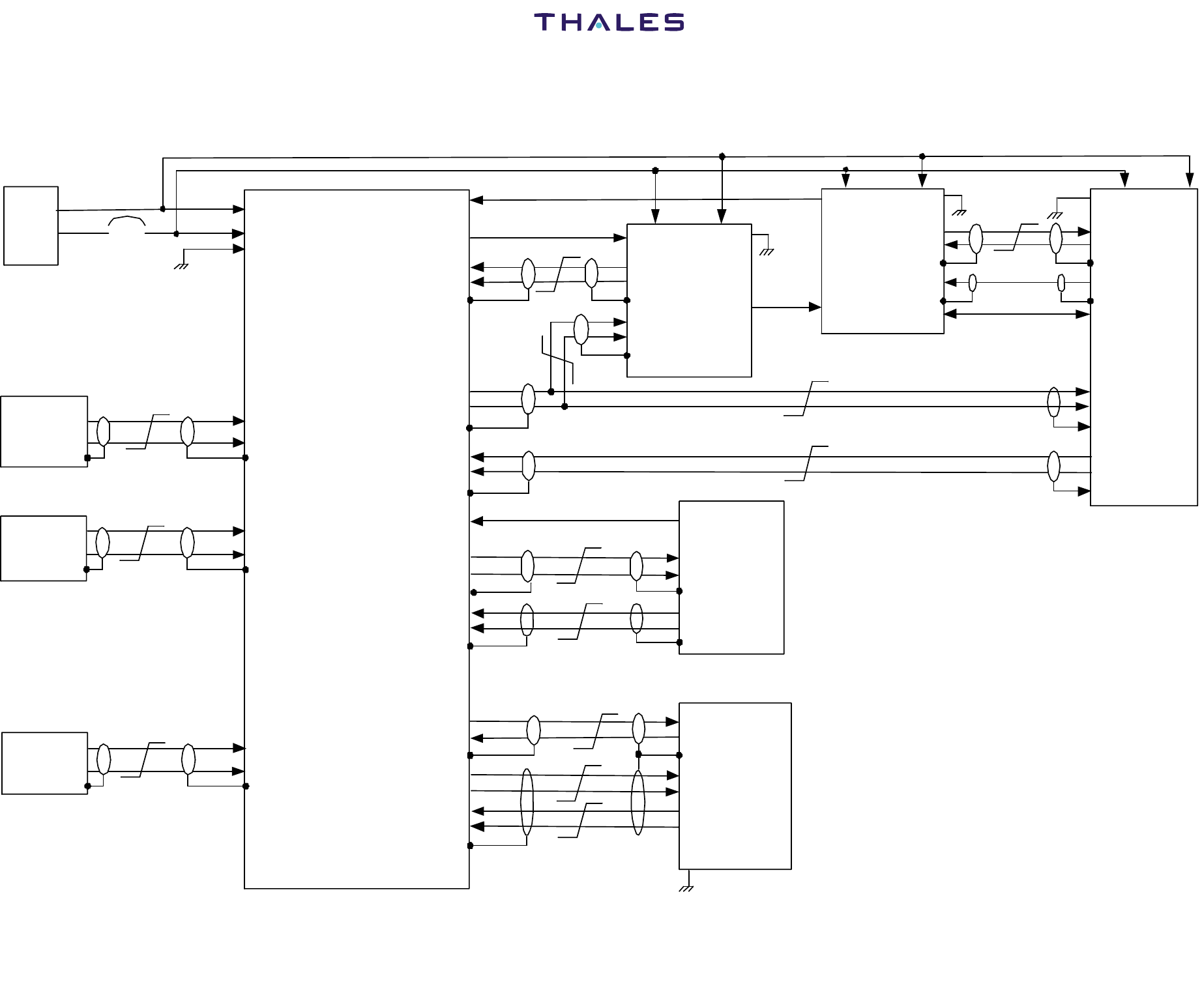
Installation Maintenance Manual
SDU 82155 Series
SCM 82158 Series
2-29
Jun 30/2008
© THALES AVIONICS Ltd. This document and any
information included are the property of Thales Avionics.
They cannot be reproduced, disclosed or utilized without the
company’s prior written approval
Figure 2.14 TFS System Interconnection Block Diagram - SDU Type 82155D (with External FMHPA) - HGA
SDU
Note 1,9,12
Antenna
DLNA
Antenna Port
DLNA BITE
B
H
DLNA Control
9
11
TP71
SDU RF Output to DLNA
SDU RF Input from DLNA BP07
Aircraft
Power
Supply
BP01
BP05
BP03
115 Vac Cold
115 Vac Hot
Chassis Ground
115V AC - 7.5 AMP
Type A Circuit
Breaker 19
18
E
F
115 Vac Cold
115 Vac Hot J10
DLNA BITE Return
SCM
Data to SCM (B)
Data to SCM (A)
Data from SCM (B)
Data from SCM (A)
SCM Power Return
SCM Power Source MP01D
MP02D
MP03D
MP04D
MP05D
MP06D 2
1
3
4
8
15
3
5
6
8
MP08C
MP08D
BITE Input Top/Port BSU/Ant (B)
BITE Input Top/Port BSU/Ant (A)
Multi-Control Output (B)
Multi-Control Output (A) MP01E
MP01F
7
4
(Note 4)
(Note 4)
(Note 3, 4)
(Note 7)
Note
6
Note
5
M3 Chassis Stud
22
A
TX Port
Data from Sec. IRS (A)
Data from Sec. IRS (B)
Navigation Data
(IRS)
See Assumption 1
MP02J
MP02K
Data from Prim. IRS (A)
Data from Prim. IRS (B)
Navigation Data
(IRS)
See Assumption 1
MP02A
MP02B
Data from AES (A)
Data from AES (B)
AES ID BUS
See Assumption 1
MP07A
MP07B
To Data Loader (B)
To Data Loader (A)
From Data Loader (B)
From Data Loader (A)
Data Loader Link A MP08E
MP09J
MP09K
MP09A
MP09B
ARINC 615
Data
Loader
FMHPA
TX Port
HPA RF Output to DLNA (Note) 4
J2
J3
MP02E
MP02F
J1-YJ1-X
J1-J
J1-A
J1-B
J1-P
J1-R
(Note 10)
J1-T
J1-S
BITE Input from HPA (A)
BITE Input from HPA (B)
7
(Note 17)
TP03D
TP03E
Config Pin 1
Config Pin 2
See
Assumption 2
(Note 13)
(Note 13)
(Note 13)
(Note 13)
(Note 13)
(Note 14)
(Note 14)
(Note 15)
(Note 18)
Tav_e_0000703_00
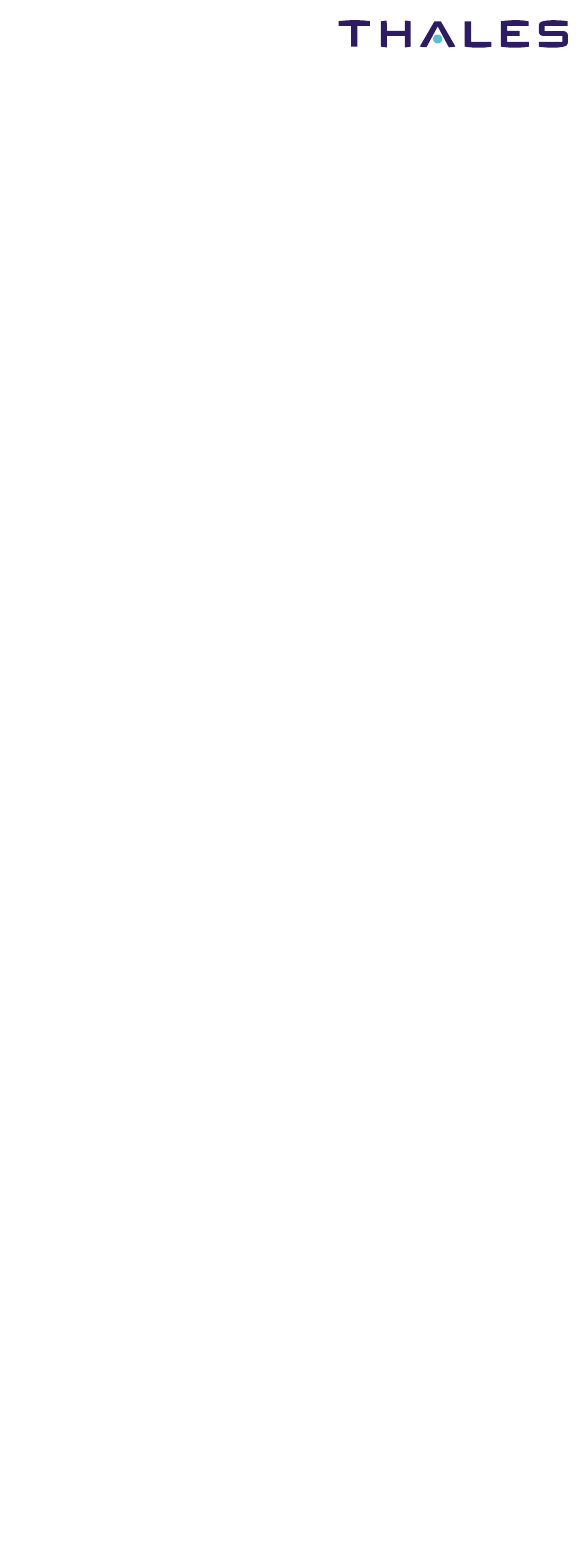
Installation Maintenance Manual
SDU 82155 Series
SCM 82158 Series
2-30
Jun 30/2008
© THALES AVIONICS Ltd. This document and any
information included are the property of Thales Avionics.
They cannot be reproduced, disclosed or utilized without the
company’s prior written approval
THIS PAGE INTENTIONALLY BLANK

Installation Maintenance Manual
SDU 82155 Series
SCM 82158 Series
2-31
Jun 30/2008
© THALES AVIONICS Ltd. This document and any
information included are the property of Thales Avionics.
They cannot be reproduced, disclosed or utilized without the
company’s prior written approval
Figure 2.15 SDU Type 82155D Interconnection Diagram Notes
ARINC 600 - Shell Size #2 Connector
View above is looking at the SDU mount connector,
Radiall Part Number: 620-600-703.
Tray-mount mating half is supplied with all necessary inserts, except 1 x Size 5 Socket Coax insert (male
centre contact) (Radiall P/No: 620-021), which should be ordered separately. See Radiall specification
for 620-600-700 for further details on supplied inserts.
Fibre inserts are not required and will not be populated on the SDU mount connector, filler plugs will be
used to fill cavities. Size 5 Coax insert BP-6 is not required on the SDU mount connector and will not be
populated, a filler plug will be used to fill cavity.
Index Code: 81 (5,2,2)
(Top Insert: 08 / Middle Insert: 120Q2 / Bottom Insert: 12F5C2)
For the index code pins above, the dark colour represents the post.
ARINC 600
SDU Connector
defined in ARINC 781 - see Note 1
ABCDEFGHJ
1
5
7
1
5
7
ABCDEFGHJ
ABCDEFGHJ
1
4
9
1
3
2
3
5
6
7
8
1
0
1
1
1
2
1
4
1
5
1
3
67
5
4
2
98
11 10
12
Index code
81 (5,2,2)
Size 5 Co-ax Plug. Radial P/N:
620 121 (female center connector)
See Note 8
Quadrax Insert 2T
Quadrax Insert 1T
Size 1 Co-ax Plug. Radial:
P/N:620 001 (male center
connector)
PIN No
SIGNAL
DESCRIPTION
1
+28 Vdc
Connection Not Required
2
28 Vdc RTN Connection Not Required
3
Antenna BITE A ARINC 429 from antenna
4
Antenna BITE SCRN Screen for ARINC 429
5
Antenna BITE B ARINC 429 from antenna
6
Antenna Control A ARINC 429 to antenna
7
Antenna Control
SCRN
Screen for ARINC429
8
Antenna Control B ARINC 429 to antenna
9
D/LNA BITE BITE from D/LNA
10
D/LNA SCRN Screen/RTN for D/LNA
11
D/LNA CTL D/LNA on/off control from antenna
12
Serial SCRN 1Connection Not Required
13
RS422 RXD A 1Connection Not Required
14
RS422 RXD B 1Connection Not Required
15
RS422 TXD A 1Connection Not Required
16
RS422 TXD B 1Connection Not Required
17
ATE Pin
Connection Not Required
18
115 Vac Hot Aircraft ac power
19
115 Vac Return Aircr aft ac power
20
--
Connection Not Required
21
--
Connection Not Required
22
Chassis Ground Chassis Ground
The IGA/HGA Connector is a receptacle -
13-35 insert of the MIL-C-38999 Series III
family: D38999/24FC35PN which mates with
D38999/26FC35S on the cable
1
2
3
21
20
19
18
17
16
15
7
6
5
4
8
9
10
11
12
13
14
22
IGA/HGA Power and Control Connector
Note 6
Pin Signal Description
1 Data to SDU A (RS422) Data to SDU A
2 Data to SDU B (RS422) Data to SDU B
3 Data from SDU A (RS422 Data from SDU A
4 Data from SDU B (RS422) Data from SDU B
5 Reservedÿ RS232 GND
1Connection Not required
6 Spare ConnectionNot required
7 Chassis Ground Chassis Ground
8 Power Input +8 to +15V SCM Power Input
9 Reserved- Enable RS232
1Connection Not required
10 Reservedÿ 0V strap output
1Connection Not required
11 Spare Connection Not required
12 Reservedÿ RS232 Tx
1Connection Not required
13 Reservedÿ RS232 Rx
1Connection Not required
14 Spare Connection Not required
15 Power Return 0V SCM Power Return
SCM Connector
Note
5
The SCM connector is a DB15 male connector, mating with a DB-15 female
connectoron the cable, in accordance with
MIL-DTL-24308 (15 pins - gauge 20)
.
Note 7
Pin Signal Description
Pin A Chassis Ground Chassis Ground
Pin B LNA Control LNA Control
Pin C Future Spare Connection Not required
Pin D Future Spare Connection Not required
Pin E 115 Vac Cold Aircraft AC Power
Pin F 115 Vac Hot Aircraft AC Power
P in G +28V DC Hot Connection Not required
Pin H LNA BITE LNA Bite
Pin J LNA BITE Return LNA BITE Return
Pin K +28V DC Return Connection Not required
The D/LNA Connector is MS3470L1210P which
mates with MS3476L1210S on the cable
F E D
H A B
K J CG
D/LNA Power and Control Connector
The IGA mount RF connector (J2), the DLNA mount Antenna connector (J1)
and the DLNA mount RX (SDU input) connector (J2) are all TNC Jack (female)
type connectors.
The DLNA mount TX (SDU output) connector (J3) is a N-Type Jack (female) type
connector.
RF Cable Losses
RF Loss
SDU to D/LNA Loss
1.4 dB
D/LNA to Antenna Loss
0.3 dB
D/LNA to SDU 6 dB
Loss
25 dB
Note 4
Note 1: System interconnections are per ARINC 781-1
Note 3:An RF attenuator may be needed if loss in DLNA to SDU cable does not fall within range specified in Note 4.
Note 8:Ethernet and ISDN connections should use “star Quad” cable as defined in ARINC 664 part 2. Cross-over to be provided in cable.
Note 9:SDU Pins not required are not listed and should be left “Not-connected”.
Note 10:HPA power and control connector.
Note 11:Radial P/N:620-600-700 does not include all necessary contacts; 1x Size 5 crimp Socket Coaxial Contact must also be ordered, Radial P/N:620-021.
Note 12:Pigtails for wiring shields/screens are to be made as short as possible to reduce susceptibility to interference. Shielded cabled and EMI backshells should
be used where possible
Note 13:A-429 (shielded twisted pair).
Note 14:Discrete.
Note 15:Power.
Note 16:Male quadrax insert.
Note 17:Connection of shields and grounding for SDU and Cabin/EFB Server are as shown. Connection of shields for SCM and ethernet ports is as per airframe
manufacturers grounding and shielding policy.
Note 18:RS-422 (shielded/twisted pair).
Assumptions
1: As per ARINC 781 attachment 1-4, note 15. If hybrid IRS data is not available , then connection to separate, autonomous inertial and GNSS navigation
equipment may be required. It is assumed that hybrid IRS data is not available. If at least one IRS bus is not providing GNSS or hybrid labels as per ARINC 781-1
attachment 1-4, note 15, connection to AES ID is required for GPS derived latitue and longitude.
2:Mandatory configuration pins are not connected since an external HPA is fitted.
Tav_e_0000708_00
Notes
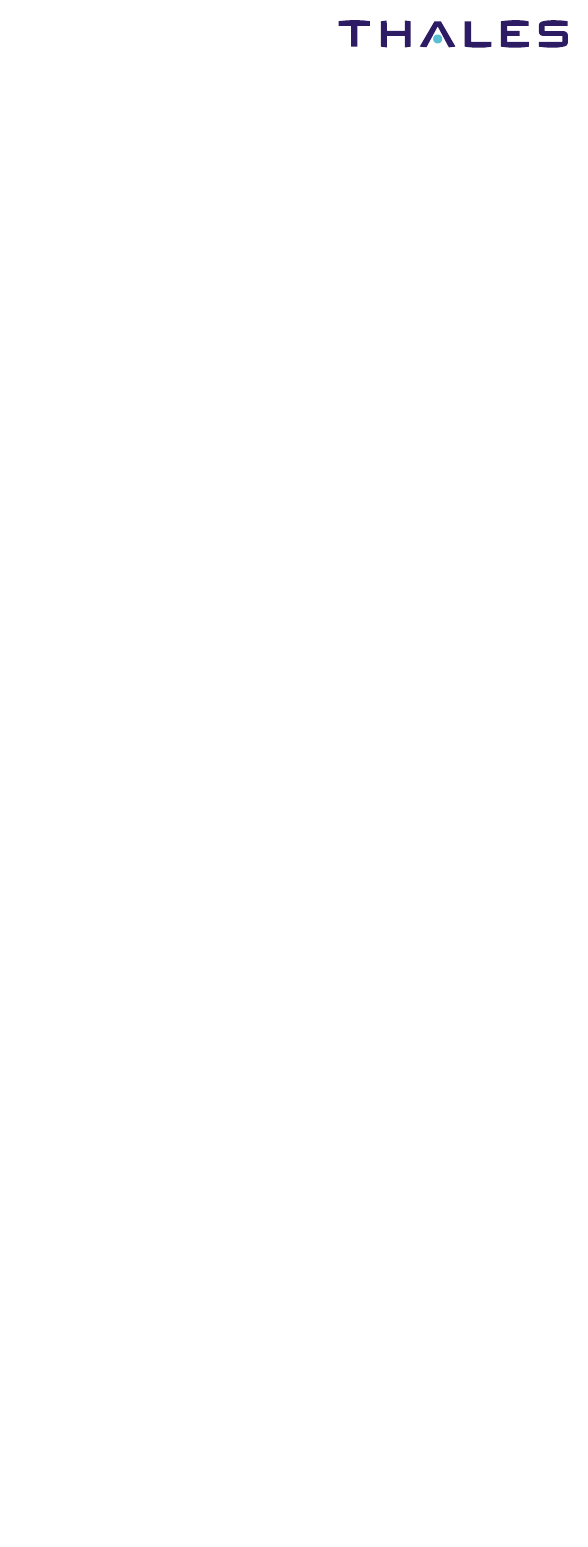
Installation Maintenance Manual
SDU 82155 Series
SCM 82158 Series
2-32
Jun 30/2008
© THALES AVIONICS Ltd. This document and any
information included are the property of Thales Avionics.
They cannot be reproduced, disclosed or utilized without the
company’s prior written approval
THIS PAGE INTENTIONALLY BLANK
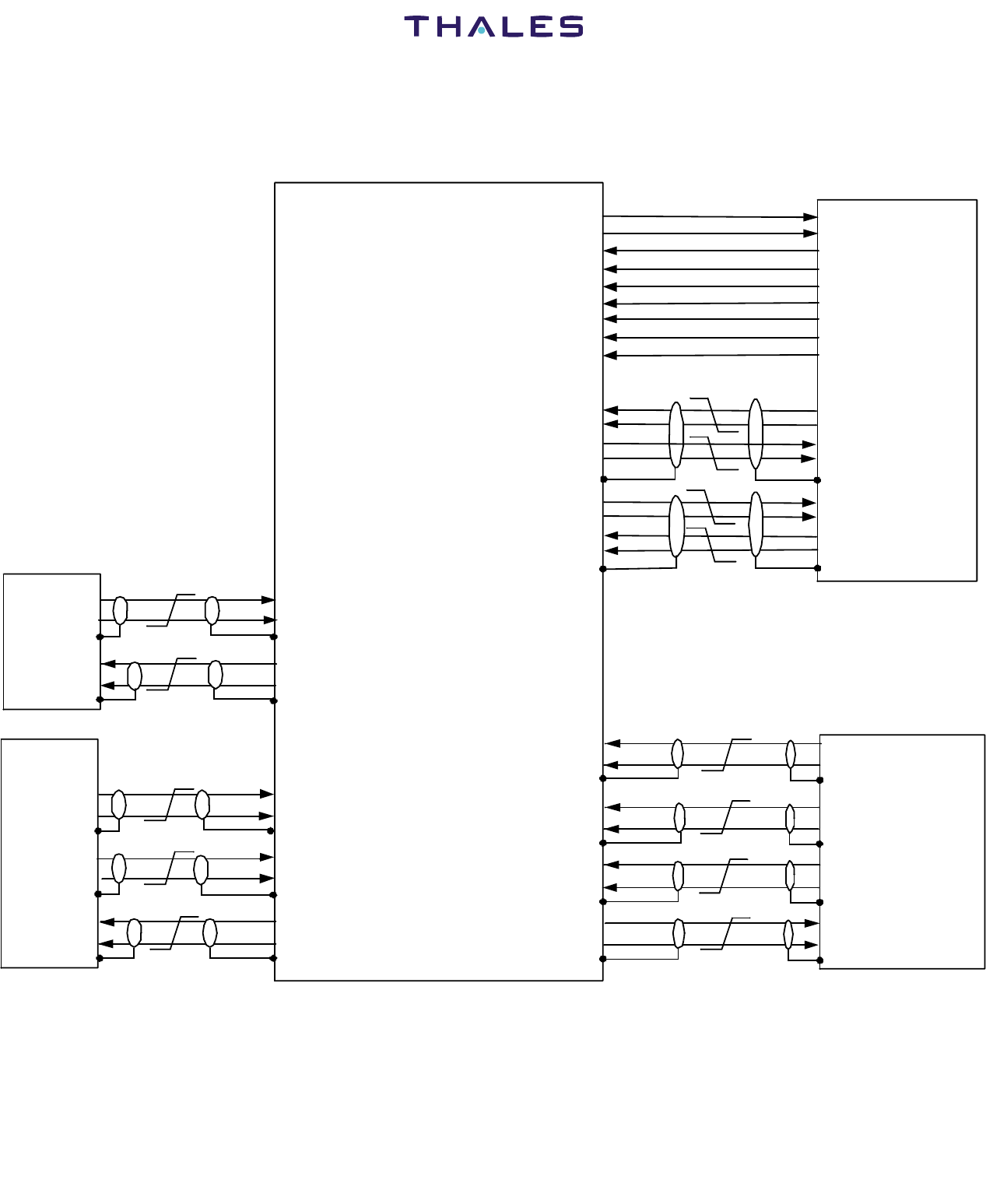
Installation Maintenance Manual
SDU 82155 Series
SCM 82158 Series
2-33
Jun 30/2008
© THALES AVIONICS Ltd. This document and any
information included are the property of Thales Avionics.
They cannot be reproduced, disclosed or utilized without the
company’s prior written approval
Figure 2.16 TFS System Interconnection Block Diagram - SDU Type 82155D Full Cockpit Interfaces
SDU
Note 1,9,12
Cockpit Audio Input 1 Hi
Cockpit Audio Input 1 Lo
Cockpit Audio Output 1 Hi
Cockpit Audio Output 1 Lo
Cockpit Audio Input 2 Hi
Cockpit Audio Input 2 Lo
Cockpit Audio Output 2 Hi
Cockpit Audio Output 2 Lo
MP04A
MP04B
MP05A
MP05B
MP04J
MP04K
MP05J
MP05K
Cockpit Voice Call Light Output 1
Cockpit Voice Call Light Output 2
Cockpit Voice Mic On Input 1
Cockpit Voice Mic On Input 2
Cockpit Voice Go Ahead Chime Reset 1
Cockpit Voice Chime Signal Contact 1
Cockpit Voice Chime Signal Contact 2
Call Place/End Discrete Input 1
Call Place/End Discrete Input 2
MP03C
MP03H
MP04C
MP04H
MP05C
MP02C
MP02H
MP01H
MP01C
Cockpit Audio
Management
Unit
Data from CMU 2 (A)
Data from CMU 2 (B)
CMU 1&2
(Data-2 / Data-3)
MP03J
MP03K
Data to CMU 1&2 (A)
Data to CMU 1&2 (B)
MP07J
MP07K
MCDU 1,2,3
Data from MCDU 1 (A)
Data from MCDU 1 (B)
Data from MCDU 2 (A)
Data from MCDU 2 (B)
Data from MCDU 3 (A)
Data from MCDU 3 (B)
MP10A
MP10B
MP01J
MP01K
MP01A
MP01B
Data to MCDU 1,2,3 (A)
Data to MCDU 1,2,3 (B)
MP10J
MP10K
Data from CMU 1 (A)
Data from CMU 1 (B)
MP03A
MP03B
Data from CFDS (A)
Data from CFDS (B)
CFDS
MP08A
MP08B
Data to CFDS (A)
Data to CFDS (B)
MP08J
MP08K
Tav_e_0000710_00
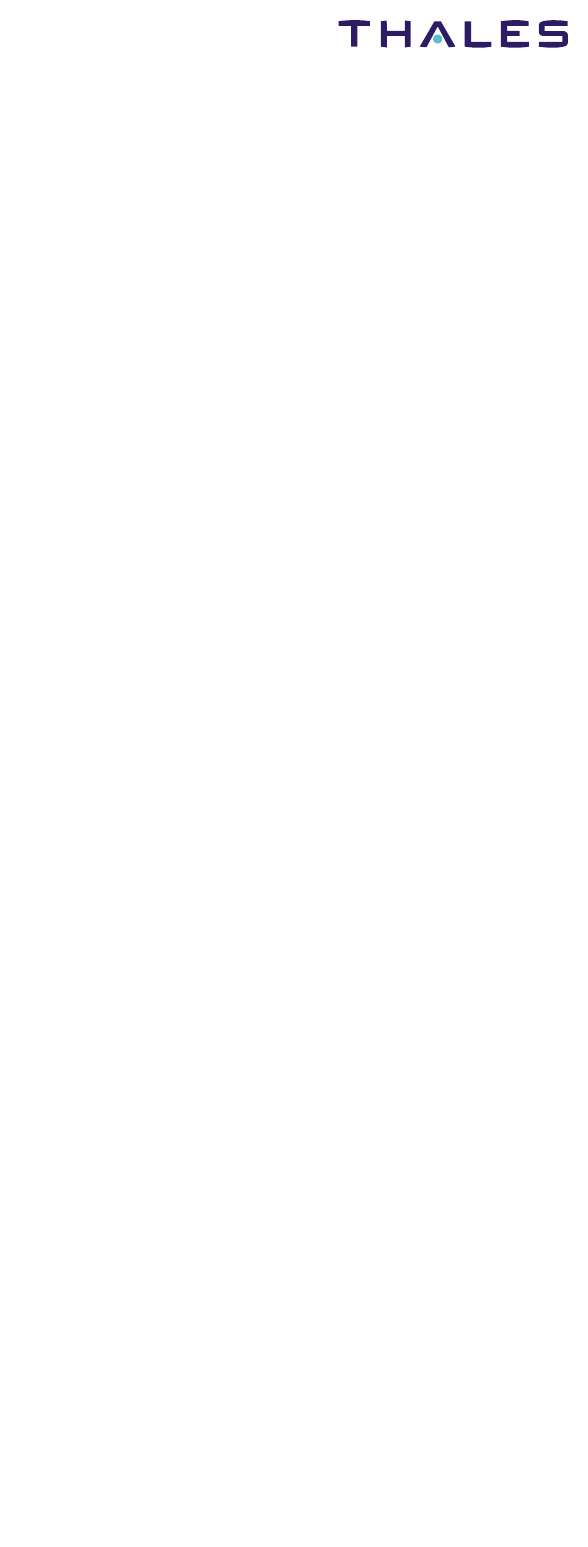
Installation Maintenance Manual
SDU 82155 Series
SCM 82158 Series
2-34
Jun 30/2008
© THALES AVIONICS Ltd. This document and any
information included are the property of Thales Avionics.
They cannot be reproduced, disclosed or utilized without the
company’s prior written approval
THIS PAGE INTENTIONALLY BLANK
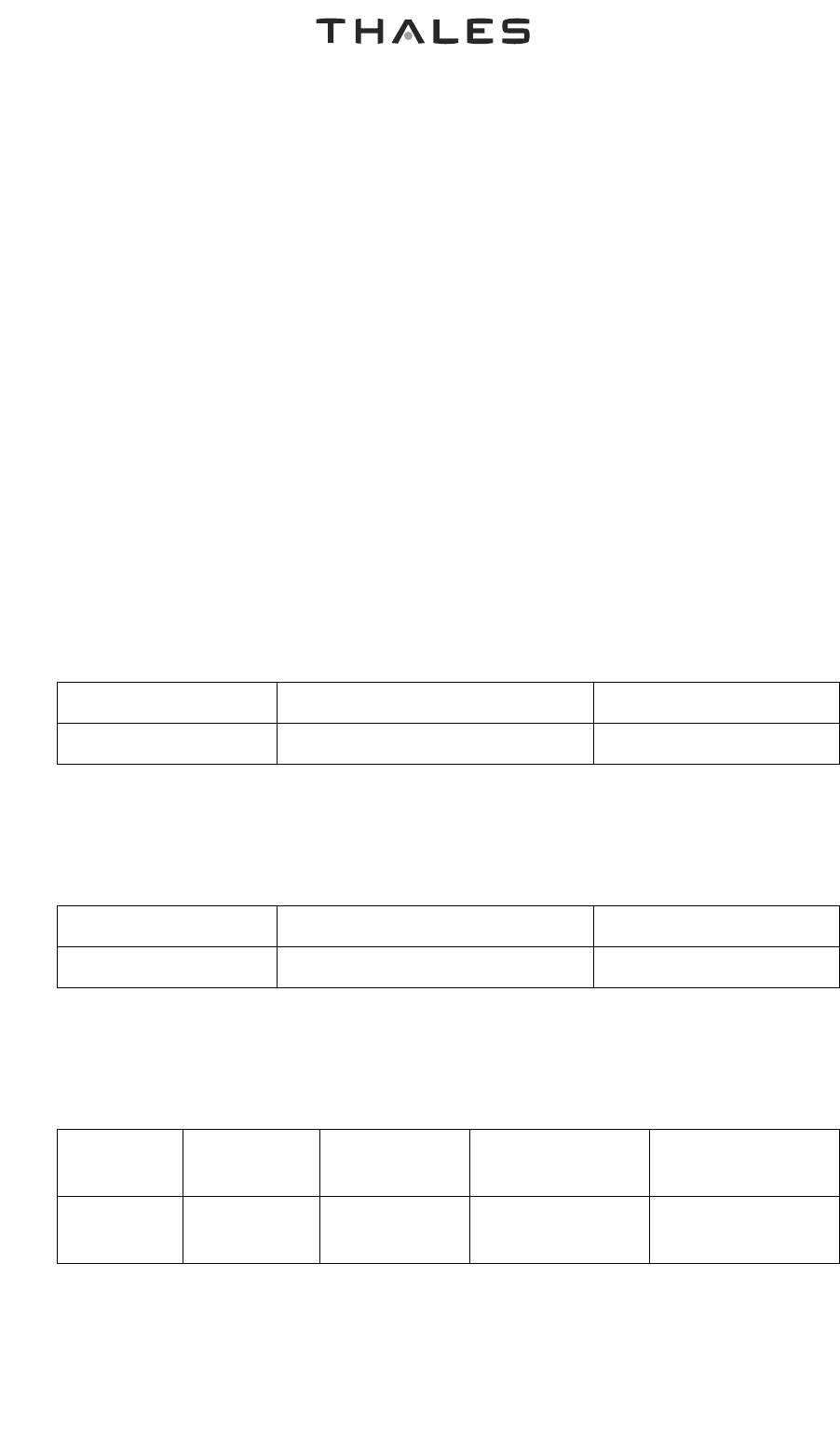
Installation Maintenance Manual
SDU 82155 Series
SCM 82158 Series
2-35
Jun 30/2008
©
THALES AVIONICS Ltd. This document and any
i
nformation included are the property of Thales Avionics.
T
hey cannot be reproduced, disclosed or utilized without the
c
ompany’s prior written approval
C. Interconnection Cables
(1) RF Coaxial Cables
The SDU is connected to the DLNA or FMHPA and Antenna (refer to Figures 2.12 to
2.15), by means of a RF low loss coaxial cable. The distance between the devices, and
the cable selected for the installation must be such that the cable losses remains within
the limits indicated within Figure 2-15, Note 4. If the cable losses cannot remain within
the limits then an FMHPA must be installed between the SDU and the DLNA (Refer to
Figure 2.13). All coaxial cable should be 50 Ohms nominally.
NOTE: Interconnect cables should be routed away from sources of potential
electromagnetic interference. Use shielded wires and cables where
necessary.
a. SDU to DLNA Tx Port
RF cable characteristics for the SDU or FMHPA to DLNA Tx port are as follows:.
Table 2.4
b. DLNA to SDU Rx Port
RF cable characteristics for the DLNA to SDU Rx port
Table 2.5
c. DLNA to Antenna Port
RF cable characteristics for the DLNA to Antenna port
Table 2.6
Maximum Path Loss Nominal Max Power Frequency Range
1.4 dB (see Note) 60 W 1626.5 – 1660.5 MHz
Loss Range Nominal Max Power Frequency Range
6 – 25 dB (see Note) 0.5 W 1525 – 1559 MHz
Max Path
Loss Nominal
Max Power Frequency
Range 5th Order Inter-
modulaion 7th order Inter-
modulation
0.3 dB (see
Note) 46 W 1525 –
1660.5 MHz (see ARINC 781) (see ARINC 781)
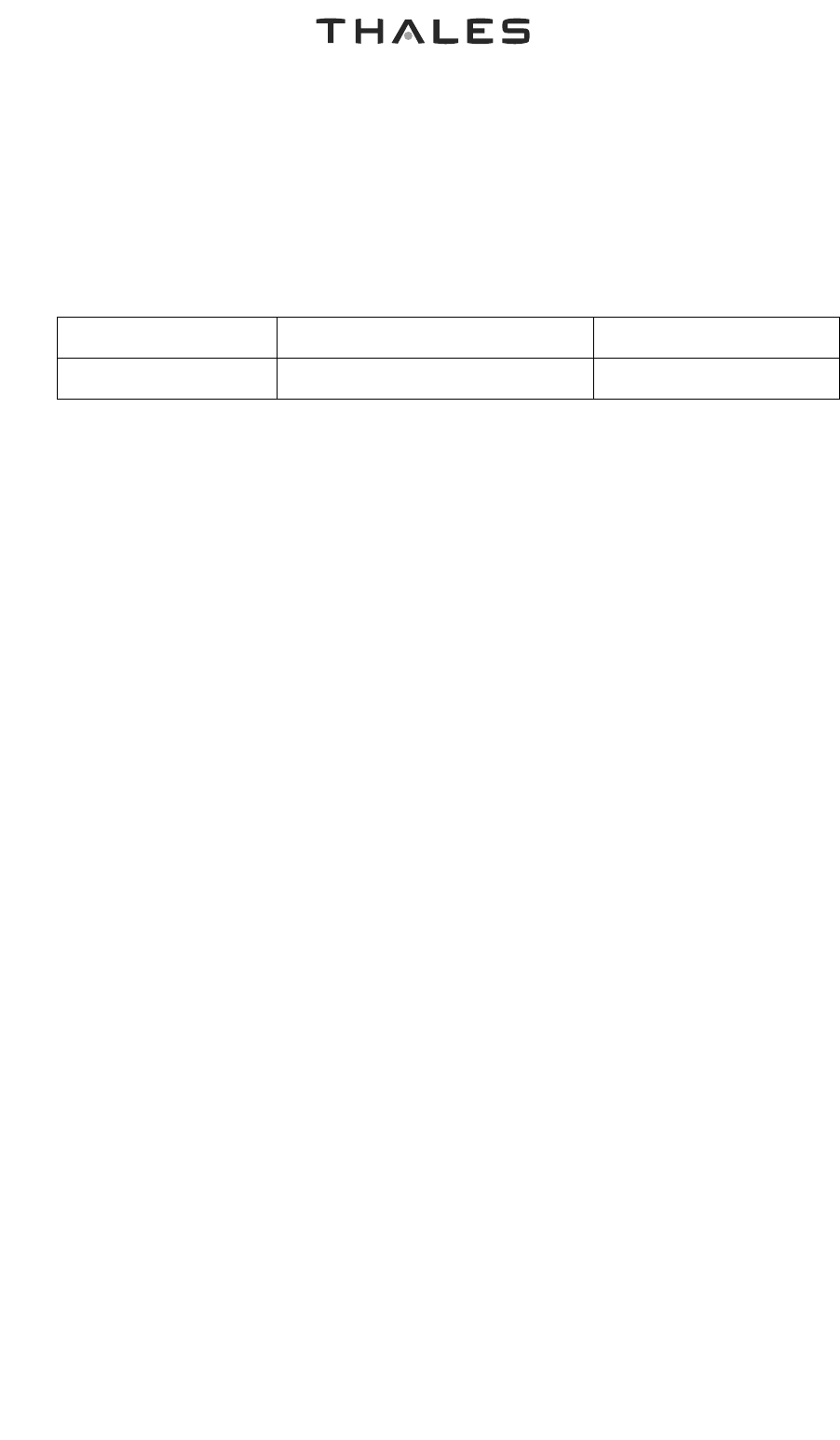
Installation Maintenance Manual
SDU 82155 Series
SCM 82158 Series
2-36
Jun 30/2008
©
THALES AVIONICS Ltd. This document and any
i
nformation included are the property of Thales Avionics.
T
hey cannot be reproduced, disclosed or utilized without the
c
ompany’s prior written approval
d. SDU to FMHPA
RF cable characteristics for the SDU to FMHPA
Table 2.7
NOTE: Applied to the complete RF cable path and not to each component within
the RF path.
(2) Power Cables
The SDU mains power cable must be able to handle 115 Vac/7.5A (see note).
NOTE: SDU switch on surge is approximately 7A for the duration of 200ms.
The SDU to SCM power cable must be able to handle 12Vdc. Cable size is 22 AWG.
(3) ARINC 429 Connections
ARINC 429 connection cable must be a size 22 single twisted and shielded pair of wires
cable.
(4) Ethernet
The recommended Aerospace Grade 100Base Ethernet cable is P/N NF 24Q100. The
conductor AWG size (19 strands) is size 24.
Flammability requirements for this cable meet or exceed FAR25.869 requirements.
2.8. SCM COMPONENT DESCRIPTION
A. Hardware
The only SCM Part Number available is 82158D Series and all other different SDU
configurations. The SCM hardware meets RTCA/DO-254 level D requirements.
The SCM contains four USIM (Universal Subscriber Identity Module) cards. The SCM
also contains an External Configuration Memory (ECM) storing the Owner
Requirement Table.
(1) External Description
The SCM is composed by the following external elements (Refer to Figure 2.17):
• The body of the SCM with one main identification label (1).
Maximum Path Loss Nominal Max Power Frequency Range
8-18 dB (see Note) 200 mW 1626.5 – 1660.5 MHz
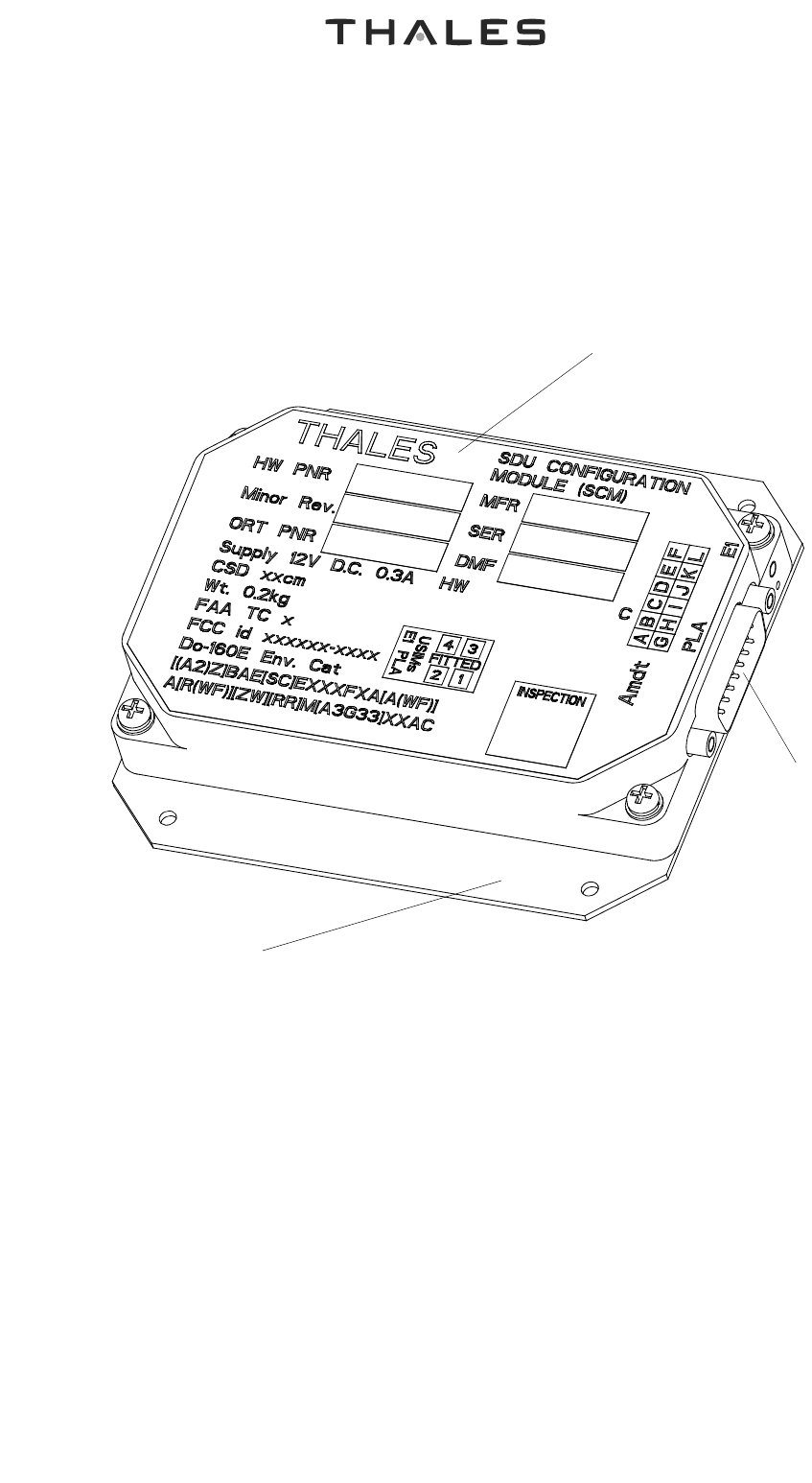
Installation Maintenance Manual
SDU 82155 Series
SCM 82158 Series
2-37
Jun 30/2008
©
THALES AVIONICS Ltd. This document and any
i
nformation included are the property of Thales Avionics.
T
hey cannot be reproduced, disclosed or utilized without the
c
ompany’s prior written approval
• The 15-way D-type (male) socket (2)
• The mounting plate with four attaching holes (3)
(2) Internal Description
The SCM is composed of the following internal parts (Refer to Figure 2.18):
• One gasket between the D-type connector and the Body of the SCM (2)
• One PEC card with a D-type connector attached (5)
• Four USIM cards holders (4)
• A plate attached to the body by four screws and washers (3)
• A body attached to the single PEC card by four screws and washers (1)
Figure 2.17 Example of SCM External View
1
2
3
Tav_e_0000730_00
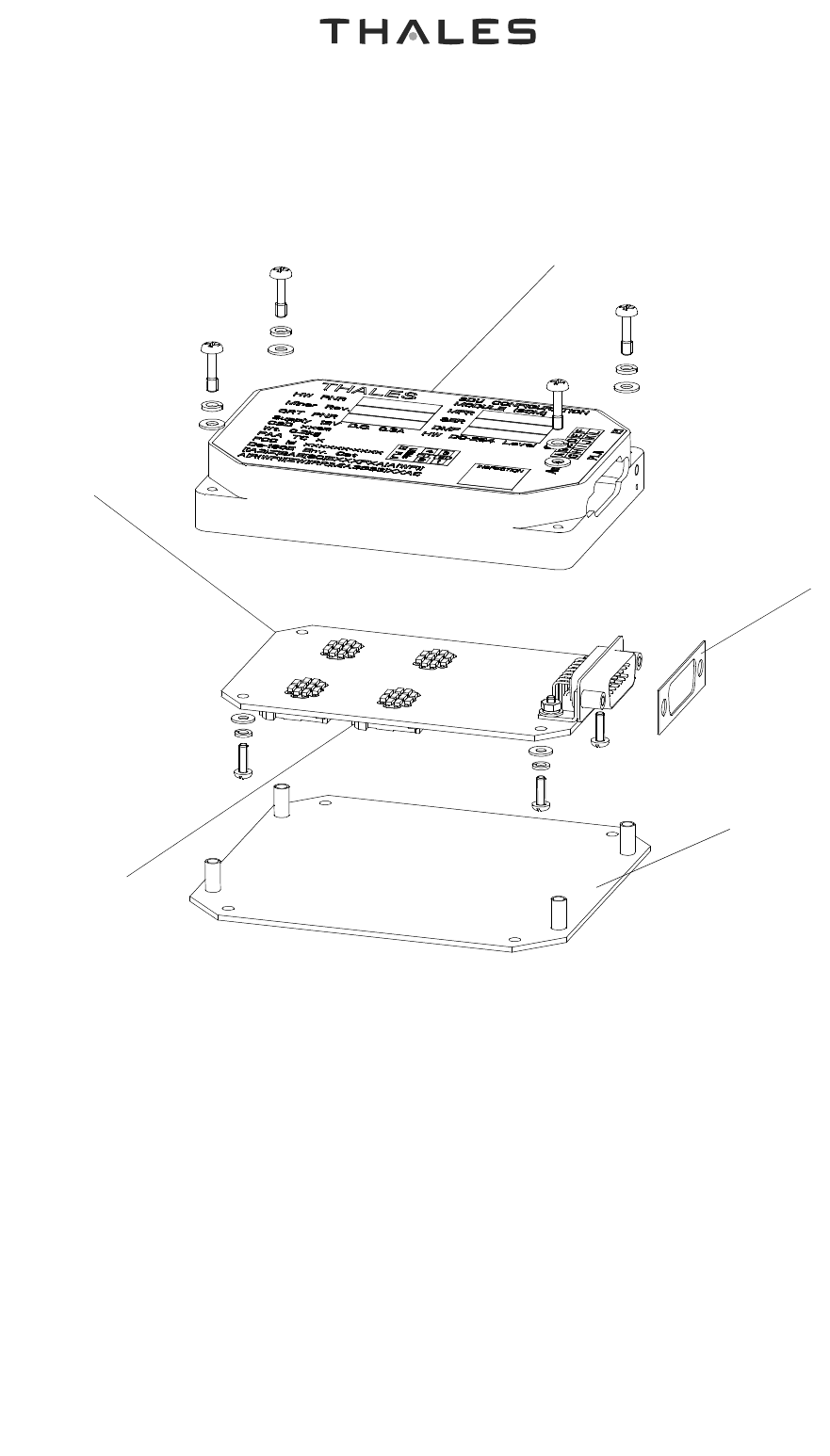
Installation Maintenance Manual
SDU 82155 Series
SCM 82158 Series
2-38
Jun 30/2008
©
THALES AVIONICS Ltd. This document and any
i
nformation included are the property of Thales Avionics.
T
hey cannot be reproduced, disclosed or utilized without the
c
ompany’s prior written approval
B. ORT Parameters
The ORT is represented by a database containing a set of configuration data for the
exclusive use of the SDU. The ORT is partitioned for two types of parameters in
accordance with ARINC 781:
• User parameters, for operator use
• Secure parameters, for aircraft specific configurations
The ORT parameters are stored within the SCM and/or SDU, and are used to customise
the operation of the TFS system, allowing various preferences to be set to enable the
Figure 2.18 SCM exploded view
1
2
3
4
5
Tav_e_0000728_00
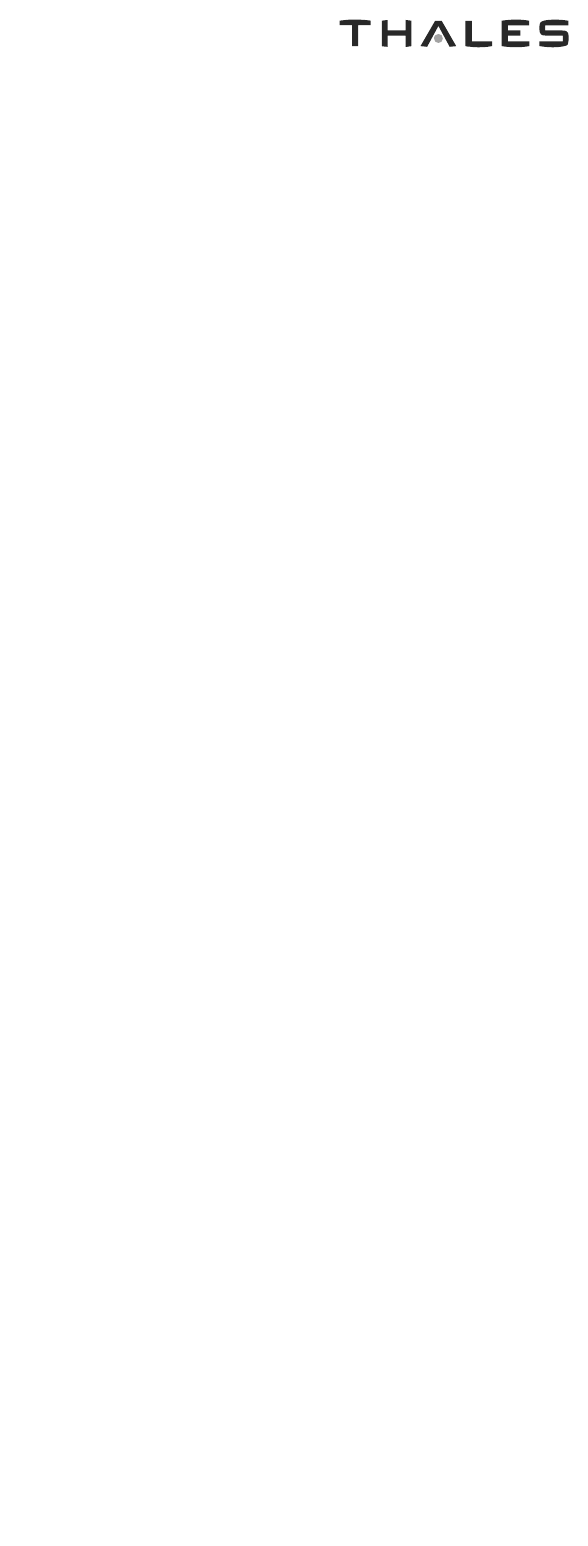
Installation Maintenance Manual
SDU 82155 Series
SCM 82158 Series
2-39
Jun 30/2008
©
THALES AVIONICS Ltd. This document and any
i
nformation included are the property of Thales Avionics.
T
hey cannot be reproduced, disclosed or utilized without the
c
ompany’s prior written approval
efficient use of the equipment within different platform configurations. The SDU and
SCM are delivered with a default ORT.
C. ORT Synchronisation
At each power up the SDU reads the ORT from the SCM, and compares it with its locally
stored copy. In normal condition the SDU and SCM ORTs should be the same, but if
different the SDU overwrites the local copy with the ORT read from the SCM. The SDU
uses that ORT until the SDU is powered down.
A small number of System Configuration Pins are mandatory. The others may be
optionally used by installers to define additional configuration details. If the optional
System Configuration Pins are not used then the configuration information may be
found in the Owner Requirements Table (ORT). TP3G is used to define whether the
optional System Configuration Pins should be read by the SDU.
The SDU stores the local copy of the SCM Secure and User ORTs over a power down in
case one of the ORTs from the SCM is not valid when the SDU next powers up.
NOTE:1. For more information concerning the operation of the SDU when it
determines that an ORT is not valid refer to the ARINC 781 specification
section 3.4.2 ‘Configuration & Identification Data’.
NOTE:2. For more information concerning changes or updates regarding ORT
contact the Thales TFS product support representative.
D. Basic Operation
When operating, the SCM interfaces with the SDU CCM via the SDU CPM. The SCM
operation will not commence until an input voltage from the SDU is detected.
Alternatively, when removed form the aircraft the SCM will also acknowledge an input
voltage from a personal computer (PC), and will operate as if it were connected to an
SDU.
A single USIM card is required for each Swift Broadband channel operated by the SDU.
The SCM contains an External Configuration Memory (ECM). The ECM is a non-
volatile memory, which stores the ORT database.
E. Environment Condition
Refer (Table 2.1)
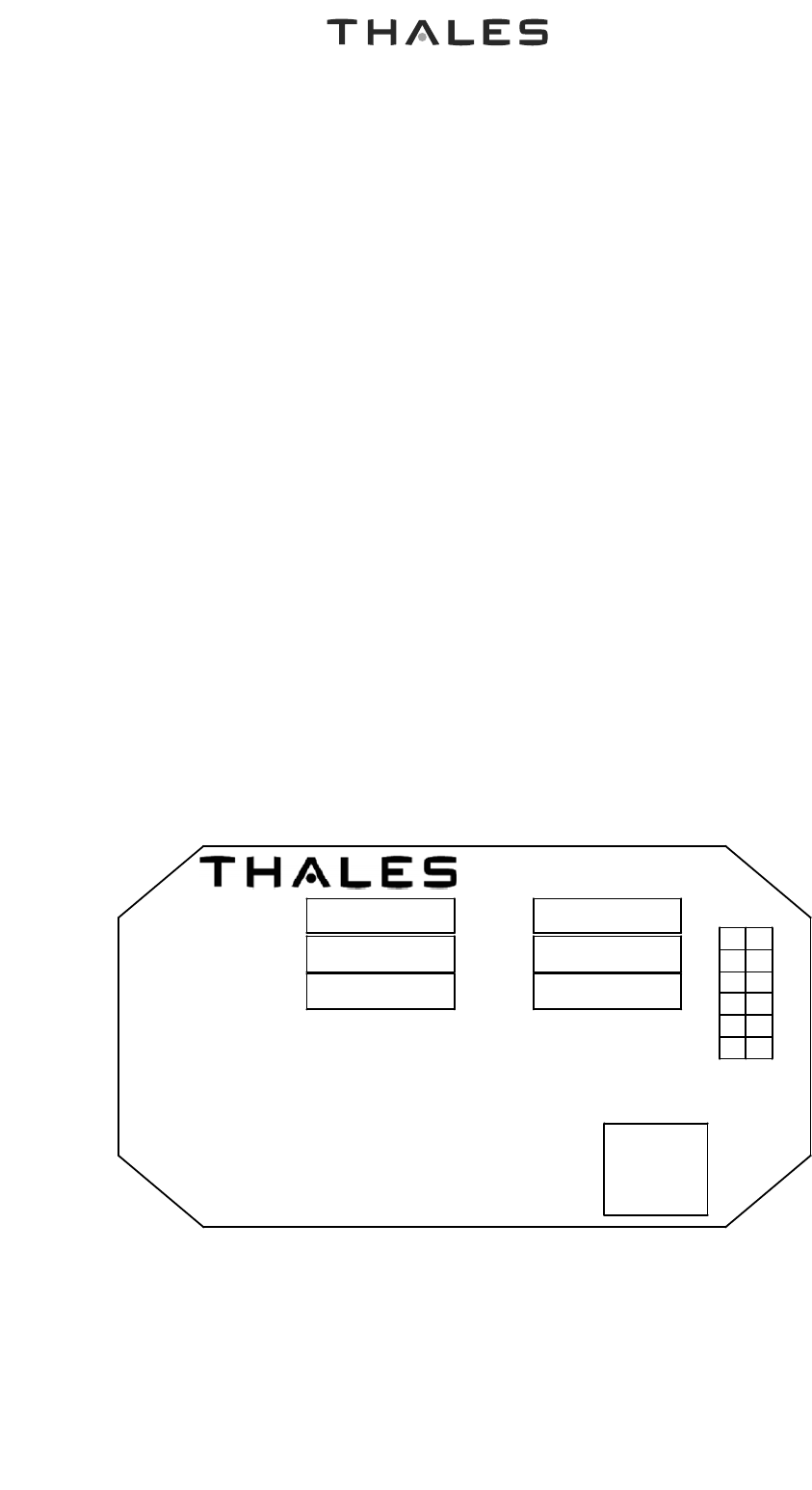
Installation Maintenance Manual
SDU 82155 Series
SCM 82158 Series
2-40
Jun 30/2008
©
THALES AVIONICS Ltd. This document and any
i
nformation included are the property of Thales Avionics.
T
hey cannot be reproduced, disclosed or utilized without the
c
ompany’s prior written approval
F. Identification Label
The main manufacturer label gives the following information (Refer to Figure 2.19):
• HW PNR: Equipment part number in alphanumeric form and bar code
form
• Minor rev: Minor revisions
• SW PNR: For Owner Requirement Table (ORT)
• MFR: Manufacturer code in alphanumeric and bar code form
• SER: Basic part number and serial numbering alphanumeric and barcode
from
• DMF: Date of final factory inspection (month and year)
• Amdt: Amendments
• CSD: Compass Safe Distance
• Wt: Weight
• FAA TC: Federal Aviation Administration Type Certificate (Blank)
• FCC id: Federal Communications Commission identification (Blank).
Figure 2.19 Example of SCM Identification Label
PNR
Minor
REV.
SW PNR
Supply 12V D.C.
CSD 10 cm
Wt. 0.25 kg MAX
FAA TC x
FCC id xxxxxx-xxxx
SDU CONFIGURATION
MODULE (SCM)
MFR
SER
DMF
INSPECT
ABCDEF
LKJIHG
PLA
E1
Amdt
Tav_e_0000724_00
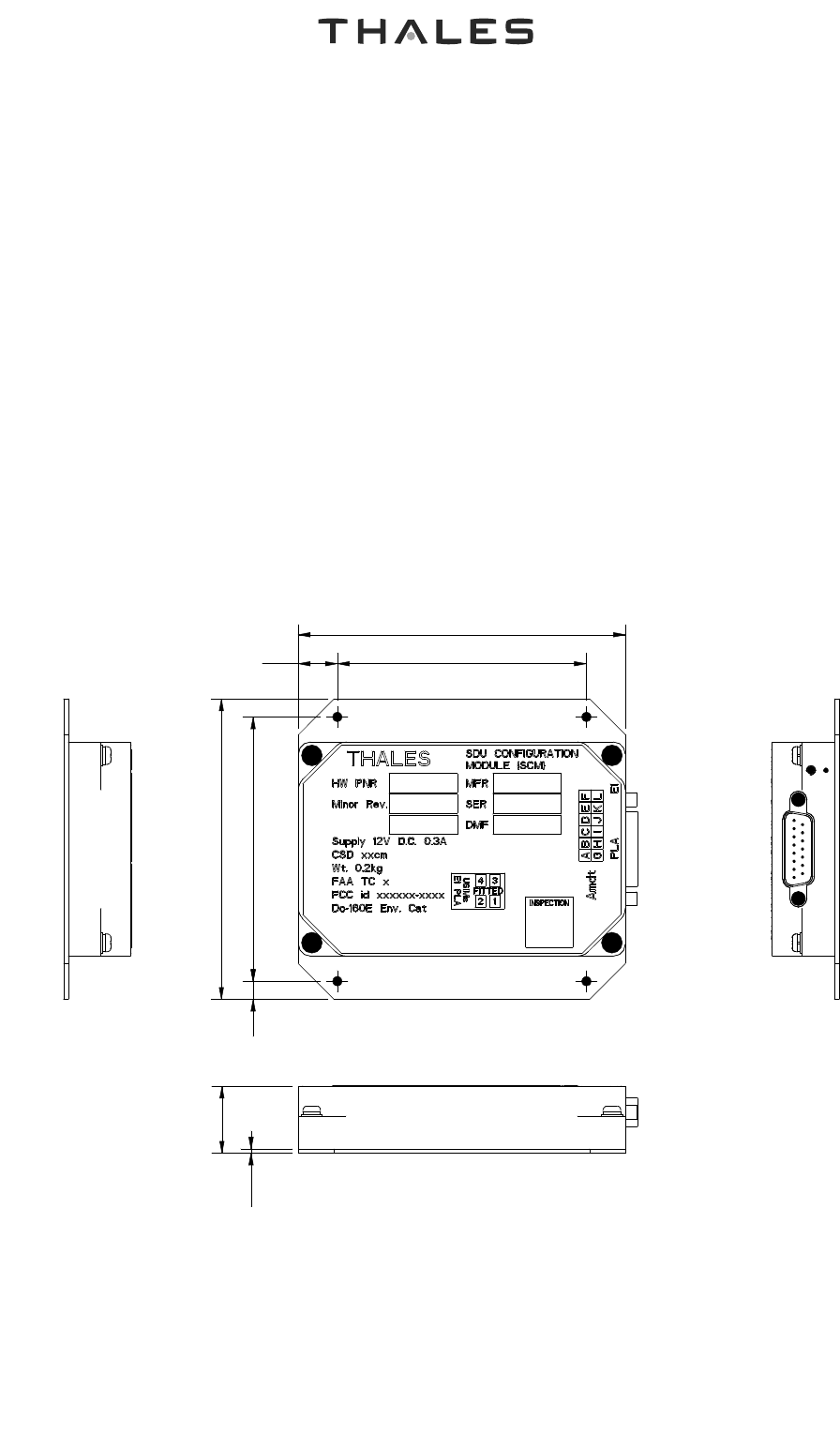
Installation Maintenance Manual
SDU 82155 Series
SCM 82158 Series
2-41
Jun 30/2008
©
THALES AVIONICS Ltd. This document and any
i
nformation included are the property of Thales Avionics.
T
hey cannot be reproduced, disclosed or utilized without the
c
ompany’s prior written approval
G. SCM Electrical Characteristics
Electrical characteristics of the SCM are as follows:
• Power input: 8 to 15 Vdc. SDU typical supplied voltage 12 Vdc
• Power consumption: 3.6 W or less
• Max current: 300 mA at 12 Vdc.
H. Weight and Dimensions
Weight and dimensions of the SCM are as folows:
• For overall dimensions Refer to Figure 2.20
• Mass = 0.25kg (0.44Lbs).
Figure 2.20 SCM Overall Dimensions
83.813.1
110
6.1 88.9
101
1
.5
22.5
Tav_e_0000731_00
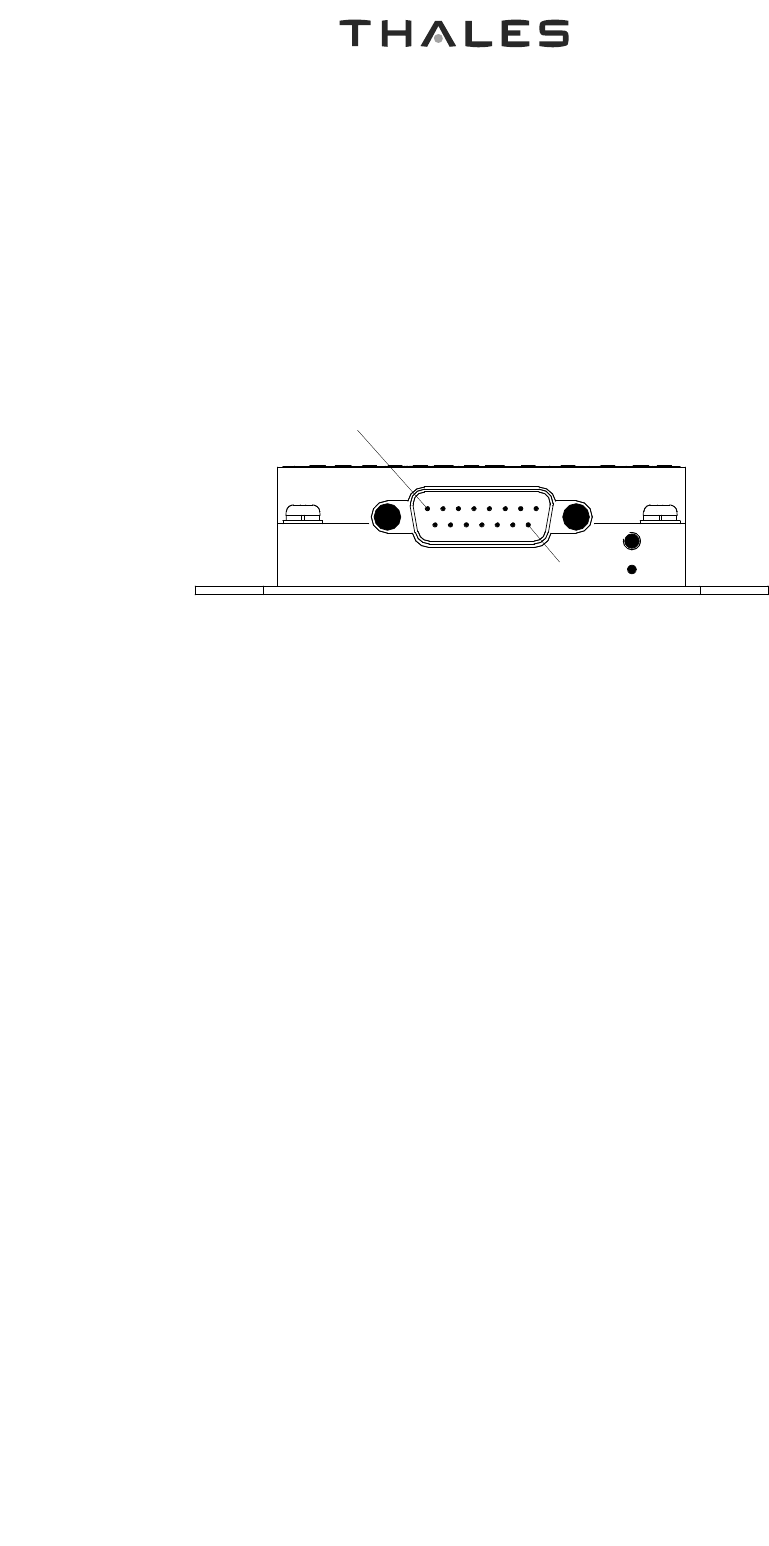
Installation Maintenance Manual
SDU 82155 Series
SCM 82158 Series
2-42
Jun 30/2008
©
THALES AVIONICS Ltd. This document and any
i
nformation included are the property of Thales Avionics.
T
hey cannot be reproduced, disclosed or utilized without the
c
ompany’s prior written approval
I. SCM Connector
The SCM connector is a DB15 (15 pins – gauge 20) male connector (Refer to Figure
2.21), mating with a DB-15 female connector on the cable. For complete description of
Pin Assignment refer to Figure 2-13 Note 3.
J. Equipment Electrical Interconnection Diagram
The SDU interconnection diagram (Refer to Figure 2.22). The diagram illustrates all the
necessary connection between the SCM and the SDU. For description of detailed pin-to-
pin connection refer to Figure 2.12 (SDU Type 82155A) and Figure 2.14 (SDU Type
82155D).
Figure 2.21 Front View of 15 Pin D-Type Connector
1
15
Tav_e_0000729_00
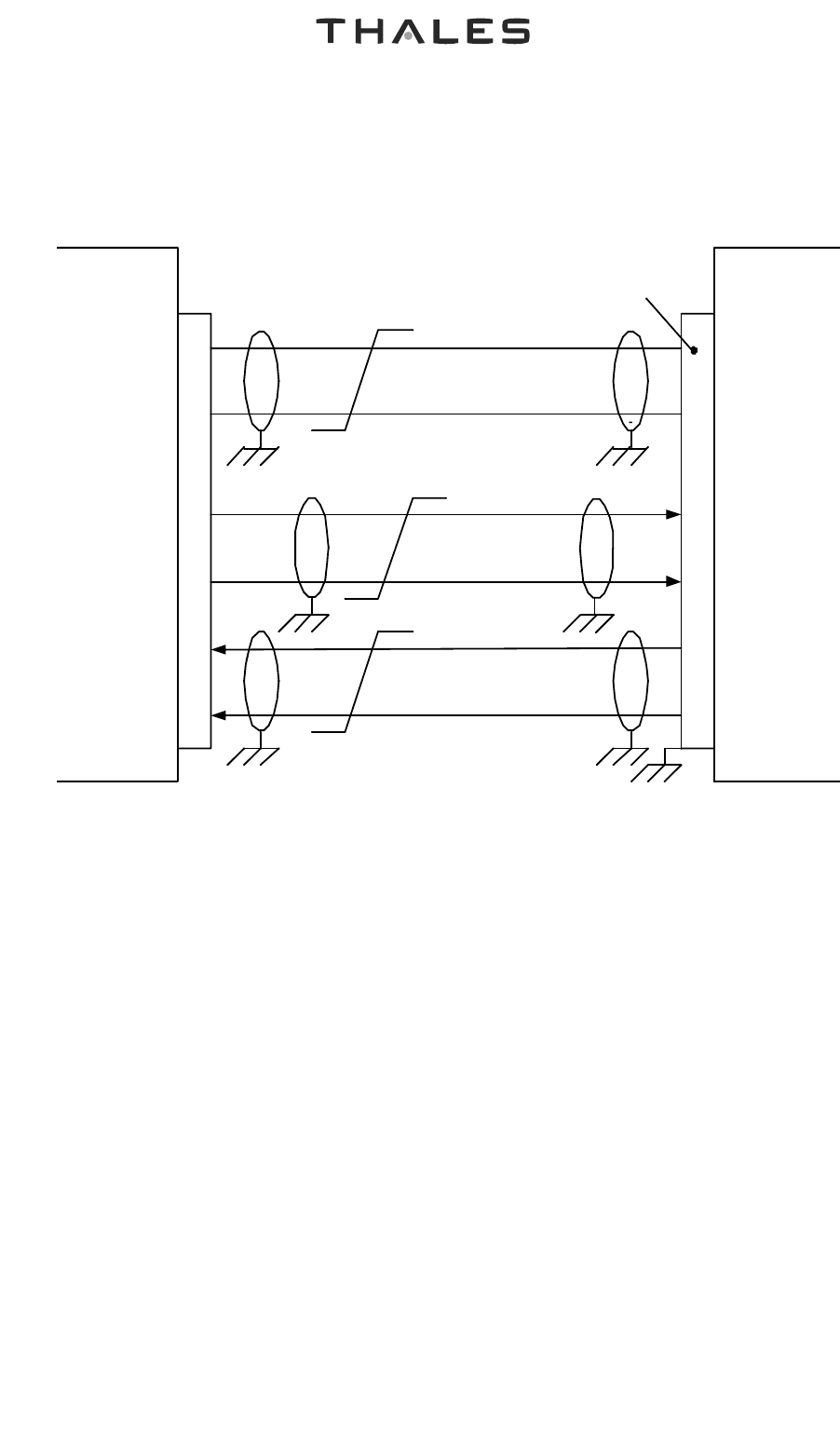
Installation Maintenance Manual
SDU 82155 Series
SCM 82158 Series
2-43
Jun 30/2008
©
THALES AVIONICS Ltd. This document and any
i
nformation included are the property of Thales Avionics.
T
hey cannot be reproduced, disclosed or utilized without the
c
ompany’s prior written approval
Figure 2.22 SDU/SCM Interconnection Diagram
SDU SCM
+ 12V
0V
RS422_Rx_A
RS422_Rx_B
RS422_Tx_A
RS422_Tx_B
15 way D-Type connector
Tav_e_0000713_00
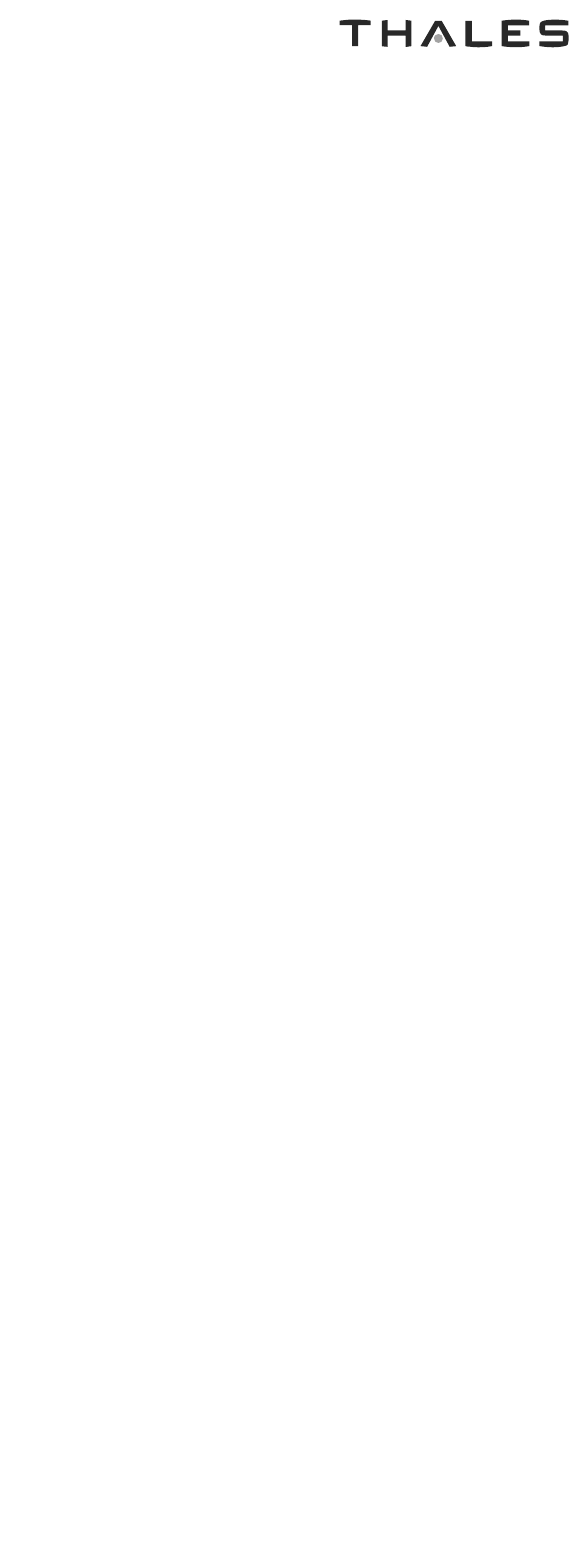
Installation Maintenance Manual
SDU 82155 Series
SCM 82158 Series
2-44
Jun 30/2008
©
THALES AVIONICS Ltd. This document and any
i
nformation included are the property of Thales Avionics.
T
hey cannot be reproduced, disclosed or utilized without the
c
ompany’s prior written approval
THIS PAGE INTENTIONALLY BLANK
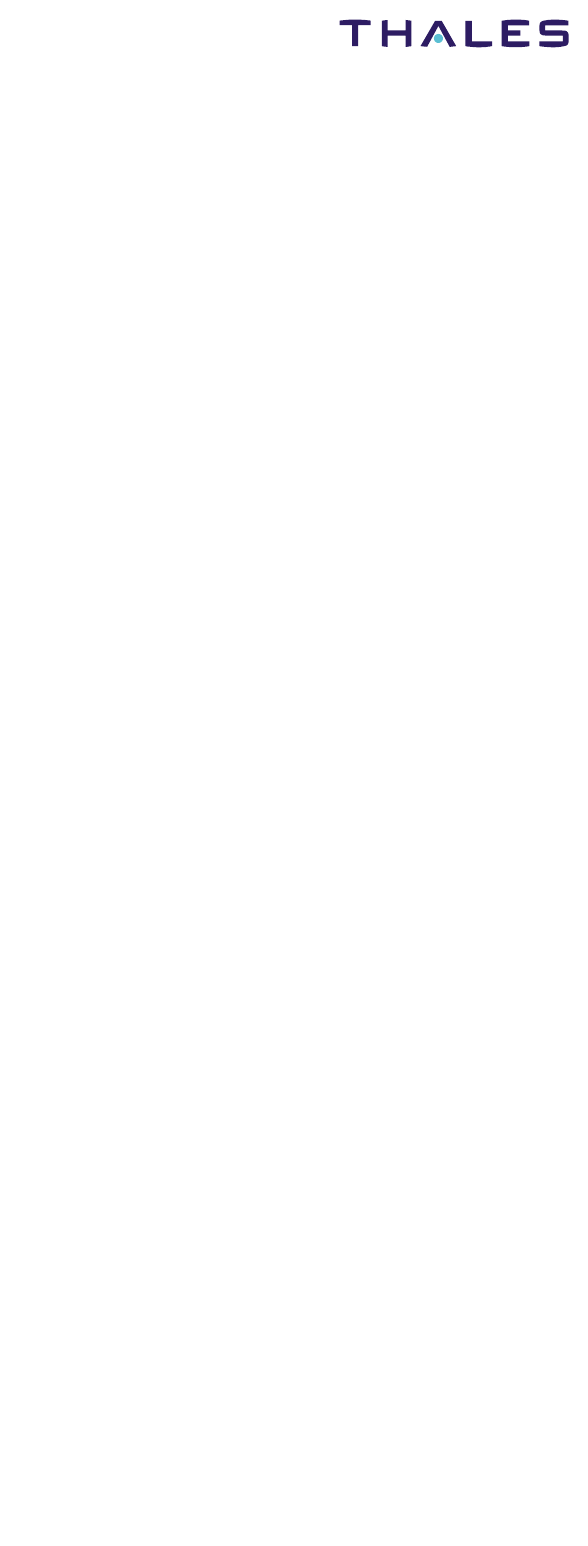
Installation Maintenance Manual
SDU 82155 Series
SCM 82158 Series
3-1
Jun 30/2008
© THALES AVIONICS Ltd. This document and any
information included are the property of Thales Avionics.
They cannot be reproduced, disclosed or utilized without the
company’s prior written approval
SECTION 3
30000INSTALLATION GUIDELINES
3.1. INTRODUCTION
The SDU and SCM should be installed in the aircraft in a manner consistent with
acceptable workmanship and engineering practices, and in accordance with the
instructions set forth in this manual.
To ensure that the system has been properly and safely installed in the aircraft the
installer should make a through visual inspection and conduct an overall operational
check of the system on the ground prior to commissioning to the Customer and or a
flight.
NOTE: Before installing any components or cabling, read all notes contained
within drawings.
3.2. INTERCHANGEABILITY
The TFS comprises two major sub-systems and a number of individual units. System
interchangeability for each of the major sub-systems and unit interchangeability for the
individual units. The first major sub-system comprises the SDU and the SCM. The
second is the antenna sub-system, comprising two LRUs, the antenna with its integrated
beam steering function, and the DLNA. Interchangeability is also desired for the
FMHPA.
There are two instances whereby individual units are defined to be functional doublets.
This means that the interwiring and pin out definitions are interchangeable, but due to
unique protocol implementations, the supply and acquisition of these units are
manufacturer specific. Functional Doublets are different from Matched Pairs in that each
unit of the Functional Doublet may fail and be changed independently, whereas in
Matched Pairs both units must be changed regardless of which unit has failed.
The Functional Doublets are as follows:
• SDU and SCM
• SDU and FMHPA.
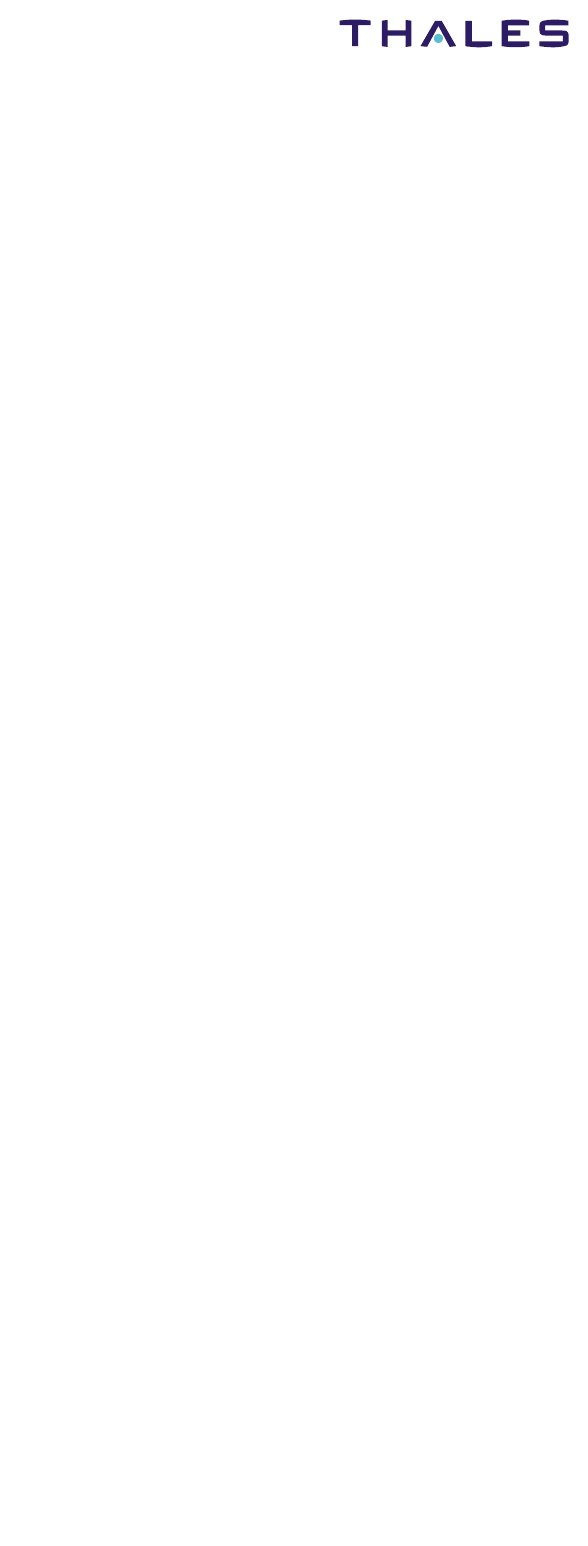
Installation Maintenance Manual
SDU 82155 Series
SCM 82158 Series
3-2
Jun 30/2008
© THALES AVIONICS Ltd. This document and any
information included are the property of Thales Avionics.
They cannot be reproduced, disclosed or utilized without the
company’s prior written approval
3.3. SDU/SCM LOCATION AND ACCESSIBILITY GUIDELINES
CAUTION: BEFORE EQUIPMENT INSTALLATION ENSURE THAT THE
AIRCRAFT POWER SUPPLY CIRCUIT BREAKER IS
POSITIONED IN THE OFF CONDITION.
The SDU must be installed in a pressurized zone that is also partially temperature
controlled, and mounted on an appropriate ARINC 600 compliant mounting rack. The
SDU requires external forced air-cooling (refer Section 2 G).
The SCM should be installed as close to the SDU as possible in order to keep the cable
runs to a maximum 10 feet.
To determine the best location, the installer must select equipment locations to allow
easy access to these components and their connectors. Equipment location will vary with
aircraft type and design/installation specifications.
The location of LRUs must comply with ARINC 781 limitations. The electronic bay is
the prefered location to install this unit.
The SDU must be installed in a location that allows the following facilities to be
accessible:
a. Front Panel LEDs
b. Front Panel TFS system Test Push Button
c. Front Panel Test Port, Software loading RJ45 connector
d. Front Panel SIS connector.
3.4. MOUNTING TRAY
The mounting tray used for the installation of the SDU must comply with the design
specifications for the 6 MCU (Modular Concept Unit) form factor. Refer to the ARINC
600 Specification for detailed information regarding the design of compatible equipment
and airframe installations.
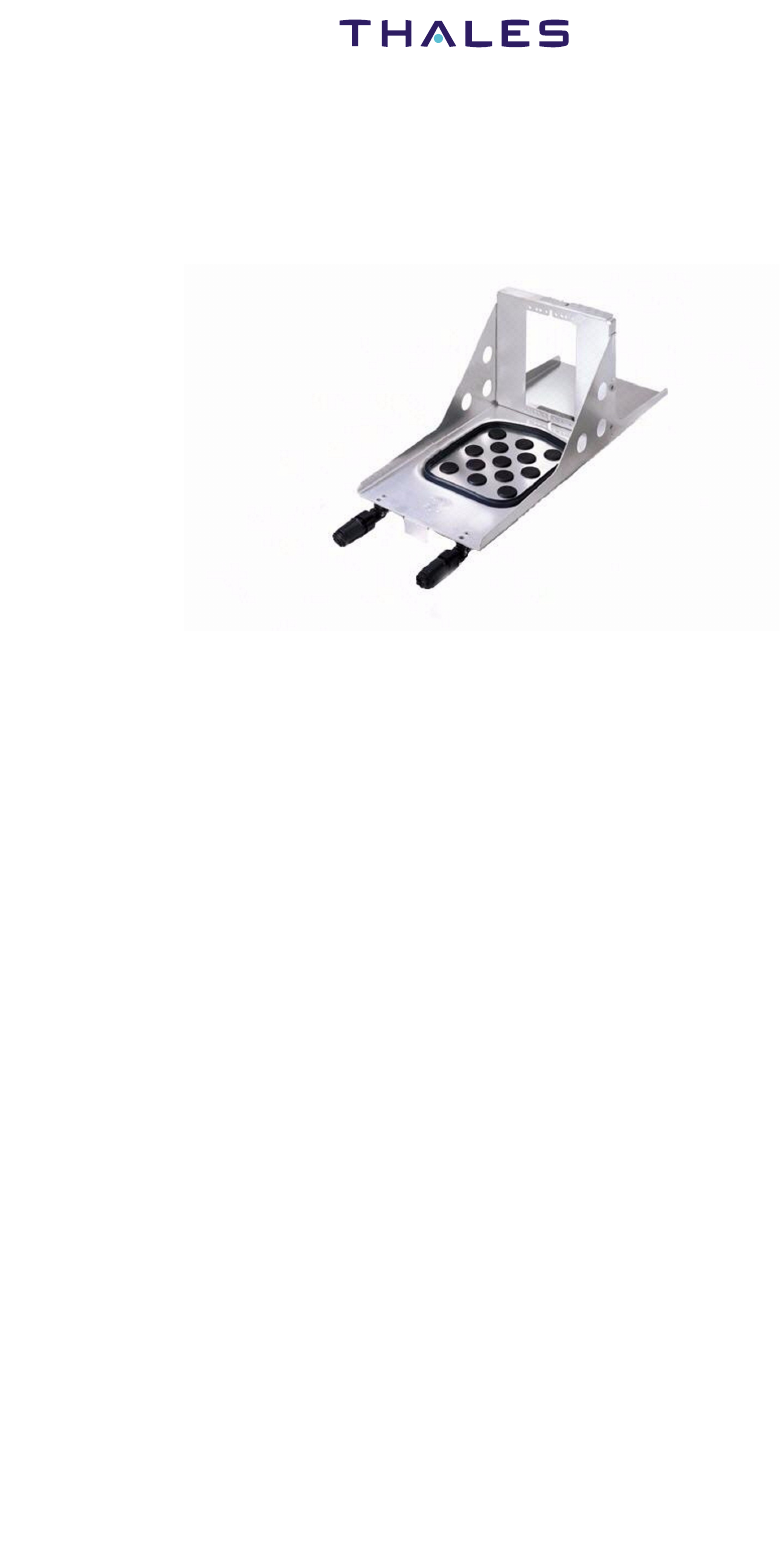
Installation Maintenance Manual
SDU 82155 Series
SCM 82158 Series
3-3
Jun 30/2008
© THALES AVIONICS Ltd. This document and any
information included are the property of Thales Avionics.
They cannot be reproduced, disclosed or utilized without the
company’s prior written approval
3.5. COOLING
The SDU is designed to accept an installation configuration able to provide forced air-
cooling as defined in Section 3.5 of the ARINC Specification 600.
In normal operation the SDU will be cooled by forced convection with air supplied from
the platform services at a maximum flow rate of 50 kg/hr and a temperature of up to
40oC. The cooling air must enter the equipment chassis at the bottom via a plenum
chamber and exhaust at the top.
3.6. POWER REQUIREMENTS
It is the responsibility of the installer to select the appropriate gauge of wire for power
connections, and to ensure that the required safety and voltage drop requirements are
complied with.
For SDU power supply specifications refer to:
a. 2.3.K: SDU Electrical Characteristics.
b. Figure 2.7: Aircraft Power Distribution.
c. Figures 2.12 to 2.16: TFS System Interconnection Diagrams.
For SCM power supply specifications refer to:
a. 2.7.G: SCM Electrical Characteristics.
b. Figure 2.12 to 2.16: TFS System Interconnection Diagrams.
Figure 3.1 Example of an ARINC 600, 6 MCU Mounting Tray
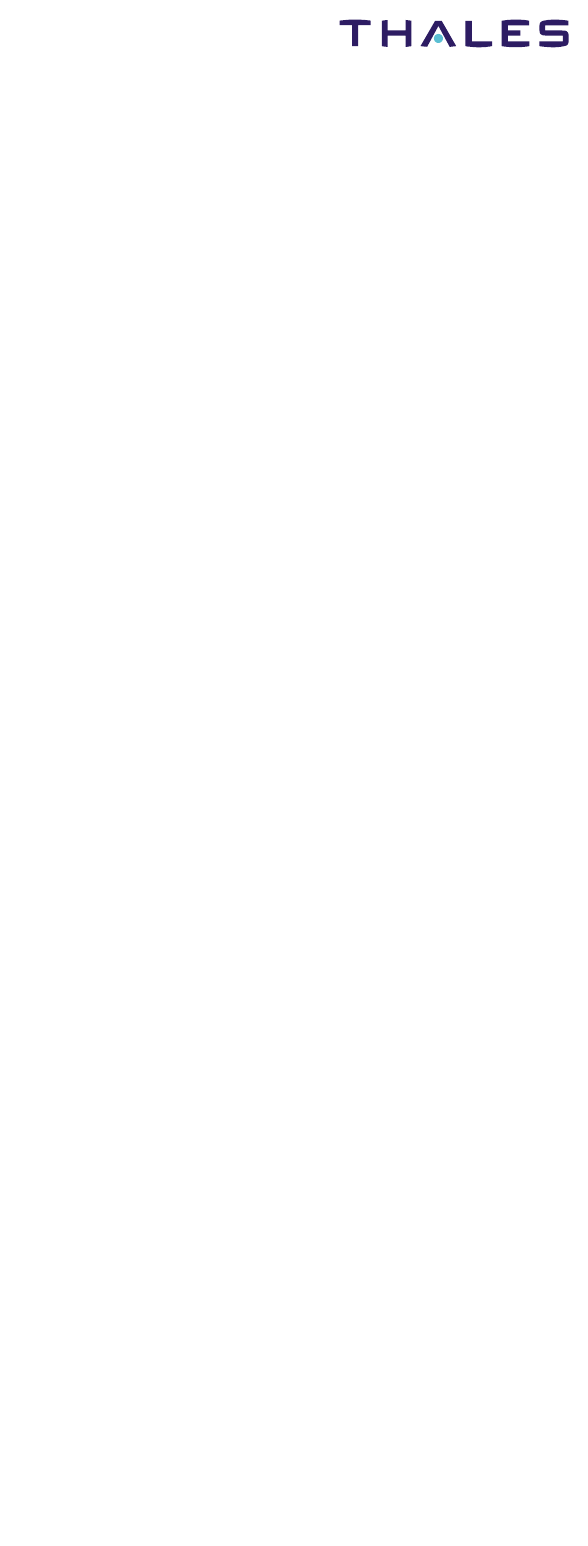
Installation Maintenance Manual
SDU 82155 Series
SCM 82158 Series
3-4
Jun 30/2008
© THALES AVIONICS Ltd. This document and any
information included are the property of Thales Avionics.
They cannot be reproduced, disclosed or utilized without the
company’s prior written approval
3.7. SDU RF CONNECTIONS
CAUTION: DO NOT EXCEED MINIMUM CABLE RADIUS OF CURVATURE
FOR THE COAXIAL CABLE. USE DUMMY CABLES FOR A
FIRST INSTALLATION TO DETERMINE CABLE RUNS. INSTALL
FINAL CABLES AFTER THIS MODELLING OPERATION.
CAUTION: ONLY PREFORMED RF CABLES SHALL BE CONNECTED TO
THE SATCOM SYSTEM EQUIPMENT. ATTEMPTING TO FORM
CABLES OR APPLYING STRESS TO THE CABLES WHILE
THEY ARE CONNECTED TO THE EQUIPMENT CONNECTORS
MAY CAUSE DAMAGE TO THE EQUIPMENT.
The SDU or FMHPA is connected to the DLNA through a RF coaxial cable. Installation
designer must be aware that the shorter the cable is, the better system performance.
As the SDU/DLNA low loss cable is sometimes almost rigid and it could have a
diameter not compatible with the IGA and DLNA connectors, it is recommended to
install a short portion of a smaller and more flexible cable at each end of this low loss
cable (pig tail type installation).
If necessary, secure the cable by means of evenly spaced collars to prevent the cable
from chafing on aircraft parts and surfaces. These collars must be of a design, which
avoids damaging the cable.
NOTE: Interconnect cables should be routed away from sources of potential
electromagnetic interference. Use shielded wires and cables where
necessary.
D. Insertion Losses
The SDU RF interface with the Antenna via a DLNA device. The diplexer and LNA are
combined into one unit for installation. The Diplexer function couples transmit signals
from the SDU to the respective antenna. The LNA amplifies the very low level L-band
receive signal from its respective antenna and couples this amplified signal to the SDU.
For detailed RF insertion losses refer to Section 2 C. To ensure these requirements are
met, some installations need the SDU to be installed in close proximity to the antenna
subsystem components or the use of low loss coaxial cable.
The total loss between the DLNA and the SDU must be in the range 6 to 25 dB. If the
RF cable type being used for a short cable length is less than 6 dB, an attenuator must be
fitted to ensure the required loss is achieved.
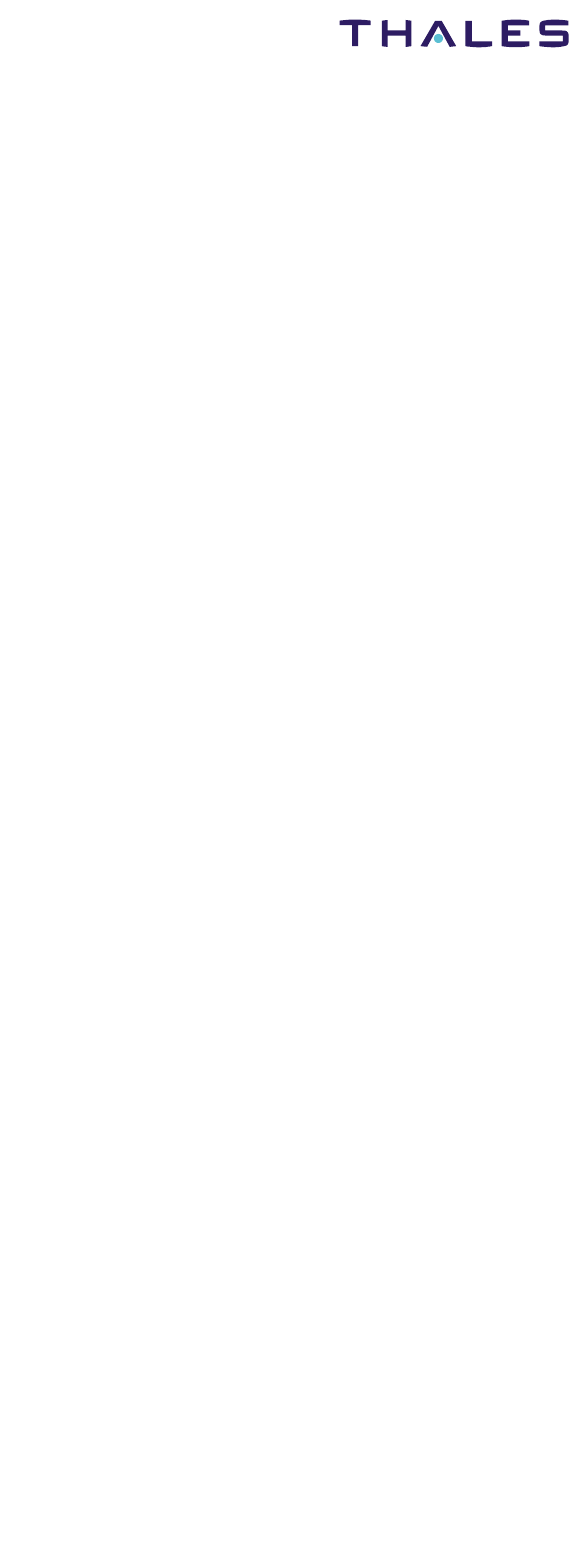
Installation Maintenance Manual
SDU 82155 Series
SCM 82158 Series
3-5
Jun 30/2008
© THALES AVIONICS Ltd. This document and any
information included are the property of Thales Avionics.
They cannot be reproduced, disclosed or utilized without the
company’s prior written approval
E. Product InterModulation (PIM)
Specific care should be taken to ensure that the RF cables and connectors do not produce
intermodulation products at levels higher than those specified in ARINC 781.
F. VSWR
The Voltage Standing Wave Ratio (VSWR) of all RF cables should be 1.2:1 or better.
G. Torque Settings
The cables are to be tightened to the torque settings recommended by the cable
manufacturer.
H. Cleaning
Refer to Section 6.5 for cleaning.
3.8. BONDING REQUIREMENTS
The bonding of all units to the airframe must not exceed 20 milliohms. However some
aircraft manufacturers or design/installation organisation may require a lower value than
the recommended 20 milliohms.
NOTE: To assure proper grounding of the TFS system, the surface of the
mountings and units must be clean bare metal.
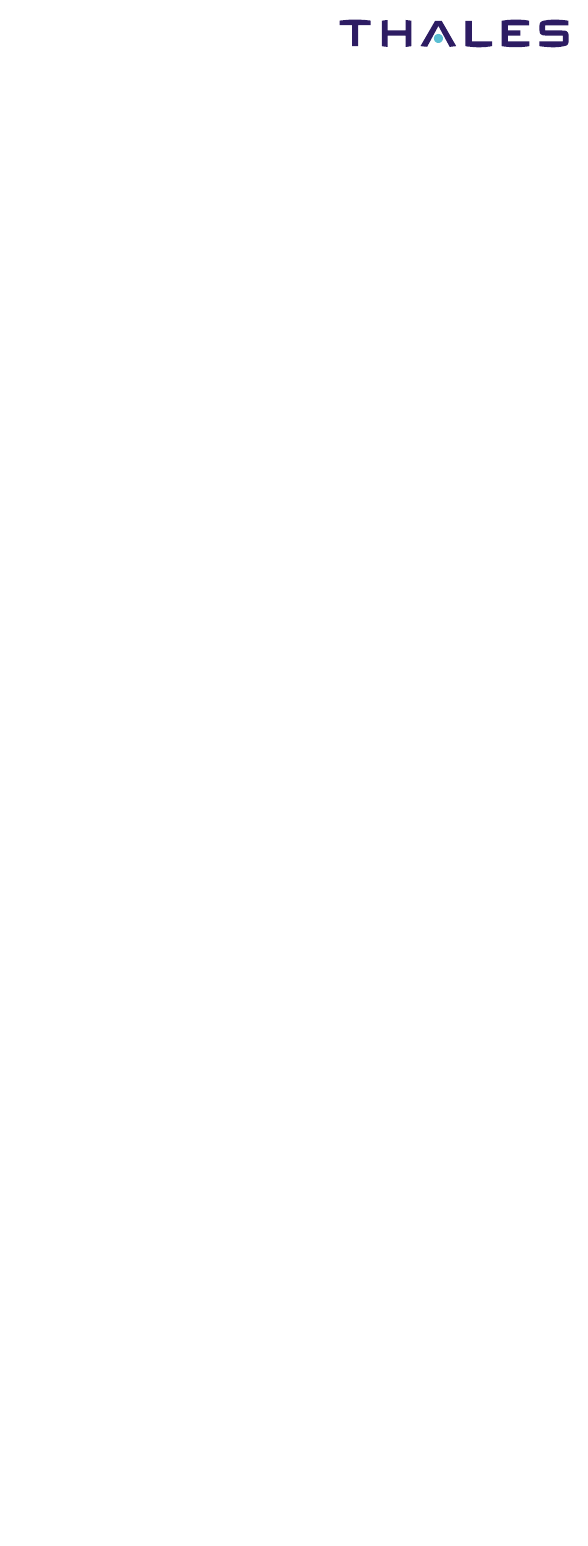
Installation Maintenance Manual
SDU 82155 Series
SCM 82158 Series
3-6
Jun 30/2008
© THALES AVIONICS Ltd. This document and any
information included are the property of Thales Avionics.
They cannot be reproduced, disclosed or utilized without the
company’s prior written approval
THIS PAGE INTENTIONALLY BLANK
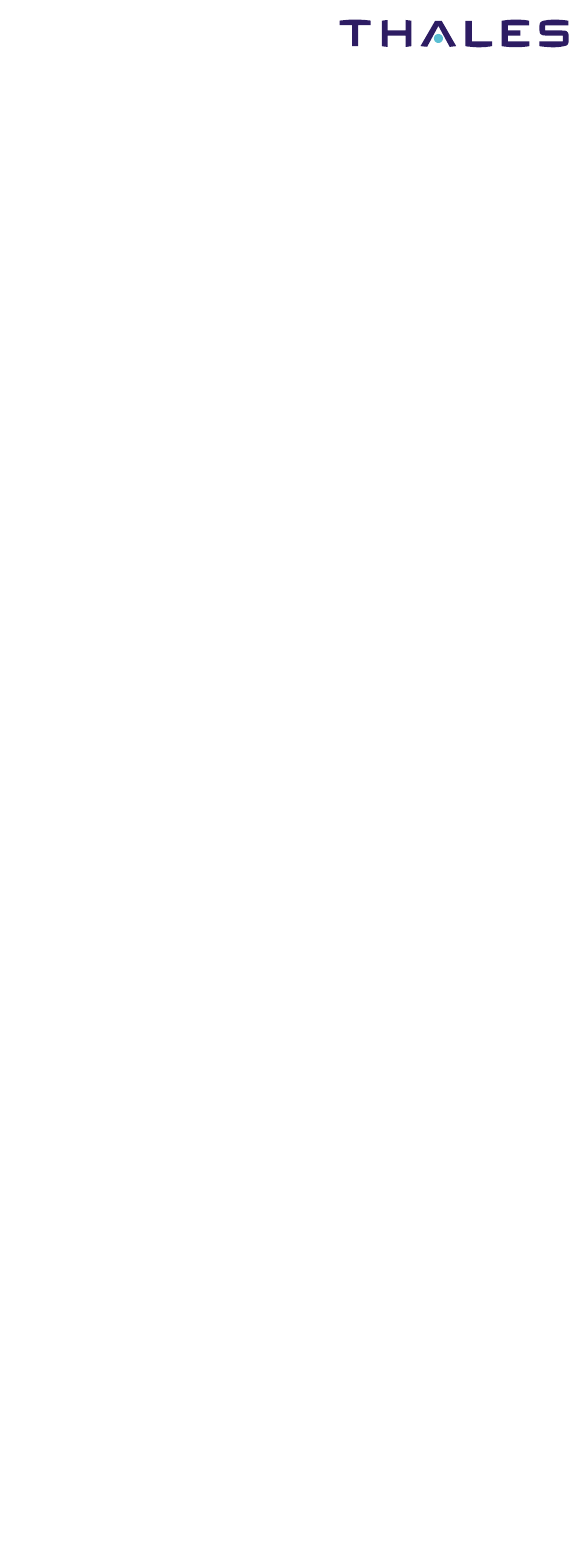
Installation Maintenance Manual
SDU 82155 Series
SCM 82158 Series
4-1
Jun 30/2008
© THALES AVIONICS Ltd. This document and any
information included are the property of Thales Avionics.
They cannot be reproduced, disclosed or utilized without the
company’s prior written approval
SECTION 4
40000INSPECTION AND SYSTEM CHECKOUT
4.1. INSPECTION/CHECK PROCEDURE
The visual check procedures that follow should be performed during or after the SDU/
SCM installation, or as a periodic maintenance inspection check of the installation:
A. Check Wiring and RF cables
a. Ensure that a continuity check of all the installation wiring harness has
been carried out, and that all the sources are correctly rated on the correct
pins.
b. Check that none of the cables have been damaged, and cannot be
damaged by components that are installed later.
c. Check that the cable runs are spaced away from any moving or hot part
that could damage cables when in use.
d. Verify that the various RF cables are within their minimum radius of
curvature tolerances.
e. Check that any attenuators that may have been used for the installation
have not been omitted or mismatched.
B. Check SDU
a. Examine the assembly for external condition (absences of fractures,
dents, deformations, cracks, and/or any other abnormal damage).
b. Visually examine all the external surfaces for possible damage. Check
dust cover and external connector for dust, corrosion or damage.
c. Check that the unit is properly installed and that hold down clamps are
firmly tightened.
d. Check screws and nuts general condition.
e. Check that the contact resistance between the SDU/SCM and a point on
the aircraft structure close to the component does not exceed 20
milliohms.
f. Check that the correct air cooling and air flow is provided to the SDU.
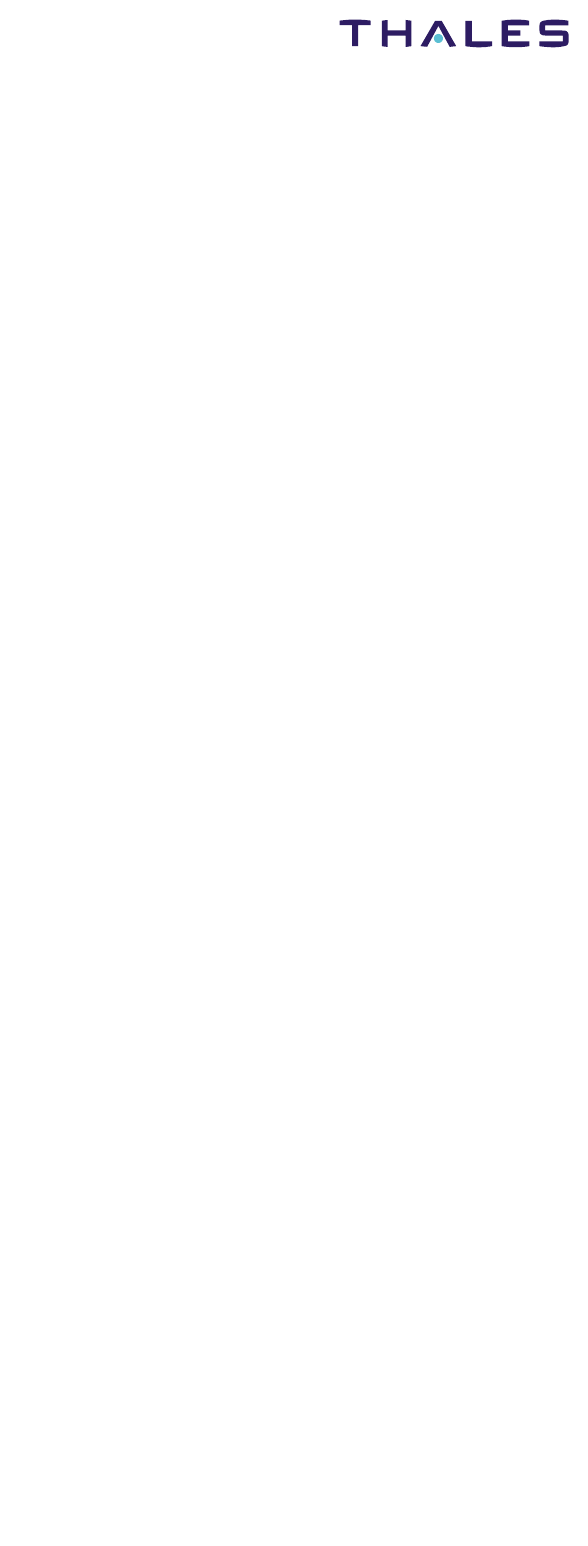
Installation Maintenance Manual
SDU 82155 Series
SCM 82158 Series
4-2
Jun 30/2008
© THALES AVIONICS Ltd. This document and any
information included are the property of Thales Avionics.
They cannot be reproduced, disclosed or utilized without the
company’s prior written approval
C. Check SCM
a. Examine the assembly for external condition (absences of fractures,
dents, deformations, cracks, and/or any other abnormal damage).
b. Visually examine all the external surfaces for possible damage. Check
dust cover and external connector for dust, corrosion or damage.
c. Check that the unit is properly installed, that all fixing screws are firmly
tightened, and the cable to the SDU is secure.
4.2. SYSTEM CHECKOUT
At this stage of the installation it is assumed that a continuity check of the wiring has
been made, a visual check of the installation harness and RF cabling has been performed,
and that the inspection/check procedure has been carried out.
A. Post-Installation Test
WARNING: THE RF POWER RADIATED BY THE TFS SYSTEM ANTENNA
CAN CAUSE BODILY HARM. A PERSON IS IN DANGER IN A
ZONE WHERE THE POWER FLUX IS 1 MW/CM2, OR
GREATER. DURING SATCOM OPERATION THE SAFETY
DISTANCE FROM THE ANTENNA MUST BE NO LESS THAN
3.5M OR 12 FEET. SINCE THERE ARE VARIOUS POSSIBLE
ANTENNA LOCATIONS, IT IS THE RESPONSIBILITY OF THE
OPERATOR TO DETERMINE THE AREA OF HAZARD FOR
THEIR TFS SYSTEM CONFIGURATION AND TO TRAIN
PERSONNEL IN GROUND SAFETY PROCEDURES.
WARNING: DURING ANTENNA OPERATION (TRANSMISSION), MAKE
SURE PERSONNEL ARE NOT EXPOSED TO ANY
REFLECTED, SCATTERED, OR DIRECT BEAMS. ENSURE
PERSONNEL ARE OUTSIDE THE MINIMUM DISTANCE
SPECIFIED.
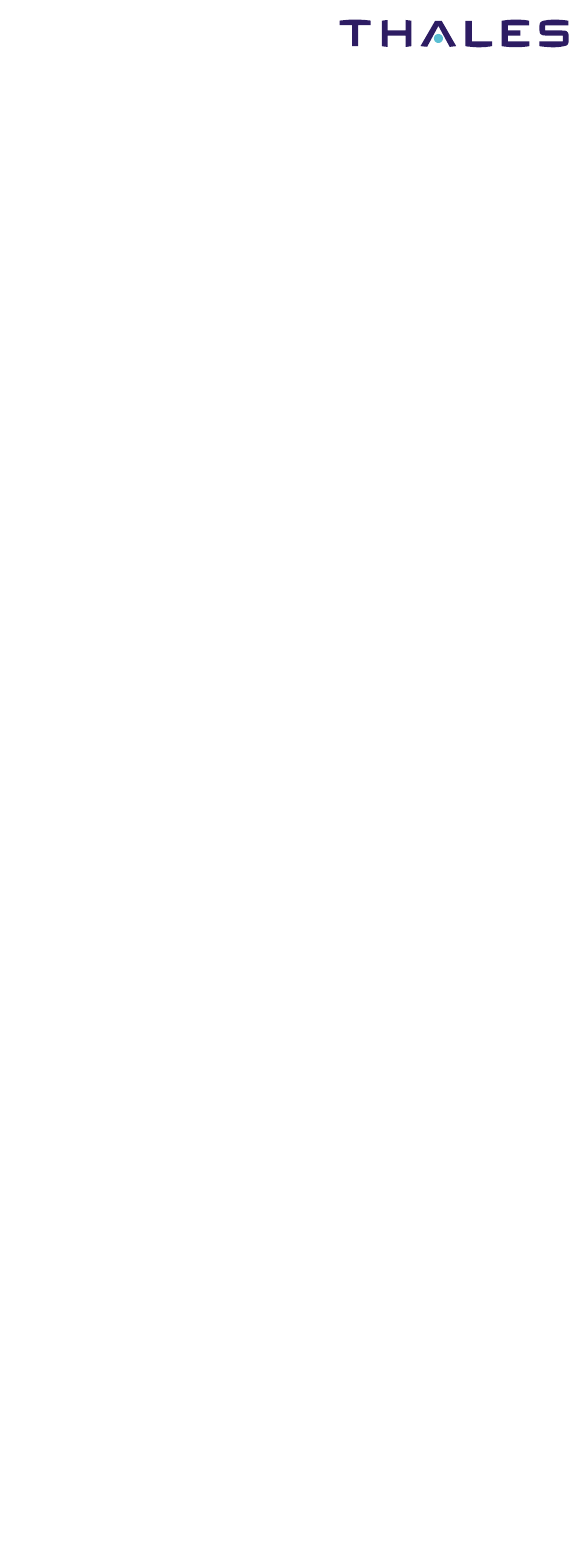
Installation Maintenance Manual
SDU 82155 Series
SCM 82158 Series
4-3
Jun 30/2008
© THALES AVIONICS Ltd. This document and any
information included are the property of Thales Avionics.
They cannot be reproduced, disclosed or utilized without the
company’s prior written approval
CAUTION: WHEN TESTING THE COMPLETE TFS SYSTEM (ANTENNA
SYSTEM INCLUDED) REFER TO THE APPLICABLE ANTENNA
IMM FOR FURTHER SAFETY REQUIREMENTS AND
SPECIFICATIONS. THE SDU MUST NOT BE POWERED
WITHOUT AN ANTENNA OR SUITABLE LOADCONNECTED ON
THE HIGH POWER TRANSMIT OUTPUT PORT.
CAUTION: NEVER CONNECT OR DISCONNECT A SATCOM LRU WHEN
POWER IS APPLIED.
CAUTION: NEVER APPLY HIGH-LEVEL RF SIGNAL TO A POWERED-
DOWN LRU.
CAUTION: NEVER DISCONNECT RF CABLES WHEN SYSTEM
OPERATING.
CAUTION: NEVER POWER-UP ANY LRU UNTIL ALL CONNECTIONS IN
THE SYSTEM ARE MADE.
CAUTION: ENSURE THAT THE APPROPRIATE ORT DATABASE IS
INSTALLED IN THE SCM AND/OR SDU BEFORE PERFORMING
SYSTEM OPERATIONS.
This test requires that all the Satcom system LRUs (SDU, SCM, FMHPA, DLNA,
Antenna and cables) be connected and operating properly, with a means of displaying
any system faults detected by the LRU during the Built-In Test Equipment (BITE) test.
The results of the test are indicated on the SDU front panel LED.
Type 82155D SDU bite is also sent to the CFDS.
If no system faults are indicated by the BITE test, then the subsystem installation should
be considered acceptable. If any subsystem LRU fails the test, it must be returned to the
vendor (refer to your vendor customer support).
Refer to the Section 5 Fault Isolation for information on the SDU fault detection
capabilities.
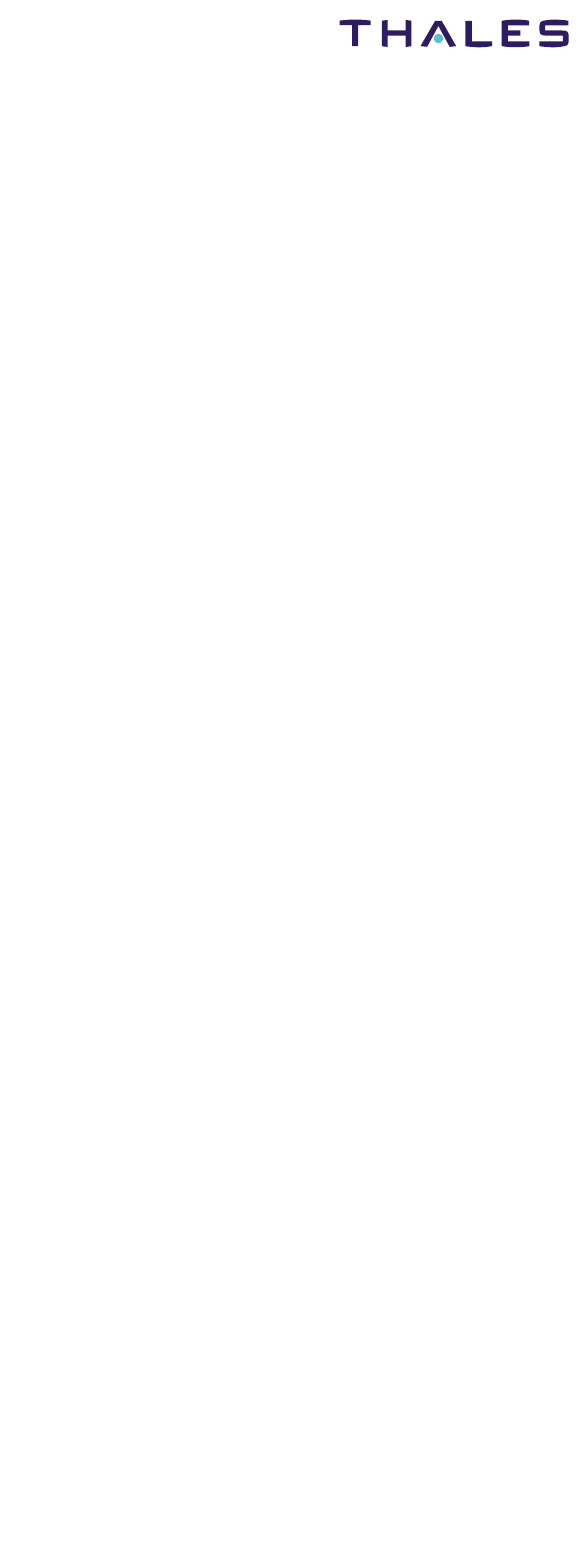
Installation Maintenance Manual
SDU 82155 Series
SCM 82158 Series
4-4
Jun 30/2008
© THALES AVIONICS Ltd. This document and any
information included are the property of Thales Avionics.
They cannot be reproduced, disclosed or utilized without the
company’s prior written approval
THIS PAGE INTENTIONALLY BLANK
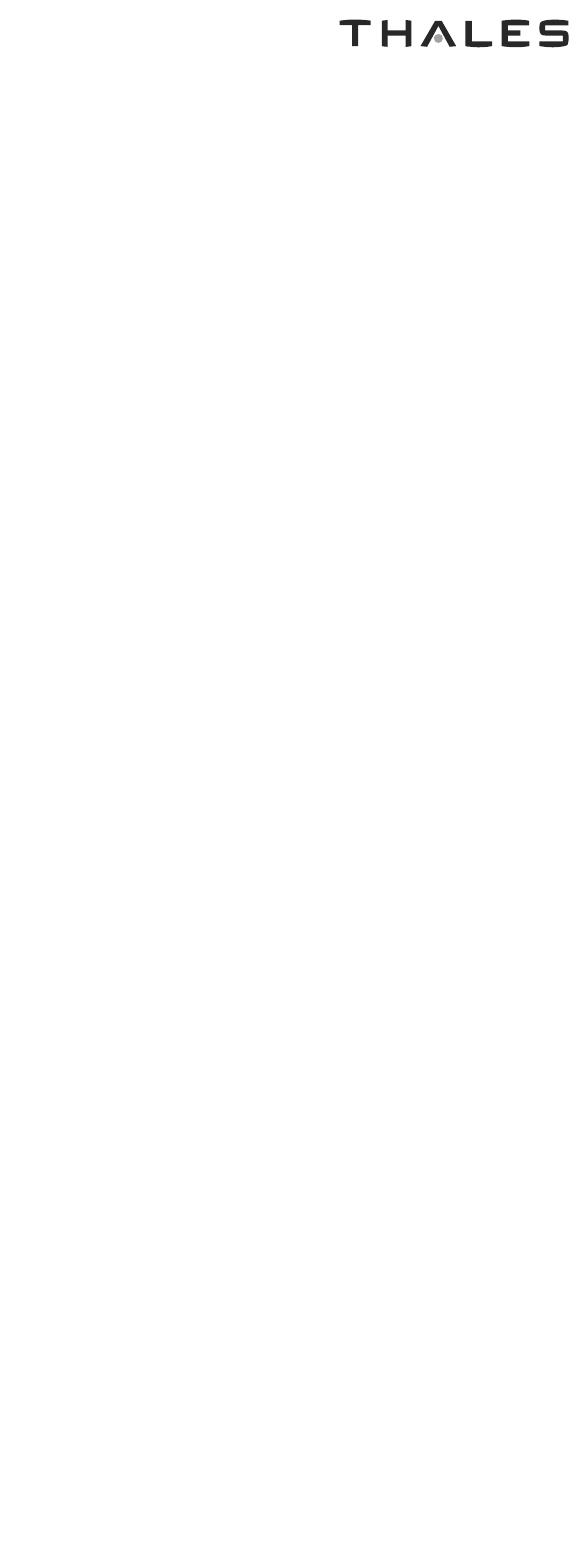
Installation Maintenance Manual
SDU 82155 Series
SCM 82158 Series
5-1
Jun 30/2008
©
THALES AVIONICS Ltd. This document and any
i
nformation included are the property of Thales Avionics.
T
hey cannot be reproduced, disclosed or utilized without the
c
ompany’s prior written approval
SECTION 5
50000FAULT ISOLATION
5.1. BITE FUNCTION
The primary purpose of BITE is to assist aircraft maintenance personnel in the correct
maintenance of avionics equipment in a cost effective manner. The BITE does not
contribute to the required function of the TFS system, but makes it easier to test or debug
it.
The SDU controls the TFS system BITE. It collects BITE information from other LRU,
and can request other LRU to run tests. The BITE automatically detects failures,
providing a mechanism to discover erroneous behaviour of TFS system components.
Fault information is reported to a local maintenance system (e.g. CFDS system or other
OMS), and this information is made available to maintenance personnel by means of
discretes and/or LED on the SDU front panel. Failures can also be reported to a
dedicated local maintenance function through Simple Network Management Protocol
(SNMP) and the Management Information Base (MIB).
The System BITE failure data is stored in the SDU within a Non-Volatile Memory
(NVM) area. The BITE operates at various levels as indicated in Figure 6-1.
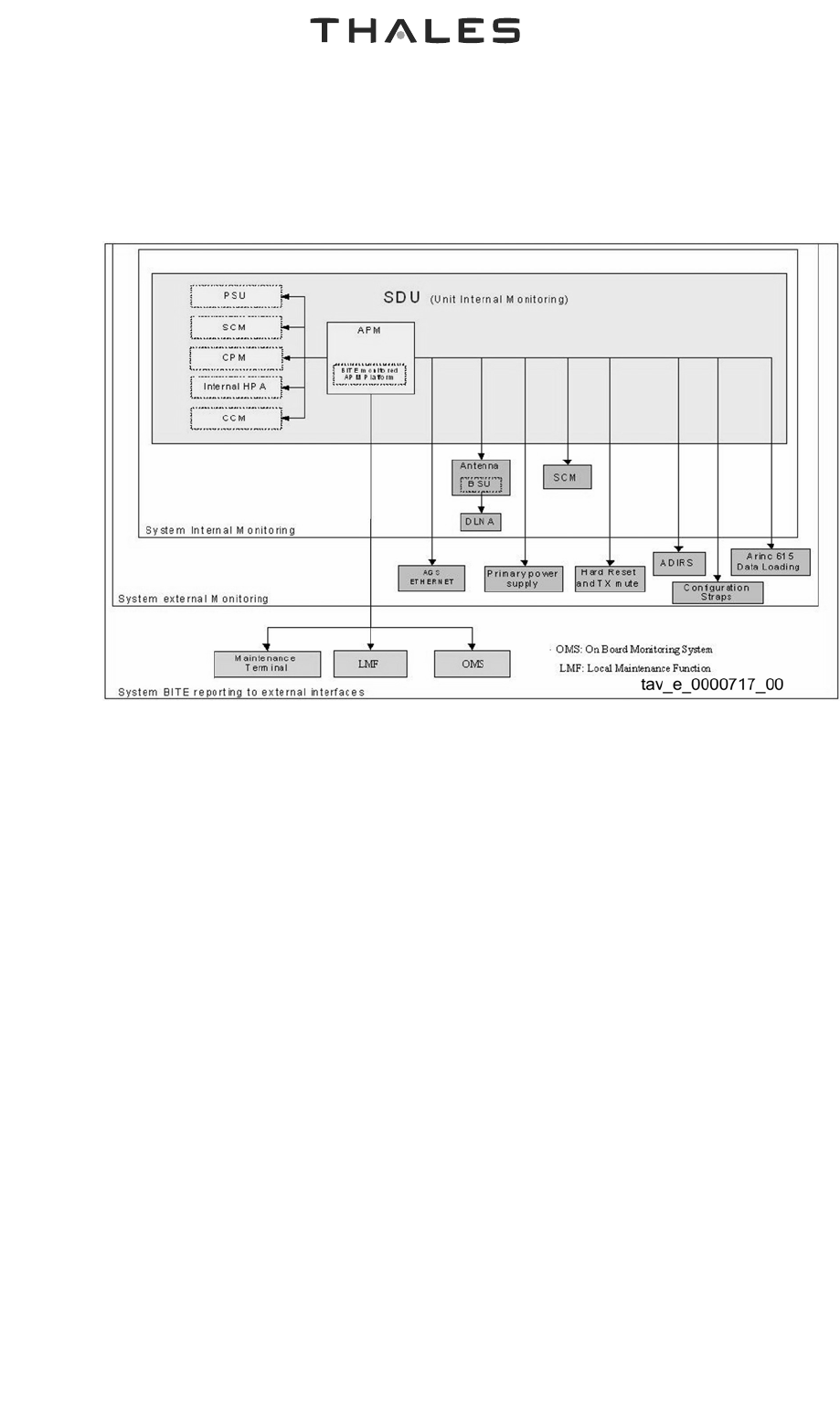
Installation Maintenance Manual
SDU 82155 Series
SCM 82158 Series
5-2
Jun 30/2008
©
THALES AVIONICS Ltd. This document and any
i
nformation included are the property of Thales Avionics.
T
hey cannot be reproduced, disclosed or utilized without the
c
ompany’s prior written approval
5.2. TEST FUNCTIONS
A. OMS or CFDS
Fault information can be displayed from an OMS/CFDS when the aircraft is so
equipped. Faults that occur at anytime are stored in fault memory and reported to the
OMS or CFDS.
B. BITE
An operator can verify the operational serviceability of the SDU and SCM by means of
a set of testing facilities installed within the SDU. The SDU performs two distinctive
types of test:
• A Power-On Self Test (POST) is automatically activated at SDU start
up.
• An Person-Activated Self Test (PAST) can be initiated by an operator by
depressing the Test push button located on the front panel of the SDU,
(see Figure 2-5 item 17). PAST can also be initiated from the CFDS.
Figure 5.1 Example of BITE communication for TFS system
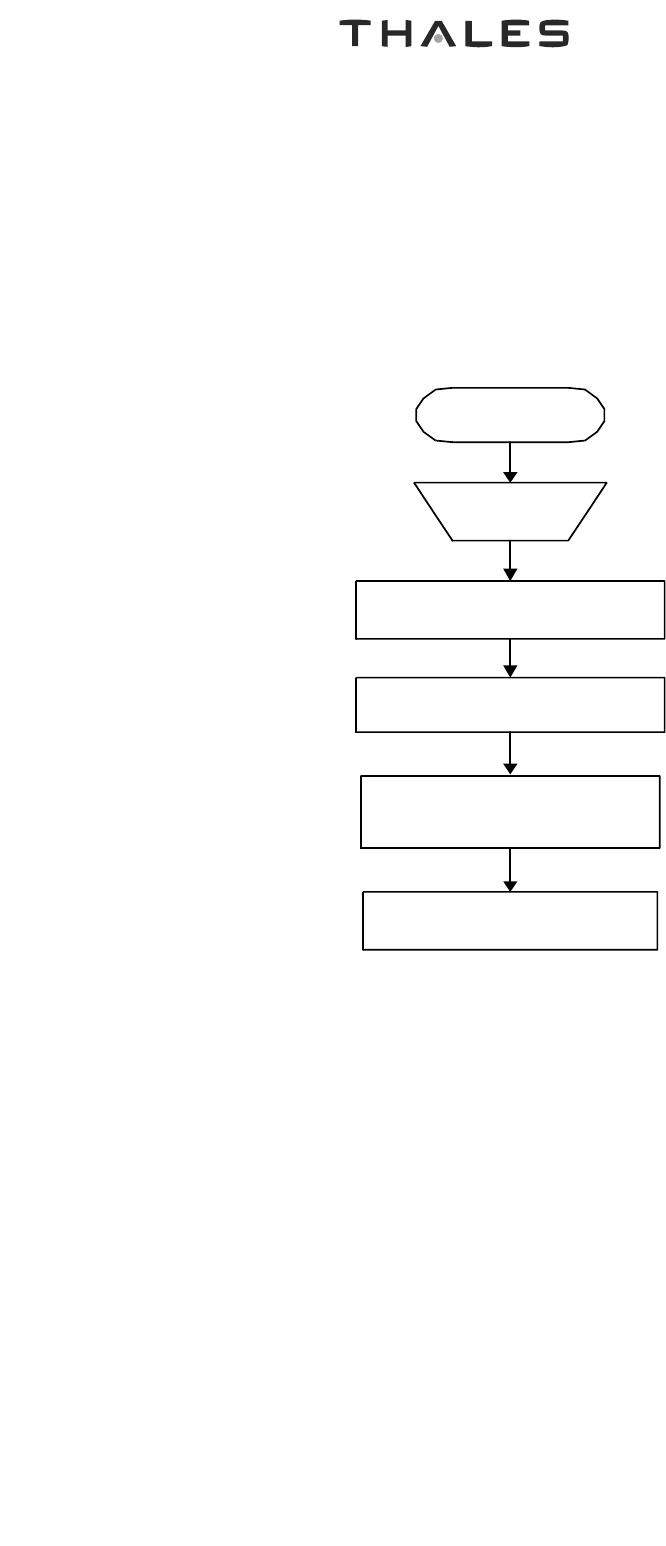
Installation Maintenance Manual
SDU 82155 Series
SCM 82158 Series
5-3
Jun 30/2008
©
THALES AVIONICS Ltd. This document and any
i
nformation included are the property of Thales Avionics.
T
hey cannot be reproduced, disclosed or utilized without the
c
ompany’s prior written approval
(1) POST
At SDU start up (Power On), and with aircraft in the ‘on ground’ condition the Front
Panel LED (FPL) will display the following test sequence:
NOTE: Type 82155D SDU durations are longer, approximately 90 seconds.
Figure 5.2 POST LEDs Sequence
Apply
power
START
All LEDs illuminate Amber for
approximately 90 seconds
LEDs flash Green for
approximately 3-5 seconds (see note)
LEDs remain in Off condition
for the duration of approximately
75 seconds (see note)
LEDs driven to indicate a
Green steady condition
Tav_e_0000716_00
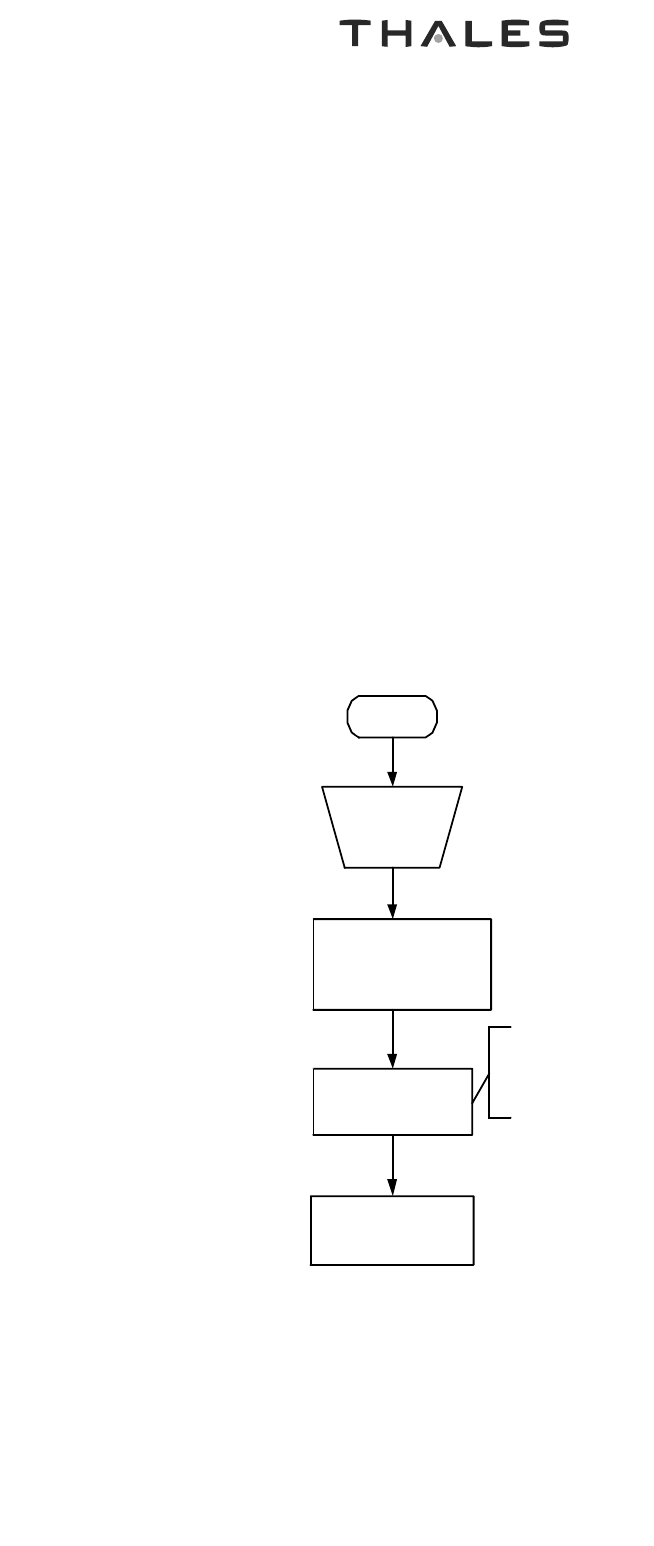
Installation Maintenance Manual
SDU 82155 Series
SCM 82158 Series
5-4
Jun 30/2008
©
THALES AVIONICS Ltd. This document and any
i
nformation included are the property of Thales Avionics.
T
hey cannot be reproduced, disclosed or utilized without the
c
ompany’s prior written approval
(2) PAST
The PAST function is initiated by depressing the front panel TEST Button (This function
is only possible with aircraft on ground). To acknowledge PAST initialisation all the
front panel LED start to flash green at the frequency of 2Hz. After approximately 75
seconds the SDU will transit into Operational Mode with the LED displaying the TFS
system serviceability condition.
This feature represents an interactive, manual test facility, which assists in the following:
• Active search of failures by triggering a series of system diagnostic tests
• Verification testing e.g. after the installation of a replacement unit
• Failure confirmation purpose.
NOTE: PAST can only be initiated after the POST has completed.
Figure 5.3 PAST LEDs Sequence
Push front
panel Test
Button
All LEDs extinguish and
remain in Off condition for
approximately 90 seconds
Start
LEDs flash Green for
3-20 Seconds
LEDs driven to indicate
the Appropriate status
Time variations are
due to ORT
synchronisation
Tav_e_0000715_
00
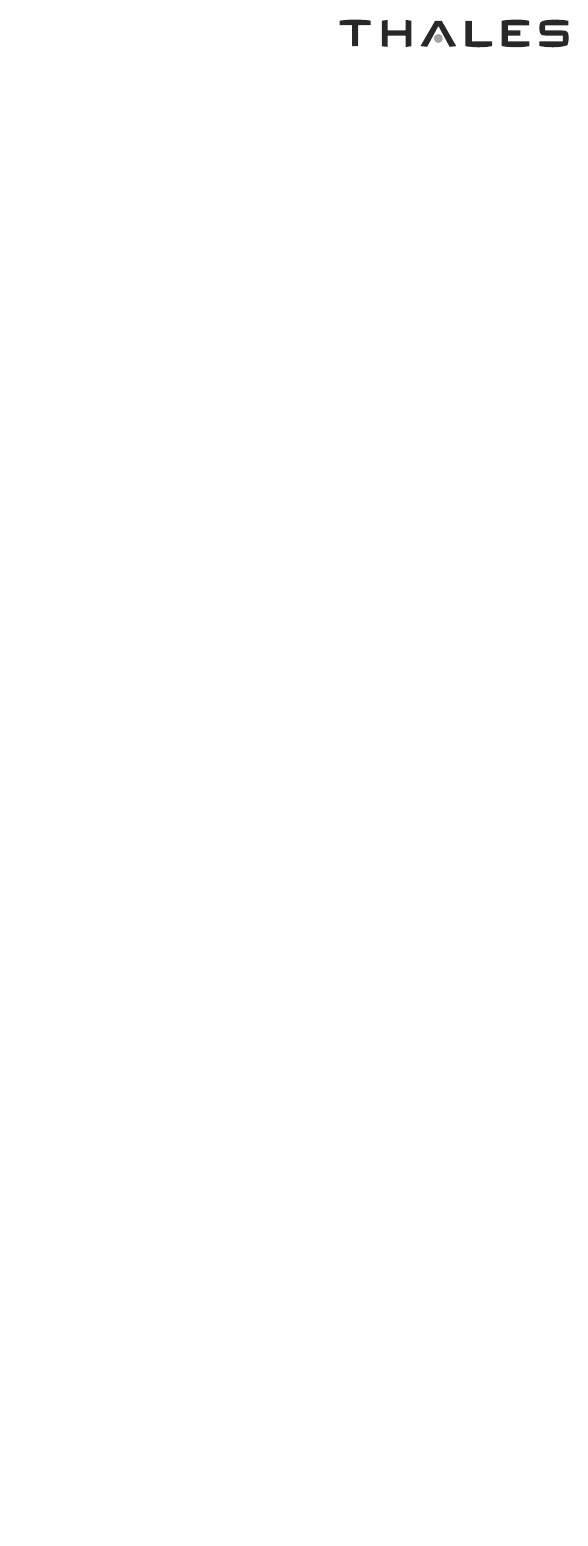
Installation Maintenance Manual
SDU 82155 Series
SCM 82158 Series
5-5
Jun 30/2008
©
THALES AVIONICS Ltd. This document and any
i
nformation included are the property of Thales Avionics.
T
hey cannot be reproduced, disclosed or utilized without the
c
ompany’s prior written approval
5.3. FAULT ISOLATION
A. Failures
Failures are reported to an operator by means of a set of multicoloured LED located on
the SDU front panel. LED can enter the following steady states:
• Normal equipment operation indicated by the relevant LED displayed in
a steady Green condition
• Equipment Hard Failures are indicated by all relevant LED displayed in
a steady Red condition
• Partial equipment failures are indicated by all relevant LED displayed in
a steady Amber condition
• An LED in OFF (extinguished) condition indicates that the relevant
equipment and or a resource is not active or not installed.
NOTE: A fault with an interconnecting cable may prevent an LED from
illuminating.
B. Front Panel Indications
Table 5.1 provides LED status decoding information.
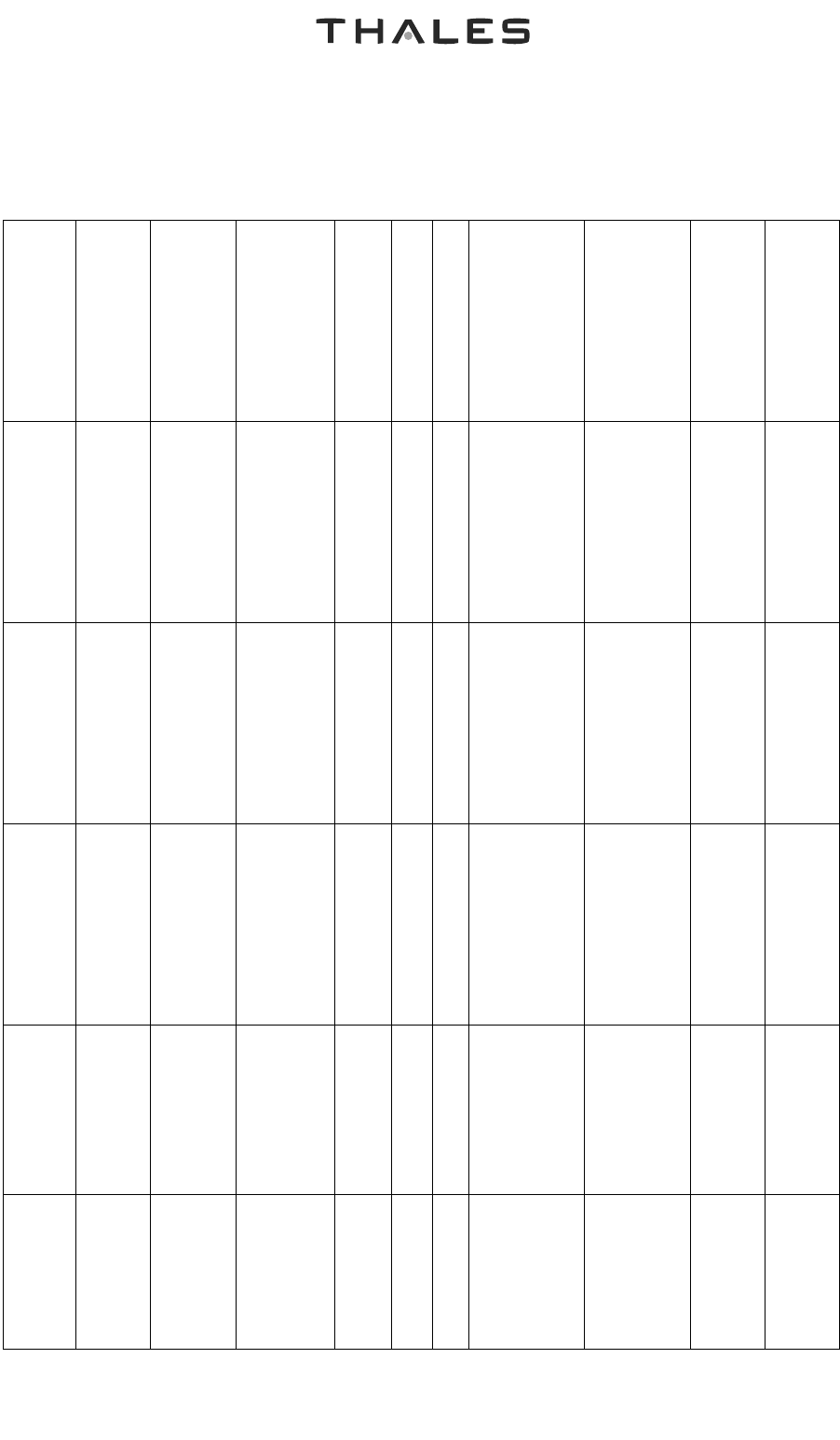
Installation Maintenance Manual
SDU 82155 Series
SCM 82158 Series
5-6
Jun 30/2008
©
THALES AVIONICS Ltd. This document and any
i
nformation included are the property of Thales Avionics.
T
hey cannot be reproduced, disclosed or utilized without the
c
ompany’s prior written approval
Table 5.1 Front Panel Indications
Off
SDU Not Powered
SCM Not Installed or
SDU Not Powered
SDU Not Powered
SDU Not Powered
N/A
N/A
SDU Not Powered
SDU Not Powered
Channel #1 Not attempt-
ing Log-On or
Registation7
Channel #2 Not attempt-
ing Log-On or
Registation7
Red
SDU Failed (Indicted)2
USIM Read/Write Fail.
No attempt at SSB regis-
tration
Antenna Failed (Indicted)2
DLNA Failed (Indicted)2
N/A
N/A
Bus Failed3 (ARINC 429 /
AFDX/RS-422)
ORT Major Failure6 or
Hardware Configuration
Straps Parity Fail-
ure(Indicted)2
N/A
N/A
Amber
Partial Failure (Not
Indicted)1 or ARINC 429/
AFDX /RS-422 Bus
SCM Memory Fail (Not
Indicted)1 or RS-422 Bus
Failure3
Partial Failure (Not
Indicted)1 or ARINC 429
Bus Failure3
N/A
N/A
N/A
Nav Data not available.
ARINC 429 Bus from IRS
inactive or IRS Data
invalid4
ORT Minor Failure5 (Not
Indicted)
Channel #1 attempting
Log-On or Registration
Channel #2 Service avail-
able, ie Logged-On or
Registered
Steady Green
SDU ok
SCM/USIM ok
Antenna ok
DLNA ok
N/A
N/A
All Data Buses (ARINC
429 /AFDX/RS-422) ok
ORT / Hardware Configu-
ration Straps
Channel #1 Service avail-
able, ie Logged-On or
Registered
Channel #2 Service avail-
able, ie Logged-On or
Registered
Flashing Green
SDU in Self-Test
SDU in Self-Test
SDU in Self-Test
SDU in Self-Test
SDU in Self-Test
SDU in Self-Test
SDU in Self-Test
SDU in Self-Test
SDU in Self-Test
SDU in Self-Test
LED
SDU
SCM
Antenna
DLNA
Ext. HPA
Ext. BSU
Ext. Data Bus
ORT/ Config.
Sat. Link #1
Sat.Link #2
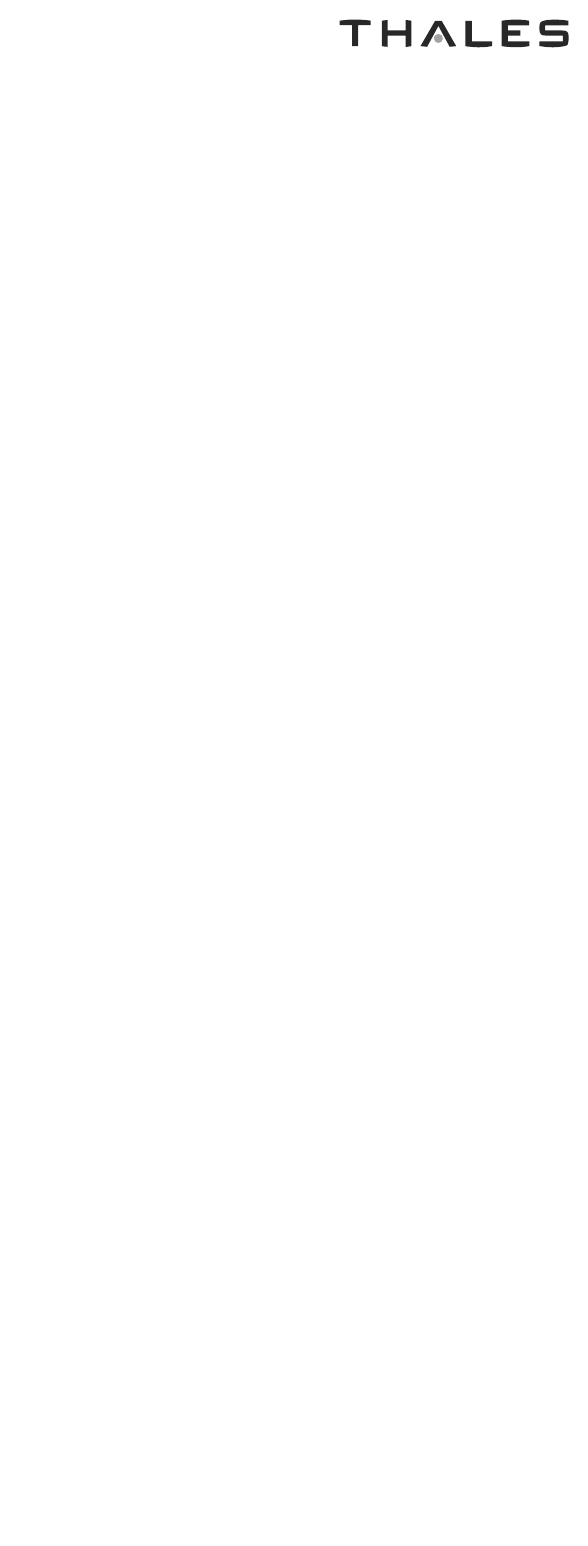
Installation Maintenance Manual
SDU 82155 Series
SCM 82158 Series
5-7
Jun 30/2008
©
THALES AVIONICS Ltd. This document and any
i
nformation included are the property of Thales Avionics.
T
hey cannot be reproduced, disclosed or utilized without the
c
ompany’s prior written approval
List of Explanatory Notes for Table 5.1:
1. Not Indicted means that there is an equipment ‘partial’ failure such that
service Registration / Log-On is still attempted.
2. Indicted means that there is an equipment failure such that Registration
/ Log-On is not attempted.
3. In the event of a Bus Inactive Failure, the ‘Data Bus’ LED illuminates
Red and the appropriate LRU status LEDs illuminate Amber, e.g. if the
SDU reports that the Antenna to SDU bus is inactive or the Antenna
reports that the SDU to Antenna bus is inactive, then the ‘Data Bus’ LED
illuminates Red and the SDU and Antenna LED illuminates Amber
4. This is a special case. There will be frequent legitimate occurrences of
IRS being switched off whilst On-Ground and even after an IRS is
switched on; there is an alignment period, during which the Nav Data is
invalid. Under these circumstances, the only action is to illuminate the
‘Data Bus’ LED Amber, irrespective of whether in On-Ground or In-Air
state
5. The ORT/Configuration LED illuminate Amber in the following
circumstances:
- Type 1 ORT Synchronization Minor Failure – Secure ORT within SCM
- If the Secure ORT read from the SCM is not valid and if ‘local copy’
Secure ORT is valid.
- Type 4 ORT Synchronization Failure - User ORT within SCM - If the
User ORT read from the SCM is not valid AND if ‘local copy’ User ORT
is valid.
- Type 5 ORT Synchronization Failure - User ORT in SDU - if SDU User
ORT is invalid.
6. The ORT/Configuration LED illuminates Red in the following
circumstances:
- Type 1 ORT Synchronization Major Failure - Secure ORT within SCM
- If the Secure ORT read from the SCM is not valid AND if ‘local copy’
Secure ORT is not valid
- Type 2 ORT Synchronization
- Type 3 ORT Synchronization Failure - Secure ORT in SDU that is
integral part of SW - if SDU Secure ORT is invalid.
- Hardware Straps Parity Failure. SDU be indicted.
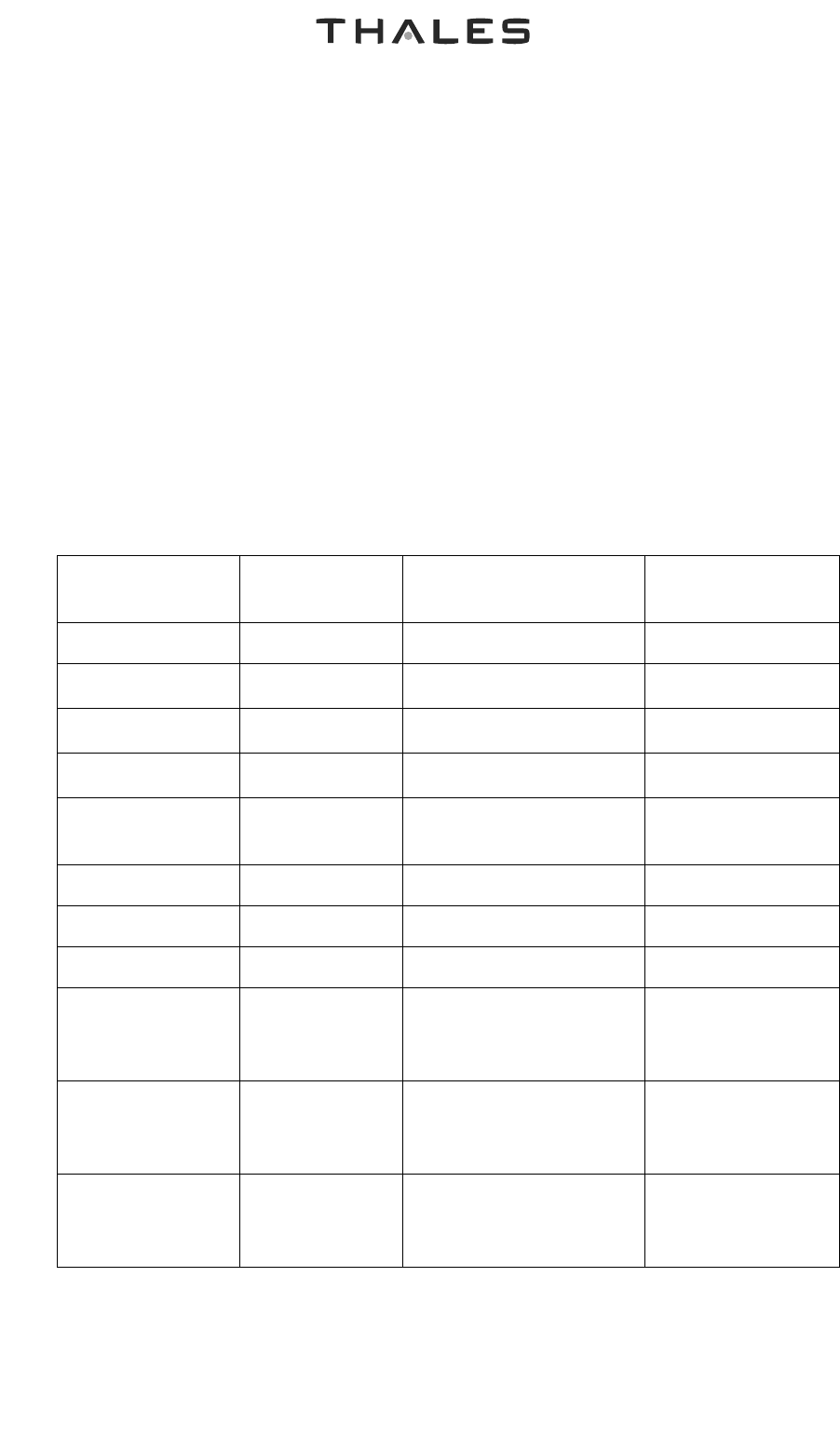
Installation Maintenance Manual
SDU 82155 Series
SCM 82158 Series
5-8
Jun 30/2008
©
THALES AVIONICS Ltd. This document and any
i
nformation included are the property of Thales Avionics.
T
hey cannot be reproduced, disclosed or utilized without the
c
ompany’s prior written approval
7. There are many reasons why a channel will not attempt Log-On or
Registration, including (but not limited to), OCXO warming up,
equipment indictment, commanded Log-Off or De-Registration.
C. Fault Logging
All information of degraded and abnormal equipment function will be logged internally
and made available to a dedicated local maintenance system (e.g. CFDS).
D. Service Availability Discretes
The status of various system functions can be reported by means of the Service
Availability Discretes available on the ARINC 600 connector.
Table 5.2 SDU Serviceability Discretes
Function Pin Allocation Steady State Open
Circuit Steady Ground1
SDU MP 15F SDU Powered SDU Not Powered
System Failed MP 11F System ok System Failed2
SDU Failed MP 12E SDU ok SDU Failed3
SCM Failed MP 12F SCM ok or not installed SCM Failed4
Ext. HPA Failed MP 13E Ext. HPA ok or not
installed Ext. HPA Failed
DLNA Failed MP 13F DLNA ok DLNA Failed
Antenna Failed MP 14E Antenna ok Antenna Failed
Ext. BSU Failed MP 14F BSU ok or not installed BSU Failed
BUS Failed5MP 15E All external data buses
ok (ARINC 429/AFDX/
RS422)
Bus Failed
(ARINC 429/
AFDX/RS422)
Sat Link #1 Not
available MP 11E Satcom Channel #1
Logged On/Registered Satcom Channel
#1 Not Logged On/
Not Registered
Sat Link #2 Not
available TP 01K Satcom Channel #2
Logged On/Registered Satcom Channel
#2 Not Logged On/
Not Registered
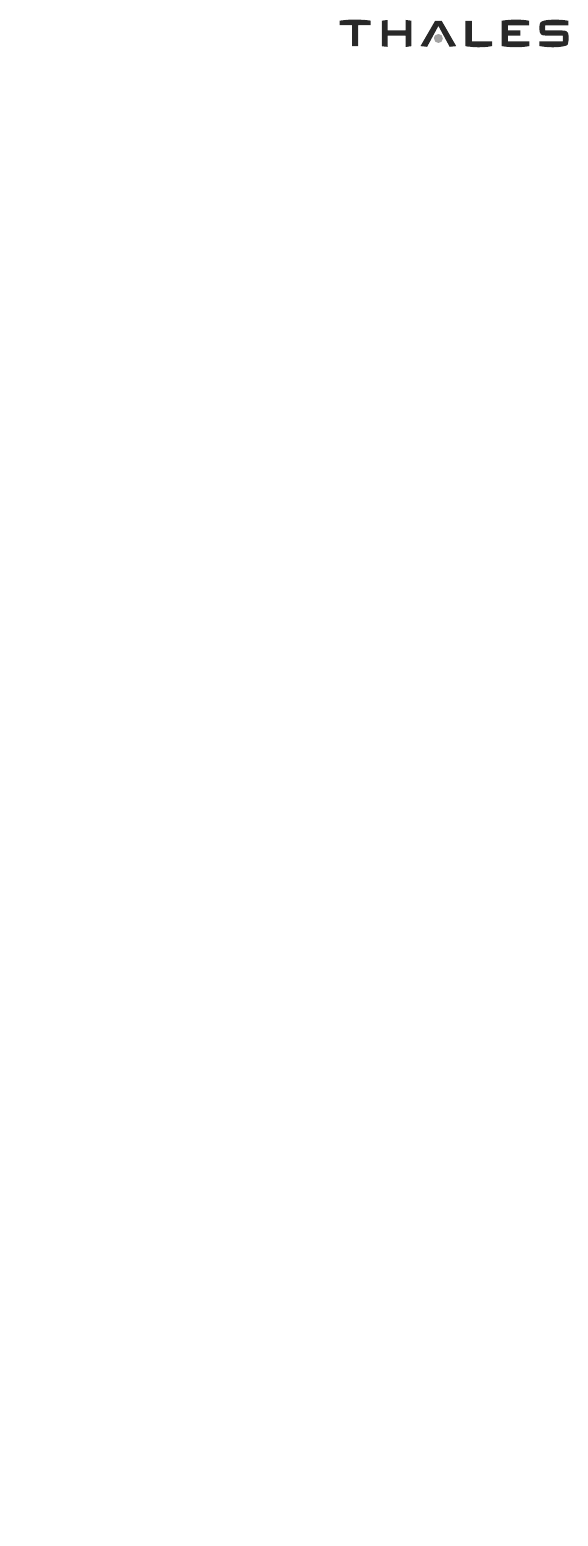
Installation Maintenance Manual
SDU 82155 Series
SCM 82158 Series
5-9
Jun 30/2008
©
THALES AVIONICS Ltd. This document and any
i
nformation included are the property of Thales Avionics.
T
hey cannot be reproduced, disclosed or utilized without the
c
ompany’s prior written approval
List of Explanatory Notes for Table 5.2:
1. The ‘Steady Ground’ state corresponds to the equivalent LED Red state,
except for the Sat Link #1 and #2 Not Available discretes, for which the
‘Steady Ground’ state corresponds to the equivalent LED Off or Amber
states.
2. The System Failed discrete ‘Steady Ground’ state corresponds to one or
more LEDs being illuminated red.
3. SDU Failed discrete only to be asserted in the event that an SDU H/W or
S/w failure is detected, not in the event that there is an ORT or
configuration straps parity failure. In the latter case, only the System
Failed discrete should be asserted.
4. SCM Failed discrete only to be asserted in the event that an SCM H/W
failure is detected, not in the event that there is an ORT failure. In the
latter case, only the System Failed discrete should be asserted.
5. The Bus Failed discrete provides no indication of activity on the
Ethernet buses.
E. Service Availability Discrete Lamps
The Service Availability Discretes have open circuit and ground states that are capable
of driving incandescent lamps connected to an external supply.
Typically, each discrete is fed via one or two (in parallel) incandescent lamps to an
aircraft 28 Vdc supply. This 28 Vdc supply can be dimmed to approximately 14 Vdc for
night time operation. The 28 Vdc is a nominal value and can vary as defined in RTCA/
DO-160E A typical incandescent lamp would be 28Vdc, 20mA.
Each Service Availability Discrete is able to continuously sink at least 50mA and be
capable of holding a cold inrush current of up to 490mA during the first 10 millisecond
of activation as per ARINC 781.
F. CFDS/ARINC 604 BITE
The SDU reports BITE status and faults to the CFDS using ARINC 429, 350 series
words.
The SDU software can raise a fault, a fault may or may not indict a particular Resource,
many detailed faults may indict a single resource.
Resources also have a hierachy defined, so a tier 1 resource may ripple up to a tier 2
resource, and so on. Faults typically indict a tier 1 resource. An example of tier 1
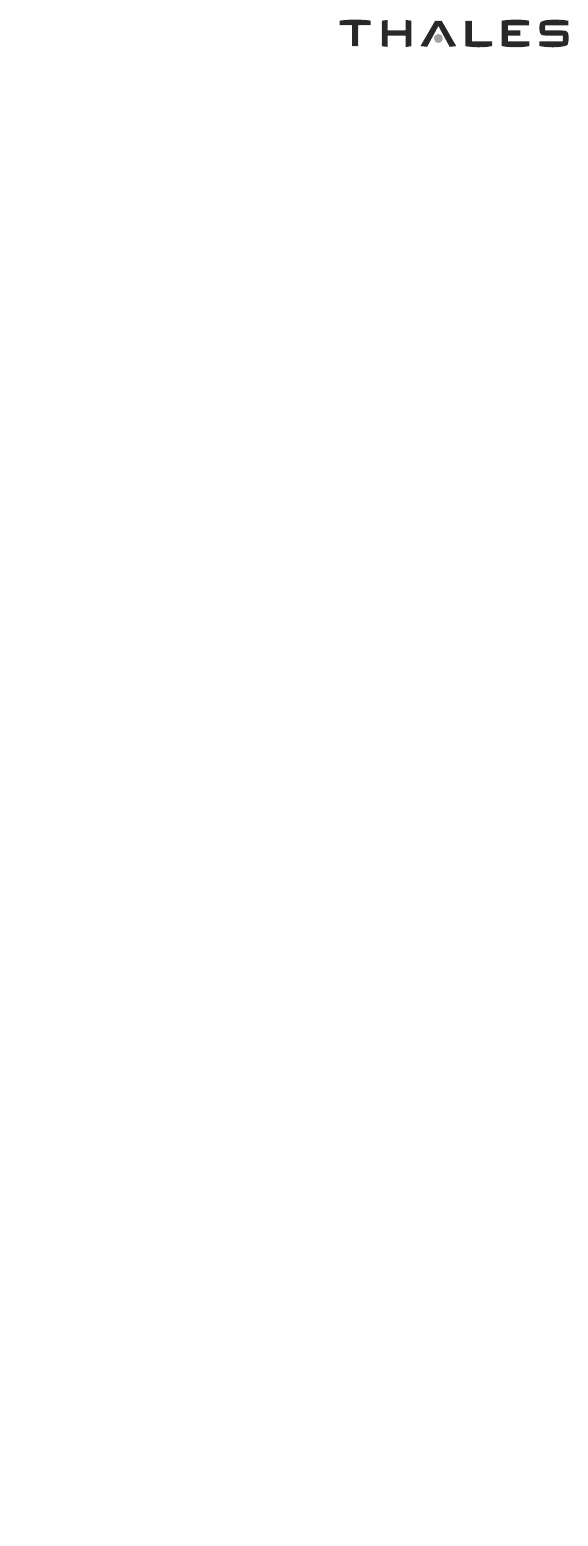
Installation Maintenance Manual
SDU 82155 Series
SCM 82158 Series
5-10
Jun 30/2008
©
THALES AVIONICS Ltd. This document and any
i
nformation included are the property of Thales Avionics.
T
hey cannot be reproduced, disclosed or utilized without the
c
ompany’s prior written approval
resource might be ethernet Port1 (there are 4 in total), there also may be a tier 2 resorce
that represents the state of all tier 1 ethernet ports.
The status of the ARINC 429, 350 series of labels are driven by the resources. If a
particular resource is indicted, then it may have a consequential impact on one or more
Bits in the 350 words.
Refer to ARINC 781 Attachment 2B for a definition of all the 350 words and the
definition of each Bit within the words.
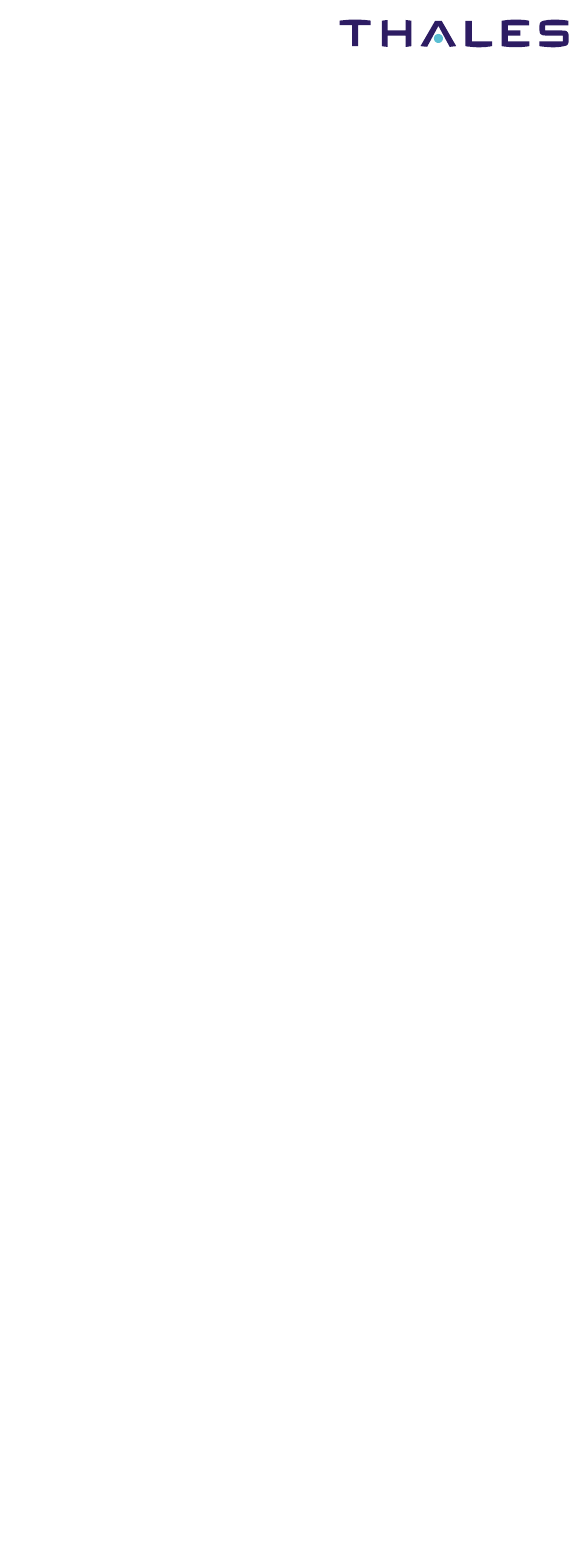
Installation Maintenance Manual
SDU 82155 Series
SCM 82158 Series
6-1
Jun 30/2008
© THALES AVIONICS Ltd. This document and any
information included are the property of Thales Avionics.
They cannot be reproduced, disclosed or utilized without the
company’s prior written approval
SECTION 6
60000MAINTENANCE PRACTICES
6.1. GENERAL
This section provides instructions for the removing, reinstalling and adjusting of the
SDU and SCM that has been previously installed by the aircraft manufacturer or
completion center.
CAUTION: TO AVOID INJURY TO PERSONNEL OR DAMAGE TO
EQUIPMENT, ENSURE ADEQUATE PRECAUTIONS ARE
TAKEN WHILE PERFORMING ANY WORK IF THE ELECTRICAL
POWER IS APPLIED TO THE LRU.
CAUTION: TO PREVENT DAMAGE TO EQUIPMENT, TURN AIRCRAFT
POWER OFF BEFORE REMOVING OR INSTALLING LRU.
Field lubrication or other maintenance procedures are not required. The design of the
SDU and SCM is such that they do not require field maintenance to maintain
airworthiness. If functional problems occur, the SDU Built-in Test Equipment (BITE)
capability identifies the faulty LRU. The SDU and SCM maintenance is limited to
replacement on verified failure.
6.2. EQUIPMENT AND MATERIALS
CAUTION: BEFORE YOU USE A MATERIAL, REFER TO THE
MANUFACTURERS‚ MATERIAL SAFETY DATA SHEETS FOR
SAFETY INFORMATION. SOME MATERIALS CAN BE
DANGEROUS.
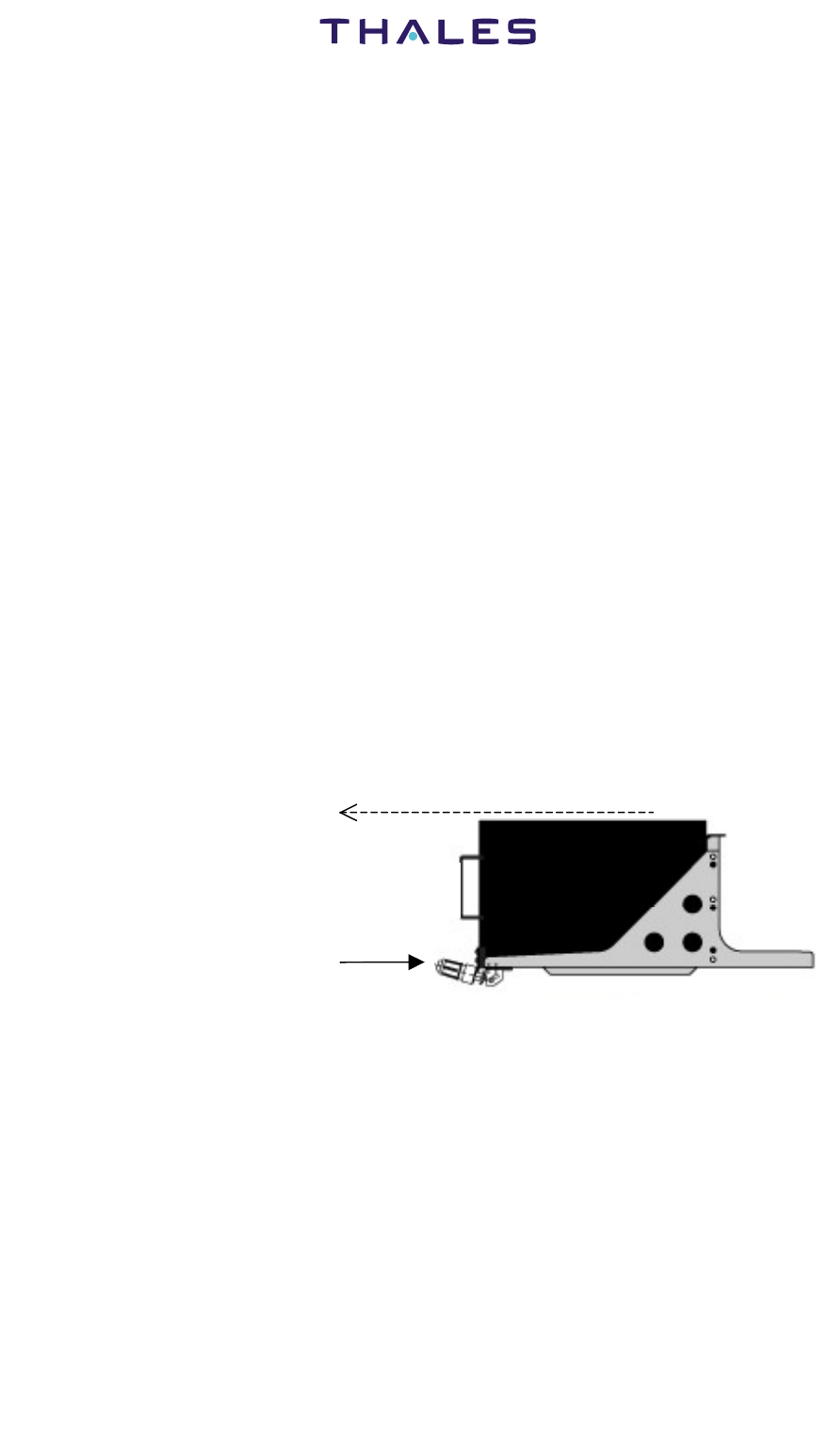
Installation Maintenance Manual
SDU 82155 Series
SCM 82158 Series
6-2
Jun 30/2008
© THALES AVIONICS Ltd. This document and any
information included are the property of Thales Avionics.
They cannot be reproduced, disclosed or utilized without the
company’s prior written approval
6.3. PROCEDURE FOR THE SDU
CAUTION: THE SDU IS ELECTROSTATIC DISCHARGE SENSITIVE
EQUIPMENT. OBSERVE STANDARD ESD PROCEDURES
WHEN HANDLING THE EQUIPMENT.
A. Removal and Installation Procedure
(1) Remove the SDU
a. Ensure that electrical supply to the SDU is switched off.
b. Loosen mounting tray Hold Down Clamps (counter clockwise). Ensure
that the Hold Down Clamps are loosened so that the SDU is uniformly
extracted out of the mounting tray back connector. Clear the retaining
hooks on the front of the SDU.
c. Separate the SDU from the mounting tray back connector and extract the
SDU by pulling on the carrying handle at the front of the SDU.
d. Visually check the SDU ARINC 600 connector and then install an ESD
protection cap on the SDU ARINC 600 back connector.
Figure 6.1 SDU Removal from ARINC 600 Mounting Tray
Tav_e_0000722_00
SDU
removal direction
Hold Down Clamps
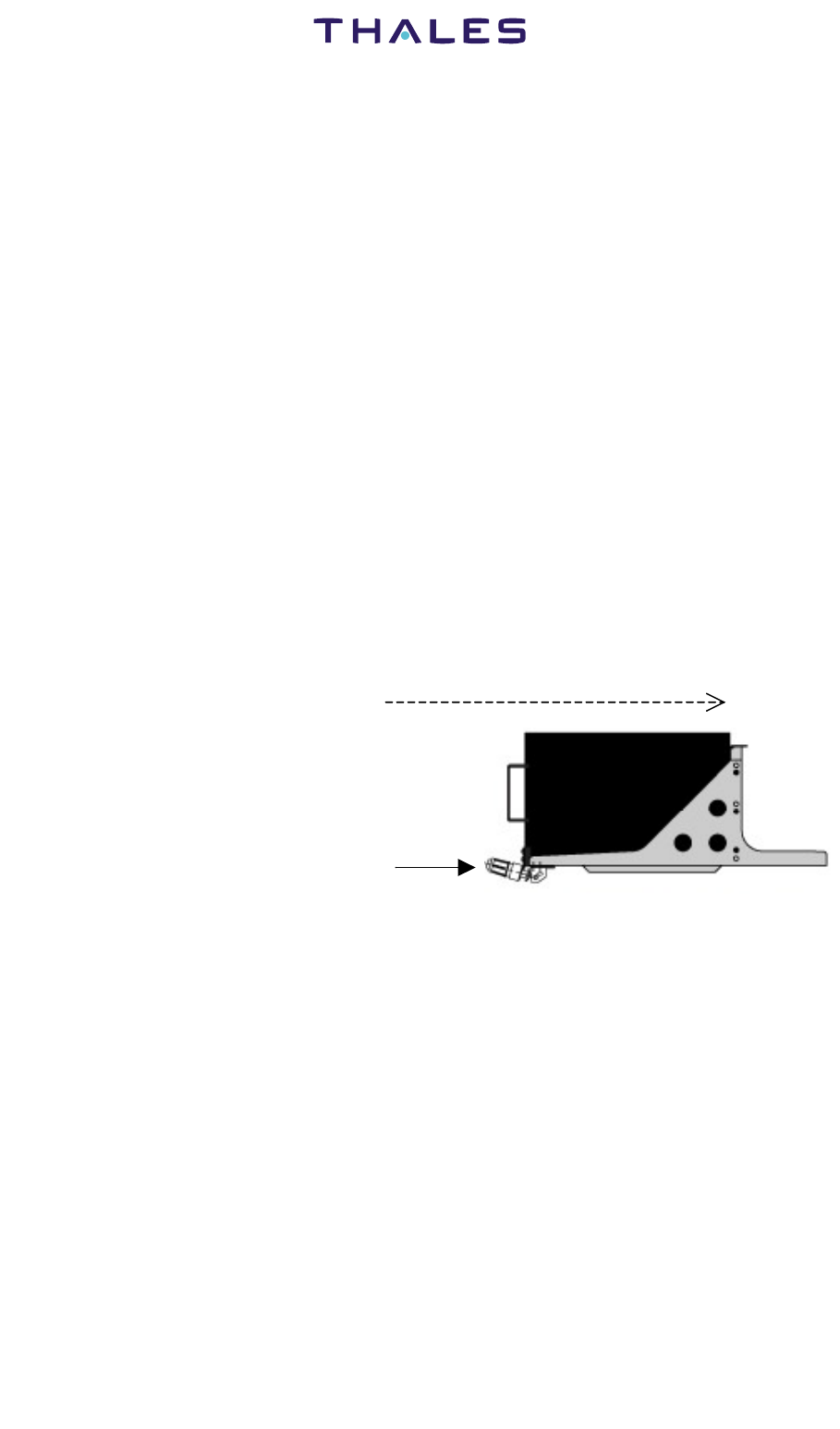
Installation Maintenance Manual
SDU 82155 Series
SCM 82158 Series
6-3
Jun 30/2008
© THALES AVIONICS Ltd. This document and any
information included are the property of Thales Avionics.
They cannot be reproduced, disclosed or utilized without the
company’s prior written approval
(2) Install the SDU
a. Remove ESD protective cap from the SDU ARINC 600 back connector.
b. Carefully place the SDU on its mounting tray and slide it towards the
mounting tray back connector.
c. When the SDU is fully engaged into the connector raise the mounting
tray Hold Down Clamps over the hooks of the SDU and hand tight in the
clockwise direction.
d. As the LRU is tightened into position, and in order to prevent electrical
pins from bending, ensure that the SDU is uniformly inserted into the
mounting tray back connector.
CAUTION: ENSURE THAT THE THUMBSCREW HOLD DOWN CLAMPS
ARE FASTENED, AND THAT THE LRU IS SECURELY HELD IN
PLACE.
B. Adjustment Procedure
Not Applicable.
C. Repair Procedure
Not Applicable.
D. Return to Service Procedures
Do the Post-Installation Test Procedures referenced in the Inspection and System
Checkout Section of this manual.
Figure 6.2 SDU Installation on to ARINC 600 Mounting Tray
SDU
installation direction
Hold Down Clamps
Tav
_
e
_
0000721
_
00
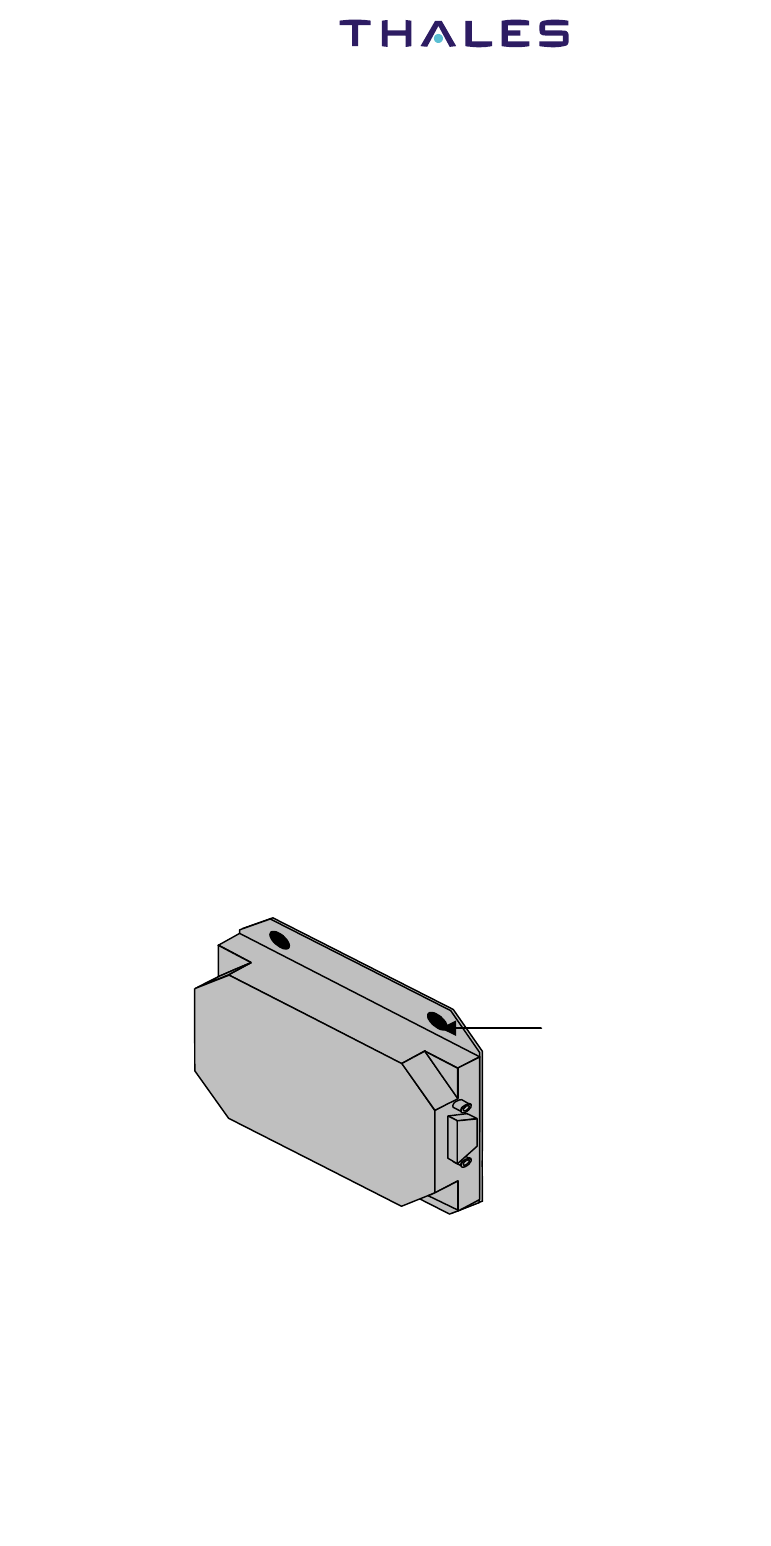
Installation Maintenance Manual
SDU 82155 Series
SCM 82158 Series
6-4
Jun 30/2008
© THALES AVIONICS Ltd. This document and any
information included are the property of Thales Avionics.
They cannot be reproduced, disclosed or utilized without the
company’s prior written approval
6.4. PROCEDURE FOR THE SCM
CAUTION: THE SCM IS ELECTROSTATIC DISCHARGE SENSITIVE
EQUIPMENT. OBSERVE STANDARD ESD PROCEDURES
WHEN HANDLING THE EQUIPMENT.
A. Removal and Installation Procedure
(1) Remove the SCM
a. Ensure that electrical supply to the SCM is switched off (switch off the
SDU).
b. Loosen the two (2) screw locks that secure the 15-pin D Type connector
to the SCM.
c. Disconnect the D connector. Bag and stow the cable as required.
d. Install an ESD protection cap on the SCM D Type connector.
e. Assuming that the mounting fixture is equipped with anchor nuts, loosen
and remove the four fixings screws that retain the SCM to its mounting
fixture while supporting the SCM. Retain the screws for future
installation.
f. Remove the SCM, and visually inspect it for any signs of damage
(2) Install the SCM
a. Remove the ESD protection cap on the D Type connector.
Figure 6.3 SCM Removal
Fixing Screws (4 off)
Tav_e_0000719_00
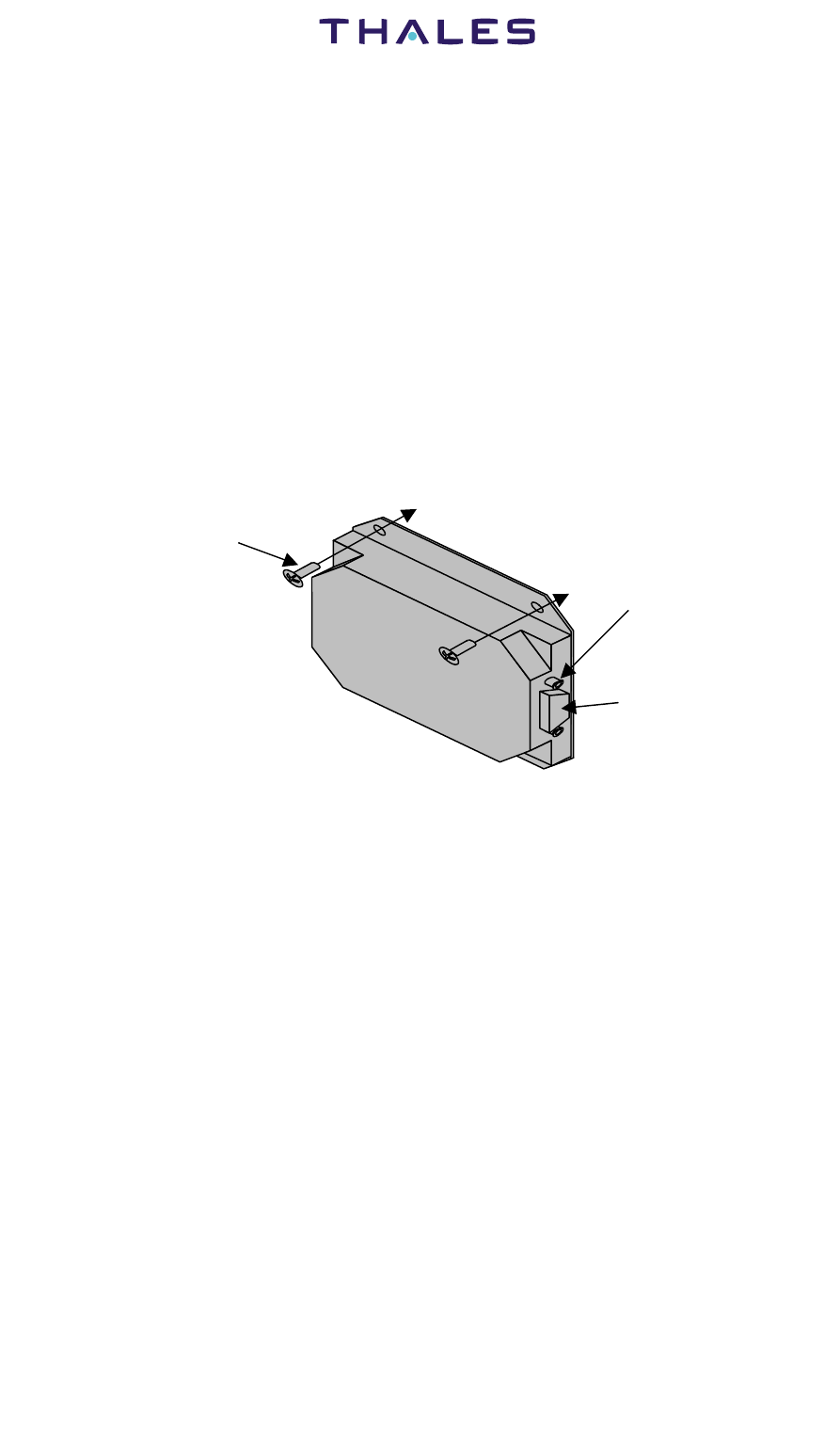
Installation Maintenance Manual
SDU 82155 Series
SCM 82158 Series
6-5
Jun 30/2008
© THALES AVIONICS Ltd. This document and any
information included are the property of Thales Avionics.
They cannot be reproduced, disclosed or utilized without the
company’s prior written approval
b. Place the SCM to the dedicated mounting fixture and insert the four
fixing screws to finger tightness only. After all four fixing screw have
been inserted tight the screws with an appropriate tool
CAUTION: ENSURE THAT THE FIXING SCREWS HAVE BEEN FASTENED,
AND THAT THE LRU IS SECURELY HELD IN POSITION.
c. Insert the cable from the SDU to the D Type connector (other half from
the SDU) and tighten the aircraft mating connector into the two female
screw locks.
B. Adjustment Procedure
Not Applicable.
C. Repair Procedure
Not Applicable.
D. Return to Service Procedures
Do the Post-Installation Test Procedures referenced in the Inspection and System
Checkout Section of this manual.
6.5. CLEANING OF MECHANICAL PARTS
CAUTION: MOISTURE AND DIRT CAN CAUSE DAMAGE TO EQUIPMENT
Equipment chassis covers give the necessary protection to keep dust away from
electronic circuits. If cleaning is required this has to be limited to the removal of particles
Figure 6.4 SCM Installation
D Type Connector (3)
Fixing Screw
(1)
Screw locks (2)
Tav_e_0000720_00
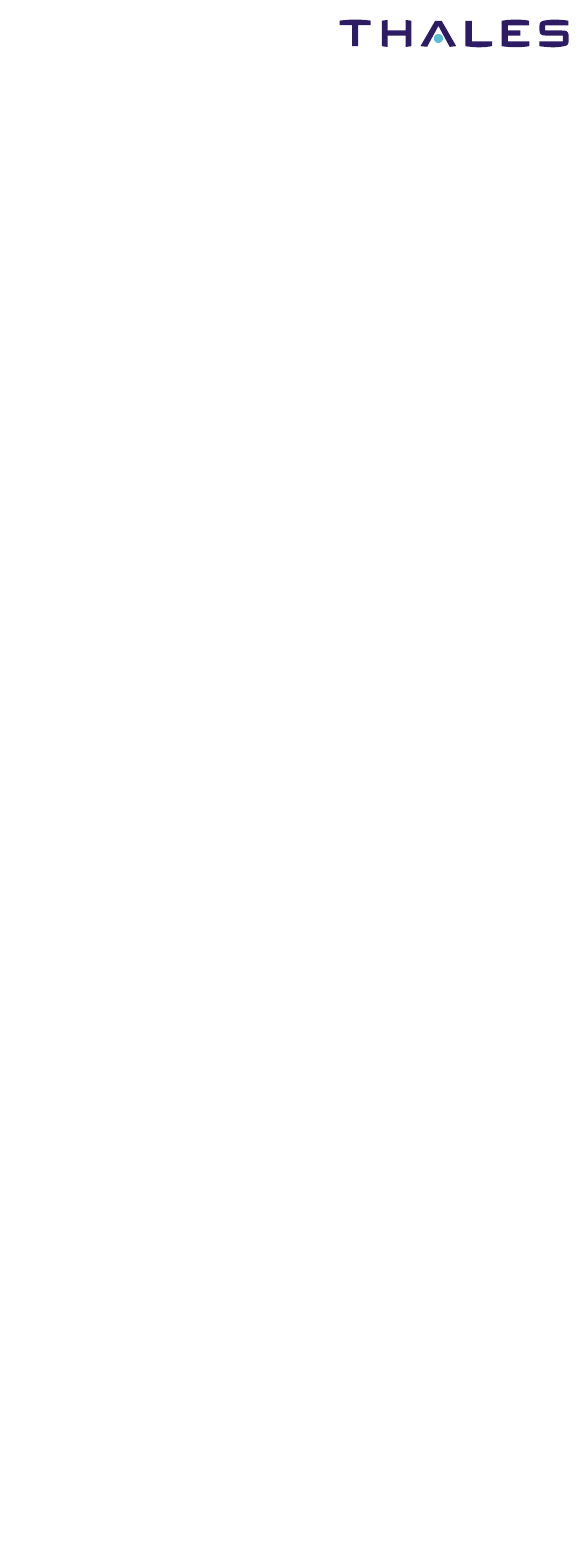
Installation Maintenance Manual
SDU 82155 Series
SCM 82158 Series
6-6
Jun 30/2008
© THALES AVIONICS Ltd. This document and any
information included are the property of Thales Avionics.
They cannot be reproduced, disclosed or utilized without the
company’s prior written approval
of dust, oil, grease, condensation, etc and only limited for those equipment accessible
parts. Before any cleaning action is carried out ensure that the equipment is disconnected
from all electrical power sources, and all the necessary ESD precautions are observed.
a. For dust removal use a cleaning wipe, a silk paintbrush or low-pressure
compressed air
b. For removal of finger marks, grease, etc, clean the parts with a cleaning
wipe and isopropyl alcohol, exercising care to not damage information
labels.
6.6. PERIODIC CHECKS
See Inspection/ Check procedure in Section 4.1.
6.7. CABLING AND CONNECTIONS
Periodically check cable connectors (recommended) and if required, remove connector,
inspect and re-connect connector to required torque values as specified by the cable
manufacture.
6.8. INSTRUCTIONS FOR CONTINUED AIRWORTHINESS
Maintenance requirements and instructions for continued airworthiness of the TFS SDU
and SCM components are contained in the paragraphs that follow.
Installation of SDU and SCM on an aircraft by an amendment to the Type Certificate
(TC), Supplemental Type Certificate (STC) or Form 337 obligates the aircraft operator
to include the maintenance information supplied by this manual (and listed below) in the
operator‚ Aircraft Maintenance Manual and the operator‚ Aircraft Scheduled
Maintenance Program.
a. Maintenance information for SDU and SCM, TFS LRU (system
description, removal, installation, testing, etc.).
b. The part numbers (see section 2) of the LRU being installed (SDU and
SCM) should be placed into the aircraft operator‚ appropriate aircraft
Illustrated Parts Catalogue (IPC).
c. Wiring connection information contained in this manual (see sections 2
and 3) should be placed into the aircraft operator‚ appropriate Wiring
Diagram Manual.
d. The SDU maintenance is considered as an ‚ “On-condition”‚ and as such
no additional maintenance is required other than a check for security and
operation at normal inspection intervals.
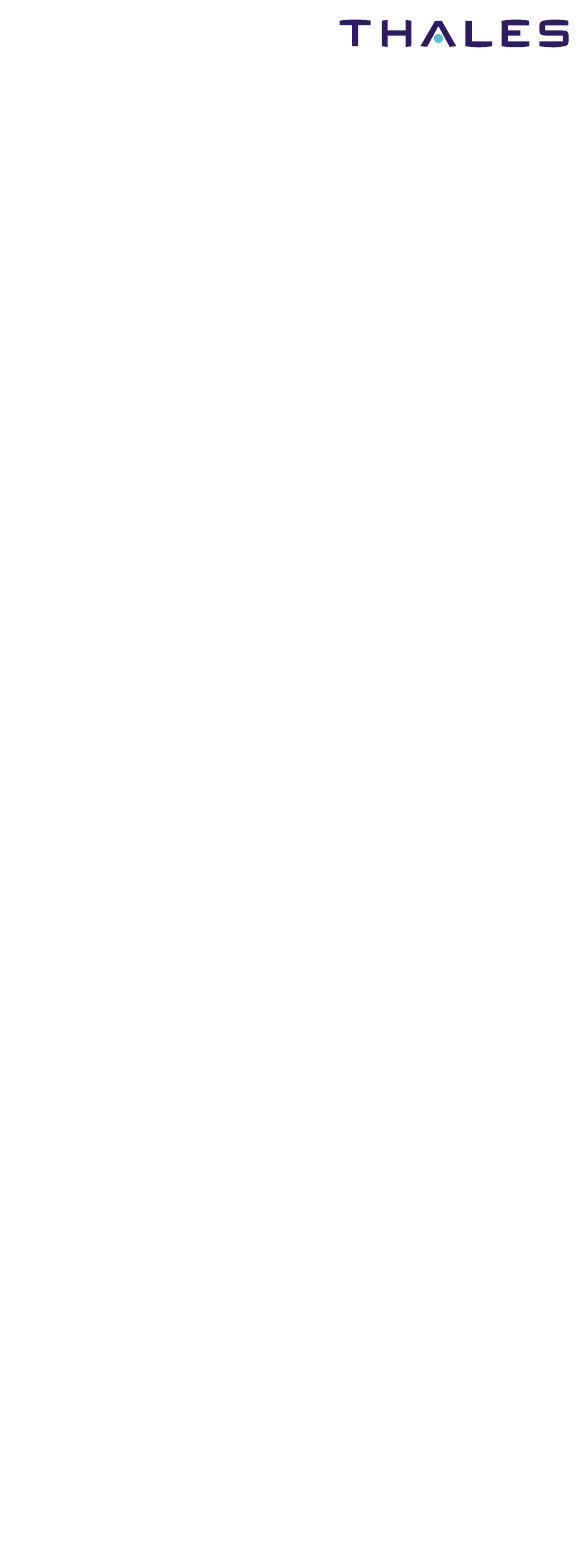
Installation Maintenance Manual
SDU 82155 Series
SCM 82158 Series
6-7
Jun 30/2008
© THALES AVIONICS Ltd. This document and any
information included are the property of Thales Avionics.
They cannot be reproduced, disclosed or utilized without the
company’s prior written approval
e. The SCM equipment is subject to minimal preventative maintenance,
which is specific to life limitations associated to the internal USIM
cards. For further details refer to your Thales representative.
f. If a system LRU is inoperative remove the specific unit, secure cables
and wiring, collar applicable switches and circuit breakers, and placard
them inoperative. Revise equipment list and weight and balance as
applicable prior to flight and make a log book entry that the unit was
removed (refer to section 91.213 of the FAR or the aircraft‚ Minimum
Equipment List (MEL)).
g. SDU and SCM can be repaired by an Approved Maintenance
Organization or an appropriately rated FAA Part 145 repair station.
h. Once repaired, reinstall the LRU in the aircraft in accordance with the
original Form 337 approved data or instructions in this manual. Perform
a Return to Service test of the system and approve it for return to service
with a logbook entry required by section 43.9.
i. Once repaired, install the LRU in the aircraft in accordance with the
original Form 337 approved data or instructions in this manual. Do a
Return to Service test of the system and approve it for return to service
with a log book entry in accordance with the requirements specified in
FAR Part 43.9.
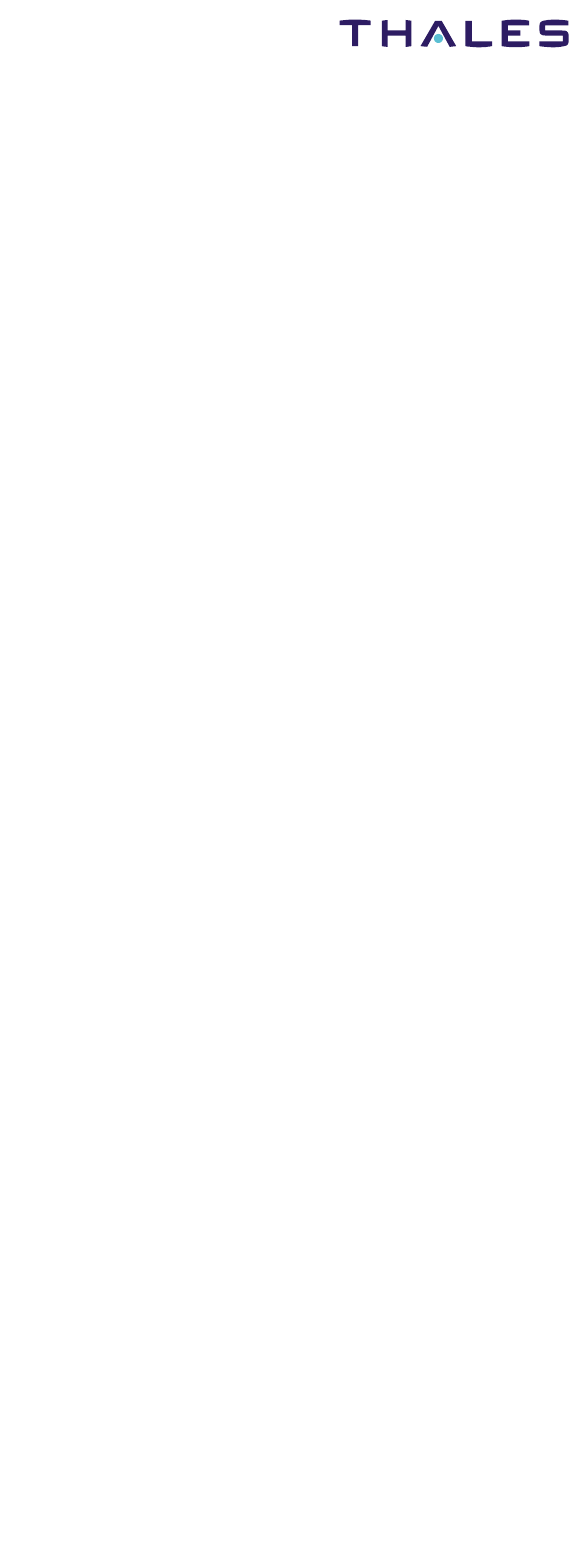
Installation Maintenance Manual
SDU 82155 Series
SCM 82158 Series
6-8
Jun 30/2008
© THALES AVIONICS Ltd. This document and any
information included are the property of Thales Avionics.
They cannot be reproduced, disclosed or utilized without the
company’s prior written approval
THIS PAGE INTENTIONALLY BLANK
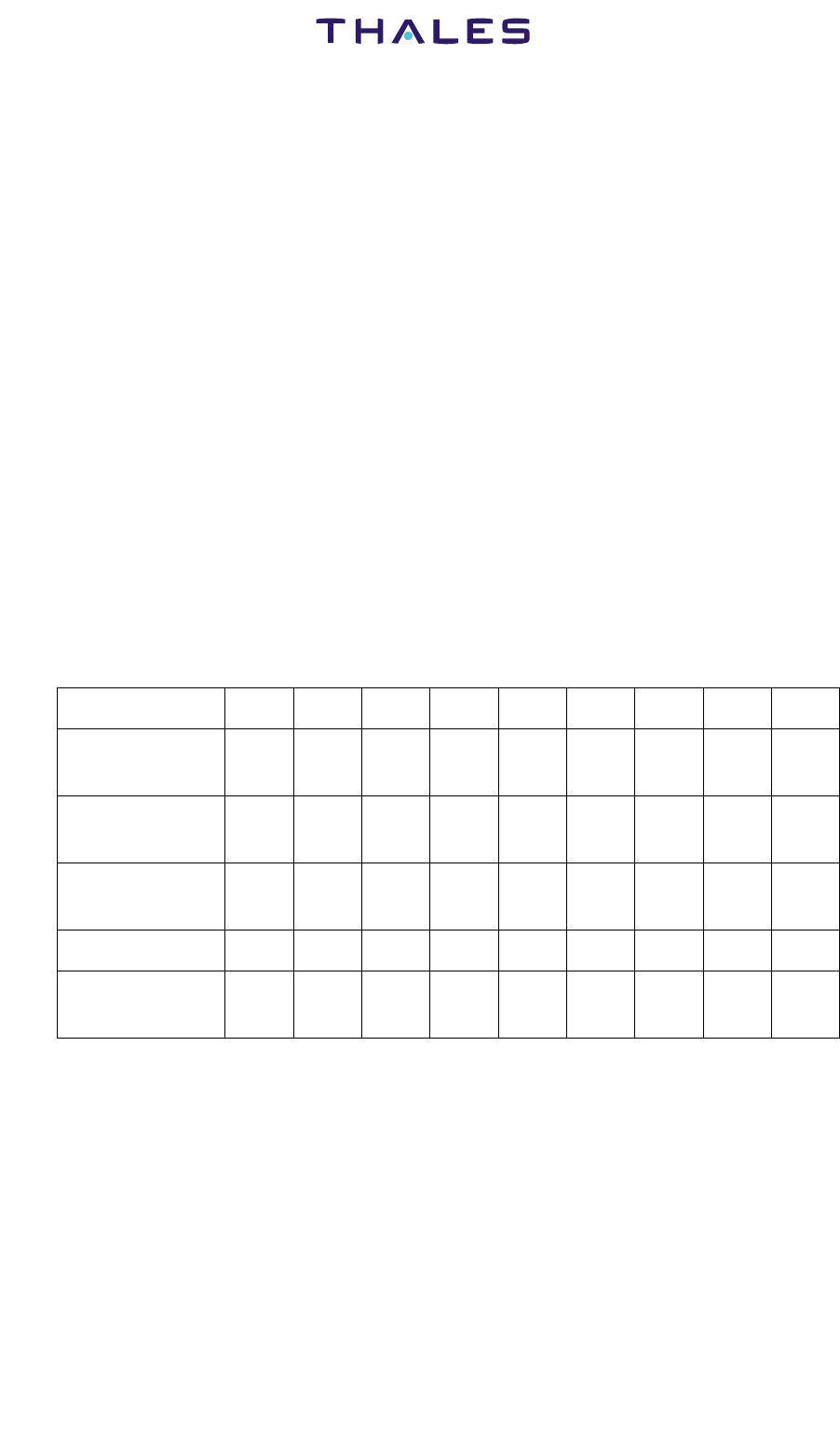
Installation Maintenance Manual
SDU 82155 Series
SCM 82158 Series
7-1
Jun 30/2008
© THALES AVIONICS Ltd. This document and any
information included are the property of Thales Avionics.
They cannot be reproduced, disclosed or utilized without the
company’s prior written approval
SECTION 7
70000COMMISSIONING
7.1. GENERAL
The purpose of the following tests is to confirm functionality of the services supported
by the SDU and associated equipment, both to confirm the installation has been
successful and to demostrate that the functionality is present to the customer.
All but one of these tests (the SMS and GSM Test, I.) can be performed on the ground.
Regulatory issues require that the GSM Pico cell not be operated below 10 000 feet, so
this test should be carried out on the next available test flight.
Not all tests are run for all installations - which tests should be run depends on the
capabilities fitted to the aircraft, as per the following table:
Table 7.1 Commissioning Tests Applicability
A. Registration
a. Power on the AGS (when fitted).
b. Power on the TFS System and wait until the LEDs reach the following
state (Refer to Table 7.2):
Capability A B C D E F G H I
Baseline
SDU+SCM
YesNoNoNoNoNoNoNoNo
+ Cockpit
audio/avionics
YesYesYesNoNoNoNoNoNo
+ Wifi AP or
wired Ethernet
Yes No No Yes Yes Yes No No No
Cabin ISDN YesNoNoNoNoNoYesYesNo
+ GSM Pico
cell
YesNoNoNoNoNoNoNoYes
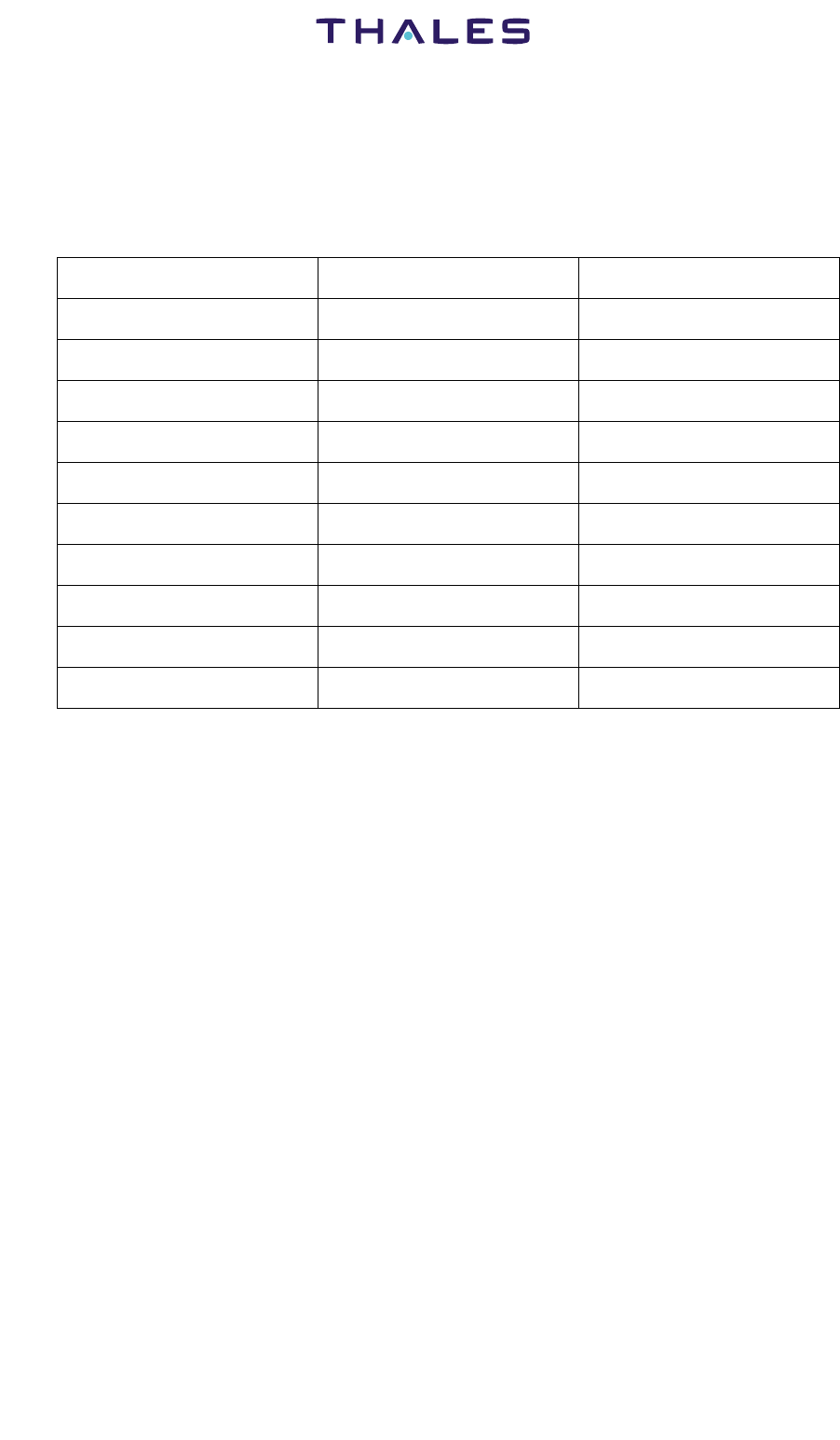
Installation Maintenance Manual
SDU 82155 Series
SCM 82158 Series
7-2
Jun 30/2008
© THALES AVIONICS Ltd. This document and any
information included are the property of Thales Avionics.
They cannot be reproduced, disclosed or utilized without the
company’s prior written approval
Table 7.2 SDU LEDs
NOTE: Unless an FMHPA is installed, in which case should be GREEN.
c. Connect a laptop to the Test port on the SDU.
Either:
d. If an MCDU is present:
i Enter the Satcom main menu.
ii Both Sat-1 (and Sat-2 if Dual Channel) should be “READY”.
iii Press Page Down.
iv Select “CHANNEL STATUS”
v Sat Modem1 should be in “SWIFT BB” with status “LOGGED
ON”
Or:
e. If the cabin control panel is fitted:
vi If the “Service is available” LED is lit then the Satcom system is
registered.
LED SDU - 82155A SDU - 82155D
SDU GREEN GREEN
SCM GREEN GREEN
Antenna GREEN GREEN
DLNA GREEN GREEN
FMHPA OFF(see Note) OFF(see Note)
Ext. BSU OFF OFF
Ext. Data Bus GREEN GREEN
ORT/Config. GREEN GREEN
Sat. Link #1 GREEN GREEN
Sat. Link #2 OFF OFF
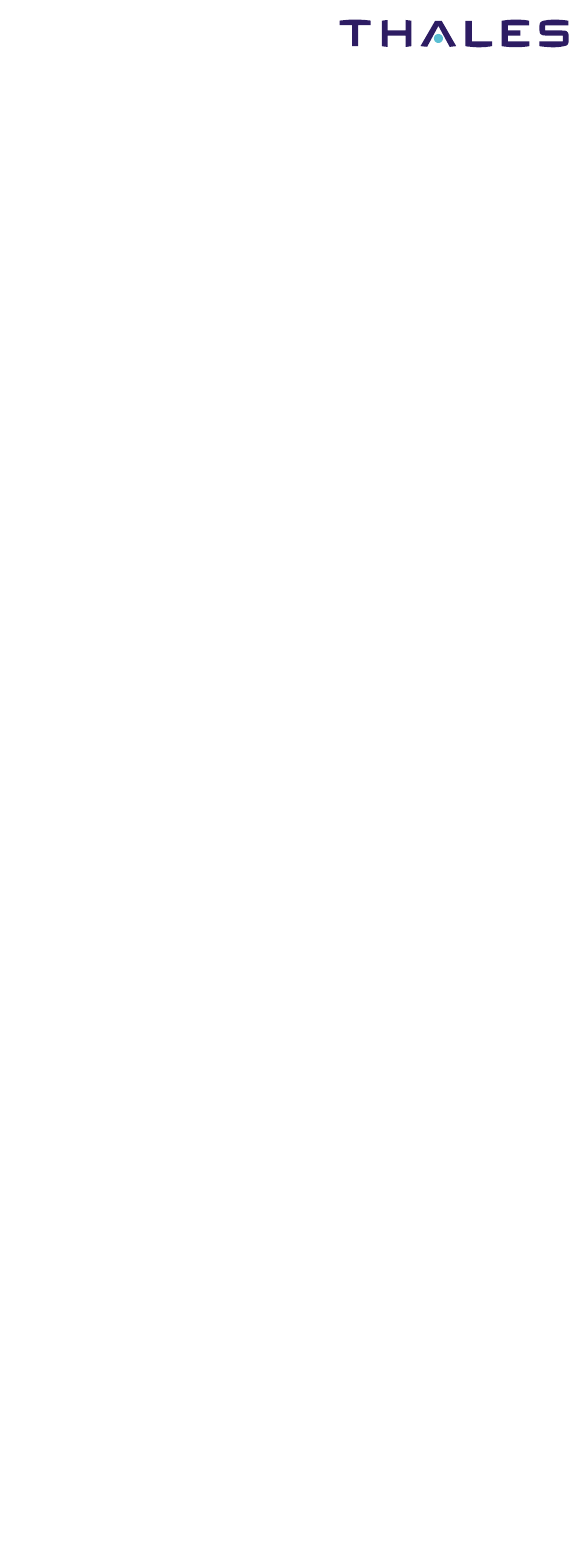
Installation Maintenance Manual
SDU 82155 Series
SCM 82158 Series
7-3
Jun 30/2008
© THALES AVIONICS Ltd. This document and any
information included are the property of Thales Avionics.
They cannot be reproduced, disclosed or utilized without the
company’s prior written approval
B. Classic Packet Data Verification
If Cockpit functionality is fitted:
a. Using any MCDU:
i Press the “Menu” key to display the menu page.
ii Select “ACARS”.
iii Via the “MAINTENANCE”, “COMM CONTROL” or equivalent
ACARS page, verify that Satcom is “AVAILABLE”.
iv Send and receive several “FREE TEXT” ACARS messages.
v Verify correct receipt of all messages.
C. Classic Cockpit Voice Calls
If Cockpit functionality is fitted:
a. Using any MCDU:
i Enter the Satcom main menu.
ii Both Sat-1 (and Sat-2 if Dual Channel) should be “READY” .
iii Using the correct procedure based on the ORT options selected,
place and receive Cockpit Voice calls using each of the available
channels from the Audio Control Panels.
iv In each case, verify correct operation.
D. SBB Cabin Wifi Data Connectivity (Background Context)
If either a Wifi access point or a wired Ethernet to the cabin is fitted:
a. Start up a laptop (with Wifi capability if Wifi is to be used).
b. Connect to the access point or wired Ethernet.
c. Open a browser window and follow the instructions to gain default
background access (if any).
d. Open a command window (Start, Run, “cmd”).
i Type “ping www.google.com -n 10 -w 10000”.
ii 10 replies should be received.
iii Type “ping www.google.com -1 1400 -n 10 -w 10000”.
iv 10 replies should be received.
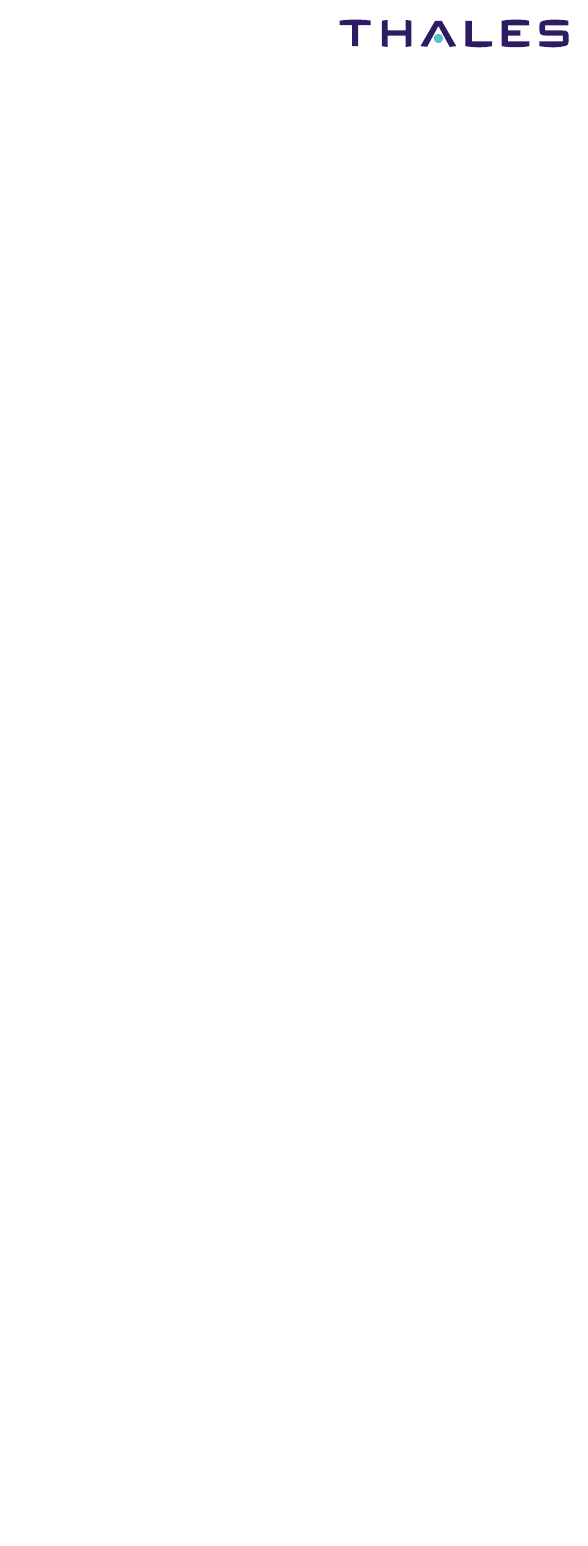
Installation Maintenance Manual
SDU 82155 Series
SCM 82158 Series
7-4
Jun 30/2008
© THALES AVIONICS Ltd. This document and any
information included are the property of Thales Avionics.
They cannot be reproduced, disclosed or utilized without the
company’s prior written approval
e. Go to Google homepage and search for a random string to check HTML
connectivity.
f. Start an FTP client:
i Connect to the Inmarsat FTP server.
ii Change directory to a test directoryt.
iii “Put” a file onto a server. The transfer should complete
successfully.
iv “Get” a file from the server. The transfer should complete
successfully.
v Disconnect the FTP client.
g. Disconnect from the access point or wired Ethernet.
E. SBB Cabin Wifi Data Connectivity (Streaming Context)
If either a Wifi access point or wired Ethernet to the cabin is fitted:
a. Start up a laptop (with Wifi capability if Wifi is to be used).
b. Connect to the access point or wired Ethernet.
c. Open a browser window and follow the instructions to gain access to a
guaranteed streaming connection -32k.
d. Set the Traffic Flow Template by associating the streaming connection
with the FTP client.
e. Open the billing/connection monitoring section of the local site, or open
the properties for each network connection.
f. Open a command window (Start, Run, “cmd”).
i Type “ping www.google.com -n 10 -w 10000”.
ii 10 replies should be received.
iii Check that the traffic generated by this command went via the
Background context and not the Streaming connection.
g. Go to Google homepage and search for a random string to check HTML
connectivity.
h. Start an FTP client:
i Connect to the Inmarsat FTP server.
ii Change directory to a test directoryt.
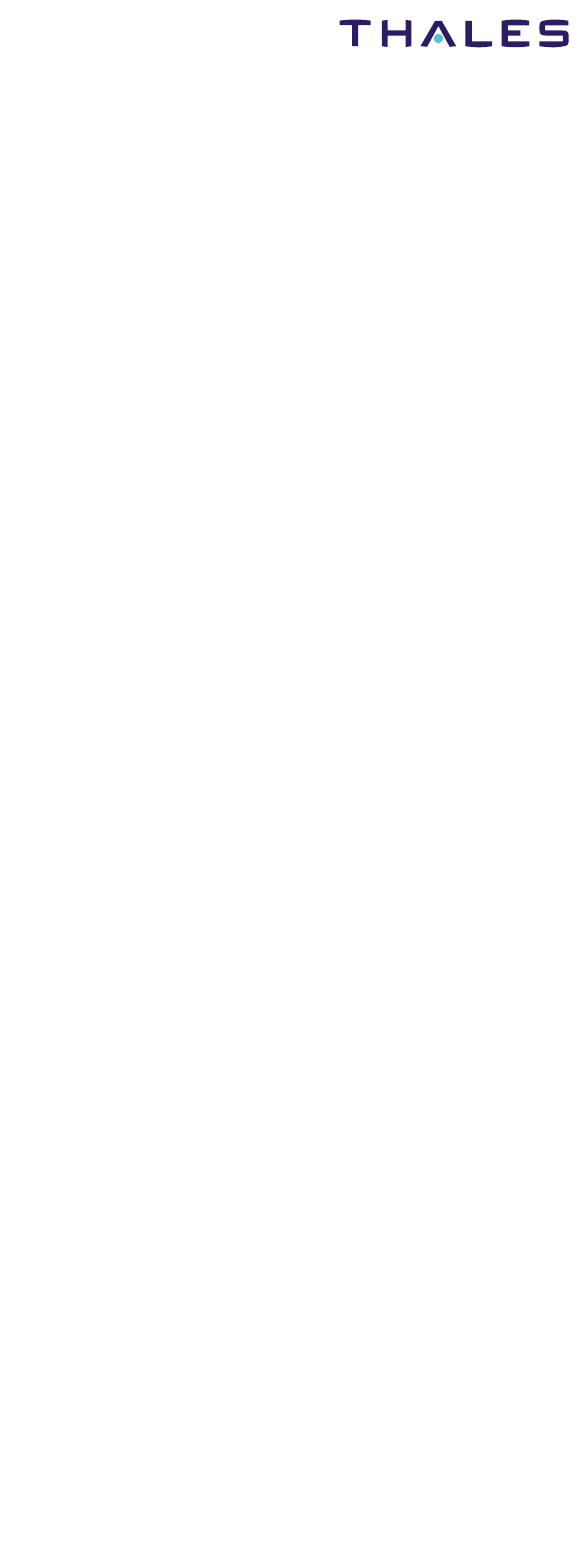
Installation Maintenance Manual
SDU 82155 Series
SCM 82158 Series
7-5
Jun 30/2008
© THALES AVIONICS Ltd. This document and any
information included are the property of Thales Avionics.
They cannot be reproduced, disclosed or utilized without the
company’s prior written approval
iii “Put” a file onto a server. The transfer should complete
successfully.
iv The traffic should have gone via the streaming context and the data
rate should have been comparable to the guaranteed rate.
v “Get” a file from the server. The transfer should complete
successfully.
vi The traffic should have gone via the streaming context and the data
rate should have been comparable to the guaranteed rate.
vii Disconnect the FTP client.
i. Disconnect the streaming connection.
j. Disconnect from the access point or wired Ethernet.
F. Cabin VoIP service
If either a Wifi access point or wired Ethernet to the cabin is fitted:
a. Ensure that the SDU is powered on and connected.
b. Connect a laptop with headset or VoIP phone to the Cabin Wireless
Access Point.
c. Open a browser window and follow the instructions to gain default
background access (if any):
i Make a phone call to a PSTN number and have a short
conversation. audio quality should be good.
ii Arrange a call back and hang up. When the phone rings, answer
and have a short conversation. Audio quality should be good.
G. Cabin ISDN Data service
If ISDN to the cabin is fitted:
a. Connect an ISDN modem to the laptop.
b. Connect an ISDN modem to the ISDN port.
c. Dial a suitable ISDN number for a data connection to the internet:
i The modem should be able to receive the “on hook” status and dial
a number.
ii Arrange a call back and hang up. When the phone rings, answer
and have a short conversation. Audio quality should be good.
iii The connection should be set up over Satcom to the number dialed.
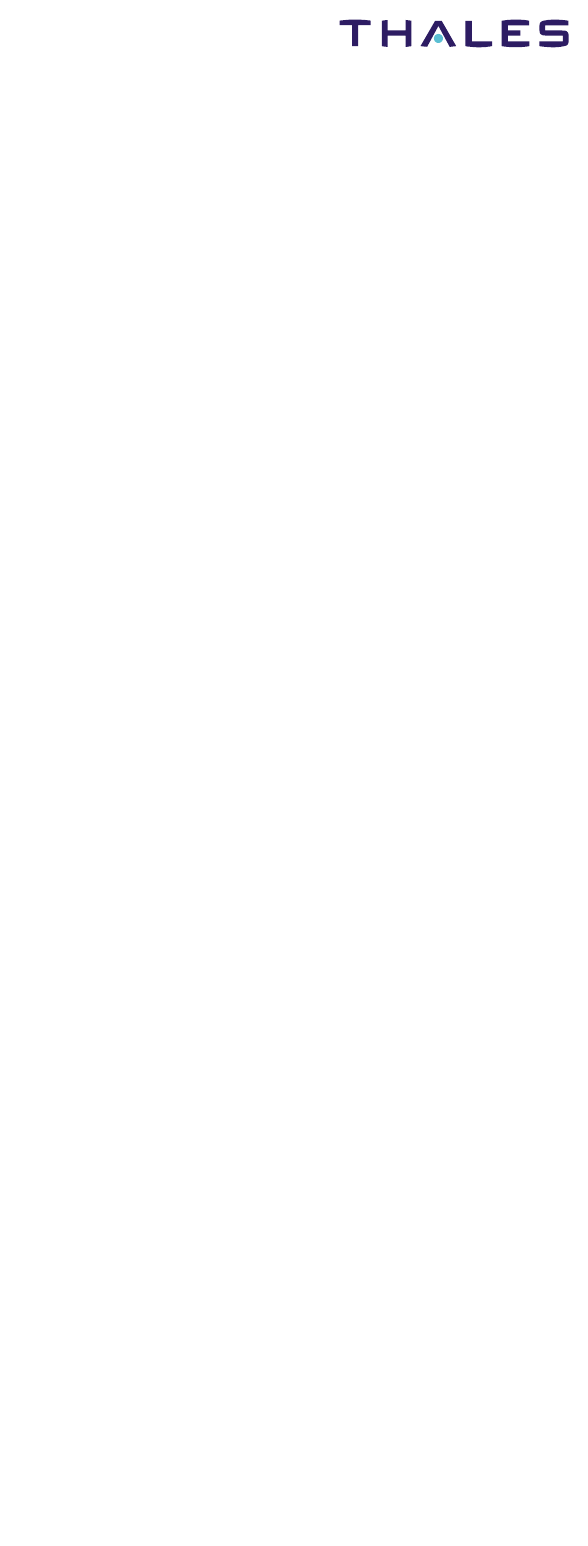
Installation Maintenance Manual
SDU 82155 Series
SCM 82158 Series
7-6
Jun 30/2008
© THALES AVIONICS Ltd. This document and any
information included are the property of Thales Avionics.
They cannot be reproduced, disclosed or utilized without the
company’s prior written approval
iv Type “ping www.google.com -n 10 -w 10000”.
v 10 replies should be received.
vi Type “ping www.google.com -1 1400 -n 10 -w 10000”.
vii 10 replies should be received.
d. Go to the Google homepage and search for a random string to check
HTML connectivity.
e. Start an FTP client:
i Connect to the Inmarsat FTP server.
ii Change directory to a test directoryt.
iii “Put” a file onto a server. The transfer should complete
successfully.
iv The data rate should have been comparable to the expected 64kbit
rate.
v “Get” a file from the server. The transfer should complete
successfully.
vi The data rate should have been comparable to the expected 64kbit
rate.
vii Disconnect the FTP client.
f. Disconnect the ISDN connection.
H. Cabin ISDN Voice service
If ISDN to the cabin is fitted:
a. Connect an ISDN phone to the ISDN port.
b. Dial a suitable ISDN number for an ISDN voice connection:
i The modem should be able to receive the “on hook” status and dial
a number.
ii The connection should be set up over Satcom to the number dialed.
iii Have a short conversation. The voice quality should be good.
iv Request a call back and hang up.
v The ISDN modem should be able to accept an ISDN ground to air
voice call.
vi Have a short conversation. The voice quality should be good.
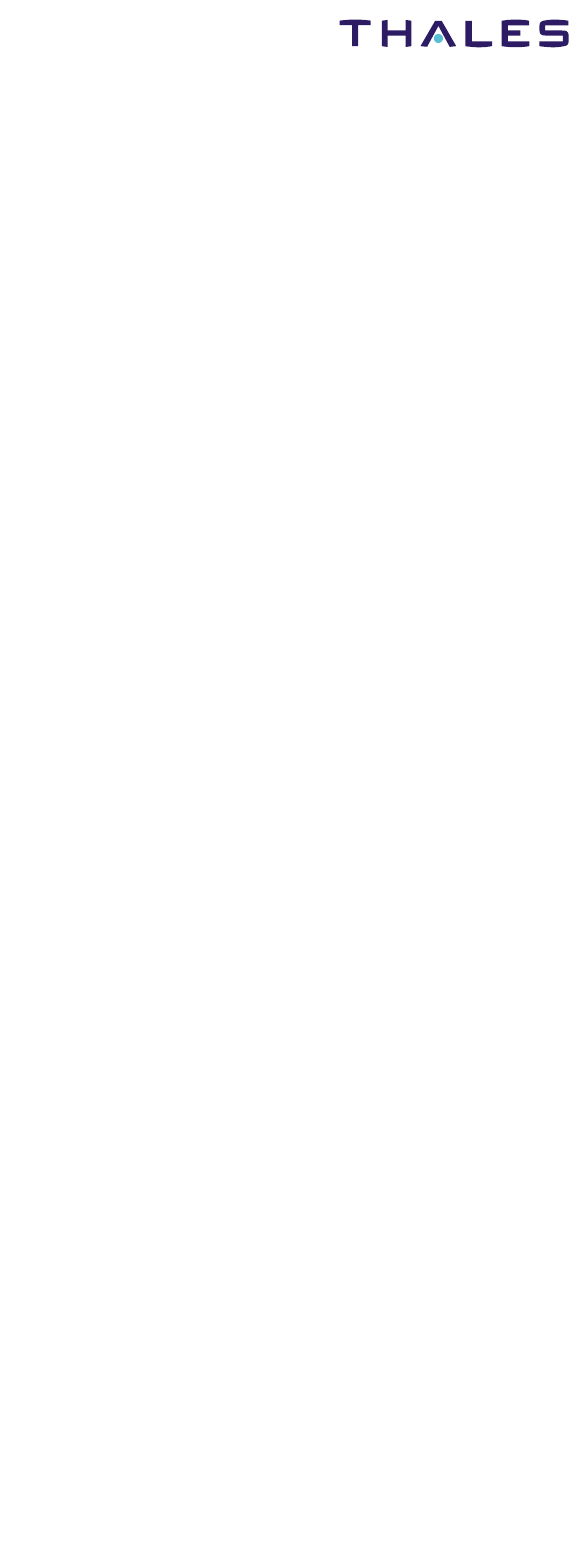
Installation Maintenance Manual
SDU 82155 Series
SCM 82158 Series
7-7
Jun 30/2008
© THALES AVIONICS Ltd. This document and any
information included are the property of Thales Avionics.
They cannot be reproduced, disclosed or utilized without the
company’s prior written approval
vii Hang up.
I. Cabin GSM Call and SMS Service
If a GSM Pico cell is fitted:
a. Ensure that the AGS is powered on and the call disable is off.
b. Ensure that the SDU is powered on and connected.
c. Switch on a GSM mobile phone.
i The phone should register to the Pico cell, with the configured
network name.
ii Make a phone call to a PSTN number and have a short
conversation. Audio quality should be good.
iii Arrange a call back and hang up. when the phone rings, answer and
have a short conversation. Audio quality should be good.
iv Send an SMS message to a remote GSM phone, asking for a reply.
The text message should reach recipient.
v The SMS reply should be received.
vi Switch on the call disable.
vii Attempt to place a call from the GSM phone. The call should be
blocked.
viii Send an SMS message asking for a call back and a reply.
ix The external call should be blocked and the SMS message should
still be received.
d. Power off the GSM phone and disable the Pico cell.
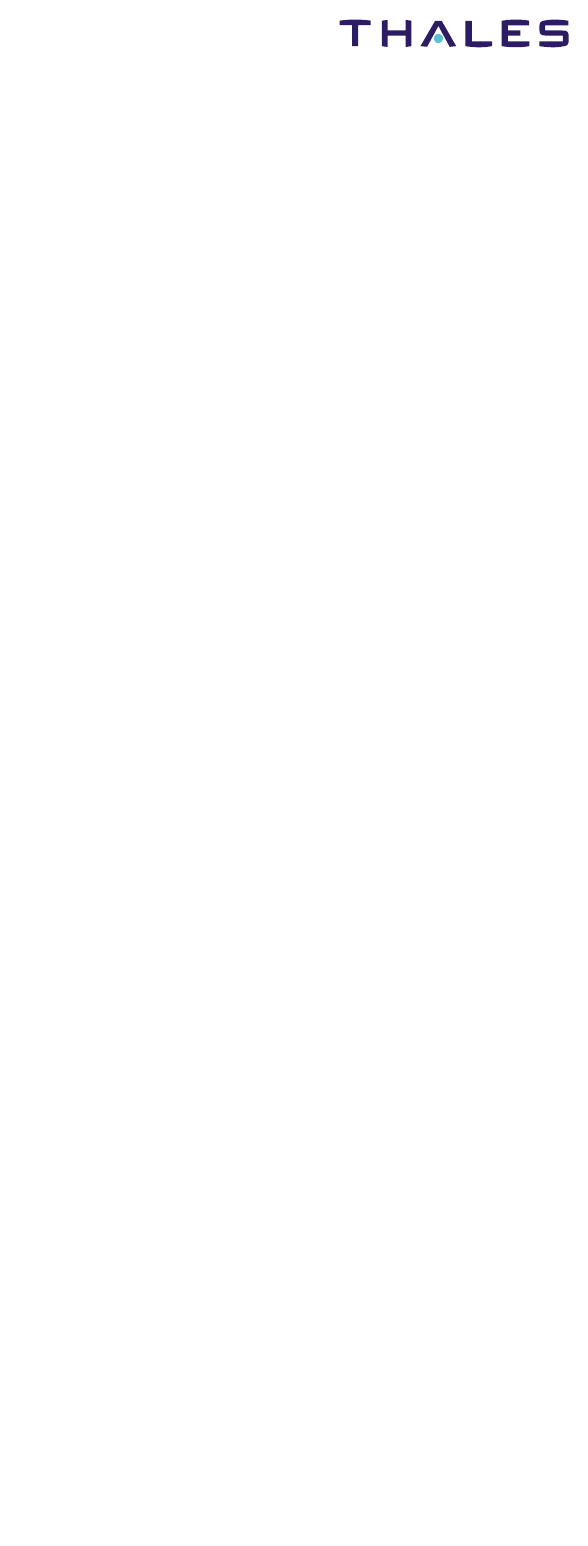
Installation Maintenance Manual
SDU 82155 Series
SCM 82158 Series
7-8
Jun 30/2008
© THALES AVIONICS Ltd. This document and any
information included are the property of Thales Avionics.
They cannot be reproduced, disclosed or utilized without the
company’s prior written approval
THIS PAGE INTENTIONALLY BLANK